More than 180 species of birds exist in the Valdes Peninsula either passing through on their chosen migratory route in flocks or alone or occupying a niche as a permanent resident. Many can be seen from Puerto Madryn or Puerto Piramides, while the observation of other species requires a more dedicated search in specific areas where they enjoy the solitude of this incredible geography, like “Bird Island” on the shores of Golfo San Jose. Here I have illustrated just 25 of these species.
Flamingo
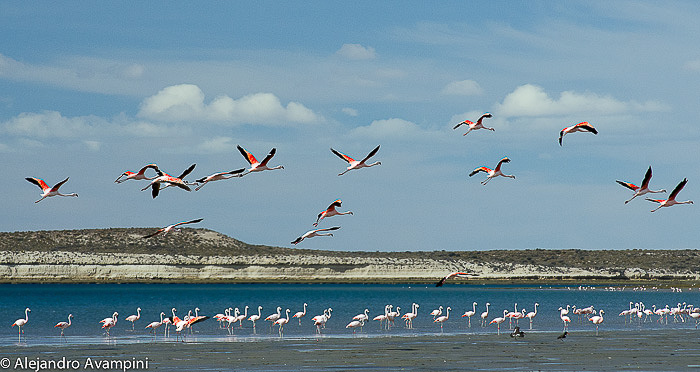 The Southern Flamingo is a large bird, most often seen in flocks. They can measure five feet, are easily identified by their pink colour on the outer feathers, their long neck, long legs and large wings. The legs have short toes, which are also webbed, helping the bird when swimming. Male flamingos are larger than females and this feature is the only visible difference between the sexes. The colour of their feathers are acquired by the food they eat, that’s why their offspring are born whitish and take on the intense pink colour from the small crustaceans, which form the major part of their diet. Flamingos are not resident in Valdes Peninsula area, however they nest in lakes in the Province of La Pampa. They are very wary birds and are easily disturbed by human presence. They can be very difficult to approach and photograph. The best way we have found to photograph them is to wait, camouflaged, at low tide. As the tide comes in, the birds will come to feed closer inshore. You must take great care not to alarm them or your opportunity will be lost. Photographing Flamingos requires a great deal of patience, as many of the professional photographers who live and work in the area will attest. Flamingos are not at all used to humans, living completely wild, and are, therefore, very elusive. Remember that Valdés Peninsula is an important area for wildlife to raise their young, and, as such is deserving of respect and minimal human impact. There are already 300,000 tourists visiting the area each year and the Peninsula is to some degree, affected by human greed. Please help to raise awareness of the need for respect for our wildlife by your own example.
The Southern Flamingo is a large bird, most often seen in flocks. They can measure five feet, are easily identified by their pink colour on the outer feathers, their long neck, long legs and large wings. The legs have short toes, which are also webbed, helping the bird when swimming. Male flamingos are larger than females and this feature is the only visible difference between the sexes. The colour of their feathers are acquired by the food they eat, that’s why their offspring are born whitish and take on the intense pink colour from the small crustaceans, which form the major part of their diet. Flamingos are not resident in Valdes Peninsula area, however they nest in lakes in the Province of La Pampa. They are very wary birds and are easily disturbed by human presence. They can be very difficult to approach and photograph. The best way we have found to photograph them is to wait, camouflaged, at low tide. As the tide comes in, the birds will come to feed closer inshore. You must take great care not to alarm them or your opportunity will be lost. Photographing Flamingos requires a great deal of patience, as many of the professional photographers who live and work in the area will attest. Flamingos are not at all used to humans, living completely wild, and are, therefore, very elusive. Remember that Valdés Peninsula is an important area for wildlife to raise their young, and, as such is deserving of respect and minimal human impact. There are already 300,000 tourists visiting the area each year and the Peninsula is to some degree, affected by human greed. Please help to raise awareness of the need for respect for our wildlife by your own example.
Reproduction
Flamingos are monogamous. and before pair-bonding, males and females gather in groups of up to 150 individuals, and perform the so-called “wedding march”, with their necks stretched upwards, moving head vigorously from side to side and up in one direction. The march is accompanied by a strong hoarse croak from the whole group. The birds then form pairs. Weeks later, nesting begins. Flamingo breeding colonies are characterized by a gathering of thousands of individuals. The nest is usually made of clay, in the shape of a truncated cone,with a depression in the centre. A single egg only is laid. After 30 days of incubation shared between both parents, the young are born with white plumage and straight beak, which takes the hooked form as they grow. At the age of a week or so, the young birds gather in creches, which can number up to a thousand individuals, guarded by several adult birds. After a few weeks, the appearance of the chicks changes. Plumage colour turns grey, with black legs, and the beak curves to resemble the parents’. The creches stay together until the age of three months, after which, the young are able to fend for themselves.
Choique
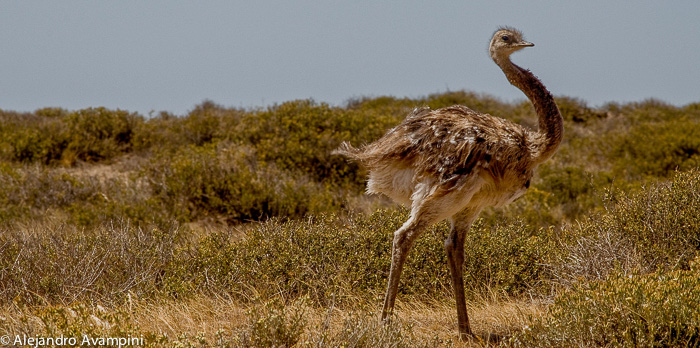 The Choique is a Patagonian symbol. Source of inspiration for stories and legends, the rhea is so present in folklore as in all the paths in Patagonia. It is a large , herbivorous, flightless bird. They use their soft wings as stabilizers, and are fast runners. It is one of the two “American ostriches”, but unlike its African relative has three toes instead of two. Females lay 8-10 eggs which are incubated by the male. He also assumes parental responsibility for the “charitos”, who follow him for most of the summer. In winter they form mixed groups of males, females and juveniles. The harem is composed of one male and one to fifteen females. This varies by region and is very much dependent on the availability of food. The male measures 1.50 meters and weigh up to 30 kilos; the female is smaller in height. It feeds on grasses, lowering it’s head and long neck. The Choique also eat grains, bread, flies and insects which are trapped in the air. Choique have also been known to eat metal items, coins and small stones.
The Choique is a Patagonian symbol. Source of inspiration for stories and legends, the rhea is so present in folklore as in all the paths in Patagonia. It is a large , herbivorous, flightless bird. They use their soft wings as stabilizers, and are fast runners. It is one of the two “American ostriches”, but unlike its African relative has three toes instead of two. Females lay 8-10 eggs which are incubated by the male. He also assumes parental responsibility for the “charitos”, who follow him for most of the summer. In winter they form mixed groups of males, females and juveniles. The harem is composed of one male and one to fifteen females. This varies by region and is very much dependent on the availability of food. The male measures 1.50 meters and weigh up to 30 kilos; the female is smaller in height. It feeds on grasses, lowering it’s head and long neck. The Choique also eat grains, bread, flies and insects which are trapped in the air. Choique have also been known to eat metal items, coins and small stones.
Their relationship with the man:
The rhea has been one of the species most utilised by Man in Argentina. For Patagonian natives, it was a favourite food, along with the guanaco, and they full took advantage of all of it: the meat, cartilage and fat were consumed for food; feathers as ornamental, fans and whisks; the leg tendons were used in making ropes for bolas, bones for musical instruments; leather for tobacco pouches and saddlebags; and the eggshell and feathers were used as medicines. It is also found of countless legends, as in the following story, which tells how a rhea was the origin of the Southern Cross constellation. 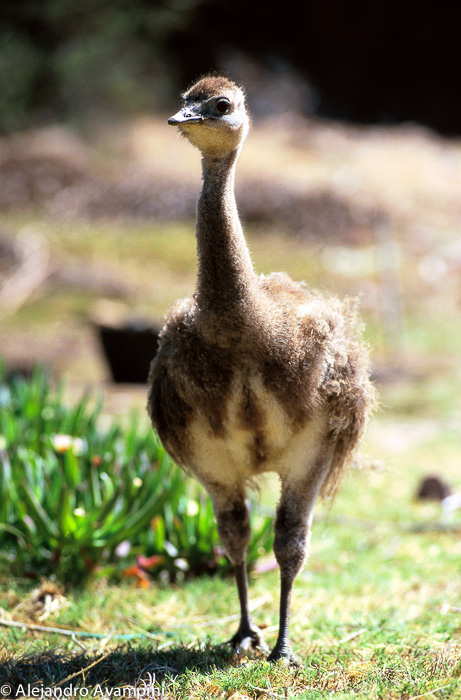
Leyend of the Mocovies tribe and the southern cross
“The old chief recalled that his father had told him that Manic, the rhea, was the animal with the most beautiful feathers. The chief sent for the best hunter in the tribe: Nemec, an agile and faithful youth. The boy looked his best weapons. He has never seen a rhea – this mysterious bird was unknown in the hinterland. Nemec asked the elders of the tribe to give him advice. He was told that Manic was very fast and it was impossible to find him without his noticing. He had to find a footprint similar to a bird, but much larger, and that the key was to follow the South path. Grateful Nemec left with the honour and responsibility of such a goal. He walked for days until one afternoon, when he found tracks: they were heading south, and he followed them. Walking under the first light of the next day, he noticed something strange. He looked up and there it was. It was the rhea, with its long, slender legs, with its beautiful plumage shaken by the wind, trembling his little head supported by a long neck, and looking at who knows what… But what struck him most were his feathers and he knew why the chief wanted to have them. Nemec remembered his duty. He crept. He almost threw the spear when the rhea escaped at full speed, leaving just an astonished hunter. The next day, Nemec followed the tracks and again found his target. But the rhea escaped again. The same thing happened again and again. Nemec began to doubt if he really would get to hunt it. Then he found it at sunset. There it was, and the opportunity could not be wasted. Man and animal froze. Suddenly, Nemec ran with all his might. The rhea ran also. Nemec flexed his arm and released the weapon. And, according to Mocovi legend, Manic spread his wings and soared. And continued rising until he reach the sky, and in the dim light of dusk, was lost to view. Suddenly, in the same place where the rhea had disappeared, four stars emerged in a cross: one took Choique’s chick or “charito”. the place of the head; two marked the tips of its wings and the last, the end of its legs.Nemec spent the night watching the sky and recalling images of the rhea he could never catch. The next day, he started back to his home. He arrived back at the tribe with empty hands but with a twinkle in his eye. That night, when everyone sat around the campfire, Nemec told of his strange adventure. Then, they saw the new stars that the sky was wearing, indicating forever the direction in which Manic had escaped: south.”
Variable Hawk
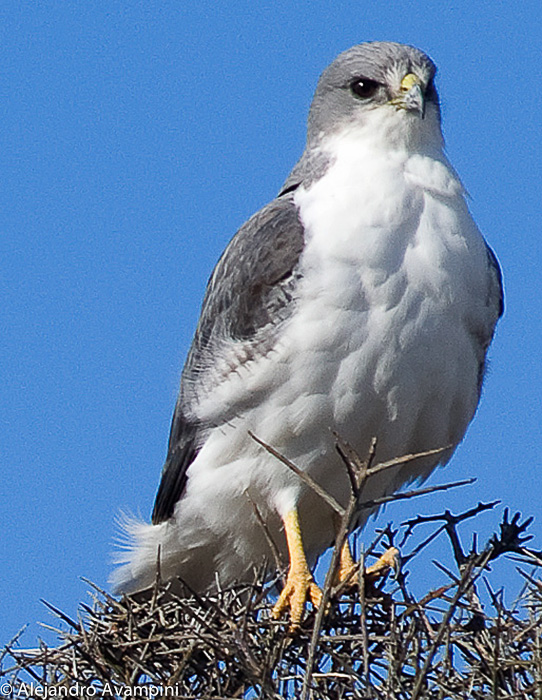
Also known as “Ñanco”, it can be seen throughout the Valdes Peninsula. The males measure up to 48 cm and the female is slightly larger, reaching 52 cm. The plumage is grey on the back, with a white underside in adults. Its’ most distinctive feature is a black stripe down the tail. Juveniles keep their brownish striped and spotted plumage and yellow legs for two years. It feeds on small mammals, nothing bigger than the hare and also varying species of birds. Some reptiles, amphibians and invertebrates are also included in the diet. The method of hunting is to fly in a circular motion over an area and plunge at an angle, striking the prey on the back with it’s powerful talons.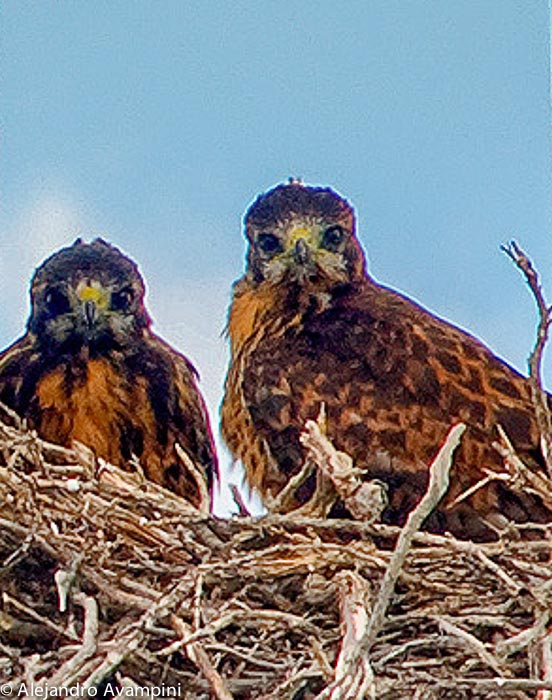
Nests are built by both members of the pair. The Variable Hawk likes thorny trees, in this region, preferring to nest in Molles The bird will also nest lamp posts. The nest is large, about three feet in diameter and is made of sticks. The male feeds the female during incubation. After the chicks hatch (in December), she will be responsible for them. Folk tales say that if, when travelling, a hawk crosses your path in front of you, your trip will go well. If, however, it crosses your path behind you, you should take great care until you reach your destination.
Black Chested Buzzard Eagle
 The Black Chested Buzzard Eagle (Geranoaetus Melanoleucus) is a fast hunter that occupies most of the South American Continent from Venezuela to The land of Fire and the Beagle Channel. This is a diurnal bird that occupies, in relatively small numbers, the Valdes Peninsula.
The Black Chested Buzzard Eagle (Geranoaetus Melanoleucus) is a fast hunter that occupies most of the South American Continent from Venezuela to The land of Fire and the Beagle Channel. This is a diurnal bird that occupies, in relatively small numbers, the Valdes Peninsula.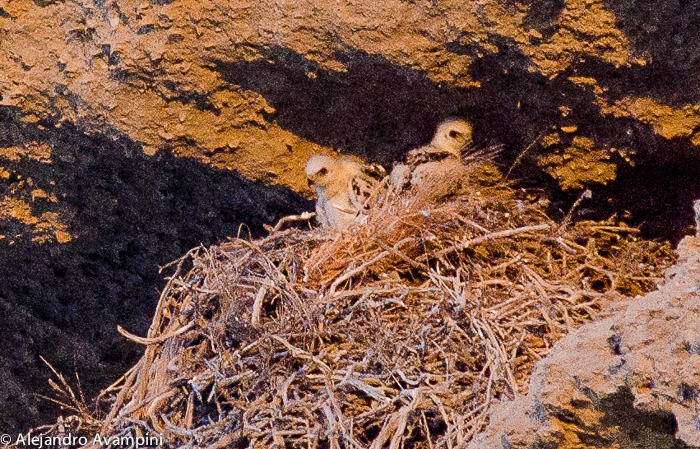 Their nests are found on outcroppings of cliffs with extremely difficult access and their nests are large platforms of sticks and branches. A female will lay 2 eggs in October and the chicks will hatch around the end of November beginning of December. By February the chicks are large enough and have enough experience to leave the nest.
Their nests are found on outcroppings of cliffs with extremely difficult access and their nests are large platforms of sticks and branches. A female will lay 2 eggs in October and the chicks will hatch around the end of November beginning of December. By February the chicks are large enough and have enough experience to leave the nest.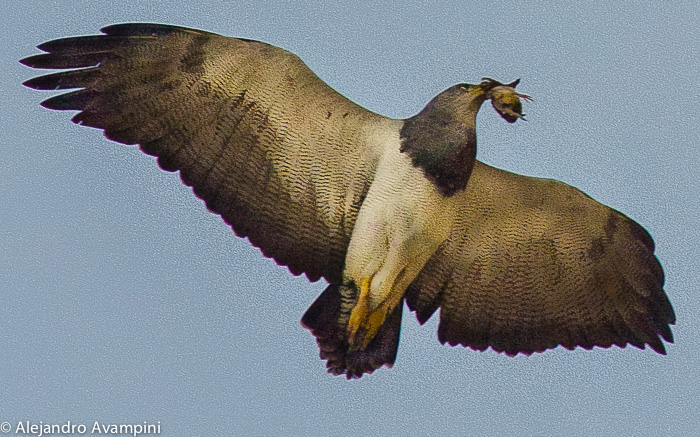 A large part of their diet is made up of rodents and small mammals, though they do also hunt and eat other small birds, as seen in the above image. On this occasion I observed it carrying its prey to the nest to feed the anxiously awaiting chicks. This banquet ensures continued growth, maintaining a species that enriches our planets biodiversity.
A large part of their diet is made up of rodents and small mammals, though they do also hunt and eat other small birds, as seen in the above image. On this occasion I observed it carrying its prey to the nest to feed the anxiously awaiting chicks. This banquet ensures continued growth, maintaining a species that enriches our planets biodiversity.
Great Egret
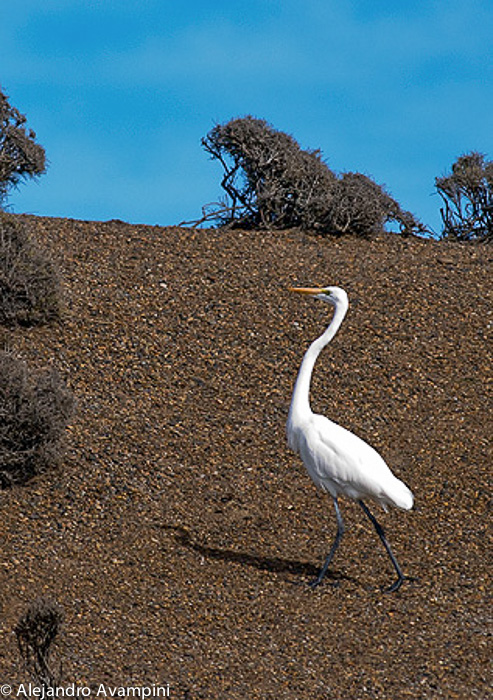
This long legged Patagonian Resident is also seen regularly in the Valdes Peninsula. Teetering on the edge of extinction in the early 1900s due to women’s fashion, this elegant bird has survived and although still somewhat scarce, each year can be observed in greater numbers. They were killed for the male’s long dorsal feathers used in the birds courting behavior.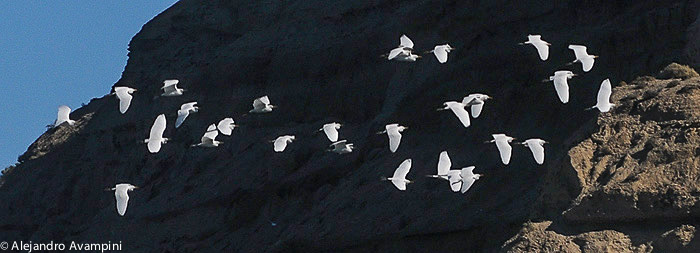 These feathers were used in hairstyles and hats and were acquired at a high price, creating an uncontrolled extermination with no respect for the bird’s reproduction. The creation and application of legislation together with changing styles helped reverse the situation. During reproductive season they will nest together in colonies as large as 20 individuals.
These feathers were used in hairstyles and hats and were acquired at a high price, creating an uncontrolled extermination with no respect for the bird’s reproduction. The creation and application of legislation together with changing styles helped reverse the situation. During reproductive season they will nest together in colonies as large as 20 individuals.
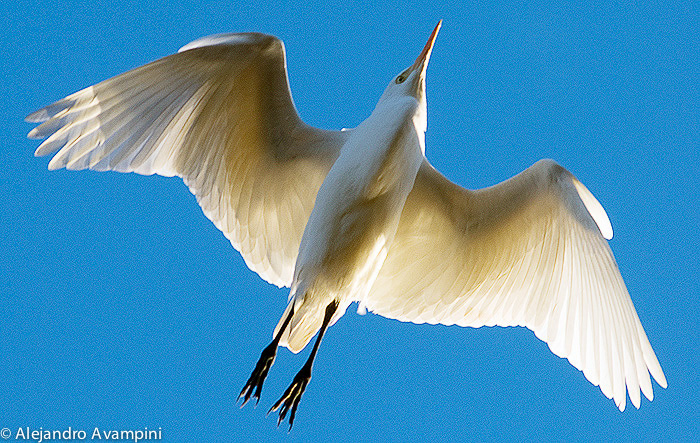 This species is easily recognized in flight due to its long legs stretched out in back and its long neck pulled inward in an “S” shape and the perfect form it takes while majestically gliding through the air.
This species is easily recognized in flight due to its long legs stretched out in back and its long neck pulled inward in an “S” shape and the perfect form it takes while majestically gliding through the air.
Reproduction
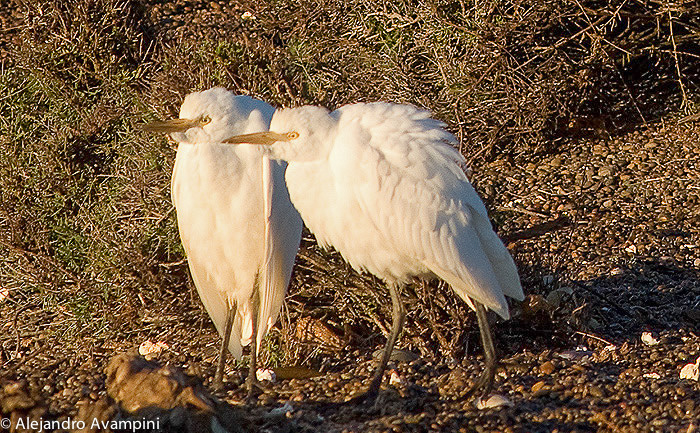 For the building of their nest a pair of Great Egrets will look for an area with trees and easy access to large quantities of dead branches, willows, grasses or dry leaves. Together with these materials they will construct a large platform in which six to eight light-blue eggs will be laid.
For the building of their nest a pair of Great Egrets will look for an area with trees and easy access to large quantities of dead branches, willows, grasses or dry leaves. Together with these materials they will construct a large platform in which six to eight light-blue eggs will be laid.
Turkey Vulture
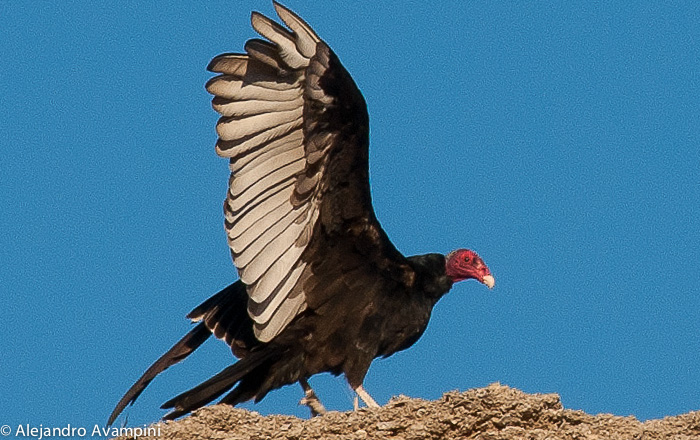 The turkey vulture is a bird of the vulture family , which can be found all across the Americas. In the different countries of the continent, it has different names, such as buzzard, aura, or just vulture. In Valdes Peninsula, it is one of the largest of the vultures, with a red head, blackish plumage, more brown on the upper surface of the wings. The underside of the flight feathers are grey, creating a sharp contrast. The head is small in proportion to the body and has no feathers – in adults it is reddish and in juveniles, it is black.
The turkey vulture is a bird of the vulture family , which can be found all across the Americas. In the different countries of the continent, it has different names, such as buzzard, aura, or just vulture. In Valdes Peninsula, it is one of the largest of the vultures, with a red head, blackish plumage, more brown on the upper surface of the wings. The underside of the flight feathers are grey, creating a sharp contrast. The head is small in proportion to the body and has no feathers – in adults it is reddish and in juveniles, it is black.  It weighs between 1.4 and 2.7 kg, measures 60-76 cm in length and has a wingspan of up to 2 meters. It glides with wings in a “V” shape and often sways in a way that gives the impression that it is drunk. It’s typically seen in Puerto Piramides, flying around the valley, and taking advantage of thermal wind generated by the hills that protect the town from east to west, on the north side. The turkey vulture is a scavenger, ranging over large distances and finding carrion with a keen sense of smell. Typically, it will feed on the carcasses of sea lions, guanaco, hares and rabbits. If it finds a large piece of carrion, such as a calf, it will circle over it, to let other vultures know where the carcass is.
It weighs between 1.4 and 2.7 kg, measures 60-76 cm in length and has a wingspan of up to 2 meters. It glides with wings in a “V” shape and often sways in a way that gives the impression that it is drunk. It’s typically seen in Puerto Piramides, flying around the valley, and taking advantage of thermal wind generated by the hills that protect the town from east to west, on the north side. The turkey vulture is a scavenger, ranging over large distances and finding carrion with a keen sense of smell. Typically, it will feed on the carcasses of sea lions, guanaco, hares and rabbits. If it finds a large piece of carrion, such as a calf, it will circle over it, to let other vultures know where the carcass is.
Burrowing Parrot
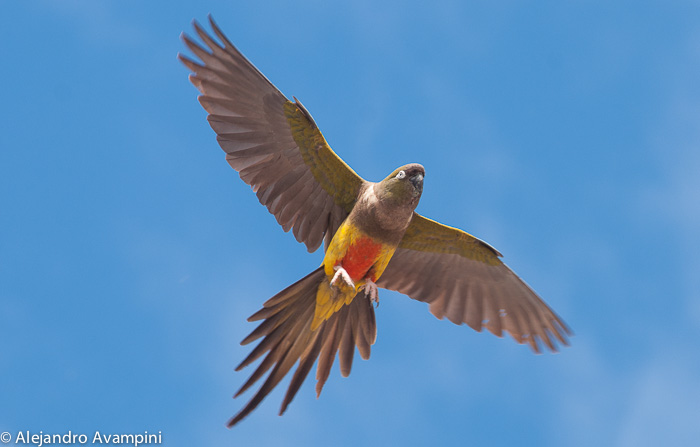 They are usually seen on Valdes Peninsula during spring and summer months. It mates for life and nests in cliffs. They dig a deep burrow in which 2 to 5 eggs are laid. The eggs hatch in late December. The Burrowing Parrot is very colourful and has seven colours in its plumage. On Valdes Peninsula, they are usually seen in flocks of 10- 20 individuals and are very noisy, constantly chattering. Their diet is based on shoots and fruits of shrubs, and they also travel great distances to feed in other regions, attracted by planted fields. This frequently leads to conflict with farmers, because they eat the seed and damage crops. We would to recommend a unique place for travellers, birdwatchers and those who are attracted by birds and nature. 550 km north of Valdes Peninsula, there is a town called El Condor, the Viedma’s beach, capital of Rio Negro province.There is one of the largest parrot colonies in the world, comprising over 100,000 Burrowing Parrots in 9 km of cliff, something which cannot be seen anywhere else on the Planet. We were surprised when we saw this incredible cliff, another natural wonder of Patagonia Argentina, which we had never heard of before. If you decide to go spend a few nights at this resort we recommend the Apart Hotel Costa del Faro, located on the coast, just meters from the cliff.
They are usually seen on Valdes Peninsula during spring and summer months. It mates for life and nests in cliffs. They dig a deep burrow in which 2 to 5 eggs are laid. The eggs hatch in late December. The Burrowing Parrot is very colourful and has seven colours in its plumage. On Valdes Peninsula, they are usually seen in flocks of 10- 20 individuals and are very noisy, constantly chattering. Their diet is based on shoots and fruits of shrubs, and they also travel great distances to feed in other regions, attracted by planted fields. This frequently leads to conflict with farmers, because they eat the seed and damage crops. We would to recommend a unique place for travellers, birdwatchers and those who are attracted by birds and nature. 550 km north of Valdes Peninsula, there is a town called El Condor, the Viedma’s beach, capital of Rio Negro province.There is one of the largest parrot colonies in the world, comprising over 100,000 Burrowing Parrots in 9 km of cliff, something which cannot be seen anywhere else on the Planet. We were surprised when we saw this incredible cliff, another natural wonder of Patagonia Argentina, which we had never heard of before. If you decide to go spend a few nights at this resort we recommend the Apart Hotel Costa del Faro, located on the coast, just meters from the cliff.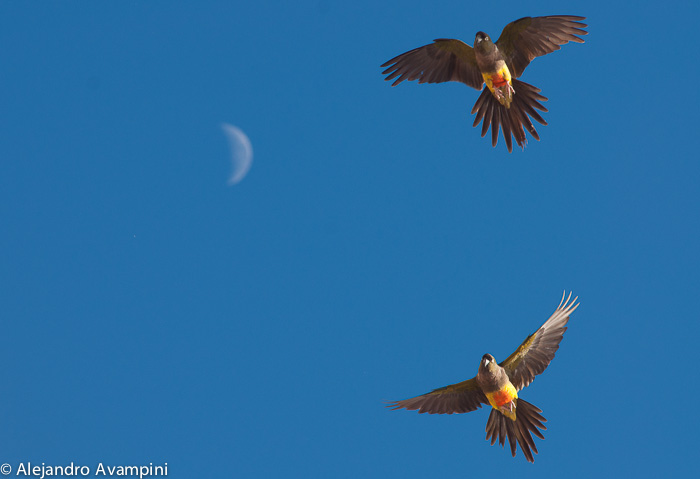
Long-tailed meadowlark

The long-tailed meadowlark (Sturnella loyca), lives in open places in Valdes Peninsula. In spring and summer breeding season, they live in pairs nest in the ground and the female lays 3 to 4 eggs. Here in Puerto Piramides, usually they perch on bushes behind the dunes of Del Nomade Eco – Hotel. They feed on fruit, insects and seeds, these birds will consider it a good omen.
Red Knot
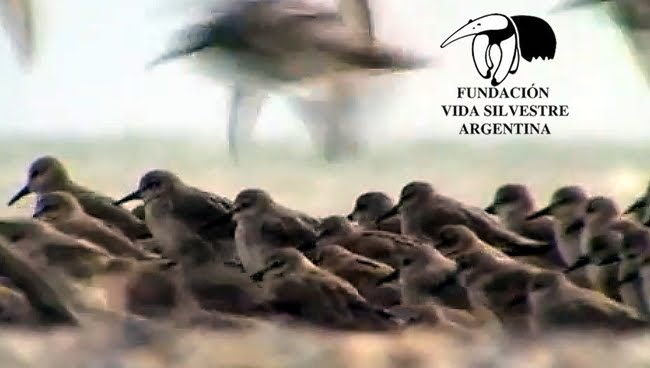 Along their amazing migratory route of unimaginable proportions which begins in the Northern Autumn in the Canadian Arctic and takes them to the Southern extremes, only to then be repeated 4 months later as they return north with their offspring, the Red Knot (Calidris Canutus) and other migratory birds deviate from a straight line to “re-fuel” at 2 specific beaches of the Valdes Peninsula, fundamental for their survival. In their return journey north, a feeding stop is made at the Fracasso and Colombo beaches. The attached video, produced by the Wild-Life Foundation (Fundacion Vida Silvestre), describes the special characteristics found at these two places and explains why they do not stop on the way South. Also illustrated in this documentary is the important roll these humid, marine-coastal zones of the Valdes Peninsula play is sustaining the population of certain species of migratory birds.
Along their amazing migratory route of unimaginable proportions which begins in the Northern Autumn in the Canadian Arctic and takes them to the Southern extremes, only to then be repeated 4 months later as they return north with their offspring, the Red Knot (Calidris Canutus) and other migratory birds deviate from a straight line to “re-fuel” at 2 specific beaches of the Valdes Peninsula, fundamental for their survival. In their return journey north, a feeding stop is made at the Fracasso and Colombo beaches. The attached video, produced by the Wild-Life Foundation (Fundacion Vida Silvestre), describes the special characteristics found at these two places and explains why they do not stop on the way South. Also illustrated in this documentary is the important roll these humid, marine-coastal zones of the Valdes Peninsula play is sustaining the population of certain species of migratory birds.
Great Grebe
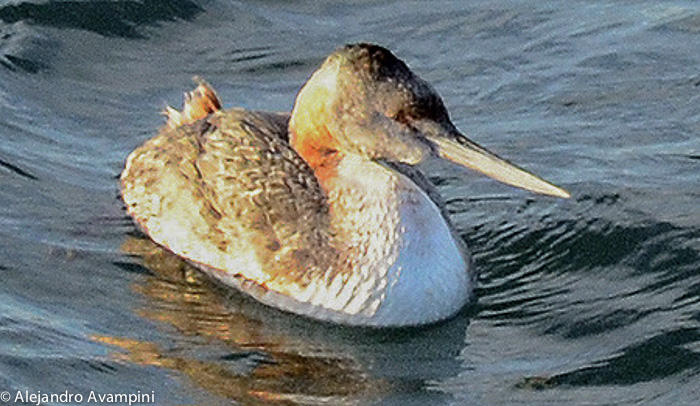 The Great Grebe (Podicephorus major) is coastal bird that is frequently seen in the Valdes Peninsula. Rarely seen in groups or on dry land, they are generally found swimming in shallow water close to the shore, alone or as a pair. The plumage is primarily rust colored around the neck with a black head and white chest. Resident to Patagonia this is not a migratory bird and can be observed fishing or hunting crabs along the shallow waters of both the Golfo Nuevo and Golfo San Jose.
The Great Grebe (Podicephorus major) is coastal bird that is frequently seen in the Valdes Peninsula. Rarely seen in groups or on dry land, they are generally found swimming in shallow water close to the shore, alone or as a pair. The plumage is primarily rust colored around the neck with a black head and white chest. Resident to Patagonia this is not a migratory bird and can be observed fishing or hunting crabs along the shallow waters of both the Golfo Nuevo and Golfo San Jose.
Southern Giant Petrel
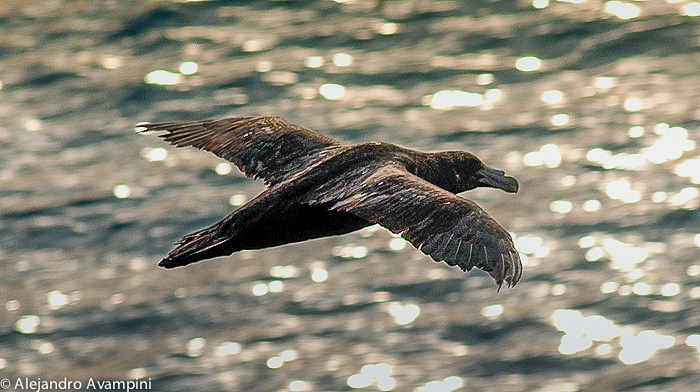 This special bird has an incredibly aerodynamic shape. The distance between the tips of the extended wings reaches 2m. An adult male can weigh up to 5 kg. The family feature is the nostril, located in the upper beak in the form of a single nasal tube, but internally divided in two by a central partition. Monitoring these birds has shown that they have incredible flying skills and stamina.
This special bird has an incredibly aerodynamic shape. The distance between the tips of the extended wings reaches 2m. An adult male can weigh up to 5 kg. The family feature is the nostril, located in the upper beak in the form of a single nasal tube, but internally divided in two by a central partition. Monitoring these birds has shown that they have incredible flying skills and stamina.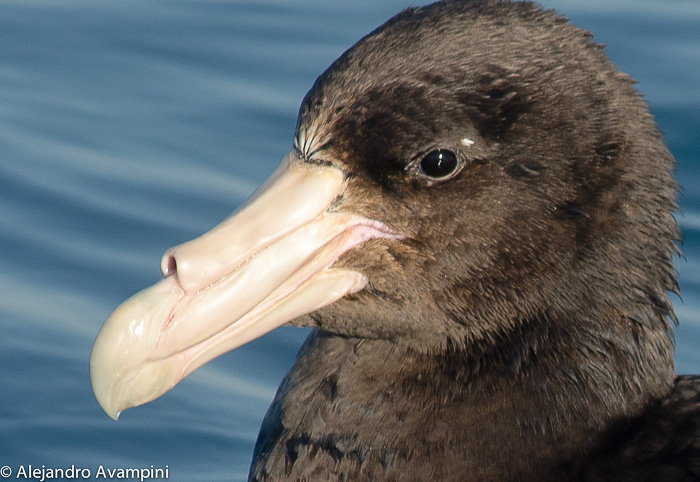
Feeding
They have an excellent sense of smell which helps them find food on the coast. It does not only feed on carrion, such as dead penguins, sea lions and elephant seals, it will also eat penguin or other birds chicks, eggs and sometimes hunts penguins and other seabirds as prey. In the sea they feed on refuse dumped by hundreds of fishing boats which jettison fish unwanted for human consumption, that is to say that tons of dead fish daily discarded at sea. Human predation is causing birds like Giant Petrel have more food as a result of which, their lifespan and reproducion rate are increasing. Consequently birds currently appear in disproportionate numbers, compared to previous years. 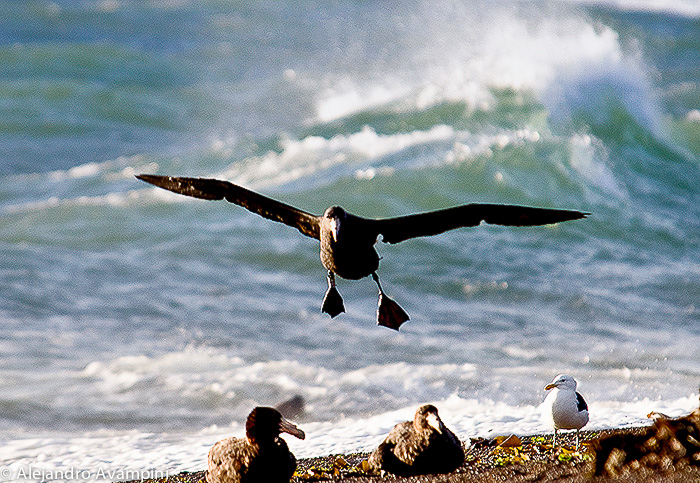
Reproduction
In the colonies of northern Patagonia, the laying date (for a single egg) begins during the last week of October and is relatively synchronous. The first chicks hatch during the last week of December. Adults remain in the nest with the chick for nearly two weeks, after which time, the chicks are left alone in the colony while parents feed at sea, returning to regurgitate food for them. In Patagonia, the chicks become independent around the second week of March and early April. En consecuencia son aves que en la actualidad se ve en número desproporcionado a años anteriores. El monitoreo de ejemplares demostró que vuelan distancias increibles.Un ejemplar anillado en Nueva Zelanda se vió una semana después en las costas patagónicas, lo que implica que volaron mas de 5000 km en menos de 7 días, sobre el agua!!!
Burrowing Owl
The Latin name of this species “cunicularia” means “digging mines or tunnels”, reflecting how this owl builds its nest: in underground tunnels. The owl typically nests in open areas, under the protection of a tree or shrub. It chooses sloping ground, which prevents rainwater from entering the tunnel and flooding it. It is not averse to making use of the abandoned nesting tunnels of other birds and animals.
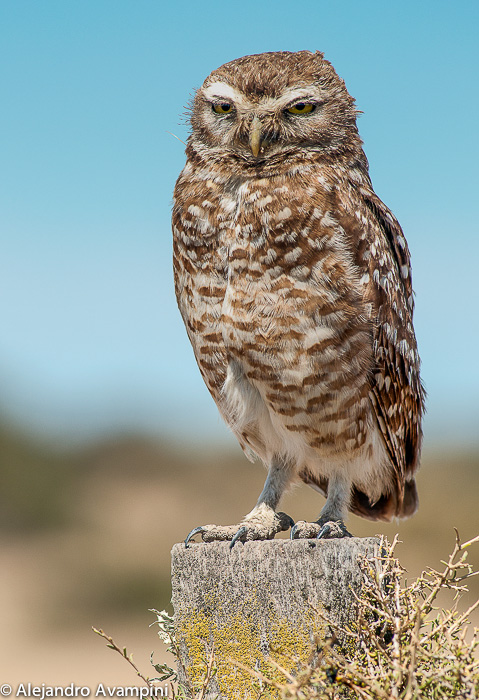
The Burrowing Owl commonly excavates a burrow at the side of fields or by roadsides. Should the entrance become blocked for whatever reason, it will excavate another burrow at the edge of the field. The nesting season runs from October to December. The chicks hatch in 28 days. During hot spells, they can be seen rubbing their beaks or cuddling each other. The owl is not afraid man, on the contrary, it easily adapts to his presence. It lives in open grasslands and can be found in the Caleta Valdes and Punta Delgada. Feeding Burrowing Owls have been subject to persecution by Man, due to irrational superstitions. As a result of this, in addition to placing the Burrowing Owl in danger of extinction, this persecution has altered the environmental balance. This is because, as well as birds, scorpions, insects and other small mammals, which, if allowed to multiply unchecked, would have an adverse effect upon agriculture, they eat rodents which are known carriers of Haemorrhagic Fever, or O’Higgins Disease, which is endemic in Argentina.Many times the man usually irrationality attacks the owls especially because superstitions. The Burrowing Owl has a refined sense of hearing. They can hear sounds of low intensity that allow them to detect the presence of small prey. The thick layer of feathers covering its flat face, operates as a kind of receiver screen that helps to focus sounds on the ears. Their natural predators are ferrets, weasels, cats and foxes, besides man. Whilst out and about, you are sure to see Burrowing Owls and, through binoculars, you will be able to see the deep and direct gaze of their large eyes. The owl’s eyes, like ours are front facing, resulting in binocular vision which allows refined perception of distance. The eyes have many photosensitive cells and large pupils, which permit the bird to distinguish objects clearly in low light.
Southern Martin
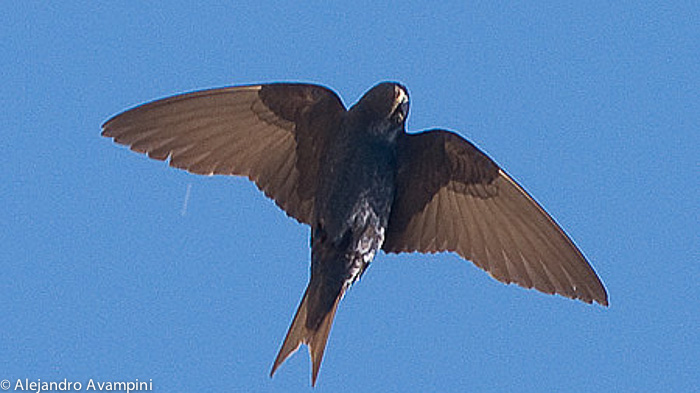
Southern Martin (Progne modesta) is a migratory bird that reaches the Valdes Peninsula in spring accompanied by its enjoyable song and normally observed in groups. This species can be observed in many areas throughout the American Continent with a migratory route that extends over thousands of kilometers. It is a bird that calls little attention to itself being small and relatively uniform in color it is often “lost” amongst the many other small birds, but to the trained eye this incredible and unique species will announce its arrival to Puerto Piramides in spring. The migratory route of this species whether coming or going from the reproductive zone or its wintering area can comprise a distance of as much as 12,000 kilometers. Those of the Valdes Peninsula, in general, migrate to Peru at a rate of some 200km per day. They feed almost exclusively on insects and feed during daylight hours.
Carbonated Sierra-Finch
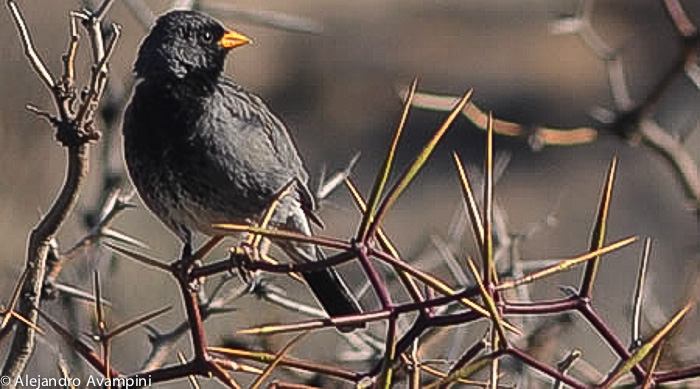
The Carbonated Sierra-Finch (Phrygilus carbonarius), to the untrained eye, is easily confused with a House Sparrow or Rufous-collared Sparrow. During courting behavior the male’s plumage will darken, differentiating it from the female. With their nest close by, we have observed a darker male in the sand dunes behind Del Nomade, flying from bush to bush with its mate. This tiny bird can be found throughout the Peninsula and easily observed in Punta Norte, if quiet, it is curious and not easily frightened.
Yellow-billed Pintail
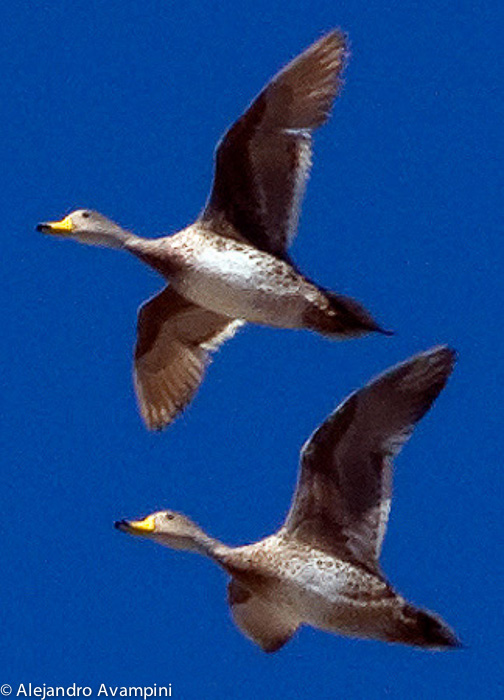
The Yellow-billed Pintail (Anas georgica) is a bird of South America. Lives from southern Brazil to southern Patagonia. He looks in freshwater lakes and occasionally frequents marine coast. It has a significant extent in terms of habitat preference. They can be seen on the sea coast of Patagonia or greater heights of 4,000 m. These birds nest near water and bowl-shaped nests are shallow and sheathes of down. Flocks can be found in the lakes that form after heavy rains.
Shoveler
The Shoveler (Anas platalea) you can see it in Valdes Peninsula. While lives from Tierra del Fuego to the Mesopotamian region (Entre Rios and Corrientes) is not easy to find in this area. It is found in fresh or brackish water and can be seen occasionally on the sea coast.

The male has a particularly clear eye, not the female. It is valued by ornithologists bird, as are all the birds that visit the Natural Paradise Valdes Peninsula.

Common Oyster Catcher
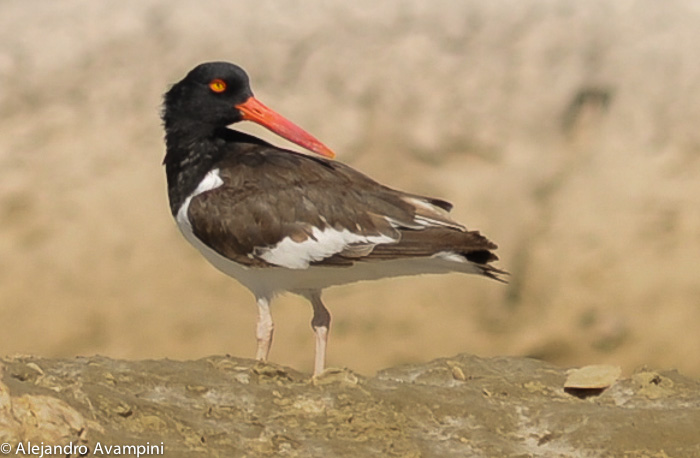 The Common Oyster Catcher (Haemantopus palliatus) is a bird that basks in the solitude of the Patagonian Coast living in a life-long mating pair, these birds are bothered by human presence. With a dark brown back, yellow eye and bright red ocular ring and a long red beak, they can reach a size of more than 40cm. and 700gr. They will build a camouflaged nest just meters from the high tide line.
The Common Oyster Catcher (Haemantopus palliatus) is a bird that basks in the solitude of the Patagonian Coast living in a life-long mating pair, these birds are bothered by human presence. With a dark brown back, yellow eye and bright red ocular ring and a long red beak, they can reach a size of more than 40cm. and 700gr. They will build a camouflaged nest just meters from the high tide line.
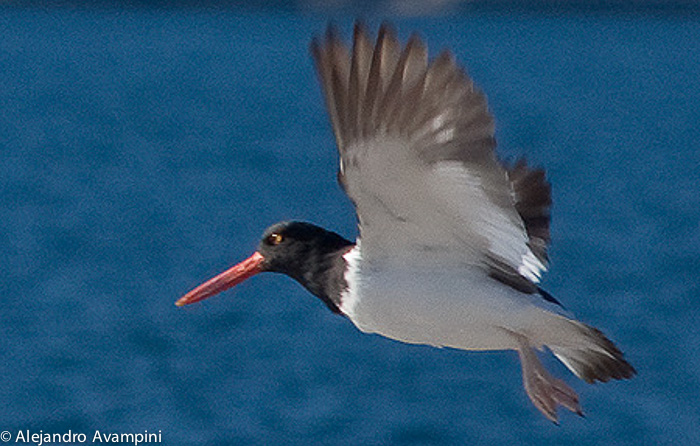 The wings of the Oyster Catcher are dark brown on top but while in flight the plumage below their wings is White. A guaranteed sighting of this species will be found walking towards the caves, a 2,5km coastal walk from Puerto Piramides. When approaching, these birds will begin with their unique sounds, alerting other birds in the area.
The wings of the Oyster Catcher are dark brown on top but while in flight the plumage below their wings is White. A guaranteed sighting of this species will be found walking towards the caves, a 2,5km coastal walk from Puerto Piramides. When approaching, these birds will begin with their unique sounds, alerting other birds in the area.
South American Tern
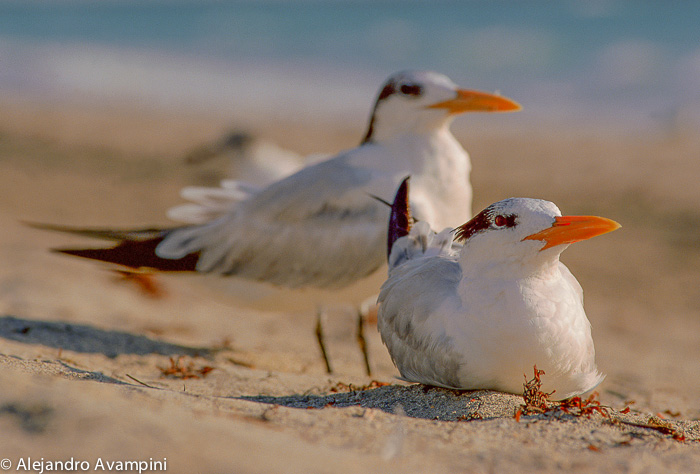 The South American Tern is one of the 3 species of terns that nest on the coast of Argentina and is found inValdes Peninsula. It is rather more difficult to observe that the kelp gull, because it has a small population size. The breeding season begins in December and you will be able to see them flying over the ledges and cliffs. After nesting, from March onwards they are no longer predictable. Terns nest every year, but not in the same places, often choosing quiet coastal places in very exposed sites but are very sensitive to disturbance. Their diet is based on fish; their fishing technique is to plunge into the sea s to capture their prey.
The South American Tern is one of the 3 species of terns that nest on the coast of Argentina and is found inValdes Peninsula. It is rather more difficult to observe that the kelp gull, because it has a small population size. The breeding season begins in December and you will be able to see them flying over the ledges and cliffs. After nesting, from March onwards they are no longer predictable. Terns nest every year, but not in the same places, often choosing quiet coastal places in very exposed sites but are very sensitive to disturbance. Their diet is based on fish; their fishing technique is to plunge into the sea s to capture their prey.
Imperial Cormorant
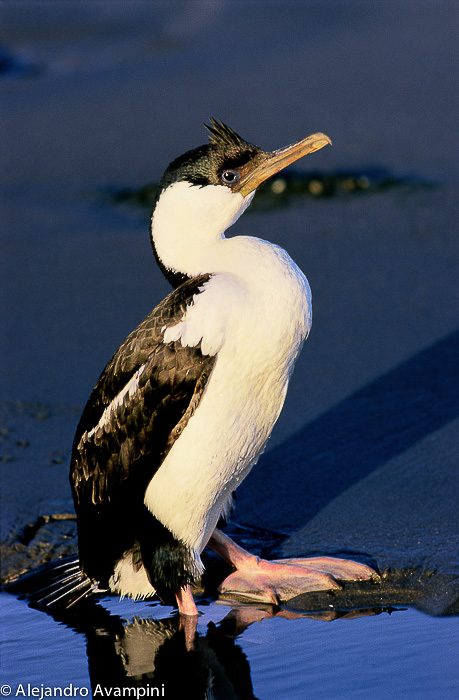
Along the entire coast of continental Patagonia, the imperial cormorant is a species almost piscivorous but also feeds on marine invertebrates such as cephalopods, crustaceans and polychaetes. The Imperial Cormorant consumes a large proportion of pelagic and demersal fishes such as anchovy, hake and some species of mackerel and uses a broad range of depths throughout the water column.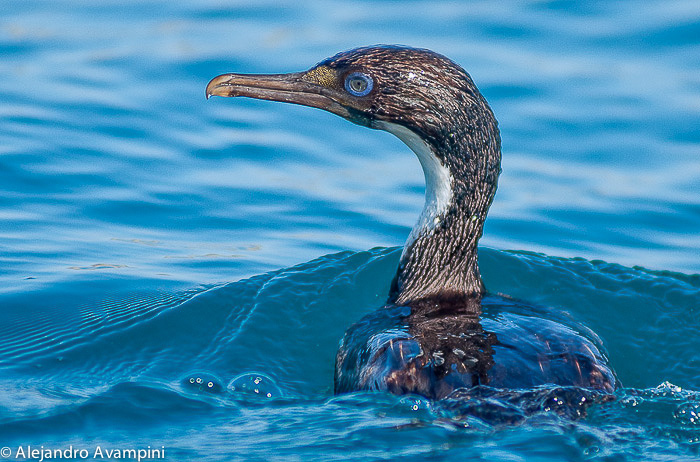 Recent studies showed that the Imperial Cormorant feeds both in shallow coastal waters as well as deep waters (about 70m) and offshore (more than 8 km). The imperial cormorant is the leading producer of guano in Patagonia. Currently, the guano is mined in only a few colonies of Chubut and Santa Cruz. The guano exploitation is still carried out in a similar way to that of a few decades ago, and its extraction is carried out manually and sporadically.
Recent studies showed that the Imperial Cormorant feeds both in shallow coastal waters as well as deep waters (about 70m) and offshore (more than 8 km). The imperial cormorant is the leading producer of guano in Patagonia. Currently, the guano is mined in only a few colonies of Chubut and Santa Cruz. The guano exploitation is still carried out in a similar way to that of a few decades ago, and its extraction is carried out manually and sporadically.
Rock Cormorants
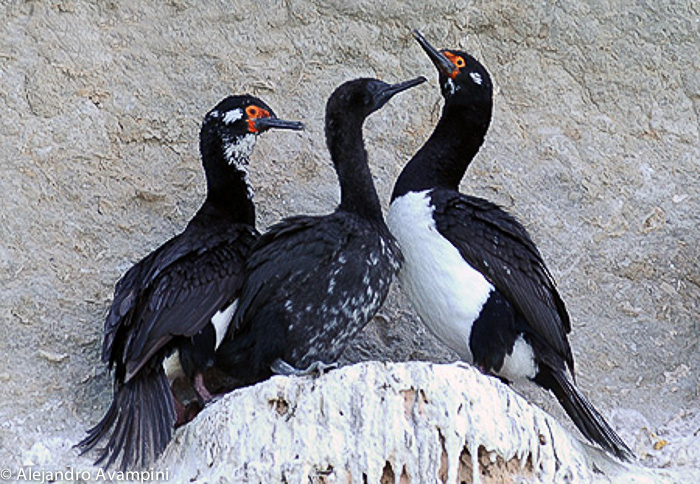 Rock Cormorants (Phalacrocorax magellanicus) are maritime birds that rook on rocky cliffs, and thus their name. They are extremely well adapted birds both in flight and below the water. Underwater they advanced using their webbed feet. This species exists only in the Patagonian region of Argentina and Chile. The Rock Cormorant colony at Punta Loma in one of the largest, with approximately 280 mating pairs and other, smaller rookeries exist along the coast of Golfo Nuevo. They will remain in the same colony throughout the year while adapting their behavior in accordance to the changing seasons. From March through September they are primarily found feeding and spend very little time on the nest. From October through February their behavior changes dramatically as they dedicate most of their time to mating, incubating and raising their chicks. The chicks will hatch 30 days after the female lays her eggs, usually just 2 eggs that will be mutually incubated by the pair. For two months the pair will take turns protecting the nest and chicks while the other heads out to sea in search of food.
Rock Cormorants (Phalacrocorax magellanicus) are maritime birds that rook on rocky cliffs, and thus their name. They are extremely well adapted birds both in flight and below the water. Underwater they advanced using their webbed feet. This species exists only in the Patagonian region of Argentina and Chile. The Rock Cormorant colony at Punta Loma in one of the largest, with approximately 280 mating pairs and other, smaller rookeries exist along the coast of Golfo Nuevo. They will remain in the same colony throughout the year while adapting their behavior in accordance to the changing seasons. From March through September they are primarily found feeding and spend very little time on the nest. From October through February their behavior changes dramatically as they dedicate most of their time to mating, incubating and raising their chicks. The chicks will hatch 30 days after the female lays her eggs, usually just 2 eggs that will be mutually incubated by the pair. For two months the pair will take turns protecting the nest and chicks while the other heads out to sea in search of food. 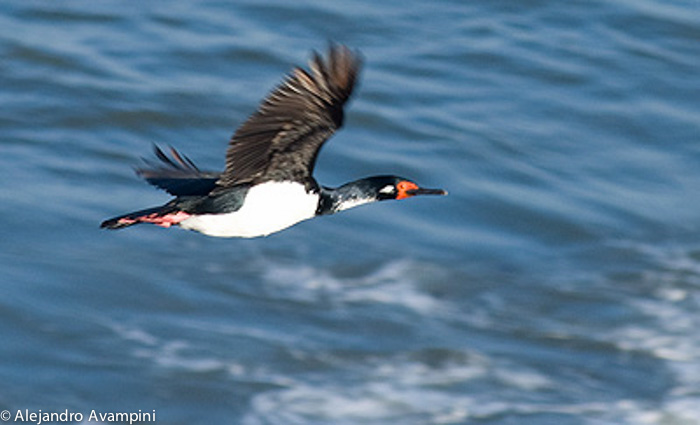 These Cormorants are frequently observed flying a precise straight line just above the surface of the ocean and, from time to time, lightly touching the surface with the tip of their wings. This species almost exclusively feeds on fish and in contrast to other cormorants, observations suggest that it mostly feeds on species of schooling fish. In a maritime environment the Neo-Tropic Cormorant (Phalacrocorax olivaceus) has be observed feeding alone as well as in groups and almost exclusively in shallow coastal waters less than 1.3km from the shore and in no more than 10mt depth. After diving, they are commonly observed standing with their wings spread out in order to dry. Their nests are built with twigs cemented together with their own guano.
These Cormorants are frequently observed flying a precise straight line just above the surface of the ocean and, from time to time, lightly touching the surface with the tip of their wings. This species almost exclusively feeds on fish and in contrast to other cormorants, observations suggest that it mostly feeds on species of schooling fish. In a maritime environment the Neo-Tropic Cormorant (Phalacrocorax olivaceus) has be observed feeding alone as well as in groups and almost exclusively in shallow coastal waters less than 1.3km from the shore and in no more than 10mt depth. After diving, they are commonly observed standing with their wings spread out in order to dry. Their nests are built with twigs cemented together with their own guano.
Neotropic cormorant

It is frequently seen flying swiftly the Neotropic cormorant (Phalacrocorax olivaceus), almost touching the water with a straight and accurate flight; and occasionally they touch the surface with the wingtips. This species is basically piscivorous. However, the same observations suggest that, unlike the cormorant black neck and imperial cormorant , the diet of this species consists of a high proportion of fish that move in schools and near the surface such as mackerel and bottom fish like sea bass. In marine environments, it has been observed feeding both individually and in flocks. primarily (under 1.3 km and no more than 10 m deep) It feeds in coastal waters and shallow. After his dives in search of food, it is commonly seen with outspread wings toward the sun on some safe pathways to get rid of moisture. They build nests with branches cemented his own guano.
Brown Hooded Gull
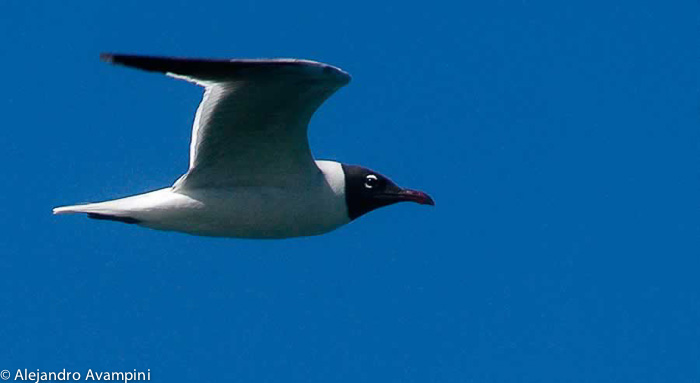
The Brown Hooded Gull (Larus maculipennis) gets its name for an obvious reason. Standing at approximately 35cm this bird has a distinct dark-brown head, combined with white and grey plumage over the rest of its body and dark plumage on the tips of its wings and tail feathers. Its beak, feet and legs are red. According to the Coastal Patagonia Bird and Mammal guide, written by Guillermo Harris, the Brown Hooded Gull can be found year round thourghout the Valdes Peninsula. Courting and mating behavior begins in October, the chicks will hatch in November and will abandon their nest in February. They are easily observed along the coast of Puerto Madryn and El Doradillo.
Seagull
It is the most abundant species on our coastline, with a huge population and many subspecies. It is considered one of the most important components in the dynamics of many towns on the Patagonian coast.  It can measure up to 60 centimeters in length, the body is white and the wings black. Gulls are present all over Patagonia, extending to Tierra del Fuego and beyond, as far south as the Falkland Islands, South Atlantic Islands and Antarctica. They lay up to three eggs, nest and return to the same area every year. They feed naturally on intertidal resources, although their behaviour is very opportunistic and has been modified by the food supply generated by humans. Because of this, the growth of populations of gulls has grown-up considerably. They feed in open dumps, eat carrion, insects, grains, small fishes and …whales! The behaviour of gulls feeding off whales is, we believe, unique to our region.
It can measure up to 60 centimeters in length, the body is white and the wings black. Gulls are present all over Patagonia, extending to Tierra del Fuego and beyond, as far south as the Falkland Islands, South Atlantic Islands and Antarctica. They lay up to three eggs, nest and return to the same area every year. They feed naturally on intertidal resources, although their behaviour is very opportunistic and has been modified by the food supply generated by humans. Because of this, the growth of populations of gulls has grown-up considerably. They feed in open dumps, eat carrion, insects, grains, small fishes and …whales! The behaviour of gulls feeding off whales is, we believe, unique to our region.
Attacks to whales
 In the last decade whales have been affected by attacks by gulls, who have developed a liking for the proteins in the skin and blubber of whales. Over the years, the technique that had developed by only a few gulls, has been passed on to other birds and new generations, making the attacks happen more frequently and altering the behaviour of these giant cetaceans. Moreover, fish discards and waste dumps, and mainly the landfill at Puerto Madryn, have led to a huge increase in the numbers of seagulls, which have food guaranteed all year, thus increasing their birth rate. As a result, the number of individuals is grows-ing exponentially in Valdes Peninsula.
In the last decade whales have been affected by attacks by gulls, who have developed a liking for the proteins in the skin and blubber of whales. Over the years, the technique that had developed by only a few gulls, has been passed on to other birds and new generations, making the attacks happen more frequently and altering the behaviour of these giant cetaceans. Moreover, fish discards and waste dumps, and mainly the landfill at Puerto Madryn, have led to a huge increase in the numbers of seagulls, which have food guaranteed all year, thus increasing their birth rate. As a result, the number of individuals is grows-ing exponentially in Valdes Peninsula. In order to escape the unwelcome and possibly painful attention of the gulls, whales have taken to adopting the “galleon” position, in which only the animal’s head and tail are exposed above water, the rest of the body being submerged. The also try to outwit the gulls by remaining submerged totally for longer periods, swimming and breaching. These techniques involve the whales expending a great deal more energy and, as the Valdes Peninsula is primarily a mating and breeding area, where food is not common, could have an adverse effect on the population.
In order to escape the unwelcome and possibly painful attention of the gulls, whales have taken to adopting the “galleon” position, in which only the animal’s head and tail are exposed above water, the rest of the body being submerged. The also try to outwit the gulls by remaining submerged totally for longer periods, swimming and breaching. These techniques involve the whales expending a great deal more energy and, as the Valdes Peninsula is primarily a mating and breeding area, where food is not common, could have an adverse effect on the population.
Case Study
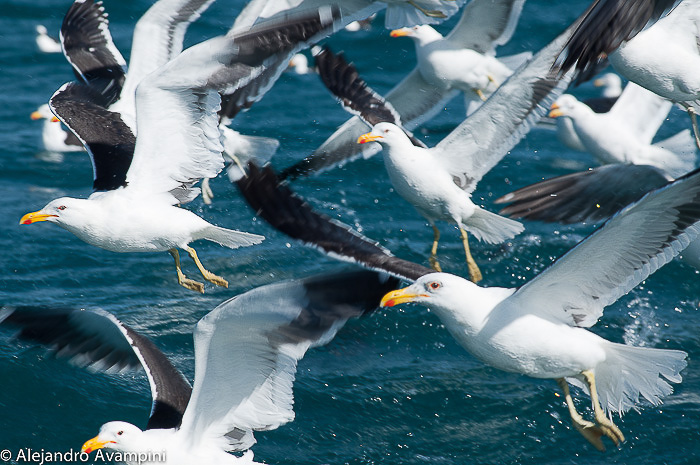 In 2005, a study group led by Ms. Anne Fazio, Biological Sciences graduate, and Dr. Marcelo Bertellotti, planned a study with three years’ duration, in which the first thing they wanted to know was, if the whales skin and fat feeding behaviour was or was not widespread throughout the population of gulls. They wanted to ring them, so as to identify them when they were attacking. This task took place at Punta Piramides platform, where there is a nesting colony of gulls. They captured the gulls by means of a cannon- net. The gulls were then ringed with individually coded rings and samples of blood and feathers etc were taken, to ascertain the overall health of the gull population. Despite the great effort and hours of work of the whole group, it became increasingly difficult to capture gulls, because they learned very fast and avoid the traps. In the event, ringing was achieved only in 20% of the population. In addition there are seagulls from different areas feeding on whales. Ana says that “(…) for these two reasons, the brand was very dilute, we had only 2% of cases where we saw a branded seagull attacking. Also, with so many hours and days of observation in the water, you could see that even not all the seagulls attacked, it was not a small group, and the worst of all: they were more and more!.
In 2005, a study group led by Ms. Anne Fazio, Biological Sciences graduate, and Dr. Marcelo Bertellotti, planned a study with three years’ duration, in which the first thing they wanted to know was, if the whales skin and fat feeding behaviour was or was not widespread throughout the population of gulls. They wanted to ring them, so as to identify them when they were attacking. This task took place at Punta Piramides platform, where there is a nesting colony of gulls. They captured the gulls by means of a cannon- net. The gulls were then ringed with individually coded rings and samples of blood and feathers etc were taken, to ascertain the overall health of the gull population. Despite the great effort and hours of work of the whole group, it became increasingly difficult to capture gulls, because they learned very fast and avoid the traps. In the event, ringing was achieved only in 20% of the population. In addition there are seagulls from different areas feeding on whales. Ana says that “(…) for these two reasons, the brand was very dilute, we had only 2% of cases where we saw a branded seagull attacking. Also, with so many hours and days of observation in the water, you could see that even not all the seagulls attacked, it was not a small group, and the worst of all: they were more and more!.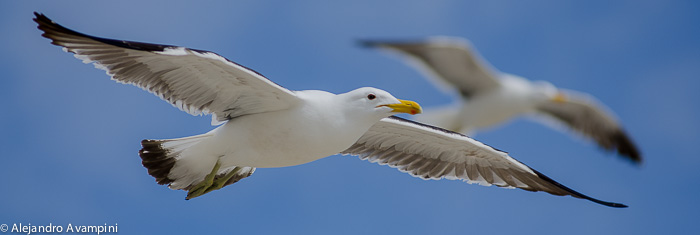 We also have an overall record of the attack rate during the three seasons of whales watching, knowing the peaks of the curves (times of increased number of attacks per unit time). This information is very useful, since at the time of taking up the study comparisons can be made with other years to see if the attack rate has increased or decreased. In addition, samples were analyzed to search for pathogens with which the gulls can infect whales; we’ve found some and it is something that really concerns us. It is likely that, by moving from whale to whale, the gulls will not only infect the whales with pathogens which they carry, but could also transmit as carriers, pathogens and infections which are carried by the whales. AsValdes Peninsula is an area with a high transient population of whales, including calves, this is a matter of real concern and could have a greater effect on the whales than a mere change in behaviour. “ One of the most important conclusions, agreed by a majority, was to close the open dump in Puerto Madryn. We know that populations of gulls increased for many years, until ‘97 and then remained constant. The main causes were fishing discards and waste dumps. That’s why the plan launched by the Province to eradicate open dumps around Chubut is an incrediblebreakthrough on minimizing environmental impact, and may the get the rate of reproduction of the gulls back into balance.
We also have an overall record of the attack rate during the three seasons of whales watching, knowing the peaks of the curves (times of increased number of attacks per unit time). This information is very useful, since at the time of taking up the study comparisons can be made with other years to see if the attack rate has increased or decreased. In addition, samples were analyzed to search for pathogens with which the gulls can infect whales; we’ve found some and it is something that really concerns us. It is likely that, by moving from whale to whale, the gulls will not only infect the whales with pathogens which they carry, but could also transmit as carriers, pathogens and infections which are carried by the whales. AsValdes Peninsula is an area with a high transient population of whales, including calves, this is a matter of real concern and could have a greater effect on the whales than a mere change in behaviour. “ One of the most important conclusions, agreed by a majority, was to close the open dump in Puerto Madryn. We know that populations of gulls increased for many years, until ‘97 and then remained constant. The main causes were fishing discards and waste dumps. That’s why the plan launched by the Province to eradicate open dumps around Chubut is an incrediblebreakthrough on minimizing environmental impact, and may the get the rate of reproduction of the gulls back into balance.


 También contamos con excursiones a la Playa el Doradillo, Punta Tombo, Península Valdés Norte y Sur, entre otras. Contactenos por consultas y reservas
También contamos con excursiones a la Playa el Doradillo, Punta Tombo, Península Valdés Norte y Sur, entre otras. Contactenos por consultas y reservas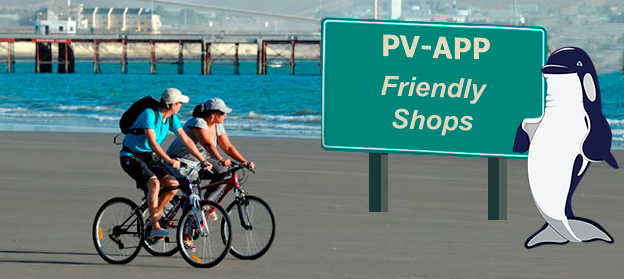



 If you are coming by car when you enter to Valdes Peninsula, almost half way betweenPuerto Madryn and Puerto Piramide, you will stop by the boxes where you must
If you are coming by car when you enter to Valdes Peninsula, almost half way betweenPuerto Madryn and Puerto Piramide, you will stop by the boxes where you must  The closest city is Puerto Madryn, approximately 100km away. The city has an active “downtown” and the air of port town with its extensive beaches, coastal marine walk and central pier where commercial fishing vessels and the occasional cruise ship can be spotted. Over a isolated road scattered with wild animals and accompanied by the natural beauty of these latitudes you with be introduced to the Valdes Peninsula. Please travel with caution. From the road you will encounter Merino Sheep, Guanacos, the Elegant Crested Tinomon, Darwin’s Rhea and falcons. Off in the distance, and in just a few areas, you can observe the two gulfs of the Peninsula, the Golfo San Jose to the north and the Golfo Nuevo to the south. The road is paved all the way to the town making it impossible to get lost.
The closest city is Puerto Madryn, approximately 100km away. The city has an active “downtown” and the air of port town with its extensive beaches, coastal marine walk and central pier where commercial fishing vessels and the occasional cruise ship can be spotted. Over a isolated road scattered with wild animals and accompanied by the natural beauty of these latitudes you with be introduced to the Valdes Peninsula. Please travel with caution. From the road you will encounter Merino Sheep, Guanacos, the Elegant Crested Tinomon, Darwin’s Rhea and falcons. Off in the distance, and in just a few areas, you can observe the two gulfs of the Peninsula, the Golfo San Jose to the north and the Golfo Nuevo to the south. The road is paved all the way to the town making it impossible to get lost.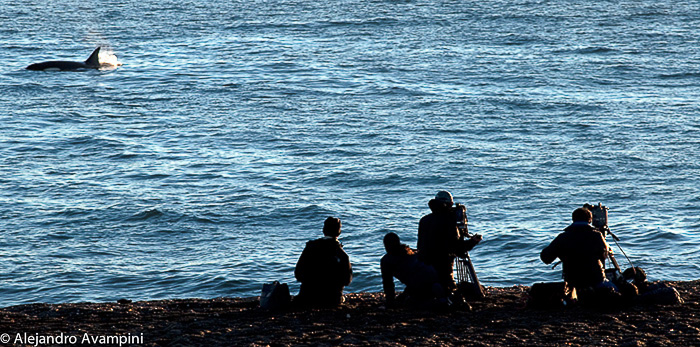
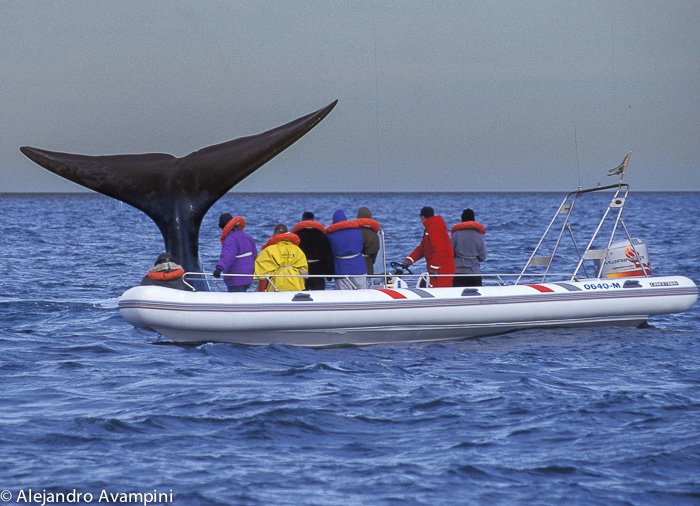 It is 104 km from Puerto Madryn, an hour by vehicle from the airport or bus station there and almost two from the airport and bus station in Trelew. There are nearly 500 permanent residents in Puerto Piramides , make their living from tourism which, year after year, brings visitors wishing to take advantage of the only whale watching port in Valdes Peninsula.
It is 104 km from Puerto Madryn, an hour by vehicle from the airport or bus station there and almost two from the airport and bus station in Trelew. There are nearly 500 permanent residents in Puerto Piramides , make their living from tourism which, year after year, brings visitors wishing to take advantage of the only whale watching port in Valdes Peninsula.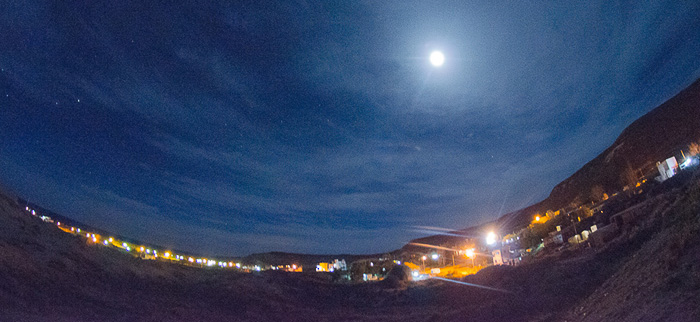 From the point of view of travellers, lovers and connoisseurs of nature in general and the Peninsula in particular, we recommend a stay of four days and three nights, to gain optimum benefit from all that the area has to offer and to enjoy it to it’s fullest. A prerequisite of visitingPuerto Piramides, is to accept or be willing to learn to enjoy nature and tranquillity; advertising, television, formal clothing and all the necessities of city living are not what Puerto Piramides is about.
From the point of view of travellers, lovers and connoisseurs of nature in general and the Peninsula in particular, we recommend a stay of four days and three nights, to gain optimum benefit from all that the area has to offer and to enjoy it to it’s fullest. A prerequisite of visitingPuerto Piramides, is to accept or be willing to learn to enjoy nature and tranquillity; advertising, television, formal clothing and all the necessities of city living are not what Puerto Piramides is about.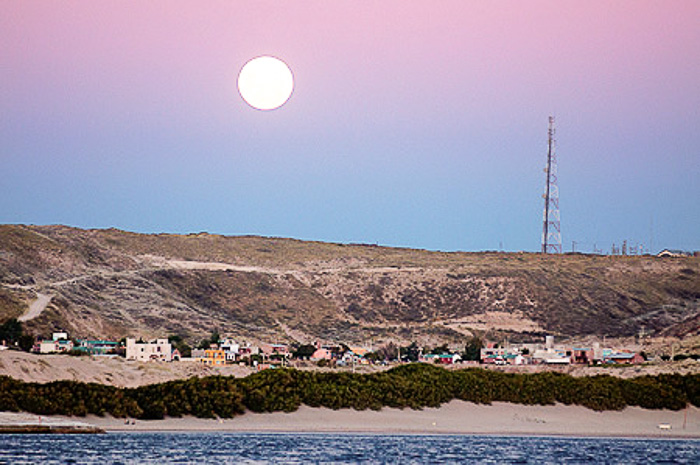 The village of Puerto Piramides has only three streets, so it is not possible to get lost and it is easy to move about in. Amble along the streets, see the people and speak to them, get to know them. You can be assured of a warm welcome wherever you go.
The village of Puerto Piramides has only three streets, so it is not possible to get lost and it is easy to move about in. Amble along the streets, see the people and speak to them, get to know them. You can be assured of a warm welcome wherever you go.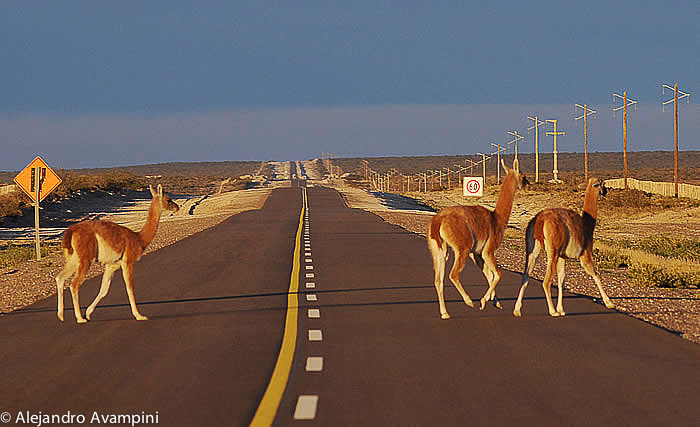


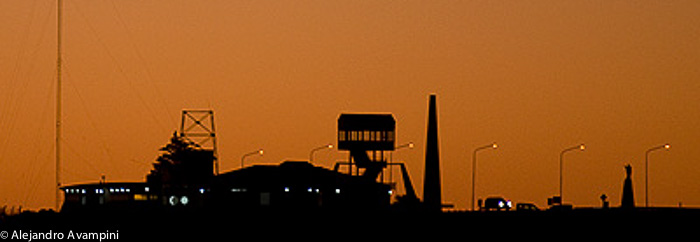 A desolate road occupied by wild animals, unique to the landscape of theses latitudes, serves as an introduction to the Valdes Peninsula. 7km after passing the control booths and entrance to the Peninsula, a large round-about offers access to the Visitors Center.Here a small and well maintained museum exhibits a general view of the region and a complete skeleton of a juvenile Southern Right Whale.
A desolate road occupied by wild animals, unique to the landscape of theses latitudes, serves as an introduction to the Valdes Peninsula. 7km after passing the control booths and entrance to the Peninsula, a large round-about offers access to the Visitors Center.Here a small and well maintained museum exhibits a general view of the region and a complete skeleton of a juvenile Southern Right Whale.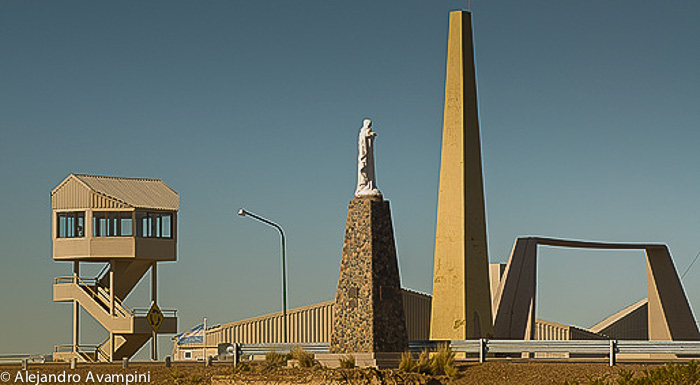 Passing the round-about and 28km further down the road is Puerto Piramides.
Passing the round-about and 28km further down the road is Puerto Piramides.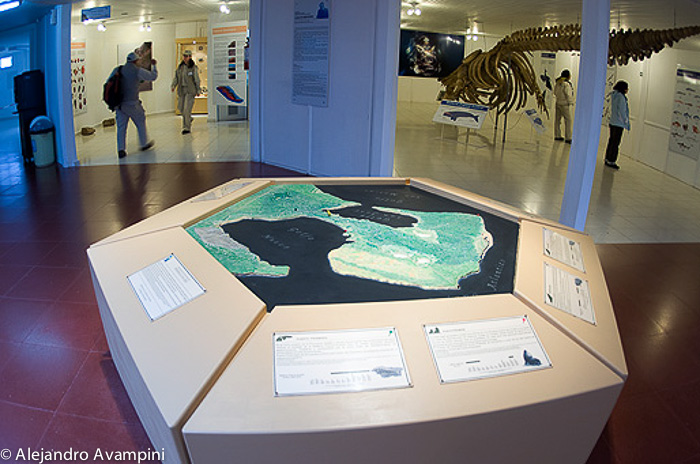 Different videos are shown in the multi-media room, graphically explaining the different aspects of the Valdes Peninsula. Other installations include taxidermy birds and detailed graphics of fossils, fish and the fauna in general that are found in the peninsula. Outside, an observation tower provides an excellent space for contemplating the immense Patagonian Steppe. Along the side of the visitor’s center, a walkway invites you through an interpretive path for a better understanding and identification of the diverse and interesting flora which to the unexperienced eye, look the same and are easily confused, being short and relatively uniform in color. A stop here is recommended and aside from the mentioned installations, there is a souvenir shop, kiosk and very nice restrooms, allowing a more comfortable arrival to Puerto Piramides.
Different videos are shown in the multi-media room, graphically explaining the different aspects of the Valdes Peninsula. Other installations include taxidermy birds and detailed graphics of fossils, fish and the fauna in general that are found in the peninsula. Outside, an observation tower provides an excellent space for contemplating the immense Patagonian Steppe. Along the side of the visitor’s center, a walkway invites you through an interpretive path for a better understanding and identification of the diverse and interesting flora which to the unexperienced eye, look the same and are easily confused, being short and relatively uniform in color. A stop here is recommended and aside from the mentioned installations, there is a souvenir shop, kiosk and very nice restrooms, allowing a more comfortable arrival to Puerto Piramides.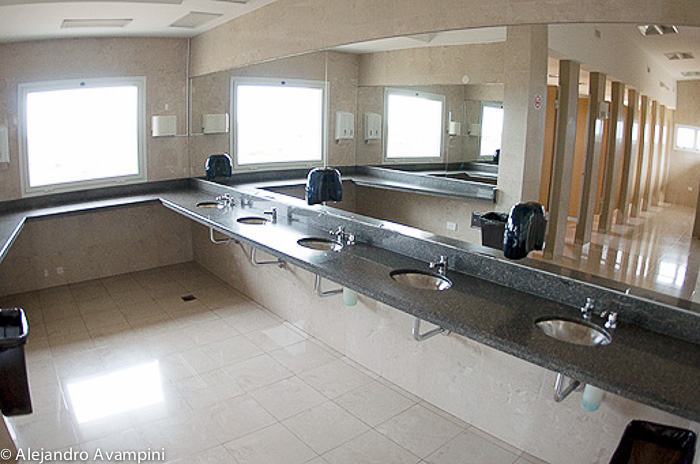 It is normal to encounter Guanacos, Choiques, Maras and ocasionaly sheep that have passed the fence, while traveling this route. For this reason one should drive cautiously and pay special attention. In some areas you can see, in the distance, both the Golfo Nuevo, to the south, and the Golfo San Jose to the north. This road is paved and well maintained up to your arrival at Puerto Piramides. It is nearly impossible to get lost and keep in mind, the first view of the bay is the most beautiful, just before dropping around the last curve and into town.
It is normal to encounter Guanacos, Choiques, Maras and ocasionaly sheep that have passed the fence, while traveling this route. For this reason one should drive cautiously and pay special attention. In some areas you can see, in the distance, both the Golfo Nuevo, to the south, and the Golfo San Jose to the north. This road is paved and well maintained up to your arrival at Puerto Piramides. It is nearly impossible to get lost and keep in mind, the first view of the bay is the most beautiful, just before dropping around the last curve and into town.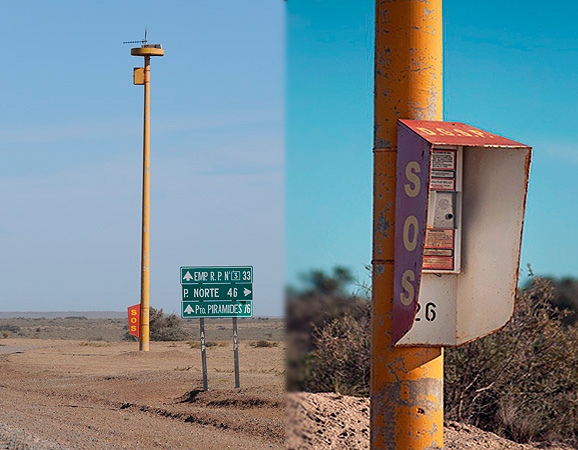 The use of these emergency telephones is simple, just push down on the button for 2 seconds and you will be connected to the Police. In the one minute connection the person calling should indicate their location and the problem.
The use of these emergency telephones is simple, just push down on the button for 2 seconds and you will be connected to the Police. In the one minute connection the person calling should indicate their location and the problem.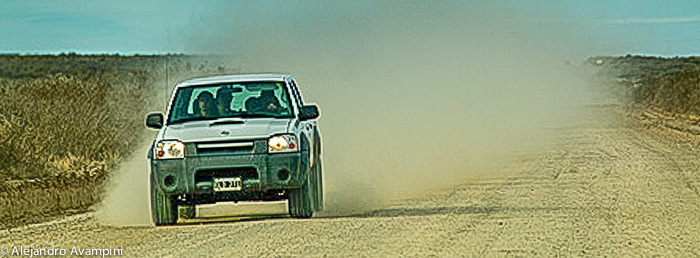 Please pay attention to and obey the road signs and enjoy this amazing World Heritage Site. With patience and going slow you will guarantee a great trip with many trouble free kilometers full of experiences worth sharing.
Please pay attention to and obey the road signs and enjoy this amazing World Heritage Site. With patience and going slow you will guarantee a great trip with many trouble free kilometers full of experiences worth sharing. Due to the maritime characteristics of the Peninsula, annual temperature variations are minimal, with the highs and lows in summer and winter respectively, rarely reaching extremes. Over the entire year the average monthly temperatures vary only 10*C, with a mean summer average of 18 *C and 8*C in winter. In general the climactic conditions of the Peninsula follow those of most of Northern Patagonia, modified locally by atmospheric interactions with surrounding bodies of water. The CENPAT (Center for Patagonian Studies) measures most of the variation from Puerto Madryn, the city closest to Puerto Piramides and the Peninsula, and resting on the shore of the same gulf.
Due to the maritime characteristics of the Peninsula, annual temperature variations are minimal, with the highs and lows in summer and winter respectively, rarely reaching extremes. Over the entire year the average monthly temperatures vary only 10*C, with a mean summer average of 18 *C and 8*C in winter. In general the climactic conditions of the Peninsula follow those of most of Northern Patagonia, modified locally by atmospheric interactions with surrounding bodies of water. The CENPAT (Center for Patagonian Studies) measures most of the variation from Puerto Madryn, the city closest to Puerto Piramides and the Peninsula, and resting on the shore of the same gulf.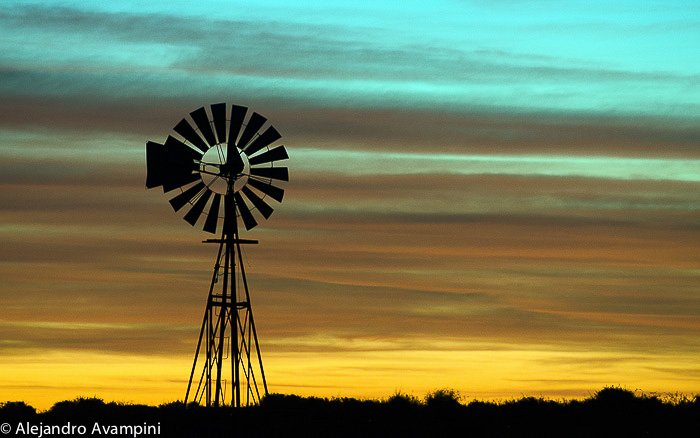 Wind is the dominant factor in all of Patagonia and usually coming off the Andes from the West. Due to its geographic position, Puerto Piramides lies totally exposed to and is most complicated by south-west winds. During the winter months northerlies usually carry humid air due to the anti-cyclonic movement coming off the South Atlantic Ocean. In summer the north winds tend to be dryer as the anti-cyclone moves more to the west over the continent. In summer it is common to encounter a fresh southerly breeze produced from the cooler waters of the Golfo Nuevo. An increase in solar radiation and little water on land creates a significant difference between the temperature along the coast and the temperature over the Golfo.
Wind is the dominant factor in all of Patagonia and usually coming off the Andes from the West. Due to its geographic position, Puerto Piramides lies totally exposed to and is most complicated by south-west winds. During the winter months northerlies usually carry humid air due to the anti-cyclonic movement coming off the South Atlantic Ocean. In summer the north winds tend to be dryer as the anti-cyclone moves more to the west over the continent. In summer it is common to encounter a fresh southerly breeze produced from the cooler waters of the Golfo Nuevo. An increase in solar radiation and little water on land creates a significant difference between the temperature along the coast and the temperature over the Golfo. Tides of the Valdes Peninsula are constantly coming and going. As is normal with the tidal flux almost everywhere, there will be two high tides and two low tides in the 24 hours that make up a day. The times and levels of the tides vary greatly throughout the peninsula.
Tides of the Valdes Peninsula are constantly coming and going. As is normal with the tidal flux almost everywhere, there will be two high tides and two low tides in the 24 hours that make up a day. The times and levels of the tides vary greatly throughout the peninsula.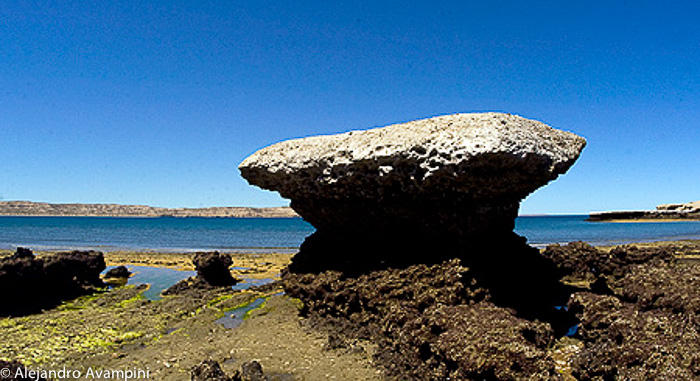 In the Valdes Peninsula the tide levels are more than notable, reaching a difference of more than 5 meters in the Golfo Nuevo and up to more than 8 meters in the Golfo San Jose and on eastern coast along open-ocean.
In the Valdes Peninsula the tide levels are more than notable, reaching a difference of more than 5 meters in the Golfo Nuevo and up to more than 8 meters in the Golfo San Jose and on eastern coast along open-ocean.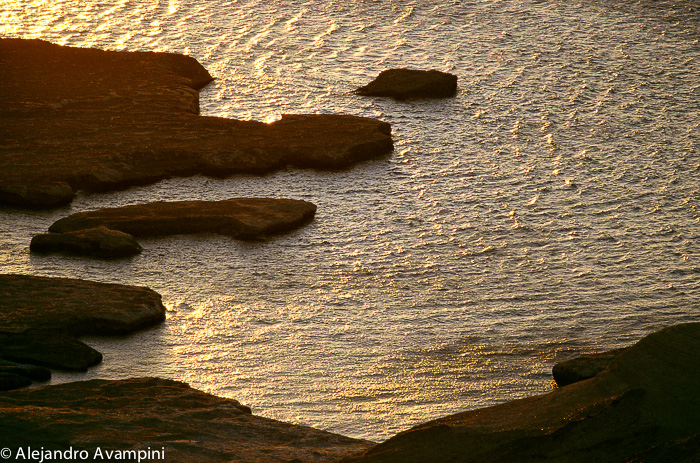 They are also accompanied by a certain margin of error due to factors impossible to predict such as wind intensity and atmospheric pressure.
They are also accompanied by a certain margin of error due to factors impossible to predict such as wind intensity and atmospheric pressure.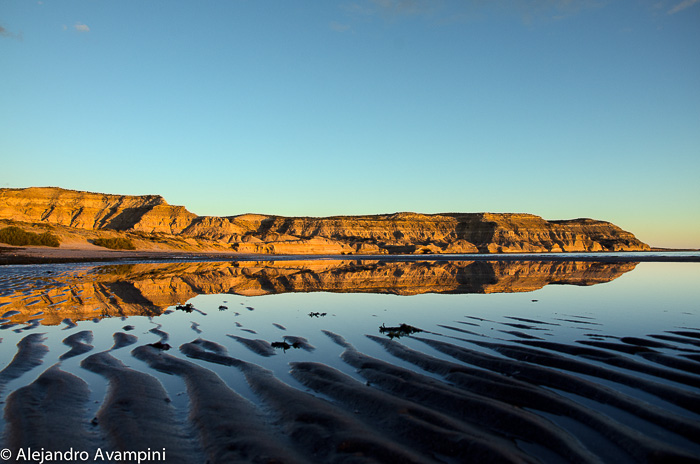 Characteristic to the geography of the Valdes Peninsula are high cliffs and extensive rock reefs that harbor cobblestone, gravel and sandy beaches. Numerous small bays and islands help to complete the picture of this coastline. Formed from sedimentary rock, over the slow geological process that took millions of years, accumulating and consolidating stratus layers into what is now a great exhibition of the past. An amazing display of marine fossils illustrates the varied and complex marine life that one thrived in the area. Some of the most common fossils observed along the coast are oysters (Ostrea Maxima),
Characteristic to the geography of the Valdes Peninsula are high cliffs and extensive rock reefs that harbor cobblestone, gravel and sandy beaches. Numerous small bays and islands help to complete the picture of this coastline. Formed from sedimentary rock, over the slow geological process that took millions of years, accumulating and consolidating stratus layers into what is now a great exhibition of the past. An amazing display of marine fossils illustrates the varied and complex marine life that one thrived in the area. Some of the most common fossils observed along the coast are oysters (Ostrea Maxima), 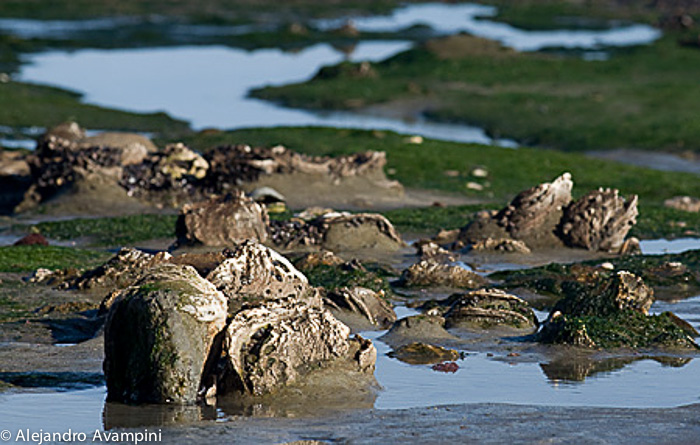 An ancestor to the Great White Shark has left evidence of its existence in the Valdes Peninsula and fossils of this huge predator can often be observed along the cliffs and on the beach. Like with most shark fossils, that of Carcharodon is reduced to thousands of jaw-bones and teeth spread throughout the world. Their skeleton, formed of cartilage, is usually destroyed before fossilization can occur.
An ancestor to the Great White Shark has left evidence of its existence in the Valdes Peninsula and fossils of this huge predator can often be observed along the cliffs and on the beach. Like with most shark fossils, that of Carcharodon is reduced to thousands of jaw-bones and teeth spread throughout the world. Their skeleton, formed of cartilage, is usually destroyed before fossilization can occur.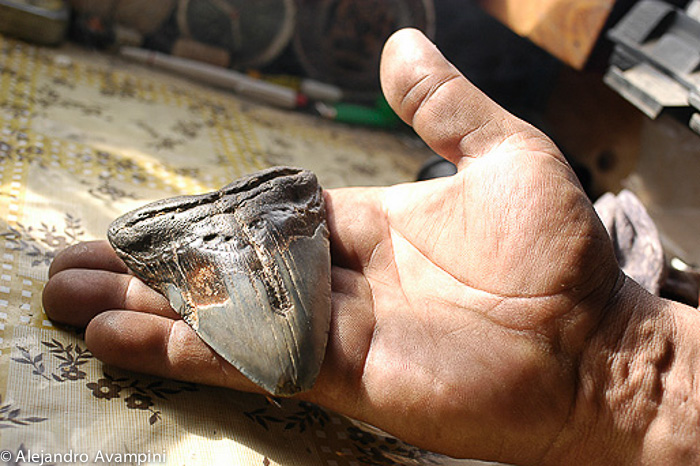

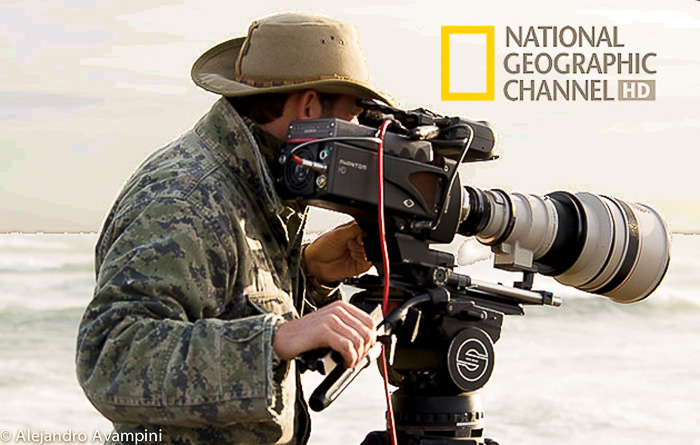
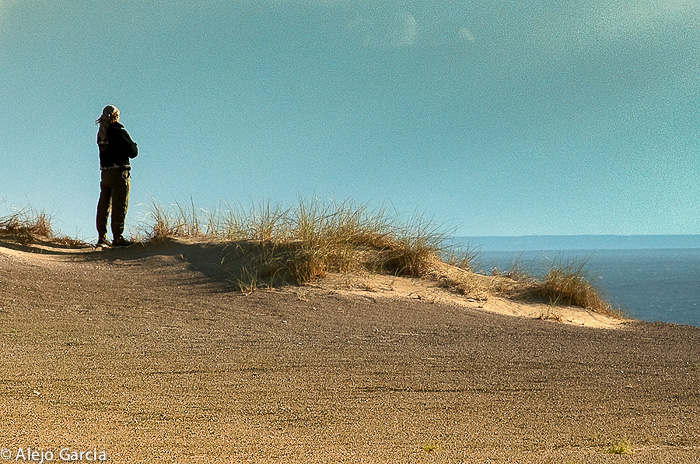 The elevated geological value of the Valdes Peninsula is one of the reasons why it was declared a World Heritage Site. Included in the intentions of this world status are the protection, preservation and importance of the
The elevated geological value of the Valdes Peninsula is one of the reasons why it was declared a World Heritage Site. Included in the intentions of this world status are the protection, preservation and importance of the  This particular geological formation is exposed on a large scale along the coast of Puerto Piramides, due to constant erosion caused by wind, sea and rain. A panorama of deeply carved canyons, chiseled cliffs and gravel deposits along the beaches are accompanied by exposed rock reefs cut out of the cliffs by waves and tides. The bay of Puerto Piramides is marked by a smooth sandy beach while in the bay of Pardeles, just around the point to the south, a steep cobblestone beach. Two large points with high cliffs, jutting out into Golfo Nuevo to the south and west establish the natural limits of the Bay of Puerto Piramides, which is back dropped by large areas of sand dunes produced by millions of years of wind in an incessant process of erosion.
This particular geological formation is exposed on a large scale along the coast of Puerto Piramides, due to constant erosion caused by wind, sea and rain. A panorama of deeply carved canyons, chiseled cliffs and gravel deposits along the beaches are accompanied by exposed rock reefs cut out of the cliffs by waves and tides. The bay of Puerto Piramides is marked by a smooth sandy beach while in the bay of Pardeles, just around the point to the south, a steep cobblestone beach. Two large points with high cliffs, jutting out into Golfo Nuevo to the south and west establish the natural limits of the Bay of Puerto Piramides, which is back dropped by large areas of sand dunes produced by millions of years of wind in an incessant process of erosion.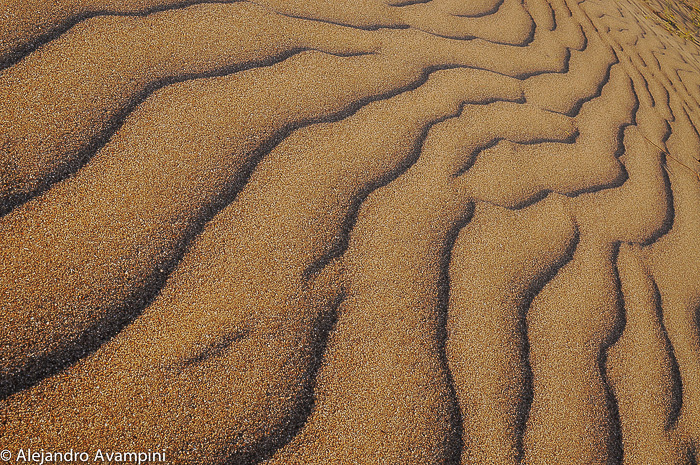 Compatibility amongst different interests in the same geographical area is often extremely difficult to attain and is a dilema with many of the protected natural parks. Often the benefits obtained by protectionist legislation are directly countered by man’s use of the same area, whether for scientific studies, tourism or simply commercial reasons.
Compatibility amongst different interests in the same geographical area is often extremely difficult to attain and is a dilema with many of the protected natural parks. Often the benefits obtained by protectionist legislation are directly countered by man’s use of the same area, whether for scientific studies, tourism or simply commercial reasons.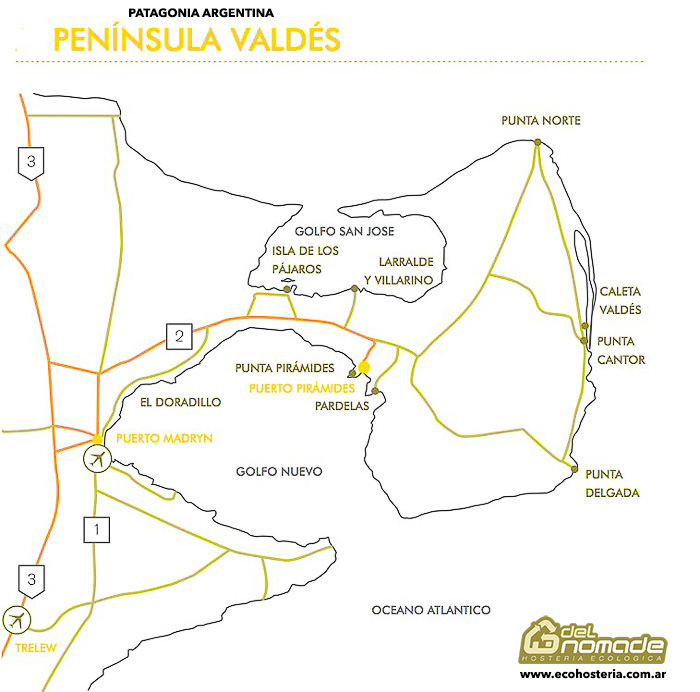
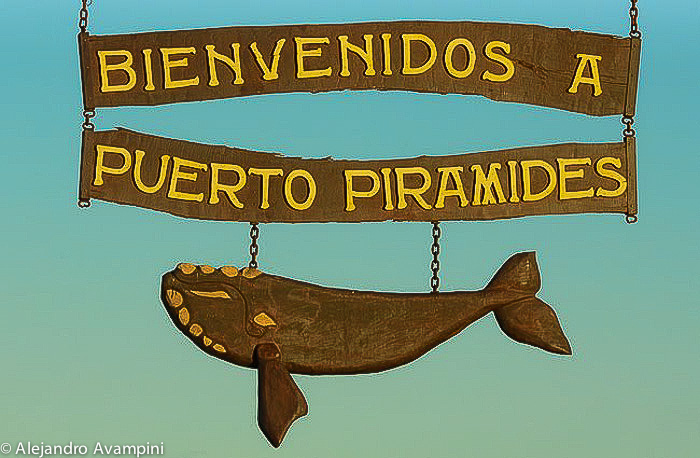 The quaint tourist village of Puerto Piramides, the Argentine capital for marine mammal observation, with a population of approximately 500 individuals, is the only town within the Valdes Peninsula Nature Reserve and UN World Heritage Site. Nestled into a hidden and protected corner of the Patagonian coast, Puerto Piramides is the ideal base for organizing close encounters with the abundant fauna of the region.
The quaint tourist village of Puerto Piramides, the Argentine capital for marine mammal observation, with a population of approximately 500 individuals, is the only town within the Valdes Peninsula Nature Reserve and UN World Heritage Site. Nestled into a hidden and protected corner of the Patagonian coast, Puerto Piramides is the ideal base for organizing close encounters with the abundant fauna of the region.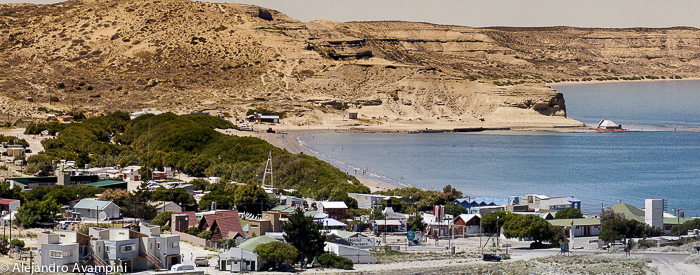 The geographic and climactic characteristics of the Peninsula harbor a vast biodiversity that includes the annual visitation of marine mammals, birds and fish, visits that have taken place over the last several million years.
The geographic and climactic characteristics of the Peninsula harbor a vast biodiversity that includes the annual visitation of marine mammals, birds and fish, visits that have taken place over the last several million years. These varied species have chosen the calm and protected geographic anomaly that is the Valdes Peninsula, in an otherwise crude and windswept Patagonia, to mate, give birth and raise their offspring.
These varied species have chosen the calm and protected geographic anomaly that is the Valdes Peninsula, in an otherwise crude and windswept Patagonia, to mate, give birth and raise their offspring. Here I share a photo I made in Puerto Piramides with the relative motion of the stars. The rock in the picture is the Punta Olazabal, is located at the end of the second descent to the sea.
Here I share a photo I made in Puerto Piramides with the relative motion of the stars. The rock in the picture is the Punta Olazabal, is located at the end of the second descent to the sea. A powerful cliff that closes the Bay of Puerto Piramides, pictured framed by millions of stars that surround it, over time.
A powerful cliff that closes the Bay of Puerto Piramides, pictured framed by millions of stars that surround it, over time.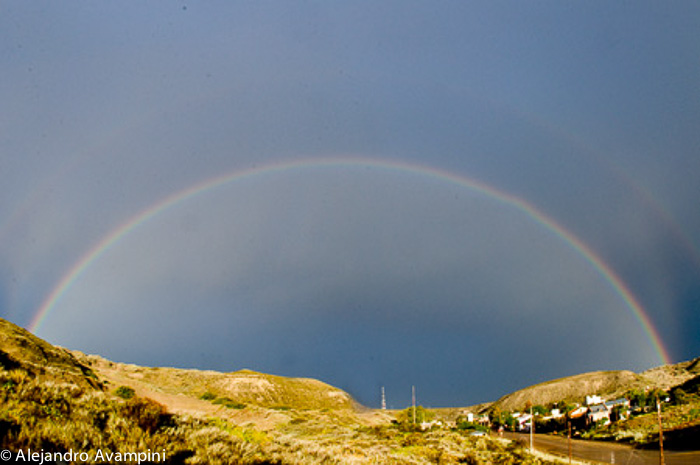 Puerto Piramides has a volunteer fire department, a rural hospital and civil defense personnel, which has 24-hour assistance. They instruct and assist the population and visitors about safety and health routes within Valdes Peninsula.
Puerto Piramides has a volunteer fire department, a rural hospital and civil defense personnel, which has 24-hour assistance. They instruct and assist the population and visitors about safety and health routes within Valdes Peninsula.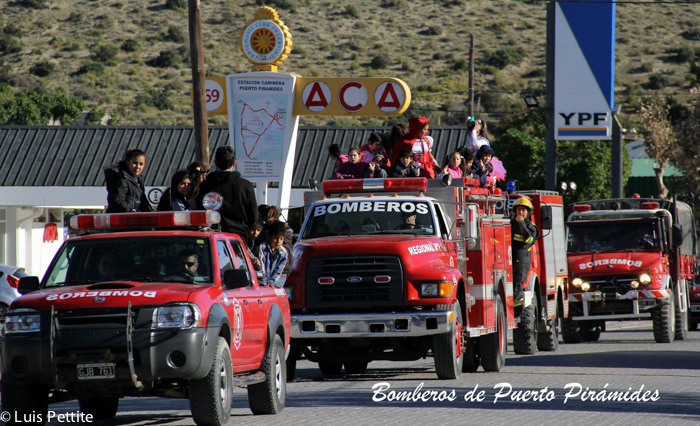 It also has since 2015 with the
It also has since 2015 with the 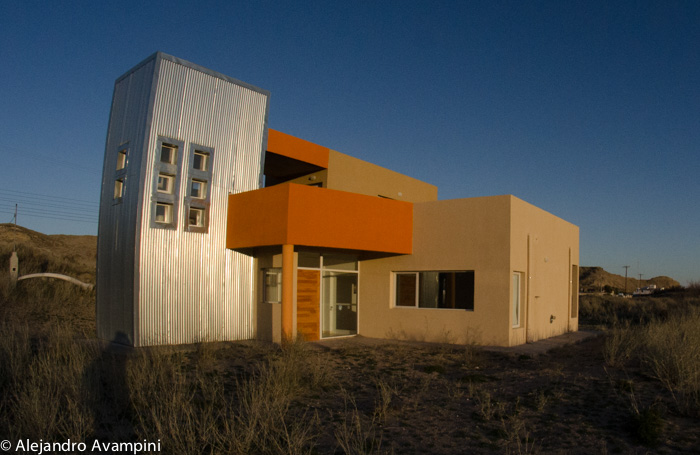
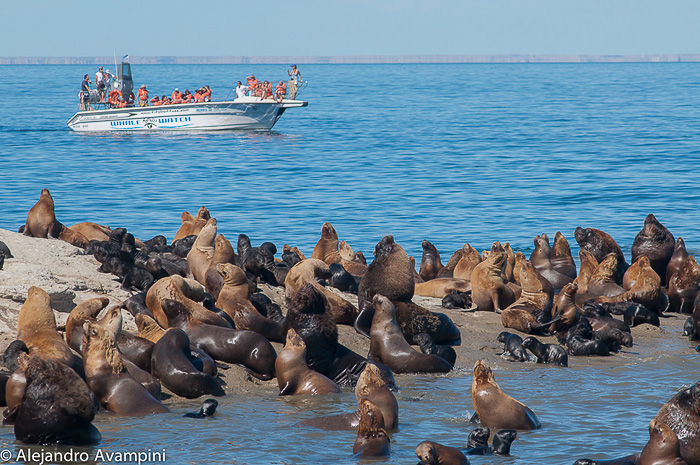 Seduced by an abundance of wildlife, the last several decades have been witness to our arrival, in the form of adventurers, scientists, documentary film makers, wildlife photographers and the devoted pilgrims who come to see wild animals in their pristine natural environment. Travelers from around the world congregate in this small town year after year.
Seduced by an abundance of wildlife, the last several decades have been witness to our arrival, in the form of adventurers, scientists, documentary film makers, wildlife photographers and the devoted pilgrims who come to see wild animals in their pristine natural environment. Travelers from around the world congregate in this small town year after year.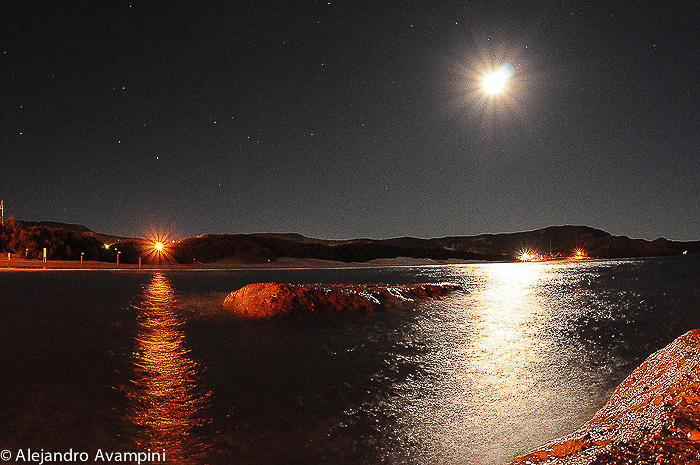 To feel oneself as an active observer, as part of this immense natural theatre, transforms the moment into a pure and permanent experience. Without the need for imagination, an encounter with prehistory becomes real life adventure. A scene unchanged, as it was millions of years ago, makes today a day just like in the Cenozoic Era.
To feel oneself as an active observer, as part of this immense natural theatre, transforms the moment into a pure and permanent experience. Without the need for imagination, an encounter with prehistory becomes real life adventure. A scene unchanged, as it was millions of years ago, makes today a day just like in the Cenozoic Era.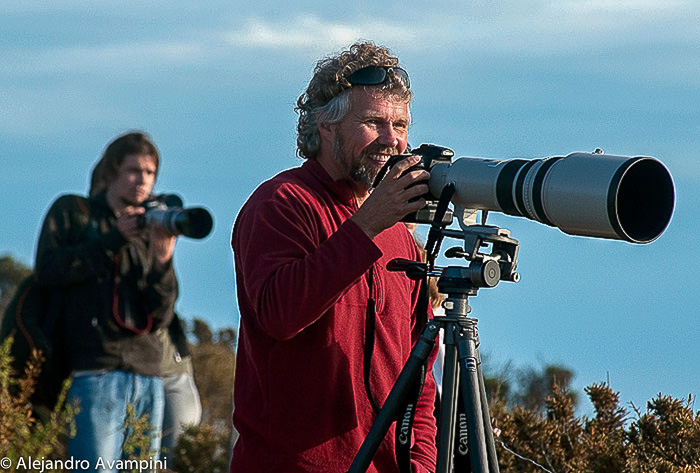 Our local rhythm is an aggregate of experiences far from the parameters of urban existence, where the constant and integral presence of nature is part of life. This characteristic converts Puerto Piramides into a magical destination, with a unique and personal identity…while the conversations continue between Captains, Deck hands, Whale Guides, Biologists, Park Rangers, Divers, Gauchos, Geologists, Professional and Amateur Photographers, Tourists and Public Employees.
Our local rhythm is an aggregate of experiences far from the parameters of urban existence, where the constant and integral presence of nature is part of life. This characteristic converts Puerto Piramides into a magical destination, with a unique and personal identity…while the conversations continue between Captains, Deck hands, Whale Guides, Biologists, Park Rangers, Divers, Gauchos, Geologists, Professional and Amateur Photographers, Tourists and Public Employees. 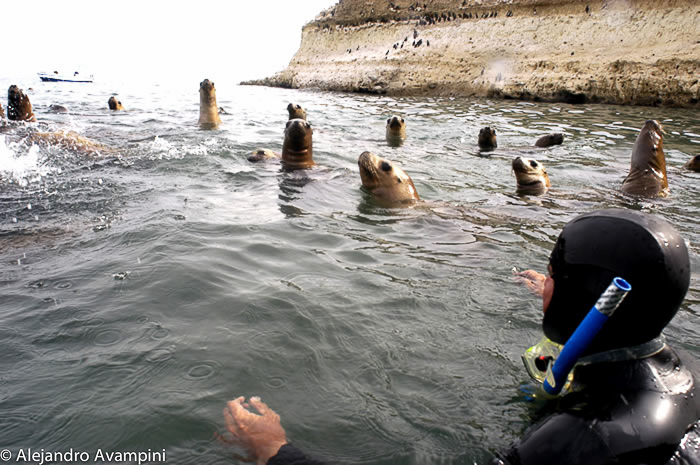 In general, the daily activities that we carry out as members of this small village are directly related to Whale Watching Tours, Diving with Sea Lions, Kayak Excursions, Mountain Biking, Horse-back Riding, Interpretive Coastal Hikes, amongst others. Providing a parallel world where life flows through and is nurtured by nature in constant reverie with the surroundings.
In general, the daily activities that we carry out as members of this small village are directly related to Whale Watching Tours, Diving with Sea Lions, Kayak Excursions, Mountain Biking, Horse-back Riding, Interpretive Coastal Hikes, amongst others. Providing a parallel world where life flows through and is nurtured by nature in constant reverie with the surroundings. 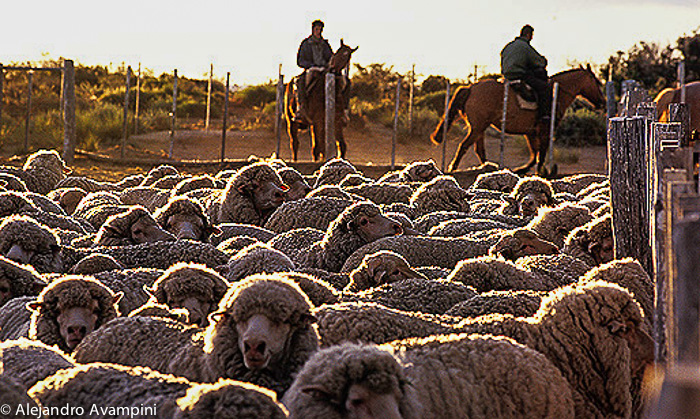 Usually arrived from other locations of Argentina, we created over the last 30 years,this tourist village. Joining in those early settlers, cowboys who lived in a remote and inhospitable landscape of Patagonia Coast for generations, working on sheep shearing and the work that life in the countryside still claim.
Usually arrived from other locations of Argentina, we created over the last 30 years,this tourist village. Joining in those early settlers, cowboys who lived in a remote and inhospitable landscape of Patagonia Coast for generations, working on sheep shearing and the work that life in the countryside still claim.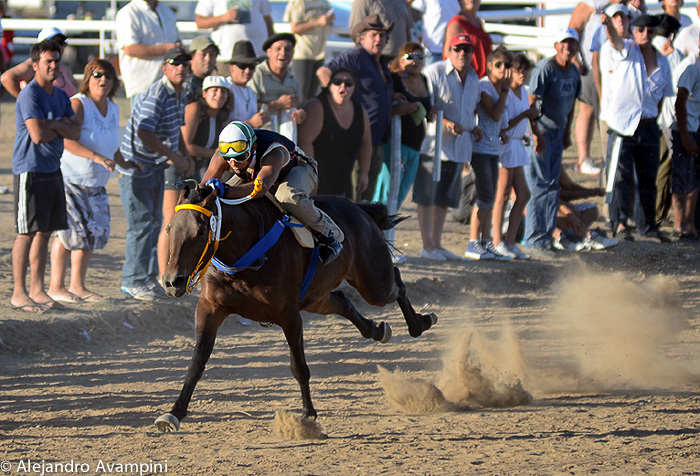 This cultural melting does give Puerto Piramides unparalleled identity. A rich cultural cocktail that blends ancient traditions and current.
This cultural melting does give Puerto Piramides unparalleled identity. A rich cultural cocktail that blends ancient traditions and current.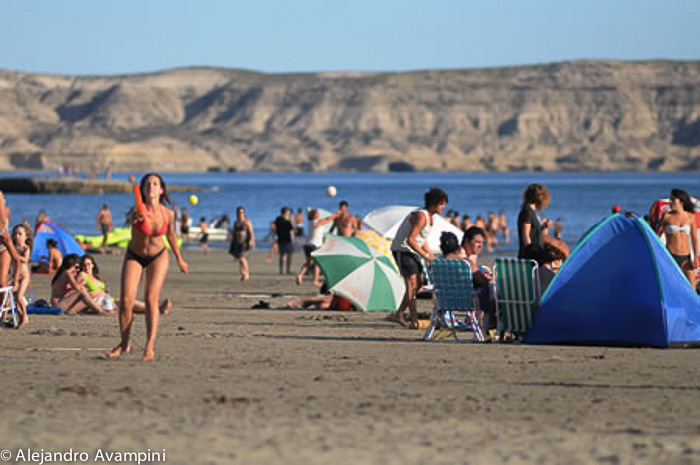 From December to March the beaches attract vacationers who enjoy the sun, sand and sea, endless days and cloudless. It’s incredible to see how the end of December, the last whales leave the Gulf and changes suddenly the tourist interests.
From December to March the beaches attract vacationers who enjoy the sun, sand and sea, endless days and cloudless. It’s incredible to see how the end of December, the last whales leave the Gulf and changes suddenly the tourist interests. During the first three weeks of January the campground and the entire town is swarmed by tourists, most of them on summer vacation from school or university and other local families from the nearby cities of Trelew, Puerto Madryn, Rawson and Comodoro Rivadavia.
During the first three weeks of January the campground and the entire town is swarmed by tourists, most of them on summer vacation from school or university and other local families from the nearby cities of Trelew, Puerto Madryn, Rawson and Comodoro Rivadavia.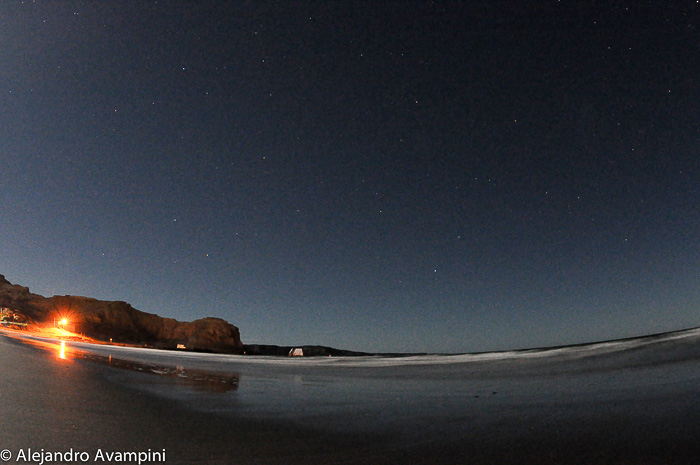 Every evening, the few bars and restaurants, scattered along the only avenue that runs through Puerto Piramides, Whales Avenue ( Avenida de las Ballenas) provide the ideal space for nocturnal encounters. Sharing the day´s adventures is nearly tradition, creating a continuum from one experience to the next.
Every evening, the few bars and restaurants, scattered along the only avenue that runs through Puerto Piramides, Whales Avenue ( Avenida de las Ballenas) provide the ideal space for nocturnal encounters. Sharing the day´s adventures is nearly tradition, creating a continuum from one experience to the next.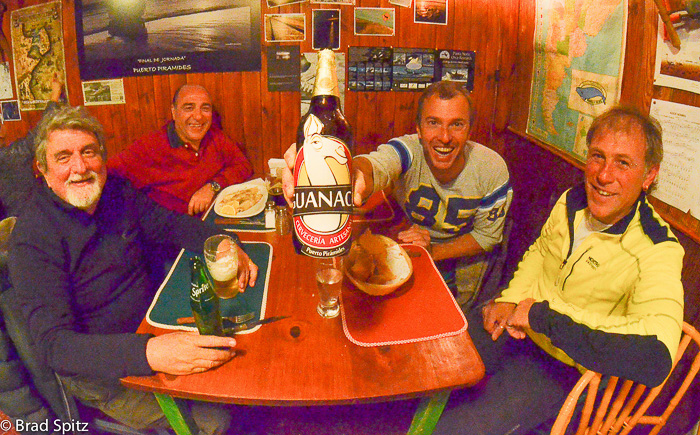 Going over and reliving the details of the day while eating local scallops, fish and a fresh salad, accompanied with a glass of good Argentine wine or local artisan beer more than justifies a late night. While the immense sky invites a detour to the sand dunes or the beach before returning to your room. A short walk and a little observation will transport you into an intergalactic journey.
Going over and reliving the details of the day while eating local scallops, fish and a fresh salad, accompanied with a glass of good Argentine wine or local artisan beer more than justifies a late night. While the immense sky invites a detour to the sand dunes or the beach before returning to your room. A short walk and a little observation will transport you into an intergalactic journey.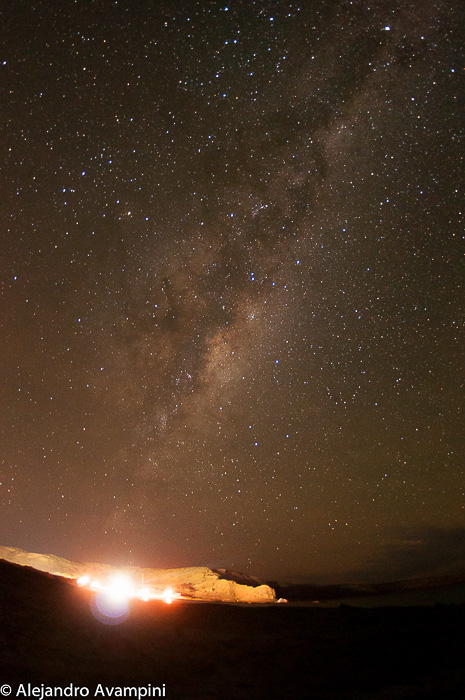
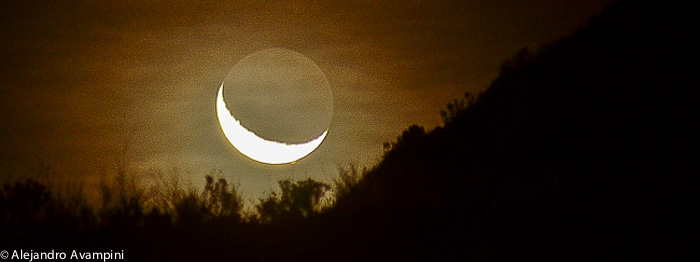 On a personal level I make an effort to experience each sunrise of each new day in Puerto Piramides. Feeling the energy rising up out of the obscurity just before the aurora of dawn is a gift of uncommon dimension, and for me, an indispensable part of a complete day. During Whale Season the sun rises behind an old dirt road that was once the entrance to our ¨pueblo¨. From this point, without rush o pause, the signals of the passing of time leave no room for wait as the sky begins to clear, the veil is pulled back and a new day begins.
On a personal level I make an effort to experience each sunrise of each new day in Puerto Piramides. Feeling the energy rising up out of the obscurity just before the aurora of dawn is a gift of uncommon dimension, and for me, an indispensable part of a complete day. During Whale Season the sun rises behind an old dirt road that was once the entrance to our ¨pueblo¨. From this point, without rush o pause, the signals of the passing of time leave no room for wait as the sky begins to clear, the veil is pulled back and a new day begins.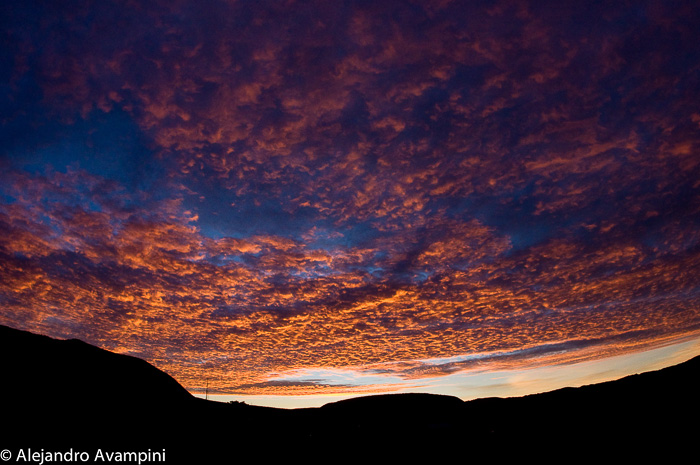
 In this link I shared a
In this link I shared a 
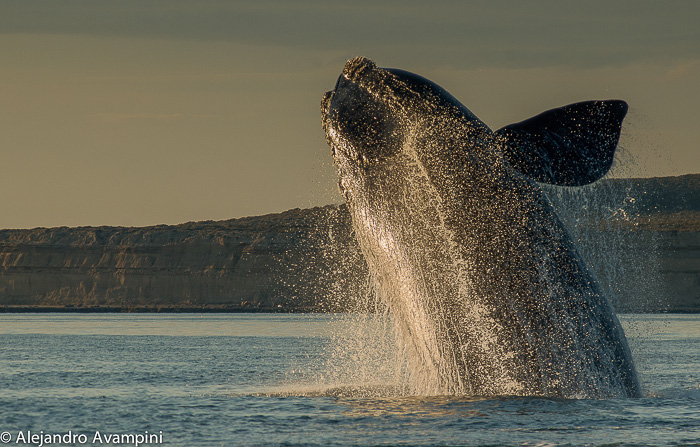 A neighbor´s rooster can be heard in the distance as the gas station attendant to the only gas station in Valdes Peninsula heads his car down the hill to work, passing the night shift employee of the electric company on his trudge back to home, and all amidst the warm aroma of Del Nomade´s homemade breakfast being prepared.
A neighbor´s rooster can be heard in the distance as the gas station attendant to the only gas station in Valdes Peninsula heads his car down the hill to work, passing the night shift employee of the electric company on his trudge back to home, and all amidst the warm aroma of Del Nomade´s homemade breakfast being prepared. Often, during this mystical moment of dawn, I will climb the hill just behind Del Nomade Eco Hotel with a thermos and ¨Mate¨ in hand, to sit and contemplate the surroundings while massaging my bare feet in the sand. From this position the horizon is seen some 60km in the distance. Behind an immense sea, at the same point where the sea meets the sky, a thin fragment of land appears, the other side of the Golfo Nuevo, catching first light and providing closure to this amazing landscape bathed in brilliant gold.
Often, during this mystical moment of dawn, I will climb the hill just behind Del Nomade Eco Hotel with a thermos and ¨Mate¨ in hand, to sit and contemplate the surroundings while massaging my bare feet in the sand. From this position the horizon is seen some 60km in the distance. Behind an immense sea, at the same point where the sea meets the sky, a thin fragment of land appears, the other side of the Golfo Nuevo, catching first light and providing closure to this amazing landscape bathed in brilliant gold. Taking a deep breath, I observe the hypnotic geography that surrounds me and, once again, I give thanks. I make a quick panoramic pan slowly rotating my head from left to right, my eyes following the motion from Olazabal Point to Pardelas Point to Cormornes Point, the mouth of the Golfo Nuevo and its gateway to open ocean, Ninfas Point on the continental side of the gulf, its bays, cliffs and hills disappearing in the distance and following the coast I arrive again to where I am sitting.
Taking a deep breath, I observe the hypnotic geography that surrounds me and, once again, I give thanks. I make a quick panoramic pan slowly rotating my head from left to right, my eyes following the motion from Olazabal Point to Pardelas Point to Cormornes Point, the mouth of the Golfo Nuevo and its gateway to open ocean, Ninfas Point on the continental side of the gulf, its bays, cliffs and hills disappearing in the distance and following the coast I arrive again to where I am sitting. This is a unique panorama that invites contemplation and provides a glimpse of the infinite and beyond. Within this arid natural landscape overflowing in every direction is geography practically unaltered over the last several million years, generating a sensation out of time. The fossils remains, habitants from another era form and decorate every cm of the path I walk.
This is a unique panorama that invites contemplation and provides a glimpse of the infinite and beyond. Within this arid natural landscape overflowing in every direction is geography practically unaltered over the last several million years, generating a sensation out of time. The fossils remains, habitants from another era form and decorate every cm of the path I walk. Yesterday and today are simultaneously exposed without intervals in the varying layers of stratus along the cliffs. Distinct geological eras are expressed in the form of sedimentary deposits, often several meters thick, on display for the eye to see as they fall off the steppe downwards towards their unavoidable encounter with the Atlantic Ocean. There are areas where this natural border forms vertical walls more than 70 meters high.
Yesterday and today are simultaneously exposed without intervals in the varying layers of stratus along the cliffs. Distinct geological eras are expressed in the form of sedimentary deposits, often several meters thick, on display for the eye to see as they fall off the steppe downwards towards their unavoidable encounter with the Atlantic Ocean. There are areas where this natural border forms vertical walls more than 70 meters high.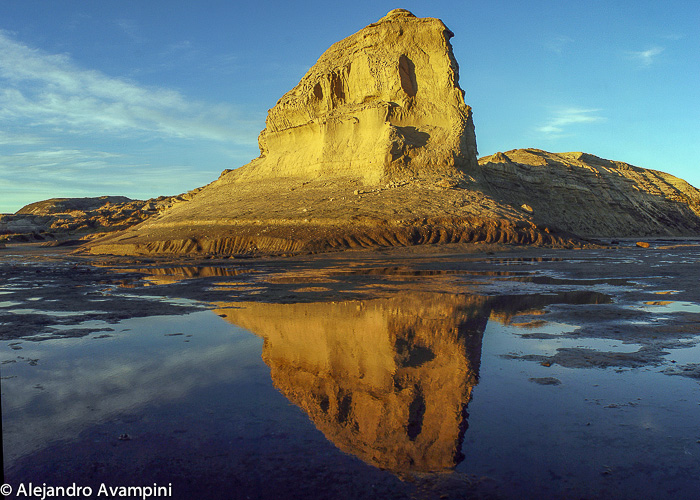
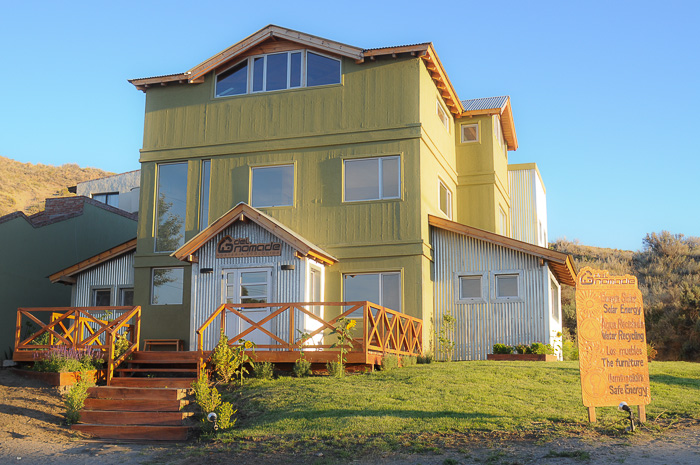 After several years living in Puerto Piramides and feeling myself an integral part of this town, I decided to create a hotel for friends of the earth. My primary motivation for the creation of Del Nomade Eco-Hotel was to receive those that come to the Valdes Peninsula with a certain level of consciousness, respect for the planet and an adventurous spirit. This was the motivation that produced Del Nomade Eco-Hotel. I hope that you enjoy your stay and take advantage of the information provided with respect to activities, adventure, destinations and wildlife.
After several years living in Puerto Piramides and feeling myself an integral part of this town, I decided to create a hotel for friends of the earth. My primary motivation for the creation of Del Nomade Eco-Hotel was to receive those that come to the Valdes Peninsula with a certain level of consciousness, respect for the planet and an adventurous spirit. This was the motivation that produced Del Nomade Eco-Hotel. I hope that you enjoy your stay and take advantage of the information provided with respect to activities, adventure, destinations and wildlife.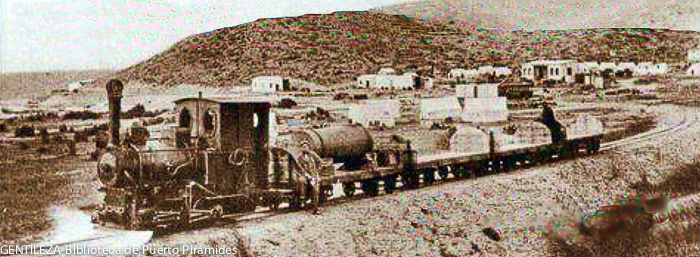 More than 100 years ago the number of people living in Puerto Piramides was much larger than its current population. In a few sentences I will try to make a simple recapitulation of this century of history. During the early 1900s salt mining and extraction brought a large labor force to the peninsula, an activity that lasted several decades. Although hard to imagine today, there was a narrow gauge train used for transporting salt from the salt flats to port. The arrival of the First World War along with the concept of refrigeration changed the way food was conserved and transported and the need for salt was greatly diminished.
More than 100 years ago the number of people living in Puerto Piramides was much larger than its current population. In a few sentences I will try to make a simple recapitulation of this century of history. During the early 1900s salt mining and extraction brought a large labor force to the peninsula, an activity that lasted several decades. Although hard to imagine today, there was a narrow gauge train used for transporting salt from the salt flats to port. The arrival of the First World War along with the concept of refrigeration changed the way food was conserved and transported and the need for salt was greatly diminished.
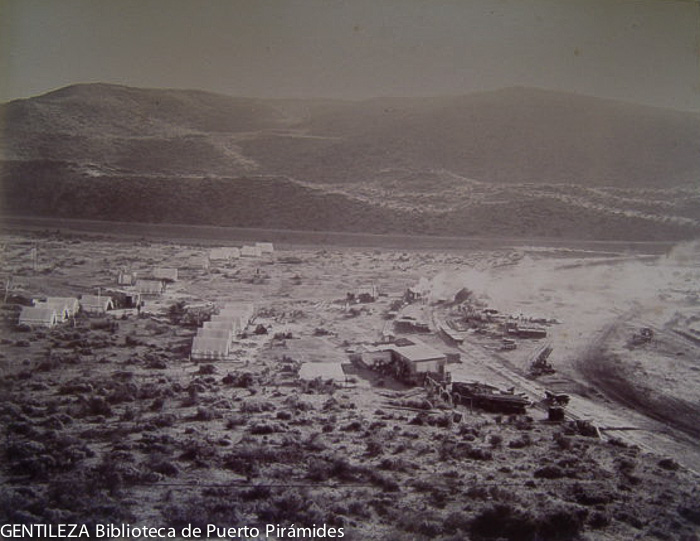
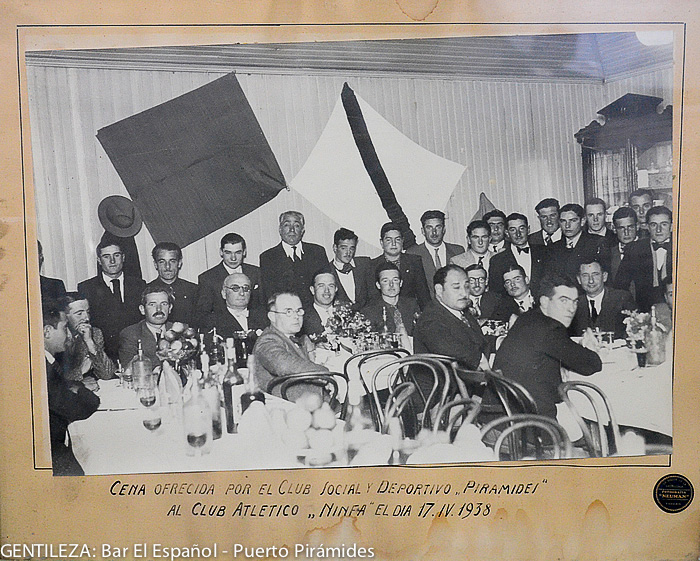
 Puerto Madryn is a Young city with only about 85,000 habitants. For those of us that live in Puerto Piramides, 100km from this beautiful city, its presence is indispensable, providing the logistics of supplies for the services offered in our ¨pueblo¨. Energy and part of our potable water supply comes from this city as well. For the most part, those of us that live in the tranquility of Puerto Piramides, inside of the Valdes Peninsula Protected Nature Reserve, make weekly pilgrimages to the city for provisions, banks and paperwork, before returning to this natural paradise.
Puerto Madryn is a Young city with only about 85,000 habitants. For those of us that live in Puerto Piramides, 100km from this beautiful city, its presence is indispensable, providing the logistics of supplies for the services offered in our ¨pueblo¨. Energy and part of our potable water supply comes from this city as well. For the most part, those of us that live in the tranquility of Puerto Piramides, inside of the Valdes Peninsula Protected Nature Reserve, make weekly pilgrimages to the city for provisions, banks and paperwork, before returning to this natural paradise. On July 28th, 1865 a group of 150 Welsh immigrants stepped down from the sailing vessel ¨Mimosa¨ on the shores of what is now Puerto Madryn. This is the date now understood as the founding of the city, and its name, in homage of Loves Jones Parry, the Baron of Madryn at that time in Whales. The calm protected waters of the Golfo Nuevo came as the invitation for the naming of this port city. Being the principal port of commerce for the region, Puerto Madryn was home to the central train station of Chubut from 1890 to 1961, converting this small port town into a cosmopolitan city with inevitable plans for future growth. The city grew primarily around the activities of the port and train station, as well some commerce and services.
On July 28th, 1865 a group of 150 Welsh immigrants stepped down from the sailing vessel ¨Mimosa¨ on the shores of what is now Puerto Madryn. This is the date now understood as the founding of the city, and its name, in homage of Loves Jones Parry, the Baron of Madryn at that time in Whales. The calm protected waters of the Golfo Nuevo came as the invitation for the naming of this port city. Being the principal port of commerce for the region, Puerto Madryn was home to the central train station of Chubut from 1890 to 1961, converting this small port town into a cosmopolitan city with inevitable plans for future growth. The city grew primarily around the activities of the port and train station, as well some commerce and services. National and international politics have complicated the systematic growth of the area. While some aspects favored the establishment of factories others brought about an end to regional transportation and communication, as was the case with railway service. Today turned into
National and international politics have complicated the systematic growth of the area. While some aspects favored the establishment of factories others brought about an end to regional transportation and communication, as was the case with railway service. Today turned into 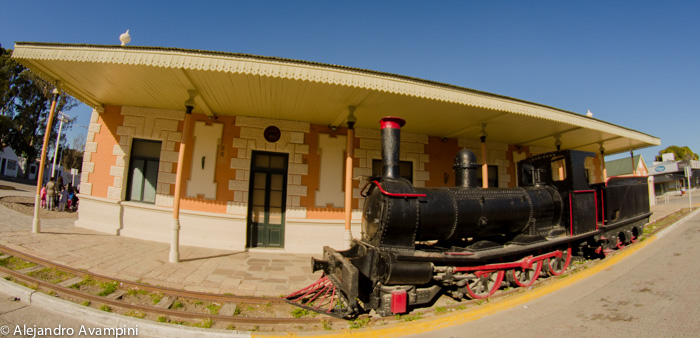 In the 60s several textile industries set up shop in Puerto Madryn due to certain tax exemptions, though several years later they all closed, producing a decrease in the local population, many moving away due to a lack of work.
In the 60s several textile industries set up shop in Puerto Madryn due to certain tax exemptions, though several years later they all closed, producing a decrease in the local population, many moving away due to a lack of work.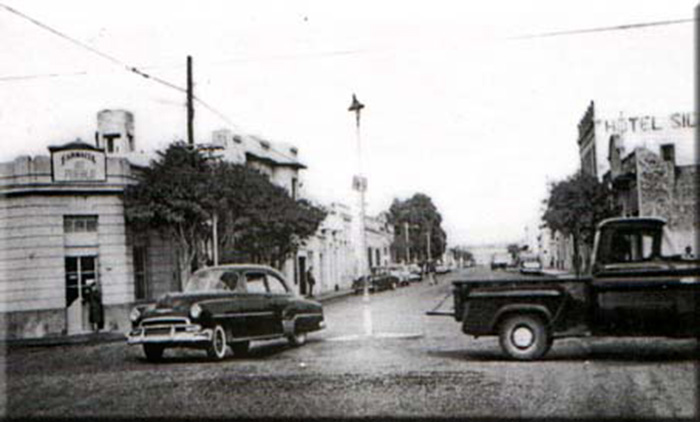 In the 70s the urban structure of Madryn had not changed, but all the railway installations were abandoned. The activities that had given birth to this port city had practically ceased to function, leaving a gap that would not take long to fill. A new industry was just around the corner, and it promised work for the entire city.
In the 70s the urban structure of Madryn had not changed, but all the railway installations were abandoned. The activities that had given birth to this port city had practically ceased to function, leaving a gap that would not take long to fill. A new industry was just around the corner, and it promised work for the entire city.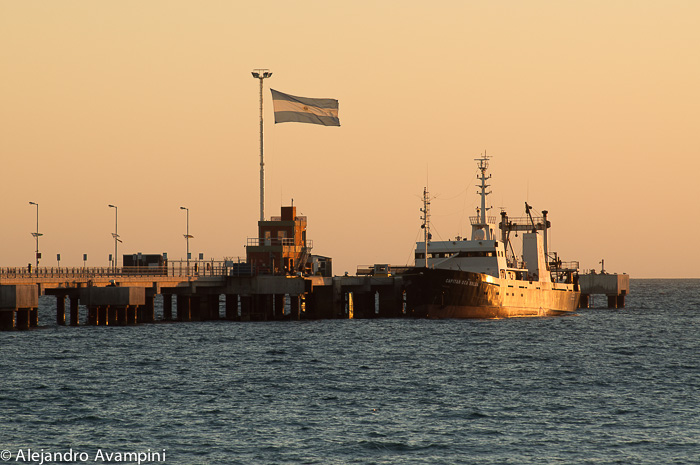 With the arrival of Aluar and its aluminum production plant, together with its new pier and industrial port in the 70s, there was an explosive increase in the population. In a matter of less than 10 years Puerto Madryn´s population was tripled. Other industries joined in the expansion creating even more growth with families arriving from every corner of the country.
With the arrival of Aluar and its aluminum production plant, together with its new pier and industrial port in the 70s, there was an explosive increase in the population. In a matter of less than 10 years Puerto Madryn´s population was tripled. Other industries joined in the expansion creating even more growth with families arriving from every corner of the country.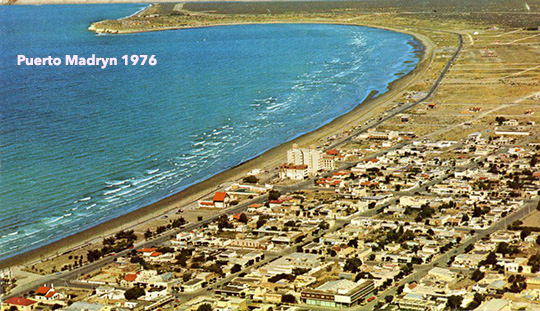
 On the 29th of September, 1967 the Nature Reserve at Punta Loma was established. This was the first nature reserve to be established in Chubut and just 17km from Puerto Madryn, its two observation platforms allow for the unobtrusive observation of Sea Lions.
On the 29th of September, 1967 the Nature Reserve at Punta Loma was established. This was the first nature reserve to be established in Chubut and just 17km from Puerto Madryn, its two observation platforms allow for the unobtrusive observation of Sea Lions.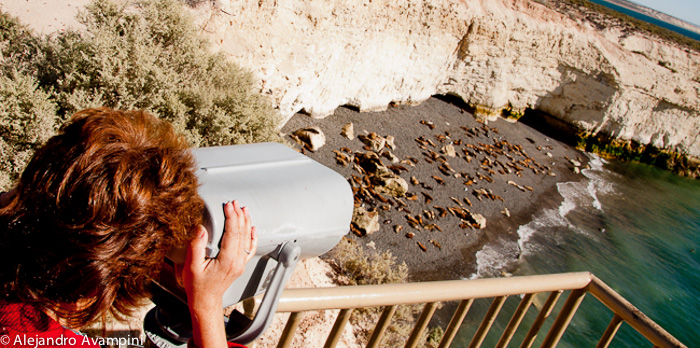 The Punta Loma Nature Reserve also has a very interesting interpretive pathway for the identification of local flora. Although short in stature, the flora of the Patagonian Steppe is extremely varied with many plants that take decades to grow just a couple of meters.
The Punta Loma Nature Reserve also has a very interesting interpretive pathway for the identification of local flora. Although short in stature, the flora of the Patagonian Steppe is extremely varied with many plants that take decades to grow just a couple of meters.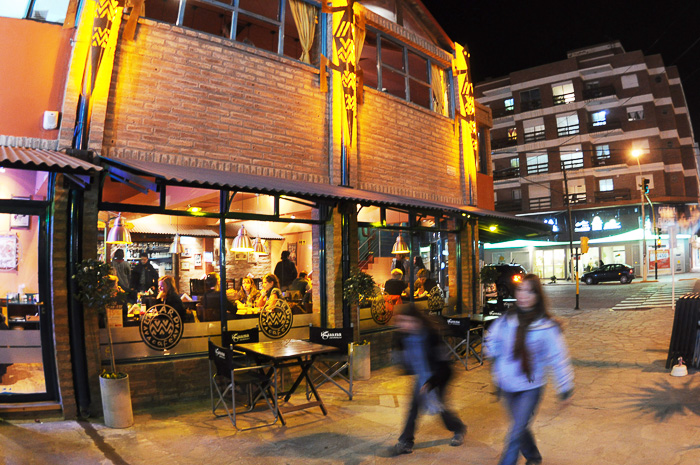 Tourism is a relatively new industry but in the last 30 years Puerto Madryn has continued to invest more and more in installations, locatuins and activities for visitors. Many adventure activities go hand in hand with the desire for contact with nature. Mountain biking, Boat tours, kayak excursions and 4×4 tours have become par for the course.
Tourism is a relatively new industry but in the last 30 years Puerto Madryn has continued to invest more and more in installations, locatuins and activities for visitors. Many adventure activities go hand in hand with the desire for contact with nature. Mountain biking, Boat tours, kayak excursions and 4×4 tours have become par for the course.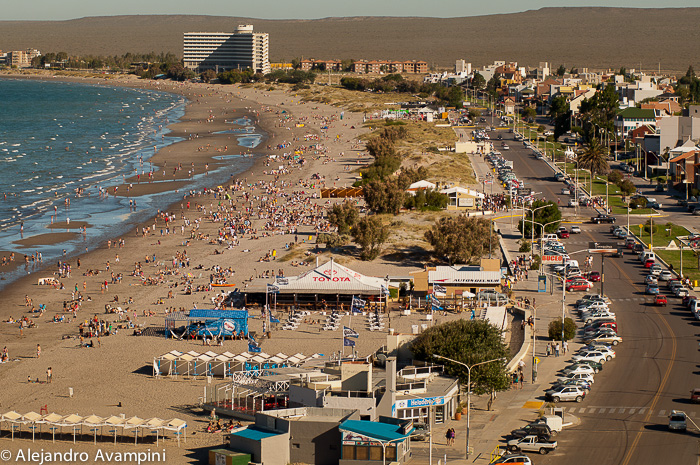 The ocean is the great attraction and Puerto Madryn offers a permanent invitation for contact with the sea and enjoy excellent holidays. During summer months the ¨Ocean School¨ provides, for all ages, Kayak, Stand-Up, Windsurf, Kitesurf and Scuba classes, as well as a children´s summer camp.
The ocean is the great attraction and Puerto Madryn offers a permanent invitation for contact with the sea and enjoy excellent holidays. During summer months the ¨Ocean School¨ provides, for all ages, Kayak, Stand-Up, Windsurf, Kitesurf and Scuba classes, as well as a children´s summer camp.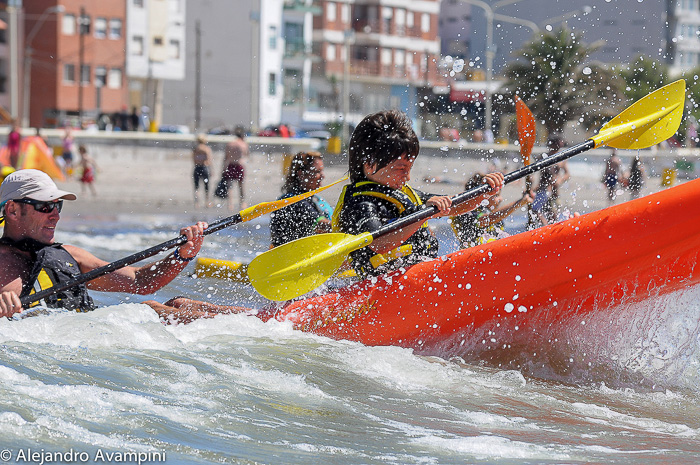 A couple of times each year the local yacht club (CNAS) organize regattas with the participation of local, national and international sailors.Contact with the sea during any of the mentioned nautical activities is an excellent option, but not the only way to enjoy the ocean. A tour of the Doradillo Beach during Whale season is a must and offers one of the most amazing and unusual natural events that exist.
A couple of times each year the local yacht club (CNAS) organize regattas with the participation of local, national and international sailors.Contact with the sea during any of the mentioned nautical activities is an excellent option, but not the only way to enjoy the ocean. A tour of the Doradillo Beach during Whale season is a must and offers one of the most amazing and unusual natural events that exist. 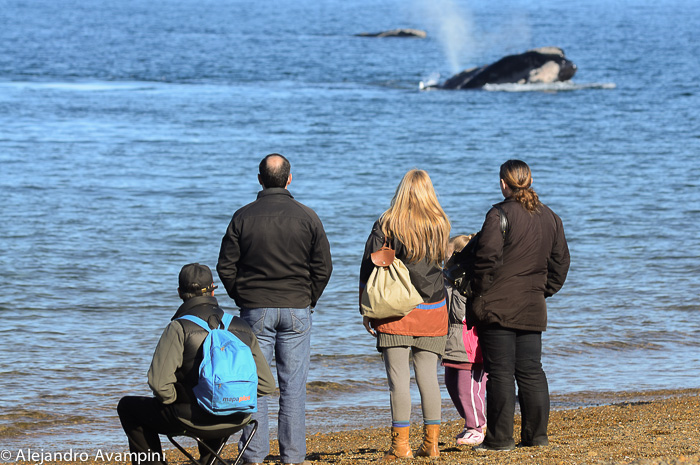 In complete harmony with their surroundings, dozens of whales, with their new born calves, can be observed right next to the coast as they teach and nurse the young. Puerto Madryn also offers an excellent museum circuit for a better understanding of the natural world that surrounds the area, with graphics, presentations and installations. One such museum is the Ecocentro, a place well worth visiting, where hands on activities provide a better knowledge and perception of the natural world generated by the sea and its tides.
In complete harmony with their surroundings, dozens of whales, with their new born calves, can be observed right next to the coast as they teach and nurse the young. Puerto Madryn also offers an excellent museum circuit for a better understanding of the natural world that surrounds the area, with graphics, presentations and installations. One such museum is the Ecocentro, a place well worth visiting, where hands on activities provide a better knowledge and perception of the natural world generated by the sea and its tides.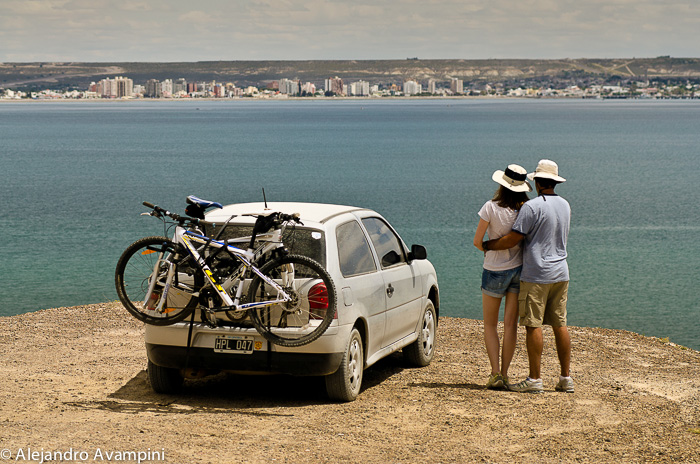 Having opened its doors at the beginning of this new millennium, the Ecocentro houses several different displays, expositions and replicas of local fauna, interactive monitors and models for better understanding the tides and the infinite world that depends on these tidal shifts, and much more.
Having opened its doors at the beginning of this new millennium, the Ecocentro houses several different displays, expositions and replicas of local fauna, interactive monitors and models for better understanding the tides and the infinite world that depends on these tidal shifts, and much more.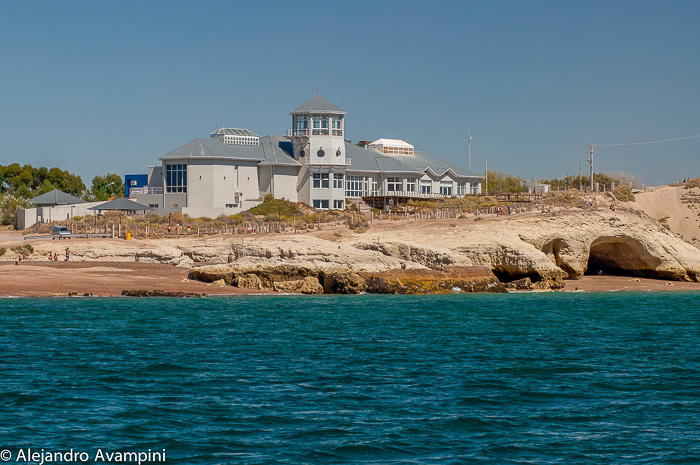 Their excellent conference rooms provide a continuous circuit of presentations, exhibitions and conferences keeping the theme of our oceans protection close to the surface.
Their excellent conference rooms provide a continuous circuit of presentations, exhibitions and conferences keeping the theme of our oceans protection close to the surface. Another option is the Museum of Man and the Sea, often referred to as the Pujol Museum. Aside from several well presented skeletons and other displays the center attraction is a Giant Squid preserved for close observation.
Another option is the Museum of Man and the Sea, often referred to as the Pujol Museum. Aside from several well presented skeletons and other displays the center attraction is a Giant Squid preserved for close observation.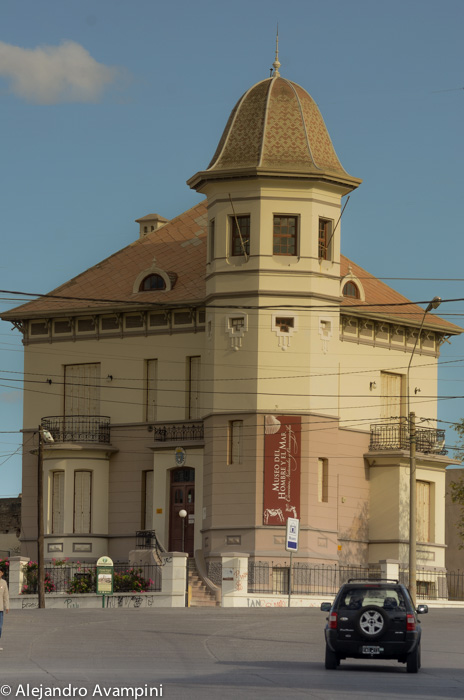
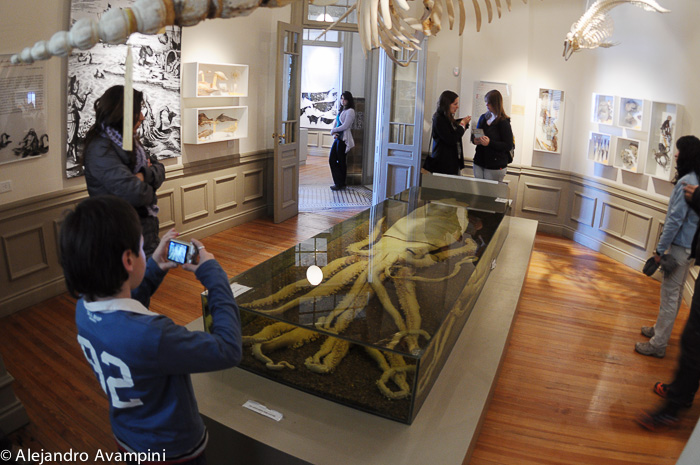 For a feel of the Patagonian Steppe, keep in mind that with each excursion you make, the local guides from the area will offer pristine moments, with a true sense of immense space, far from the bustle of humanity. Adventure tours of the Valdes Peninsula not only originate in Puerto Piramides, a tiny town with a population of just 400 and located within the Nature Reserve. Puerto Madryn also offers a large array of adventure tourism.
For a feel of the Patagonian Steppe, keep in mind that with each excursion you make, the local guides from the area will offer pristine moments, with a true sense of immense space, far from the bustle of humanity. Adventure tours of the Valdes Peninsula not only originate in Puerto Piramides, a tiny town with a population of just 400 and located within the Nature Reserve. Puerto Madryn also offers a large array of adventure tourism.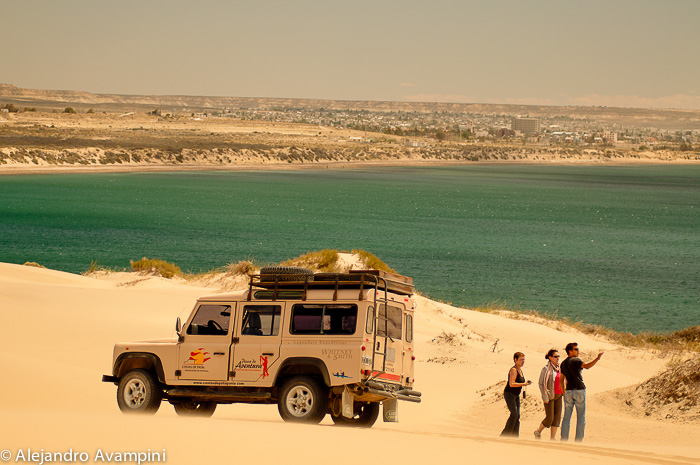 An interesting option in Puerto Madryn is offered by ¨Costas de la Patagonia¨ with daily excursions. A 4×4 tour through the arid trails between cliffs and sheep ranches takes a visitor from the points of interest of the city south along the coast, past the monument to the Tehuelche Indians, the Ecocenter and the horse tracks. From this point the city disappears in the rearview mirror and the Patagonian Steppe takes over with its immense scenes of solitude and infinite landscapes. The local geography rich in fossil remains and legends frames this uncommon excursion in a mystic halo.
An interesting option in Puerto Madryn is offered by ¨Costas de la Patagonia¨ with daily excursions. A 4×4 tour through the arid trails between cliffs and sheep ranches takes a visitor from the points of interest of the city south along the coast, past the monument to the Tehuelche Indians, the Ecocenter and the horse tracks. From this point the city disappears in the rearview mirror and the Patagonian Steppe takes over with its immense scenes of solitude and infinite landscapes. The local geography rich in fossil remains and legends frames this uncommon excursion in a mystic halo. In the last decade Puerto Madryn has become a destination for cruise ships touring the southern waters of Chile and Argentina increasing tourism for days of each month. The cruise ship season begins in September and lasts until the end of summer.
In the last decade Puerto Madryn has become a destination for cruise ships touring the southern waters of Chile and Argentina increasing tourism for days of each month. The cruise ship season begins in September and lasts until the end of summer.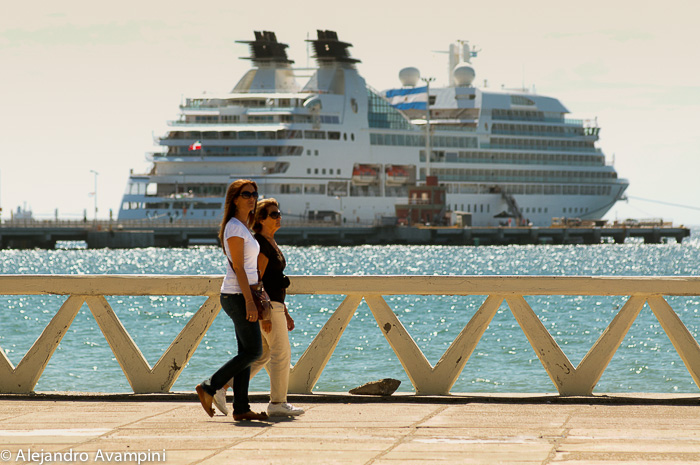 For the most part the local climate is arid with little rain, winds are common, but sunshine is almost always on the menu. Without a doubt this is one of the best places in the world to visit from the months of September through April. During time frame is when the immensity of nature shows its true colors with an abundance of species, amazing numbers of individuals, unique behavior, adventure and the warmth of the local population. The winter months are usually not so comforting.
For the most part the local climate is arid with little rain, winds are common, but sunshine is almost always on the menu. Without a doubt this is one of the best places in the world to visit from the months of September through April. During time frame is when the immensity of nature shows its true colors with an abundance of species, amazing numbers of individuals, unique behavior, adventure and the warmth of the local population. The winter months are usually not so comforting.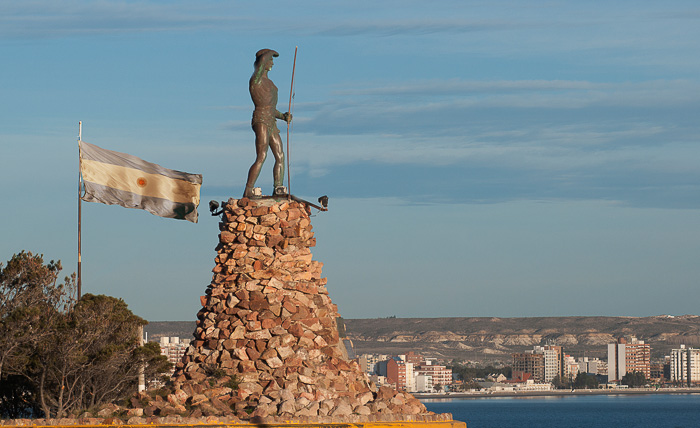 For this reason ¨Del Nomade¨ Eco Hotel, in Puerto Piramides, opens its doors during the best time of the year, mid August, inviting visitors when the animals and the conditions are at their most pristine in the World Heritage site that is the Valdes Peninsula. We recommend that you visit the Valdes Peninsula from the peak season of the Southern Right Whales through the end of Orca season in April. During the months of May through August adverse climactic conditions are in general less attractive. Shorter days, cold, rain and strong winds are par for the course making it the best time to avoid the Peninsula. The remaining 8 months of the year make this an excellent destination.
For this reason ¨Del Nomade¨ Eco Hotel, in Puerto Piramides, opens its doors during the best time of the year, mid August, inviting visitors when the animals and the conditions are at their most pristine in the World Heritage site that is the Valdes Peninsula. We recommend that you visit the Valdes Peninsula from the peak season of the Southern Right Whales through the end of Orca season in April. During the months of May through August adverse climactic conditions are in general less attractive. Shorter days, cold, rain and strong winds are par for the course making it the best time to avoid the Peninsula. The remaining 8 months of the year make this an excellent destination. Here I have provided 3 videos. The first is a series of images of Puerto Madryn accompanied by information for the visitor. The second is a more artistic video, bringing to the forefront the natural beauty and attractive points of interest in and around the port city of Puerto Madryn.
Here I have provided 3 videos. The first is a series of images of Puerto Madryn accompanied by information for the visitor. The second is a more artistic video, bringing to the forefront the natural beauty and attractive points of interest in and around the port city of Puerto Madryn.
 Once your custom-printed order is placed, it immediately goes into a production queue. While the majority of orders will print and ship within 48 hours, an order may occasionally take up to 3 business days to produce.
Once your custom-printed order is placed, it immediately goes into a production queue. While the majority of orders will print and ship within 48 hours, an order may occasionally take up to 3 business days to produce.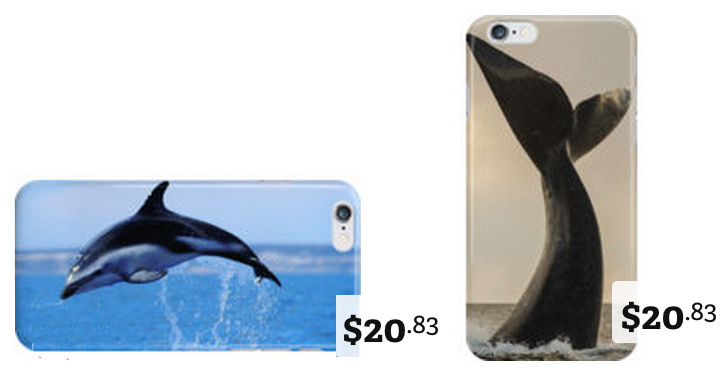 You can send a gift to someone else
You can send a gift to someone else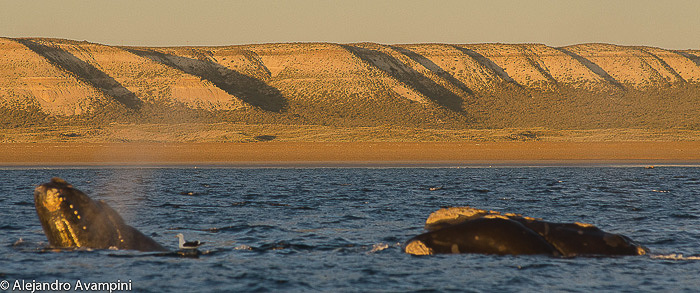
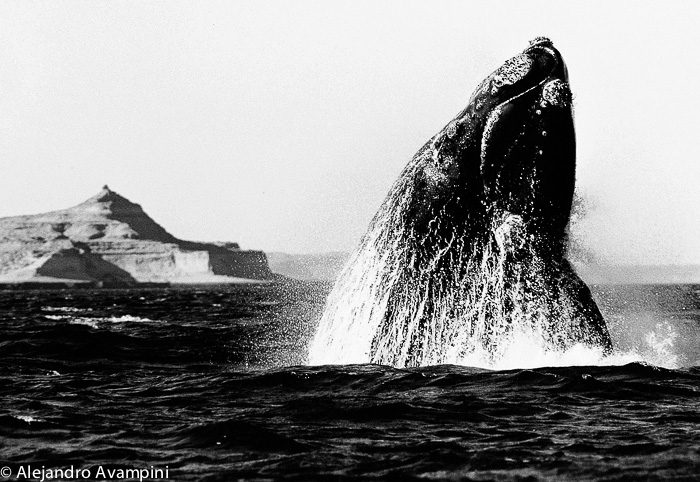
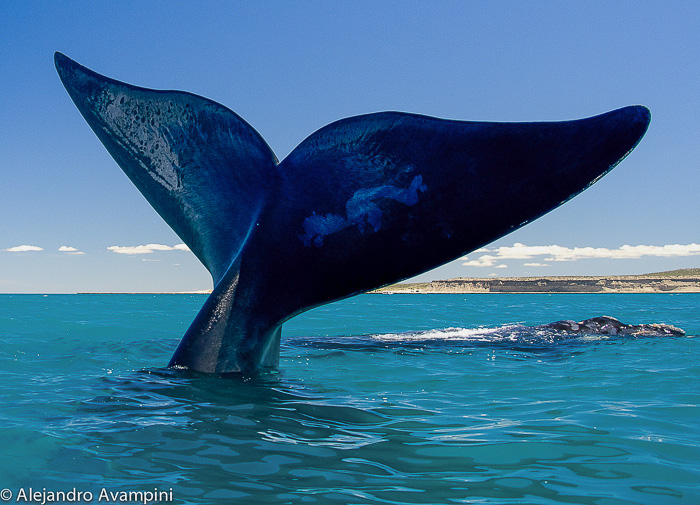 Aside from the immense space in which the whales are distributed throughout both the San Jose and Nuevo Gulfs, to speak of the whales of the Valdes Peninsula is to speak of Puerto Piramides. An oasis in the desert, Puerto Piramides is the place where man meets the sea. A hidden corner of Patagonia that serves as the ideal base for organizing encounters with the wildlife of the region. As well when speaking of whales of the Valdes Peninsula, El Doradillo beach must be mentioned. This peculiar beach, close to Puerto Madryn, is known for the grouping of many mothers and calves close to its shores.
Aside from the immense space in which the whales are distributed throughout both the San Jose and Nuevo Gulfs, to speak of the whales of the Valdes Peninsula is to speak of Puerto Piramides. An oasis in the desert, Puerto Piramides is the place where man meets the sea. A hidden corner of Patagonia that serves as the ideal base for organizing encounters with the wildlife of the region. As well when speaking of whales of the Valdes Peninsula, El Doradillo beach must be mentioned. This peculiar beach, close to Puerto Madryn, is known for the grouping of many mothers and calves close to its shores. El Doradillo and the other surrounding beaches just north of Puerto Madryn seem to function as the most popular nursery. Dozens of mothers will group along this coast with their calves during the calves first few months after birth. There are other species that, as well, choose specific parts of the Valdes Peninsula to carry out some specific phase of their yearly cycle. The whales that arrive are from the Southern Right Whale population (Eubalaena Australis). Their cycle begins with their arrival at the end of April and beginning of May. Usually the first sightings will be along the coast just south of Puerto Madryn, and day by day the sightings will increase until the whales begin to form groups. They have a certain pattern in their circulation of the gulf during their 8 months of presence in the area, with the largest concentration grouping along the northern edge of the gulf, near Puerto Piramides.
El Doradillo and the other surrounding beaches just north of Puerto Madryn seem to function as the most popular nursery. Dozens of mothers will group along this coast with their calves during the calves first few months after birth. There are other species that, as well, choose specific parts of the Valdes Peninsula to carry out some specific phase of their yearly cycle. The whales that arrive are from the Southern Right Whale population (Eubalaena Australis). Their cycle begins with their arrival at the end of April and beginning of May. Usually the first sightings will be along the coast just south of Puerto Madryn, and day by day the sightings will increase until the whales begin to form groups. They have a certain pattern in their circulation of the gulf during their 8 months of presence in the area, with the largest concentration grouping along the northern edge of the gulf, near Puerto Piramides.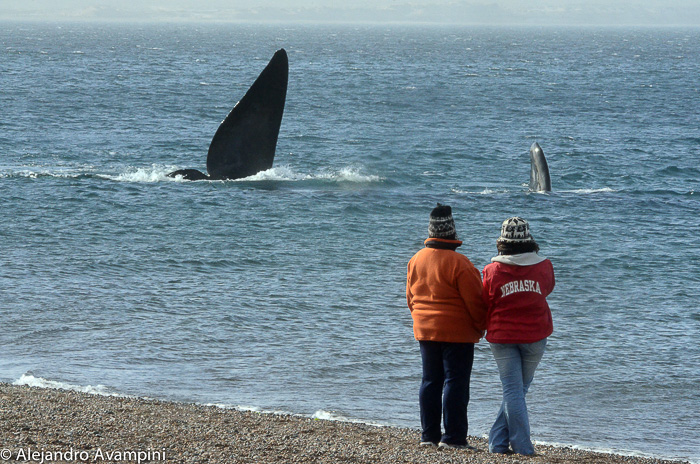 At the beginning of the whale watching season, between June and mid October, El Doradillo beach becomes one of the best places in the world to see whales up close from the coast (Months to enjoy excellent holidays) The whales come so close to the coast in this area that one can truly appreciate their size, often viewing animals less than 10mts from the beach. The primary characteristics of this area that attract the mothers with their newborn calves are a steeply inclined coast with cobblestone and pebble that quickly reaches a depth of 8mts., with excellent protection from the predominantly west and south west winds. These conditions allow the mother enough room for comfortably nursing her calf in calm waters, yet just shallow enough to impede the presence of males wishing to mate the female. For the most part, the whales of this species need between 15-20mts for mating behavior.
At the beginning of the whale watching season, between June and mid October, El Doradillo beach becomes one of the best places in the world to see whales up close from the coast (Months to enjoy excellent holidays) The whales come so close to the coast in this area that one can truly appreciate their size, often viewing animals less than 10mts from the beach. The primary characteristics of this area that attract the mothers with their newborn calves are a steeply inclined coast with cobblestone and pebble that quickly reaches a depth of 8mts., with excellent protection from the predominantly west and south west winds. These conditions allow the mother enough room for comfortably nursing her calf in calm waters, yet just shallow enough to impede the presence of males wishing to mate the female. For the most part, the whales of this species need between 15-20mts for mating behavior. In 2012 a friend and colleague,
In 2012 a friend and colleague,  As adults these whales need no more than 4mts of water to float comfortably. Calves will nurse by holding their breath and moving just below the mother where her mammary glands are located, on either side of her vagina. Stimulated by the calf´s presence, the mother will slightly raise her fluke and peduncle better exposing her mammary glands. The mother will push her fat rich milk straight out into the ocean water. The calf will be waiting will its mouth open right next to the mammary glands and will capture the milk together with salt water. The calf will consume huge quantities of milk and will grow at a staggering rate during the first few weeks.
As adults these whales need no more than 4mts of water to float comfortably. Calves will nurse by holding their breath and moving just below the mother where her mammary glands are located, on either side of her vagina. Stimulated by the calf´s presence, the mother will slightly raise her fluke and peduncle better exposing her mammary glands. The mother will push her fat rich milk straight out into the ocean water. The calf will be waiting will its mouth open right next to the mammary glands and will capture the milk together with salt water. The calf will consume huge quantities of milk and will grow at a staggering rate during the first few weeks. Being mammals, although marine mammals and with a shape and size greatly different from our own, we have a lot in common and spending time close to these amazing creatures on their terms in complete freedom, is an unforgettable experience.
Being mammals, although marine mammals and with a shape and size greatly different from our own, we have a lot in common and spending time close to these amazing creatures on their terms in complete freedom, is an unforgettable experience.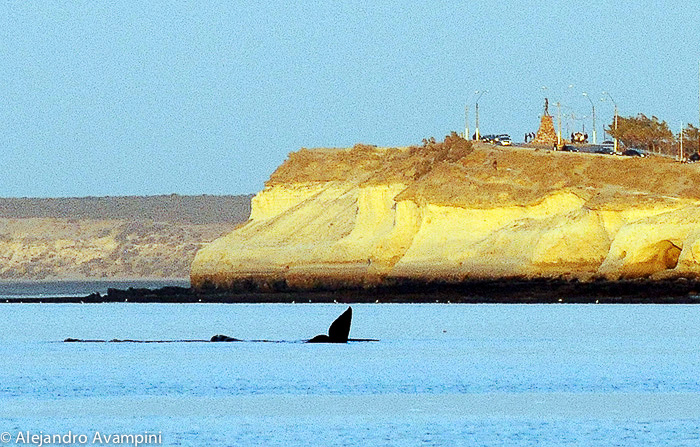 El Doradillo beach is a quiet and calm area just removed from the city. It is a public access beach that can be reached in any vehicle or excursion or even by bicycle from Puerto Madryn. Round trip from the city is 34km. If your destination is Puerto Piramides, making a visit to this beach before arriving to Puerto Piramides is a must.
El Doradillo beach is a quiet and calm area just removed from the city. It is a public access beach that can be reached in any vehicle or excursion or even by bicycle from Puerto Madryn. Round trip from the city is 34km. If your destination is Puerto Piramides, making a visit to this beach before arriving to Puerto Piramides is a must.
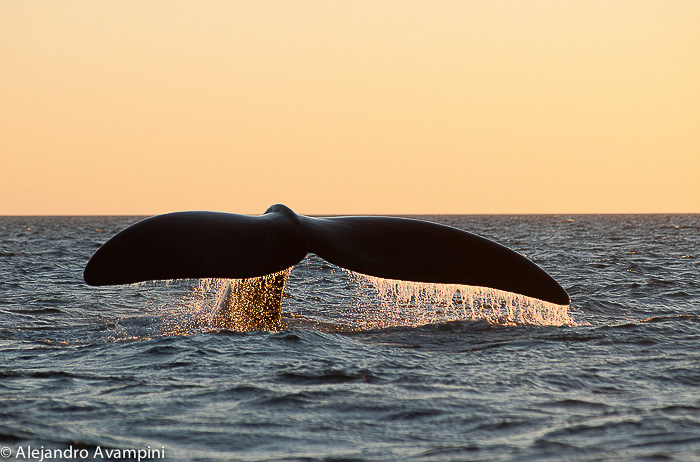 The weeks go by and the season continues into October and November with lots of whales and diferent behavior. The mothers that have given birth with be observed together with their calves, though now much skinnier than upon their arrival before giving birth. The females that arrived for mating will be observed in groups surrounded by males in one of the most uncommon and beautiful courting behaviors found in nature.
The weeks go by and the season continues into October and November with lots of whales and diferent behavior. The mothers that have given birth with be observed together with their calves, though now much skinnier than upon their arrival before giving birth. The females that arrived for mating will be observed in groups surrounded by males in one of the most uncommon and beautiful courting behaviors found in nature.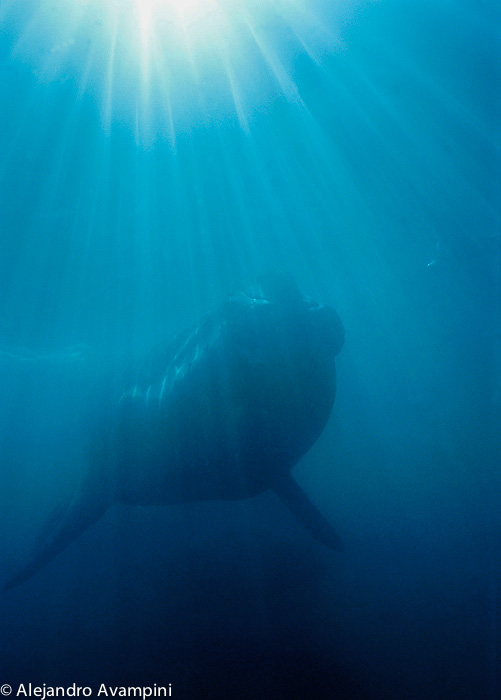
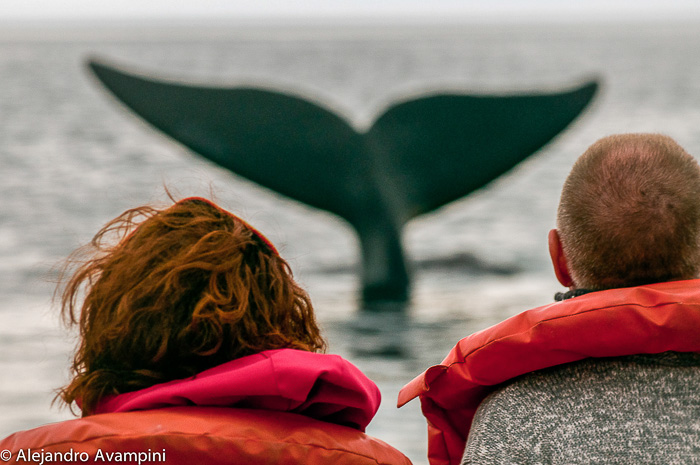 According to most theories, the promiscuous behavior of this species is due to the female literally collected sperm samples from the different males to be later fertilized by the strongest and most adequate individual. During their first year of life the calves will remain close to their mothers nursing and weaning. The next stage of the calf´s life, before reaching reproductive maturity, as sub adults, will be taken on without the mother´s presence.
According to most theories, the promiscuous behavior of this species is due to the female literally collected sperm samples from the different males to be later fertilized by the strongest and most adequate individual. During their first year of life the calves will remain close to their mothers nursing and weaning. The next stage of the calf´s life, before reaching reproductive maturity, as sub adults, will be taken on without the mother´s presence.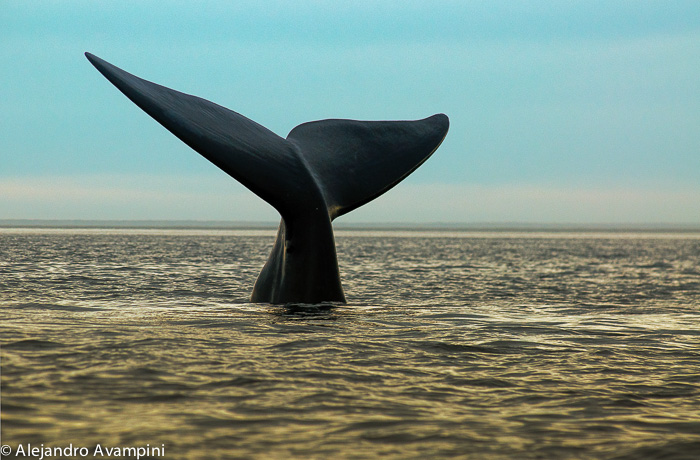 The beginning of December brings with it a noticeable departure of the whales. In the last few years there have been whale watching tours up through the first few days of January in the Golfo Nuevo, though at this time, sightings are not guaranteed and the excursions will often last several hours, travelling as far as the mouth of the gulf near open ocean. The photos published here in the different articles were captured aboard whale watching tour boats which operate every day, weather permitting, from Puerto Piramides, Valdes Peninsula.
The beginning of December brings with it a noticeable departure of the whales. In the last few years there have been whale watching tours up through the first few days of January in the Golfo Nuevo, though at this time, sightings are not guaranteed and the excursions will often last several hours, travelling as far as the mouth of the gulf near open ocean. The photos published here in the different articles were captured aboard whale watching tour boats which operate every day, weather permitting, from Puerto Piramides, Valdes Peninsula. The Southern Right Whale is a warm blooded living being that has suffered man’s industrialization of the world’s natural resources. Over hundreds of years Man hunted and killed whales, sea lions and seals amongst many other species with the goal of using their fat, reduced to oil, for making candles and thus lighting the streets and homes of Europe and the colonized continents. Various parts of the whale’s remains were also used in the making of frivolous cosmetic products. Their baleen filters, used by the right whales and all other mysticeti for feeding, were processed to make umbrellas, corsets and other massively consumed products.
The Southern Right Whale is a warm blooded living being that has suffered man’s industrialization of the world’s natural resources. Over hundreds of years Man hunted and killed whales, sea lions and seals amongst many other species with the goal of using their fat, reduced to oil, for making candles and thus lighting the streets and homes of Europe and the colonized continents. Various parts of the whale’s remains were also used in the making of frivolous cosmetic products. Their baleen filters, used by the right whales and all other mysticeti for feeding, were processed to make umbrellas, corsets and other massively consumed products.  It is estimated that the numbers of Southern Right Whale before the indiscriminant commercial hunting of these animals reached well over 50,000 individuals. With the discovery of petroleum, gas and electricity, these enormous marine mammals have, little by little, lost their importance in the industrial world. Many species were unable to survive the voracious consumer market. One such is the North Atlantic Right Whale, a species that occupied the Bay of Biscay in northern Spain and was similar to the Southern Right Whale.
It is estimated that the numbers of Southern Right Whale before the indiscriminant commercial hunting of these animals reached well over 50,000 individuals. With the discovery of petroleum, gas and electricity, these enormous marine mammals have, little by little, lost their importance in the industrial world. Many species were unable to survive the voracious consumer market. One such is the North Atlantic Right Whale, a species that occupied the Bay of Biscay in northern Spain and was similar to the Southern Right Whale. 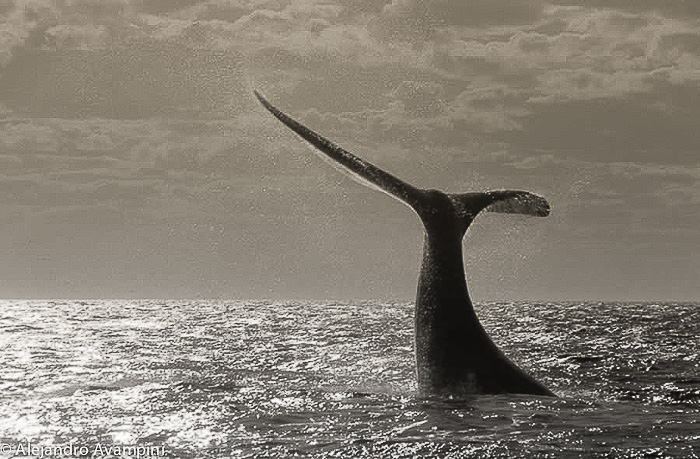 In 1937, when only several hundred individuals remained, the Southern Right Whale was provided total protection with the signing of the International Agreement for the Regulation of Whaling. From this point forward the recovery of the Southern Right Whale has been slow but sustainable. In 1984 this species was declared by the Argentine Republic as a National Natural Monument. Thanks to a change in vision and consciousness that the age of Aquarius as awakened, today the Southern Right Whale is observed by thousands of tourists in Valdes Peninsula aboard whale watching boats or from the coast, perceiving through new eyes the wonder of diversity that our small and fragile planet offers. It is a much more positive memory enjoying a photograph taken of the whales instead of a keratin umbrella made from baleen filters, just in case it rains! An amazing underwater video of the whales was uploaded to You Tube by the well known documentary cameraman, Luis Burgueno. The clip is published here and thanks to a variety of angles and the clarity of the water, these giant and adorable marine mammals can be viewed at home in the waters of the Valdes Peninsula.
In 1937, when only several hundred individuals remained, the Southern Right Whale was provided total protection with the signing of the International Agreement for the Regulation of Whaling. From this point forward the recovery of the Southern Right Whale has been slow but sustainable. In 1984 this species was declared by the Argentine Republic as a National Natural Monument. Thanks to a change in vision and consciousness that the age of Aquarius as awakened, today the Southern Right Whale is observed by thousands of tourists in Valdes Peninsula aboard whale watching boats or from the coast, perceiving through new eyes the wonder of diversity that our small and fragile planet offers. It is a much more positive memory enjoying a photograph taken of the whales instead of a keratin umbrella made from baleen filters, just in case it rains! An amazing underwater video of the whales was uploaded to You Tube by the well known documentary cameraman, Luis Burgueno. The clip is published here and thanks to a variety of angles and the clarity of the water, these giant and adorable marine mammals can be viewed at home in the waters of the Valdes Peninsula. Most whale photos shown in the various articles were taken from the whale watching boats leaving every day of the week, only from Puerto Piramides in the Valdes Peninsula. So many launches are commemorated whale season or highlight the presence of Puerto Piramides. This video made in 2014, when he started the World Cup in Brazil.
Most whale photos shown in the various articles were taken from the whale watching boats leaving every day of the week, only from Puerto Piramides in the Valdes Peninsula. So many launches are commemorated whale season or highlight the presence of Puerto Piramides. This video made in 2014, when he started the World Cup in Brazil.
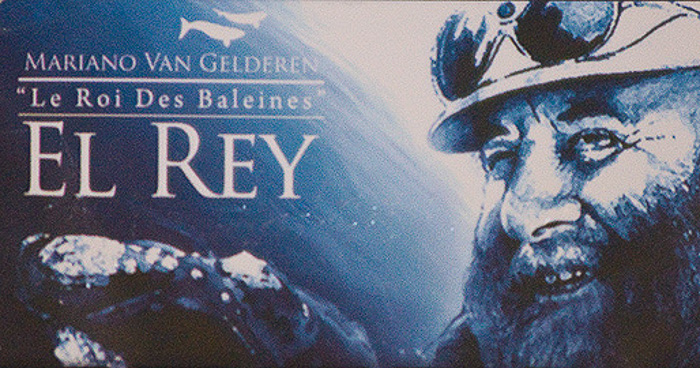
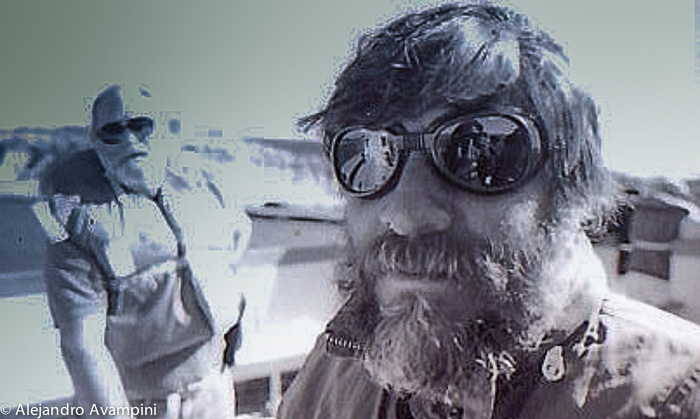
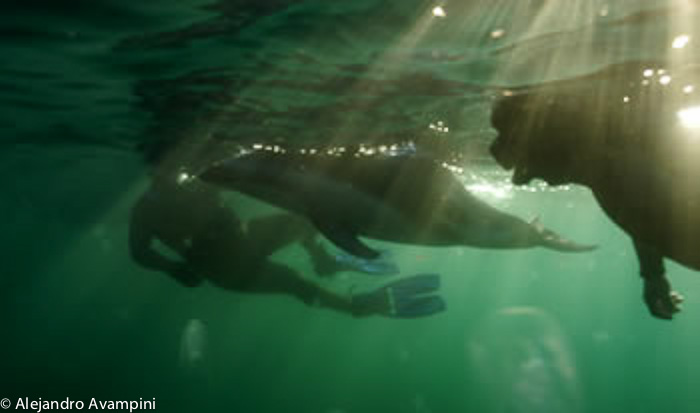
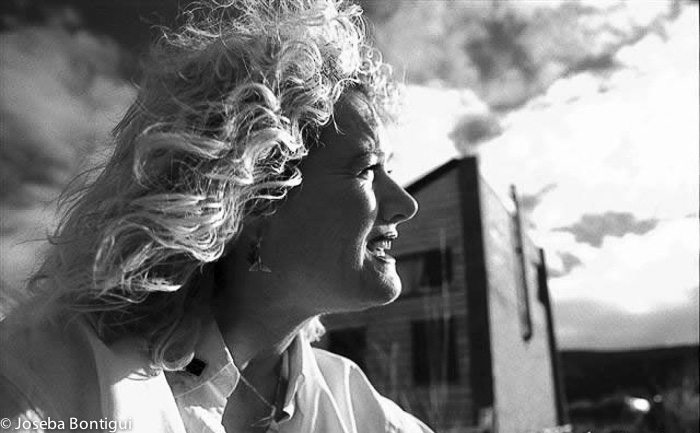
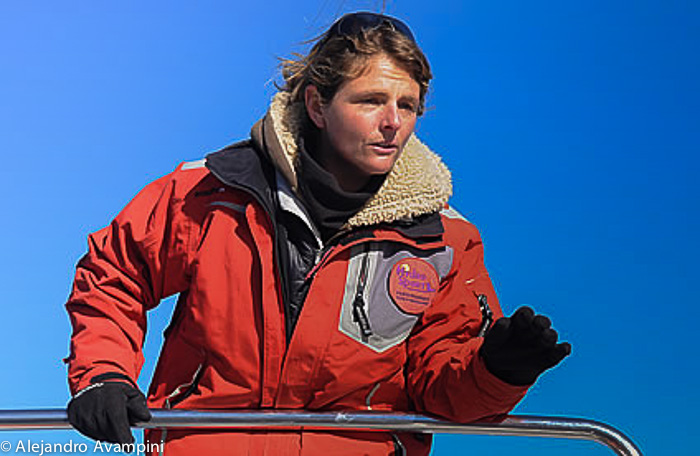 Raised in the Valdes Peninsula and daughter to the first hookah artesian fisherman to set up camp in the Riacho Estuary of Golfo San Jose, the sea has been an integral part of her life. Without losing sight of her sensitive, feminine profile Sofia has educated herself in maritime activities that many a man would find impossible. Specializing in open air activities she is an ocean kayak guide and directs, together with her husband Pablo Passera, Patagonian Explorers. Together they offer excursions exploring and interpreting the Patagoian Coast. Many of their excursions take place along the Valdes Peninsula in the San Jose and Nuevo Gulfs. Sofia is a PADI dive instructor, Argentine Coast Guard approved Professional Diver, Whale Guide and Boat Captain. She has dedicated her life to activities in the sea and over the last 15 years works the whale season as a guide and captain in Hydrosport, her brother Rafael Benegas’ whale watching company
Raised in the Valdes Peninsula and daughter to the first hookah artesian fisherman to set up camp in the Riacho Estuary of Golfo San Jose, the sea has been an integral part of her life. Without losing sight of her sensitive, feminine profile Sofia has educated herself in maritime activities that many a man would find impossible. Specializing in open air activities she is an ocean kayak guide and directs, together with her husband Pablo Passera, Patagonian Explorers. Together they offer excursions exploring and interpreting the Patagoian Coast. Many of their excursions take place along the Valdes Peninsula in the San Jose and Nuevo Gulfs. Sofia is a PADI dive instructor, Argentine Coast Guard approved Professional Diver, Whale Guide and Boat Captain. She has dedicated her life to activities in the sea and over the last 15 years works the whale season as a guide and captain in Hydrosport, her brother Rafael Benegas’ whale watching company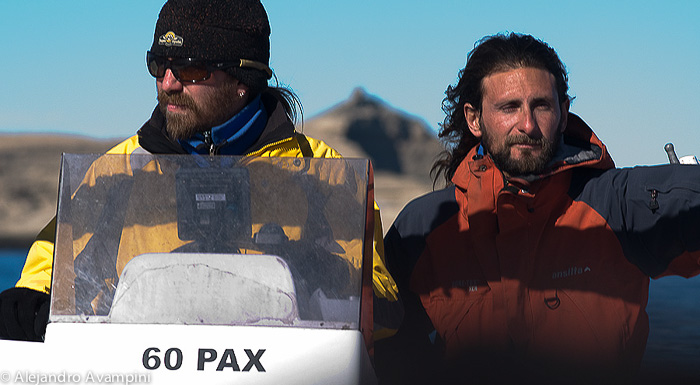 Like most the Whale Watching Captains that live in Puerto Piramides, Pablo Fioramonti is a self-invented man. When he arrived in Puerto Madryn, from his birth place in Greater Buenos Aires, he began working and learning to be a diver in the same company where he is now an international Dive Instructor, Captain and Whale Guide. Working for the same company, Whales Argentina, Ernesto Ricci followed a similar path, working first in the dive industry and exploring every corner of this history in the making. Now, 15 years later, both live life from a different perspective and either can be found at the helm of whale watching boats in Whales Argentina, a company owned and operated by Captain Pinino Orri.
Like most the Whale Watching Captains that live in Puerto Piramides, Pablo Fioramonti is a self-invented man. When he arrived in Puerto Madryn, from his birth place in Greater Buenos Aires, he began working and learning to be a diver in the same company where he is now an international Dive Instructor, Captain and Whale Guide. Working for the same company, Whales Argentina, Ernesto Ricci followed a similar path, working first in the dive industry and exploring every corner of this history in the making. Now, 15 years later, both live life from a different perspective and either can be found at the helm of whale watching boats in Whales Argentina, a company owned and operated by Captain Pinino Orri.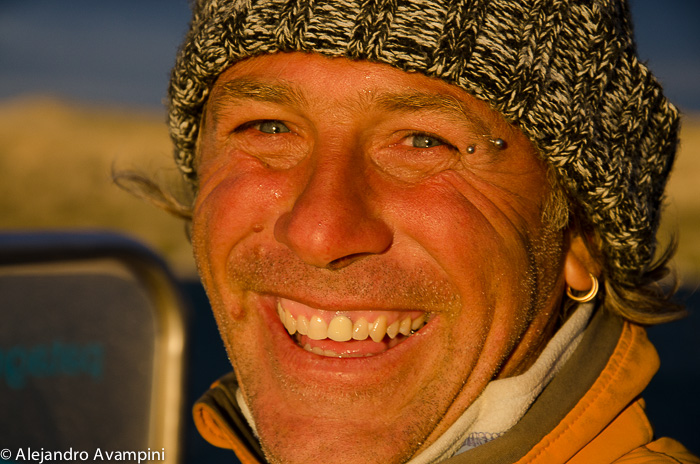 Having arrived from the small town of Cañada Rosquín, in the province of Santa Fe, Claudio Nicolini is a retired football player and fanatic fisherman. Claudio discovered his place in the world in Puerto Piramides, arriving in 1998 in a small trailer and installing himself in the municipal campground, where he lived for several years. Dedicated to work in the sea and contact with nature photography, he could not resist the temptation and naturally began to photograph whales. His passion and unique vision has allowed him to capture unique and privileged moments of the Valdes Peninsula and exhibit his work in different venues, articles, magazines and books.
Having arrived from the small town of Cañada Rosquín, in the province of Santa Fe, Claudio Nicolini is a retired football player and fanatic fisherman. Claudio discovered his place in the world in Puerto Piramides, arriving in 1998 in a small trailer and installing himself in the municipal campground, where he lived for several years. Dedicated to work in the sea and contact with nature photography, he could not resist the temptation and naturally began to photograph whales. His passion and unique vision has allowed him to capture unique and privileged moments of the Valdes Peninsula and exhibit his work in different venues, articles, magazines and books.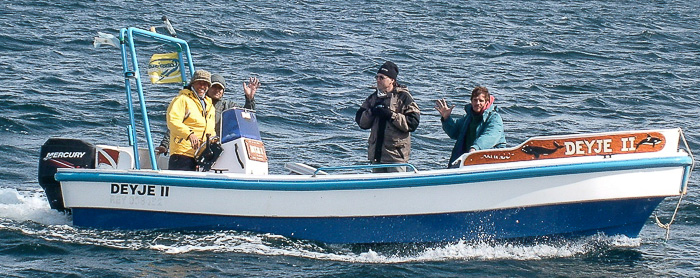 Now living in his home with a wonderful view of the bay, Claudio is a Whale Watching Guide and Captain, works in diving and swimming with Sea Lions and with his own boat, Deyje ll, offers special tours for documentary film makers and nature photographers from around the world. In the photo, Claudio is captaining Deyje ll for the photographer Gabriel Rojo and cameraman Segundo Serrato in a National Geographic production.
Now living in his home with a wonderful view of the bay, Claudio is a Whale Watching Guide and Captain, works in diving and swimming with Sea Lions and with his own boat, Deyje ll, offers special tours for documentary film makers and nature photographers from around the world. In the photo, Claudio is captaining Deyje ll for the photographer Gabriel Rojo and cameraman Segundo Serrato in a National Geographic production.

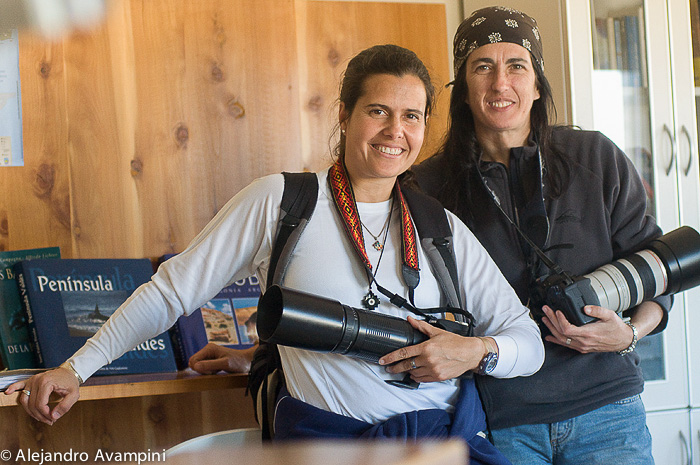
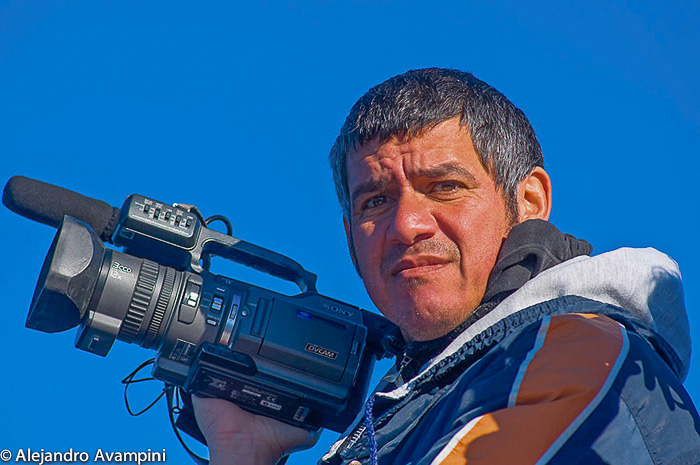 Documentary cameraman and photographer, Luis has made the Valdes Peninsula his home over more than 30 years of documenting its flora and fauna. During whale season Luis spends the better part of each day with the whales, observing and documenting the behavior of these amazing cetaceans alongside the tourists in their whale watching excursions in Golfo Nuevo. His enthusiasm and years of diving experience has allowed him to film the whales up close, in their aquatic environment, dozens of times.
Documentary cameraman and photographer, Luis has made the Valdes Peninsula his home over more than 30 years of documenting its flora and fauna. During whale season Luis spends the better part of each day with the whales, observing and documenting the behavior of these amazing cetaceans alongside the tourists in their whale watching excursions in Golfo Nuevo. His enthusiasm and years of diving experience has allowed him to film the whales up close, in their aquatic environment, dozens of times.
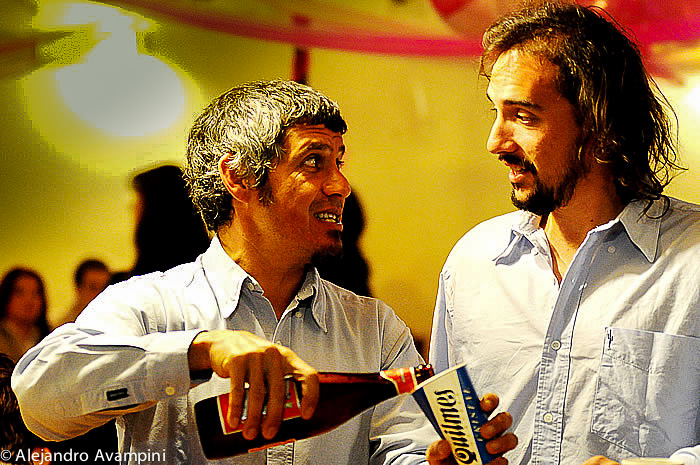
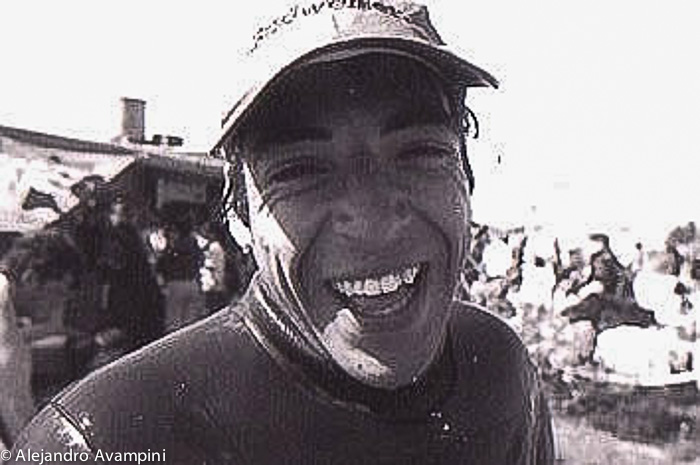 With an innate capacity for learning and understanding, Daniel is an underwater cameraman, editor, and musician. His artistic nature is made evident in many videos and local television productions where his work is presented. Entirely self-taught, at a young age he saw in Puerto Piramides his place for growth and twenty years later he has developed a life immersed in nature and maritime activities. Below is an unforgettable example of his work. This video was captured on the 10th of May, 2008 when a group of aprox. 150 Pseudo Orcas appeared in the bay of Puerto Piramides, coinciding with the eruption and activity of the Chaiten Volcano in Chile. The volcanic ash from this eruption was blown west until reaching the shores of Golfo Nuevo. For several days the horizon line was lost in a foggy haze of ash and the Pseudo Orcas appeared, swimming non-stop back and forth in the bay, as if disoriented. A possible theory is that the minerals found in the suspended ash disrupted their echolocation, disorienting their natural guidance abilities. The reality was an unusual situation with unique, warm, natural lighting, ideal for documenting these rapid marine mammals, a rare situation immortalized by Daniel’s video.
With an innate capacity for learning and understanding, Daniel is an underwater cameraman, editor, and musician. His artistic nature is made evident in many videos and local television productions where his work is presented. Entirely self-taught, at a young age he saw in Puerto Piramides his place for growth and twenty years later he has developed a life immersed in nature and maritime activities. Below is an unforgettable example of his work. This video was captured on the 10th of May, 2008 when a group of aprox. 150 Pseudo Orcas appeared in the bay of Puerto Piramides, coinciding with the eruption and activity of the Chaiten Volcano in Chile. The volcanic ash from this eruption was blown west until reaching the shores of Golfo Nuevo. For several days the horizon line was lost in a foggy haze of ash and the Pseudo Orcas appeared, swimming non-stop back and forth in the bay, as if disoriented. A possible theory is that the minerals found in the suspended ash disrupted their echolocation, disorienting their natural guidance abilities. The reality was an unusual situation with unique, warm, natural lighting, ideal for documenting these rapid marine mammals, a rare situation immortalized by Daniel’s video.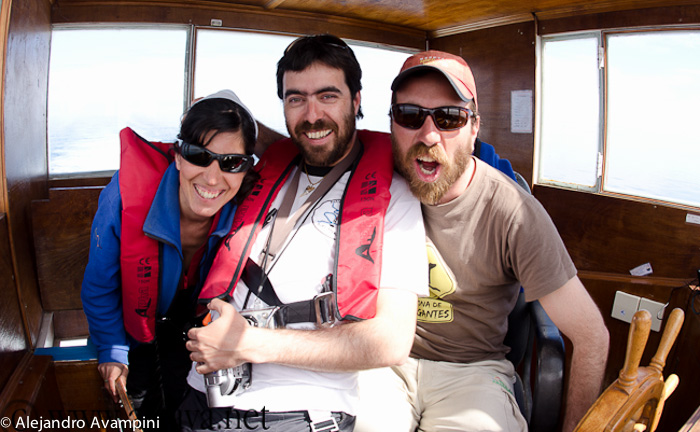 A relaxed member of the aquatic community, Alexis is found in the photo above between Paula Torres and his brother Pablo, at the helm of Whales Argentina’s whale watching catamaran. Alexis first arrived in Puerto Piramides, when still very young, to visit his older brother. He fell so in love with the town that he grew into and formed his personal and professional life in Puerto Piramides. He began his career as a cameraman working for Luis Pettite, as with many of the whale photographers in town. Having earned his space in the maritime realm as well as the artistic, Alexis is also now a whale watching captain and whale guide who has forged his identity in the local maritime community.
A relaxed member of the aquatic community, Alexis is found in the photo above between Paula Torres and his brother Pablo, at the helm of Whales Argentina’s whale watching catamaran. Alexis first arrived in Puerto Piramides, when still very young, to visit his older brother. He fell so in love with the town that he grew into and formed his personal and professional life in Puerto Piramides. He began his career as a cameraman working for Luis Pettite, as with many of the whale photographers in town. Having earned his space in the maritime realm as well as the artistic, Alexis is also now a whale watching captain and whale guide who has forged his identity in the local maritime community.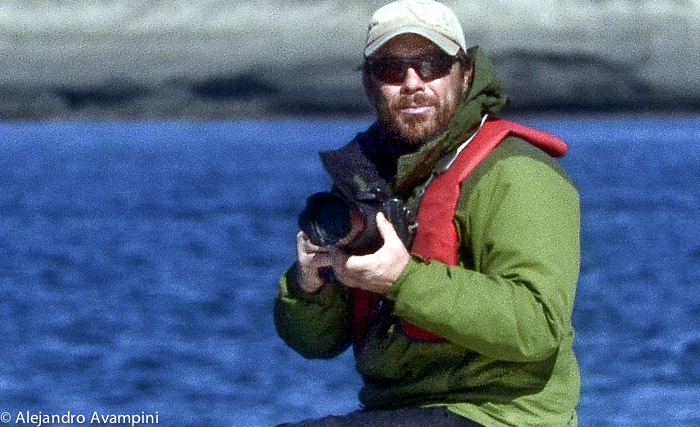 With a Fervent and unconditional love for nature and far from his birth place in Utah, Stephen made his way into Puerto Piramides almost 20 years ago. Attracted to the sea and the unique energy of the whales he began photographing these amazing cetaceans while working for Luis Pettite. For more than ten years Stephen has and continues to work as a photographer aboard the whale watching boats of Jorge Schmid, Punta Ballenas, on the second access road to the beach. Stephen also dedicates much of his time to underwater photography and some of his work and observations can be seen on his blog. The photograph below is just an example of his artistic expression in the depths. Stephen has collaborated for many years with different foundations and institutions and has been invited to exhibit his work in different galleries.
With a Fervent and unconditional love for nature and far from his birth place in Utah, Stephen made his way into Puerto Piramides almost 20 years ago. Attracted to the sea and the unique energy of the whales he began photographing these amazing cetaceans while working for Luis Pettite. For more than ten years Stephen has and continues to work as a photographer aboard the whale watching boats of Jorge Schmid, Punta Ballenas, on the second access road to the beach. Stephen also dedicates much of his time to underwater photography and some of his work and observations can be seen on his blog. The photograph below is just an example of his artistic expression in the depths. Stephen has collaborated for many years with different foundations and institutions and has been invited to exhibit his work in different galleries. 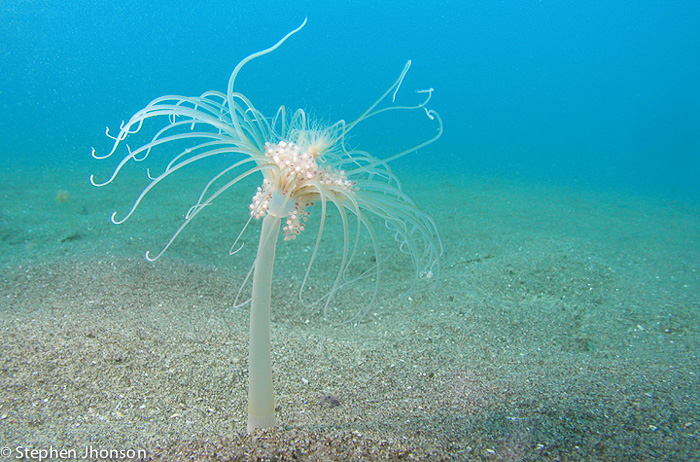
 Without a doubt, Angel is a photographer that has reached the heights, having established his office in the crow’s nest of Whales Argentina’s Catamaran. The images he has captured in 15 years of work on the sea have been published in the most diversified ways, from varying editorials to giant billboards along the 9 de Julio avenue in Buenos Aires. With this original perspective and angle, he has achieved aerial images difficult to capture due to the movement of the crow’s nest and impossible images for those who suffer motion sickness. He has collaborated in photo-identification of the whales along with other scientific projects. In the posted image, the catamaran navigates amongst orcas while Angel captures his amazing images.
Without a doubt, Angel is a photographer that has reached the heights, having established his office in the crow’s nest of Whales Argentina’s Catamaran. The images he has captured in 15 years of work on the sea have been published in the most diversified ways, from varying editorials to giant billboards along the 9 de Julio avenue in Buenos Aires. With this original perspective and angle, he has achieved aerial images difficult to capture due to the movement of the crow’s nest and impossible images for those who suffer motion sickness. He has collaborated in photo-identification of the whales along with other scientific projects. In the posted image, the catamaran navigates amongst orcas while Angel captures his amazing images.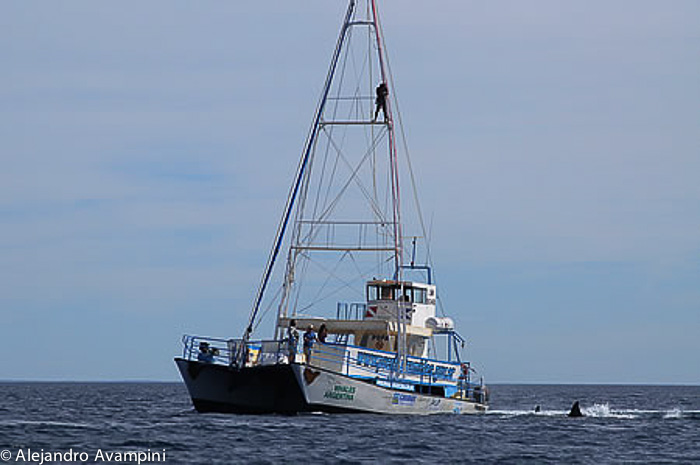
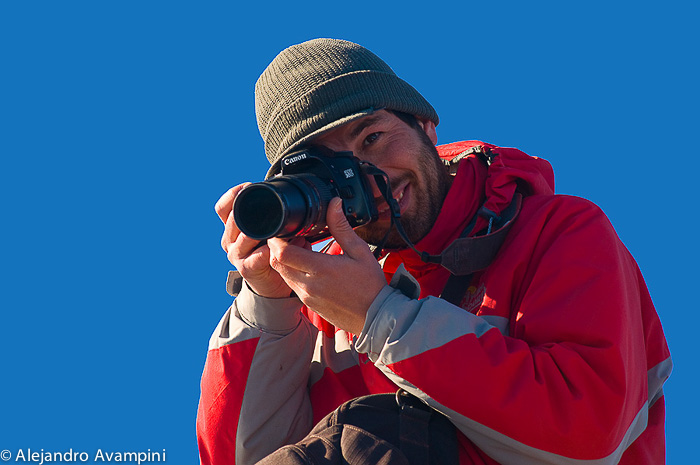 Often surreal and juxtaposed, the images created through Jorge’s visión of whales and whale watching tours are just as captivating as his photographic work with the local artesian fishing communities. Jorge studied photo journalism and worked as an independent photo journalist for different national and provincial magazines and newspapers. Jorge and his family left greater Bs. As. many years back to call Puerto Piramides their home, a change in air that allowed Jorge to become a reference in Argentine maritime photography. Jorge often gives photographic clinics and courses and continues to collaborate and actively participate in varying educational areas.
Often surreal and juxtaposed, the images created through Jorge’s visión of whales and whale watching tours are just as captivating as his photographic work with the local artesian fishing communities. Jorge studied photo journalism and worked as an independent photo journalist for different national and provincial magazines and newspapers. Jorge and his family left greater Bs. As. many years back to call Puerto Piramides their home, a change in air that allowed Jorge to become a reference in Argentine maritime photography. Jorge often gives photographic clinics and courses and continues to collaborate and actively participate in varying educational areas.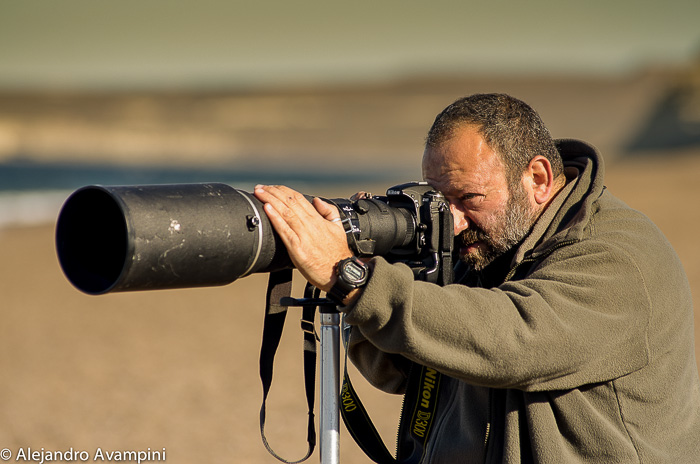 With an innate don for observation he knows how to capture each moment with a special sensitivity that has been his from birth. Continuing is his father’s profession it could be said that in his core he breaths photography. Many years passed before returning to a place he had frequented since 1994, when he came to photograph Orcas in Punta Norte. Aside from Orca attacks he obtained wonderful portraits of the park ranger, Beto Bubas amongst other characters of the Valdes Peninsula. His whale photographs have brought life to many National Tourism campaigns. In his 30 years as a professional photographer he has been published in as many editorials as can be imagined and with equally varied subjects. Nacho has worked for Perfil, Atlantida, Clarin and others, his images standing out in their graphic publications.
With an innate don for observation he knows how to capture each moment with a special sensitivity that has been his from birth. Continuing is his father’s profession it could be said that in his core he breaths photography. Many years passed before returning to a place he had frequented since 1994, when he came to photograph Orcas in Punta Norte. Aside from Orca attacks he obtained wonderful portraits of the park ranger, Beto Bubas amongst other characters of the Valdes Peninsula. His whale photographs have brought life to many National Tourism campaigns. In his 30 years as a professional photographer he has been published in as many editorials as can be imagined and with equally varied subjects. Nacho has worked for Perfil, Atlantida, Clarin and others, his images standing out in their graphic publications. Observe the size of the whale’s fluke in relation to the whale watching boat. This image was taken with nothing more than an 80-200mm lens and a Nikon D-90 camera at a distance of at least a km.
Observe the size of the whale’s fluke in relation to the whale watching boat. This image was taken with nothing more than an 80-200mm lens and a Nikon D-90 camera at a distance of at least a km.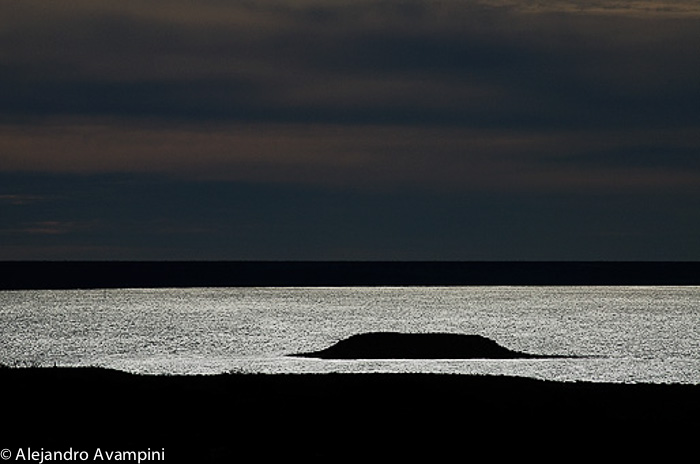

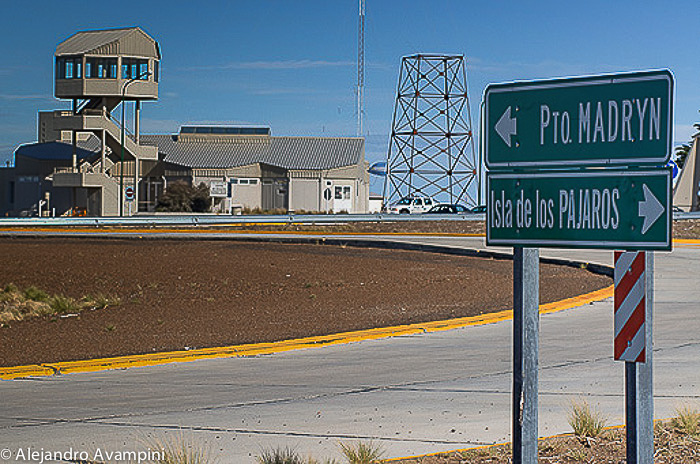 At the same place you’ll find the junction that leads to Bird Island, a reserve called because it is an important nesting area for migratory and non-migratory species. . We can say, however, that this isthmus has great biological value, because it is used as a breeding area for ten species of seabirds and shorebirds and others which also frequent it in smaller numbers. It is a very special place, perhaps even a bit mystical.
At the same place you’ll find the junction that leads to Bird Island, a reserve called because it is an important nesting area for migratory and non-migratory species. . We can say, however, that this isthmus has great biological value, because it is used as a breeding area for ten species of seabirds and shorebirds and others which also frequent it in smaller numbers. It is a very special place, perhaps even a bit mystical.  The best time of year for visiting this privileged appendage of the Valdes Peninsula, when the occupation and activity of various species of birds is at its highest, is from September through April. The early and visionary concept of conservation greatly favored the protection of Bird Island’s biodiversity from destruction and vandalism. Historically, as told by early visitors and residents of the Valdes Peninsula, “anyone could walk across to Bird Island where eggs were touched, moved, broken and removed…or the nesting birds were even shot at for sport”.
The best time of year for visiting this privileged appendage of the Valdes Peninsula, when the occupation and activity of various species of birds is at its highest, is from September through April. The early and visionary concept of conservation greatly favored the protection of Bird Island’s biodiversity from destruction and vandalism. Historically, as told by early visitors and residents of the Valdes Peninsula, “anyone could walk across to Bird Island where eggs were touched, moved, broken and removed…or the nesting birds were even shot at for sport”.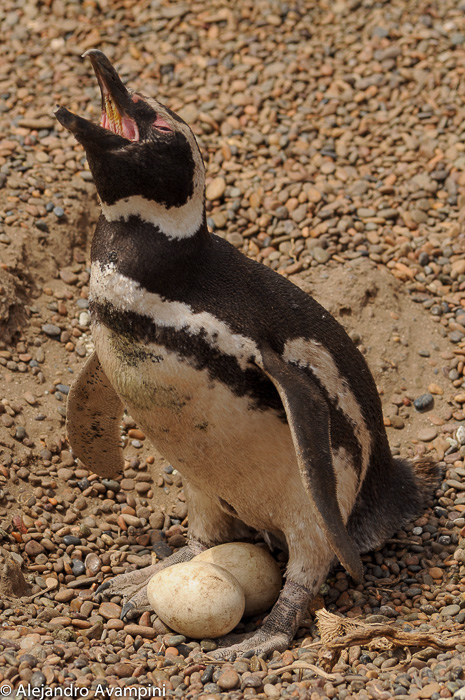
 From the wooden walkway an important and impressive panorama of Golfo San Jose and the geographic accidents that comprise its coastline are displayed. Looking west is Punta Gales (Welsh Point) and Punta Logaritmo (Logarithm Point), while the island occupies the field of vision in front looking almost due north, right next to a replica of the small chapel that existed in the San Jose Fort. With the clear skies that are frequent in these coordinates, the mouth of San Jose Gulf can be seen, with Punta Quiroga to the west and Punta Buenos Aires just 6.8km to the east. Between these two points marked by high cliffs and strong currents the enormous tidal shifts flow to and from Golfo San Matias. The unique natural characteristics make this portion of paradise worth a visit, aside from the array of birds that can be observed..
From the wooden walkway an important and impressive panorama of Golfo San Jose and the geographic accidents that comprise its coastline are displayed. Looking west is Punta Gales (Welsh Point) and Punta Logaritmo (Logarithm Point), while the island occupies the field of vision in front looking almost due north, right next to a replica of the small chapel that existed in the San Jose Fort. With the clear skies that are frequent in these coordinates, the mouth of San Jose Gulf can be seen, with Punta Quiroga to the west and Punta Buenos Aires just 6.8km to the east. Between these two points marked by high cliffs and strong currents the enormous tidal shifts flow to and from Golfo San Matias. The unique natural characteristics make this portion of paradise worth a visit, aside from the array of birds that can be observed.. 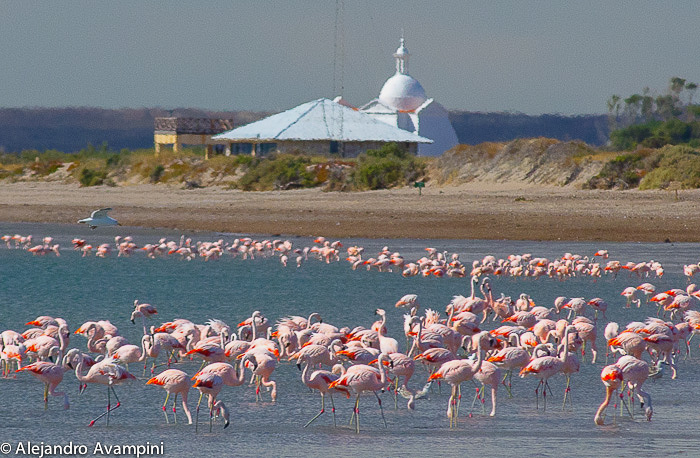 The reserve has a large fixed binocular, allowing visitors to move-in close to the activity while not disturbing or altering the bird’s reproductive behavior during their spring and summer residence.
The reserve has a large fixed binocular, allowing visitors to move-in close to the activity while not disturbing or altering the bird’s reproductive behavior during their spring and summer residence. The colour of their feathers are acquired by the food they eat, that’s why their offspring are born whitish and take on the intense pink colour from the small crustaceans, which form the major part of their diet.Flamingos are not resident in Valdes Peninsula area, however they nest in lakes in the Province of La Pampa.
The colour of their feathers are acquired by the food they eat, that’s why their offspring are born whitish and take on the intense pink colour from the small crustaceans, which form the major part of their diet.Flamingos are not resident in Valdes Peninsula area, however they nest in lakes in the Province of La Pampa.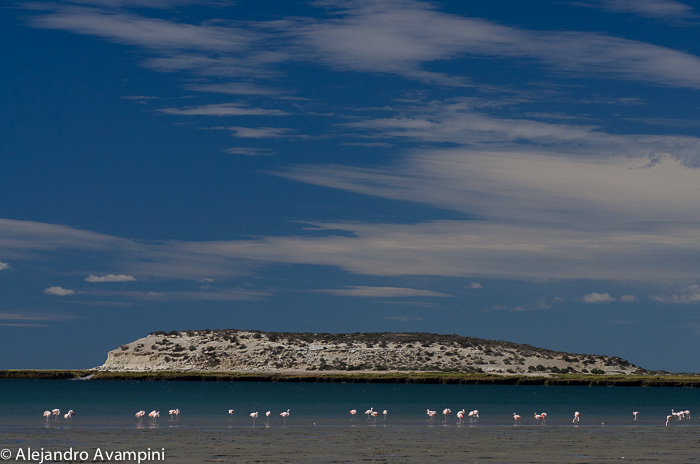 “The Valdes Peninsula is an extremely special place…” says Medina, a Park Ranger at Bird Island “…it is a huge maternity ward”, in reference to whales, sea lions, elephant seals, and dozens of species of birds that come each spring to mate, give birth and raise their offspring. Medina has worked from the start as a young, idealistic volunteer whose participation in a new concept around conservation and protection set the groundwork for what is now an established and necessary group of Park Rangers in the protected nature reserves of Chubut. Also living and working as Park Rangers in the reserve at Bird Island are Montero and Garcia Vera, both having dedicated decades of their lives assisting and educating tourists while protecting this special site.
“The Valdes Peninsula is an extremely special place…” says Medina, a Park Ranger at Bird Island “…it is a huge maternity ward”, in reference to whales, sea lions, elephant seals, and dozens of species of birds that come each spring to mate, give birth and raise their offspring. Medina has worked from the start as a young, idealistic volunteer whose participation in a new concept around conservation and protection set the groundwork for what is now an established and necessary group of Park Rangers in the protected nature reserves of Chubut. Also living and working as Park Rangers in the reserve at Bird Island are Montero and Garcia Vera, both having dedicated decades of their lives assisting and educating tourists while protecting this special site.
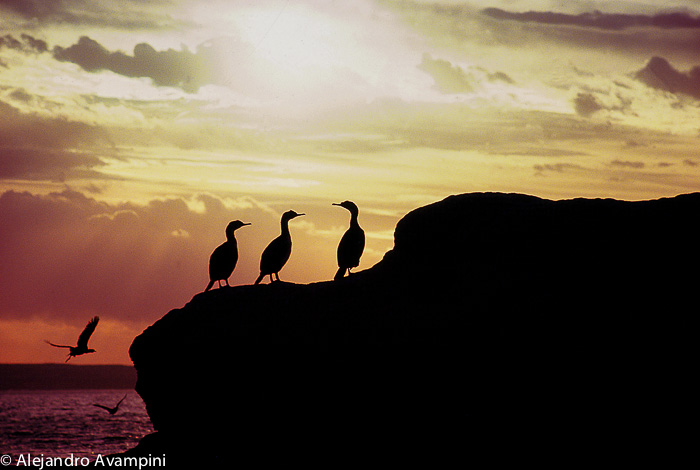 It is frequently seen flying swiftly, striking the water with a straight and accurate flight, and occasionally touching the surface with the tip of the wings. This species is primarily piscivorous. However, these observations suggest that, unlike the King cormorant and the Rock shag, the diet of this species is characterized by a high proportion of fish moving in schools and near the surface such as the smelt and bottom fish as bass. In marine environments, this cormorant has been observed feeding both individually and in flocks. It feeds mainly in shallow coastal waters (less than 1.3 km and not more than 10 m depth). After diving in search of food, it is common to see it with spread wings to the sun on a branch, drying off. The neotropic cormorant builds nests with branches cemented with their own guano.
It is frequently seen flying swiftly, striking the water with a straight and accurate flight, and occasionally touching the surface with the tip of the wings. This species is primarily piscivorous. However, these observations suggest that, unlike the King cormorant and the Rock shag, the diet of this species is characterized by a high proportion of fish moving in schools and near the surface such as the smelt and bottom fish as bass. In marine environments, this cormorant has been observed feeding both individually and in flocks. It feeds mainly in shallow coastal waters (less than 1.3 km and not more than 10 m depth). After diving in search of food, it is common to see it with spread wings to the sun on a branch, drying off. The neotropic cormorant builds nests with branches cemented with their own guano.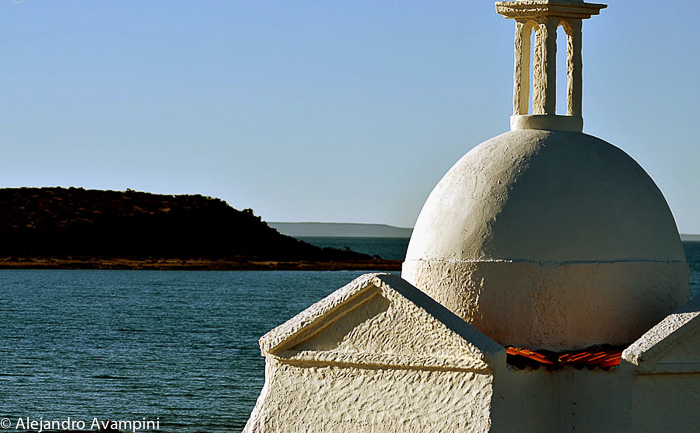 This image represents just one small corner of Patagonia, a landscape illuminated by the warm glow of sunset reflected upon the small chapel at Bird Island, a replica of the one that stood at the San Jose fort in an early attempt at Spanish colonization. Isolated and alone, set to one side of the visitor’s center, its construction brings to life time long past and refreshes our collective memory.
This image represents just one small corner of Patagonia, a landscape illuminated by the warm glow of sunset reflected upon the small chapel at Bird Island, a replica of the one that stood at the San Jose fort in an early attempt at Spanish colonization. Isolated and alone, set to one side of the visitor’s center, its construction brings to life time long past and refreshes our collective memory.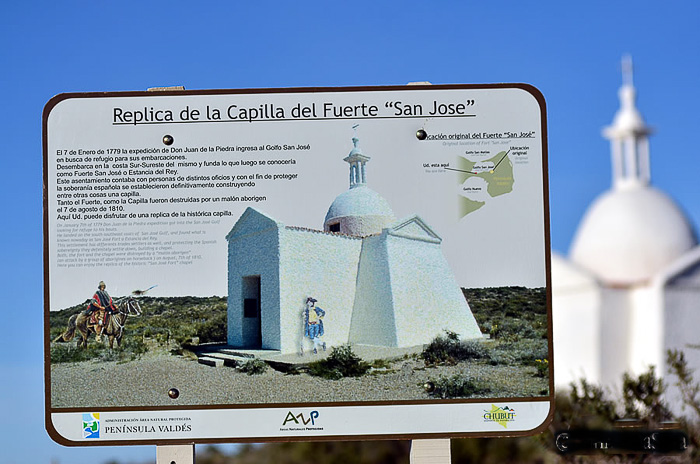 For those with a deeper interest in this colonial history I have attached (spanish) a study made by Jimena Alberti on the archeological history of the Valdes Peninsula entitled
For those with a deeper interest in this colonial history I have attached (spanish) a study made by Jimena Alberti on the archeological history of the Valdes Peninsula entitled 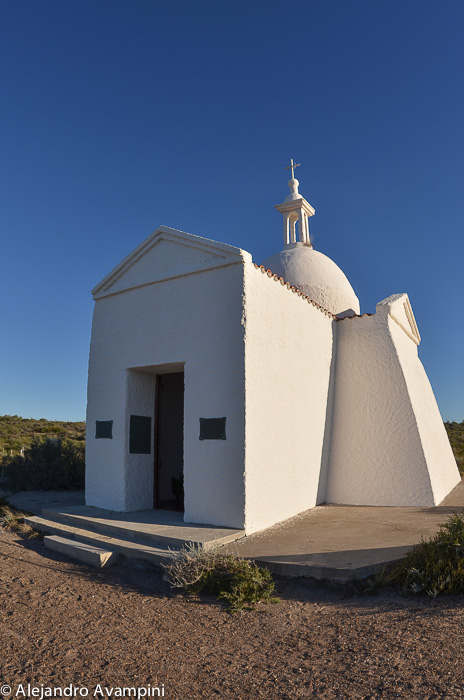
 The ships pilot, Genral Don Basilio Villarino, discovered fresh water springs close to the landing site, a place that would later be named Don Basilio in his honor. Thanks to drinkable water from this spring and through an arduous process of work and sacrifice they were able to establish small shelters and gardens with irrigation channels.
The ships pilot, Genral Don Basilio Villarino, discovered fresh water springs close to the landing site, a place that would later be named Don Basilio in his honor. Thanks to drinkable water from this spring and through an arduous process of work and sacrifice they were able to establish small shelters and gardens with irrigation channels.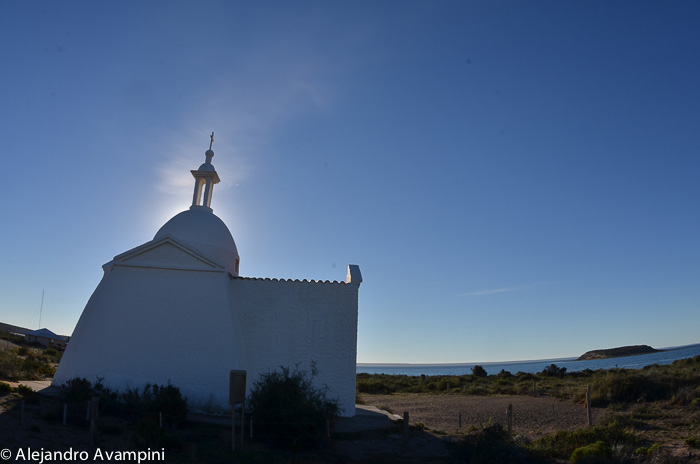 With the objective of establishing a fixed colony and thereby expanding and protecting Spanish sovereignty individuals of various professions and abilities constructed, amongst other buildings, a small chapel. The chapel that can be visited at Bird Island is a replica some 30km from the original site where the small fortress La Candelaria once existed.
With the objective of establishing a fixed colony and thereby expanding and protecting Spanish sovereignty individuals of various professions and abilities constructed, amongst other buildings, a small chapel. The chapel that can be visited at Bird Island is a replica some 30km from the original site where the small fortress La Candelaria once existed.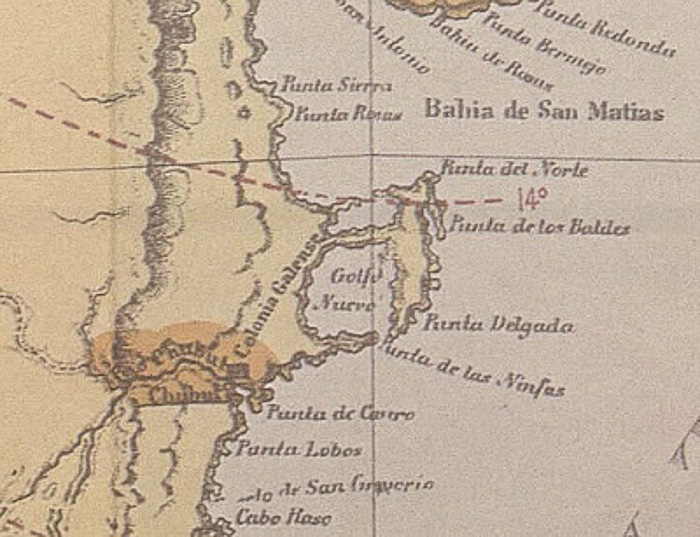 According to documents recorded months later at Fort Rio Negro, by survivors, it is told that on the 8th of August 1810, the colony at Fort San Jose was attacked by an indigenous mob of Tehuelches, led by the Chiefs Colchecan Cossuna, Tanana, Zenchil, Salu and others. The attack completely destroyed the colony and its installations, including the fortress and chapel. The unofficial story is that this violent attack, where only a few were allowed to survive to tell the tale after 30 years of mutual occupation, was probably the product of poor treatment by the colonizers.
According to documents recorded months later at Fort Rio Negro, by survivors, it is told that on the 8th of August 1810, the colony at Fort San Jose was attacked by an indigenous mob of Tehuelches, led by the Chiefs Colchecan Cossuna, Tanana, Zenchil, Salu and others. The attack completely destroyed the colony and its installations, including the fortress and chapel. The unofficial story is that this violent attack, where only a few were allowed to survive to tell the tale after 30 years of mutual occupation, was probably the product of poor treatment by the colonizers. Here I present one of the options for adventure in our Town. Sea expeditions Kayaks day Trips to visit the Sea lion colony at Punta Piramide, during this past year this outing become obligatory in Peninsula Valdes. Pablo Passera with Sofia Benegas, her wife, own
Here I present one of the options for adventure in our Town. Sea expeditions Kayaks day Trips to visit the Sea lion colony at Punta Piramide, during this past year this outing become obligatory in Peninsula Valdes. Pablo Passera with Sofia Benegas, her wife, own 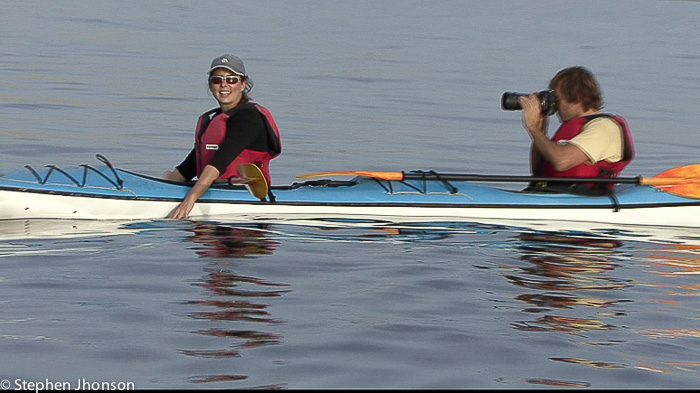 With Cecilia my wife we did several trips with this couple of friends, I remember one Sea Kayak Trip in San Jose gulf I’m going to describe. It was 3 days trip around several kilometres of Peninsula Valdes. After organize all the logistic, we pass 8 gates in 2 4×4 trucks and a trailer with the kayaks, to arrive at one beach our starting point. We loaded into the hatches of the kayaks enough amounts of fresh water, food, and snaks with pure energy. We would begin a journey that would depend on the local Guides.
With Cecilia my wife we did several trips with this couple of friends, I remember one Sea Kayak Trip in San Jose gulf I’m going to describe. It was 3 days trip around several kilometres of Peninsula Valdes. After organize all the logistic, we pass 8 gates in 2 4×4 trucks and a trailer with the kayaks, to arrive at one beach our starting point. We loaded into the hatches of the kayaks enough amounts of fresh water, food, and snaks with pure energy. We would begin a journey that would depend on the local Guides. Each couple had their tents, sleeping bugs and everything you need for camping 2 nights. Anxiety to explore and been in the water, led us to prepare to go to Buenos Aires Point. A desolate point, but very sunny, this is the northeast point which forms the entrance to the San Jose Gulf, on the other side is Punta Quiroga. Before the sunset we were at the place for camping, a great asado with a small fire by the beach. Folowing leave no trace techniques to minimize the impact in these natural places
Each couple had their tents, sleeping bugs and everything you need for camping 2 nights. Anxiety to explore and been in the water, led us to prepare to go to Buenos Aires Point. A desolate point, but very sunny, this is the northeast point which forms the entrance to the San Jose Gulf, on the other side is Punta Quiroga. Before the sunset we were at the place for camping, a great asado with a small fire by the beach. Folowing leave no trace techniques to minimize the impact in these natural places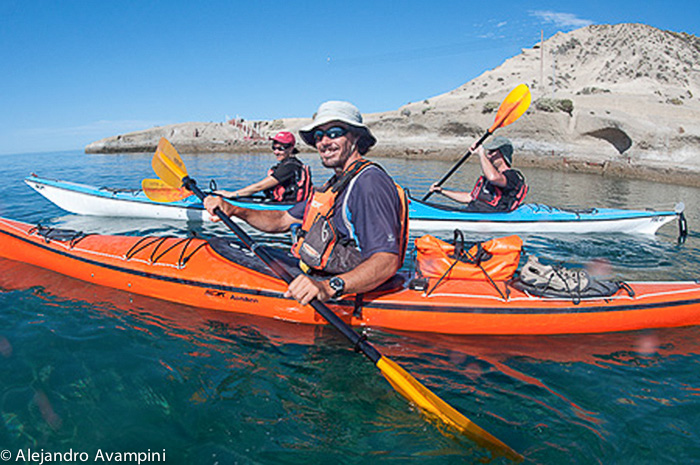 The transparency of the water let us to observe them. Its immense sizes are proportional to the delicacy of harmonic movements. One option that allows this form of movement without motor, it is navigate in silent. So it was that we entered without altering the behavior of the colony of Sea lions, our advance was in silent, quiet and marveled, calm sea and crystalline, some sea lions came to lean on the side of the kayaks very curious.
The transparency of the water let us to observe them. Its immense sizes are proportional to the delicacy of harmonic movements. One option that allows this form of movement without motor, it is navigate in silent. So it was that we entered without altering the behavior of the colony of Sea lions, our advance was in silent, quiet and marveled, calm sea and crystalline, some sea lions came to lean on the side of the kayaks very curious.  When we reach the destination beach, we stop for lunch gourmet style with the special touch of Sofi. Sun dried tomatoes with olive oil and garlic, Dijon mustard and eccentricities in such a desolate and private atmosphere, become a delicious dimension.
When we reach the destination beach, we stop for lunch gourmet style with the special touch of Sofi. Sun dried tomatoes with olive oil and garlic, Dijon mustard and eccentricities in such a desolate and private atmosphere, become a delicious dimension. 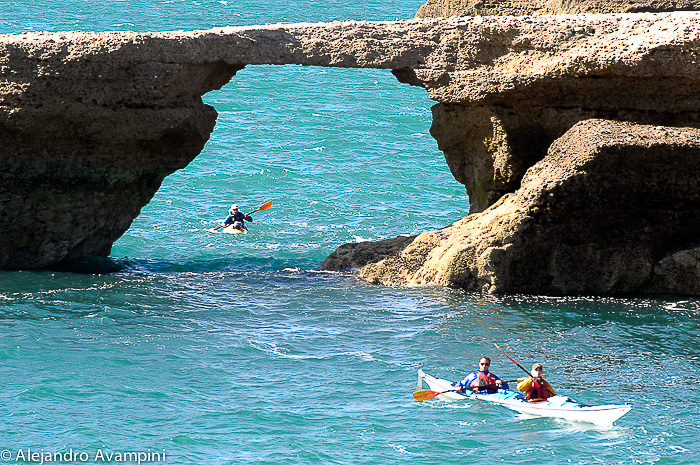 A short break at the beach lying imitating Sea lions, served to rest. After a while we continued the paddling in our kayaks, heading Punta Conos. A unique rock formation in the area, attracted our attention. We paddle all under a Bridge.
A short break at the beach lying imitating Sea lions, served to rest. After a while we continued the paddling in our kayaks, heading Punta Conos. A unique rock formation in the area, attracted our attention. We paddle all under a Bridge.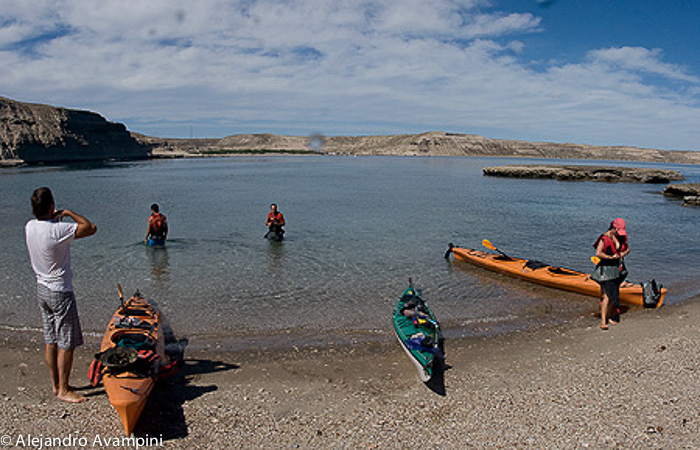 We arrived at the campsite, set up our tents and went for a short trek along the coast. Another spectacular night at Pta Conos, with Bolognese pastas and a relaxed chat with memories of lived experience a few hours ago. The paddling to playa Fracasso was filled with whales, all resting and relaxing, because the sea was calmer than the days before.
We arrived at the campsite, set up our tents and went for a short trek along the coast. Another spectacular night at Pta Conos, with Bolognese pastas and a relaxed chat with memories of lived experience a few hours ago. The paddling to playa Fracasso was filled with whales, all resting and relaxing, because the sea was calmer than the days before.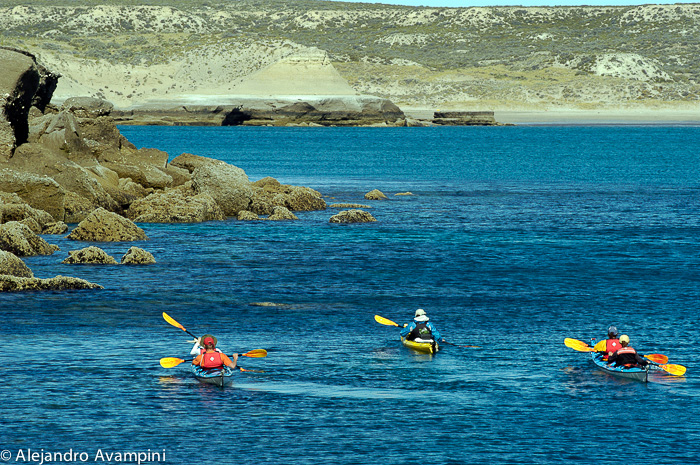
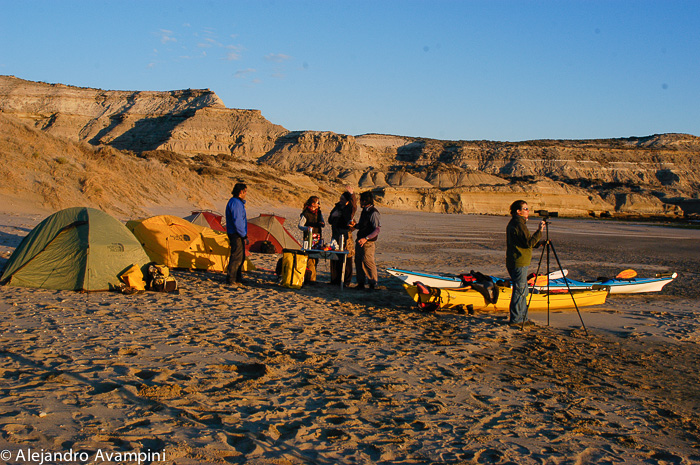
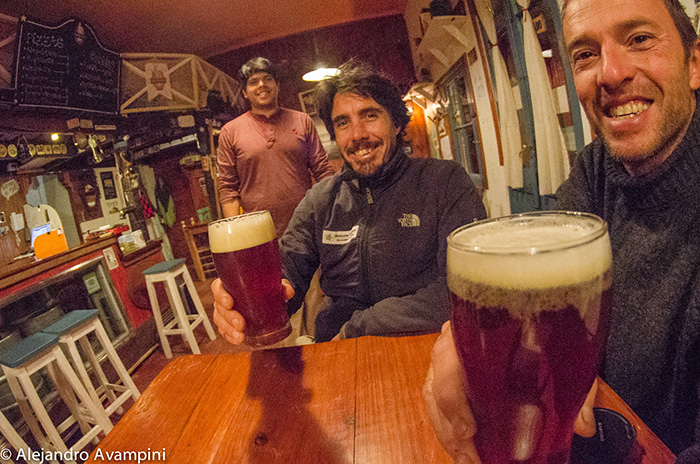
 Horse-back riding in the Valdes Peninsula is, thanks to Victoria and Gerardo, an experience made possible from Puerto Piramides. For those looking to enjoy their stay combining nature in all their activities,
Horse-back riding in the Valdes Peninsula is, thanks to Victoria and Gerardo, an experience made possible from Puerto Piramides. For those looking to enjoy their stay combining nature in all their activities,  Criollos de Valdes offers interpretive rides for discovering the Coastal Patagonian Steppe. Along the way it is common to observe whales, various species of birds and other animals both native and migratory, an indescribable amount of fossil remains, bringing to the surface millions of years of geological history, and one of the best ways for enjoying the peace and silence of a sunset in this unique and infinite site. This video, made by the province of Chubut, is dedicated to the adventure activities offered from the mountains to the sea. Very nicely edited, amongst the other areas of the province, you will observe those made in Puerto Piramides, such as Horse-back riding and Mountain bike.
Criollos de Valdes offers interpretive rides for discovering the Coastal Patagonian Steppe. Along the way it is common to observe whales, various species of birds and other animals both native and migratory, an indescribable amount of fossil remains, bringing to the surface millions of years of geological history, and one of the best ways for enjoying the peace and silence of a sunset in this unique and infinite site. This video, made by the province of Chubut, is dedicated to the adventure activities offered from the mountains to the sea. Very nicely edited, amongst the other areas of the province, you will observe those made in Puerto Piramides, such as Horse-back riding and Mountain bike.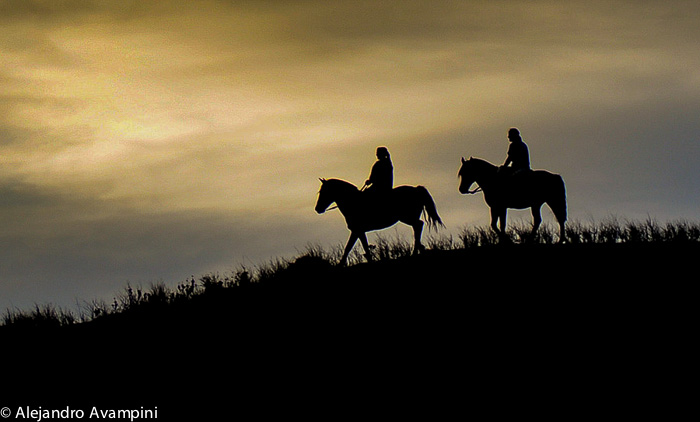
 Mountain bike riding is an adventure sport practiced just about everywhere with Patagonia being no exception. In Puerto Piramides, long time resident Mario Gadda offers daily tours and other special excursions. The name of his business
Mountain bike riding is an adventure sport practiced just about everywhere with Patagonia being no exception. In Puerto Piramides, long time resident Mario Gadda offers daily tours and other special excursions. The name of his business 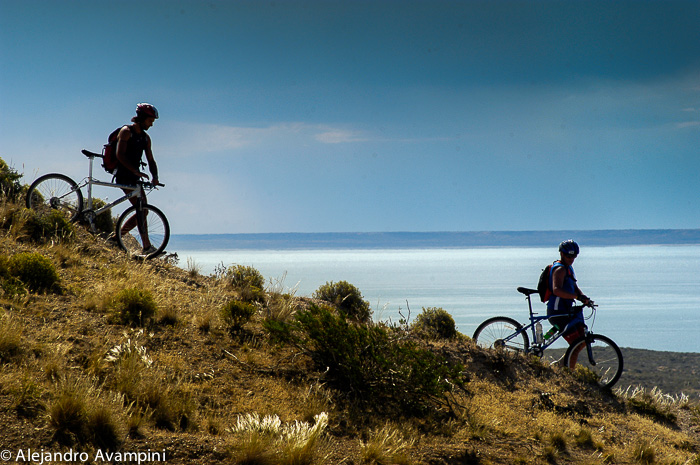 With modern, professional mountain bikes and all other necessary equipment provided, Mario offers guided tours for discovering at a rhythm your own body dictates, to hidden corners, through incomparable landscapes and magnificent sunsets that his more than twenty years exploring the region guarantees.
With modern, professional mountain bikes and all other necessary equipment provided, Mario offers guided tours for discovering at a rhythm your own body dictates, to hidden corners, through incomparable landscapes and magnificent sunsets that his more than twenty years exploring the region guarantees.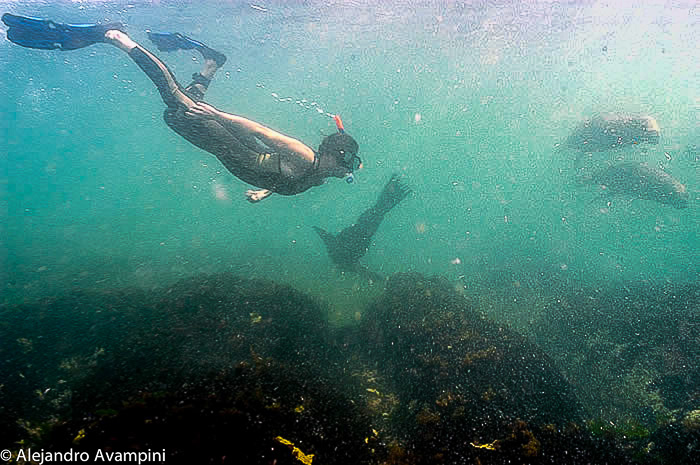 One of the most attractive adventure activities for travelers to the Valdes Peninsula is Scuba Diving. Scuba is a discipline that is enjoyed by more and more visitors every day and there are many ideal underwater formations in and around the coast of Puerto Madryn and Puerto Piramides. 15 different professional dive companies in the area offer from the very first baptism dive to certified courses, deep dives, and wreck dives, amongst many other diverse options. The Valdes Peninsula is recognized as the Scuba Diving capital in Argentina.
One of the most attractive adventure activities for travelers to the Valdes Peninsula is Scuba Diving. Scuba is a discipline that is enjoyed by more and more visitors every day and there are many ideal underwater formations in and around the coast of Puerto Madryn and Puerto Piramides. 15 different professional dive companies in the area offer from the very first baptism dive to certified courses, deep dives, and wreck dives, amongst many other diverse options. The Valdes Peninsula is recognized as the Scuba Diving capital in Argentina.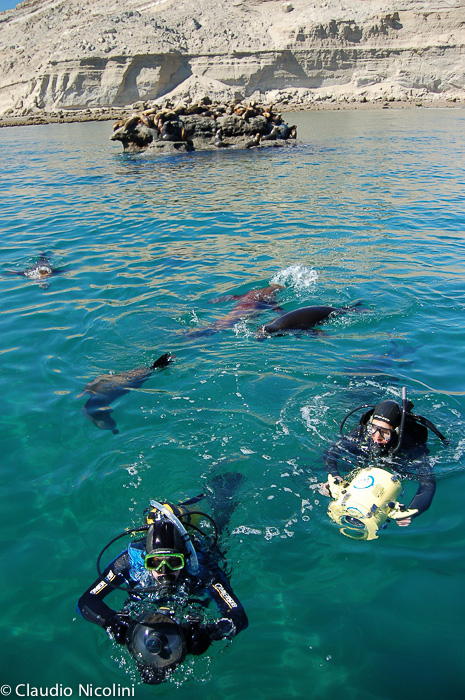
 Without a doubt the newest alternative amongst all of the dive options is snorkeling with Sea Lions. Since the approval of this activity by the provincial government of Chubut, it has become very popular and really is a must do experience, at least once in your life. Floating on the sea in a dive boat close to a Sea Lion colony activates the curious nature of these marine mammals and while the divers prepare to venture into the water the boat becomes surrounding by these excessively inquisitive creatures. Once over the side, one is immersed in the closest contact possible with wildlife of the Valdes Peninsula undunderwater. To make this excursion it is not necessary to be a certified diver and due to the use of a neoprene suit, providing positive buoyancy and maintaining body heat, it is not a requirement knowing how to swim. Calmly breathing while floating on the surface in a wetsuit with nothing more than a mask, snorkel and fins and surrounded by these curious and friendly ocean dwelling mammals is an unforgettable experience.
Without a doubt the newest alternative amongst all of the dive options is snorkeling with Sea Lions. Since the approval of this activity by the provincial government of Chubut, it has become very popular and really is a must do experience, at least once in your life. Floating on the sea in a dive boat close to a Sea Lion colony activates the curious nature of these marine mammals and while the divers prepare to venture into the water the boat becomes surrounding by these excessively inquisitive creatures. Once over the side, one is immersed in the closest contact possible with wildlife of the Valdes Peninsula undunderwater. To make this excursion it is not necessary to be a certified diver and due to the use of a neoprene suit, providing positive buoyancy and maintaining body heat, it is not a requirement knowing how to swim. Calmly breathing while floating on the surface in a wetsuit with nothing more than a mask, snorkel and fins and surrounded by these curious and friendly ocean dwelling mammals is an unforgettable experience. All of the adventure activities offered in the Valdes Peninsula are safe, yet the unique nature and close interaction they allow creates intense, unimaginable and unforgettable sensations. This activity has generated a lot work in the area for professional divers and guides accompanying visitors in their interaction with these beautiful and innocent marine mammals, an investment well worth the rewards. On land Sea Lions are territorial, often remaining in the same place for hours and made uncomfortable by the close proximity of man, yet in the water their behavior changes dramatically. Underwater their movements are rapid and controlled, almost as if dancing below the surface as they approach, surround and dive below the observer. Swimming with Sea Lions is one of the activities that I most recommend in the area.
All of the adventure activities offered in the Valdes Peninsula are safe, yet the unique nature and close interaction they allow creates intense, unimaginable and unforgettable sensations. This activity has generated a lot work in the area for professional divers and guides accompanying visitors in their interaction with these beautiful and innocent marine mammals, an investment well worth the rewards. On land Sea Lions are territorial, often remaining in the same place for hours and made uncomfortable by the close proximity of man, yet in the water their behavior changes dramatically. Underwater their movements are rapid and controlled, almost as if dancing below the surface as they approach, surround and dive below the observer. Swimming with Sea Lions is one of the activities that I most recommend in the area.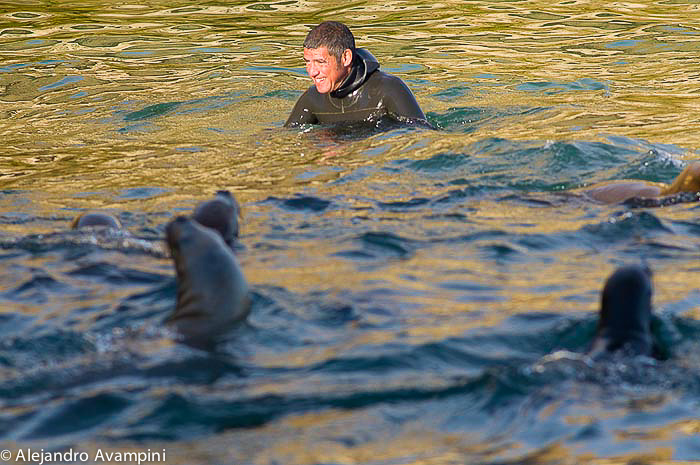 They are mammals, but marine mammals whose curiosity often dictates their behavior. This is readily observed when approached in a boat as they immediately come in close, raising their heads and careening their necks while constantly changing from one side to the other, as if looking for the best perspective for observing us.
They are mammals, but marine mammals whose curiosity often dictates their behavior. This is readily observed when approached in a boat as they immediately come in close, raising their heads and careening their necks while constantly changing from one side to the other, as if looking for the best perspective for observing us.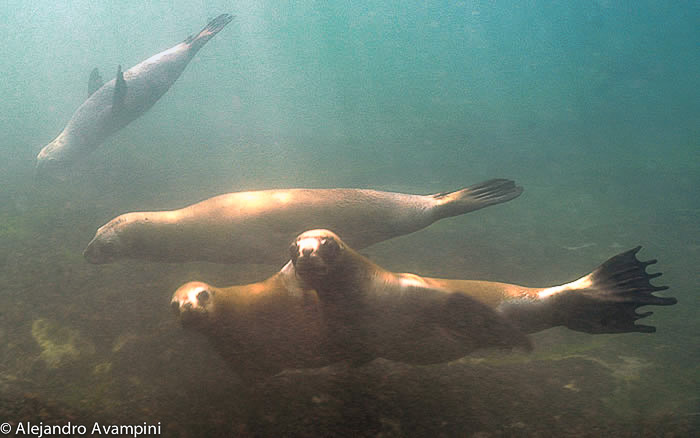 Dozens of animals, mostly females, juveniles and newborn calves from the previous summer, surround the boat and raise their heads high as if investigating the interior of the vessel. For the most part, the dominant male, easily recognized by his size and thick mane, remains at a distance controlling his harem. As each diver enters the water the Sea lions curiously approach and begin to play around the divers like they were one of their own.
Dozens of animals, mostly females, juveniles and newborn calves from the previous summer, surround the boat and raise their heads high as if investigating the interior of the vessel. For the most part, the dominant male, easily recognized by his size and thick mane, remains at a distance controlling his harem. As each diver enters the water the Sea lions curiously approach and begin to play around the divers like they were one of their own.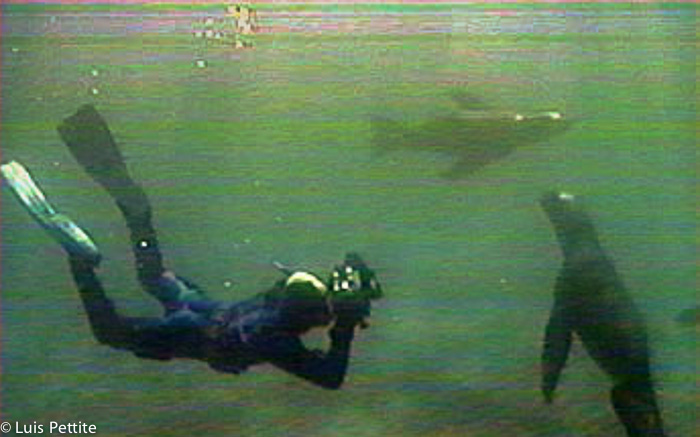 For those with experience in underwater photography, this is the ideal adventure for capturing amazing images of wild nature in their liquid universe. The density of this aquatic environment surrounds everything equally and allows for silent contemplation from a completely different perspective. With looks that say a thousand words, an almost telepathic communication is established with the Sea Lions.
For those with experience in underwater photography, this is the ideal adventure for capturing amazing images of wild nature in their liquid universe. The density of this aquatic environment surrounds everything equally and allows for silent contemplation from a completely different perspective. With looks that say a thousand words, an almost telepathic communication is established with the Sea Lions. In my work as a wildlife photographer my desire is to transmit, through the images I take of animals in general and marine mammals in particular, the understanding and symbiosis they share with their environment. Something that we as humans have either lost or have truly never come to understand, consisting in the ability to enjoy the present being free, alert and as one with our surroundings, with innocence, pushed on by nothing more than the vital energy of life itself.
In my work as a wildlife photographer my desire is to transmit, through the images I take of animals in general and marine mammals in particular, the understanding and symbiosis they share with their environment. Something that we as humans have either lost or have truly never come to understand, consisting in the ability to enjoy the present being free, alert and as one with our surroundings, with innocence, pushed on by nothing more than the vital energy of life itself.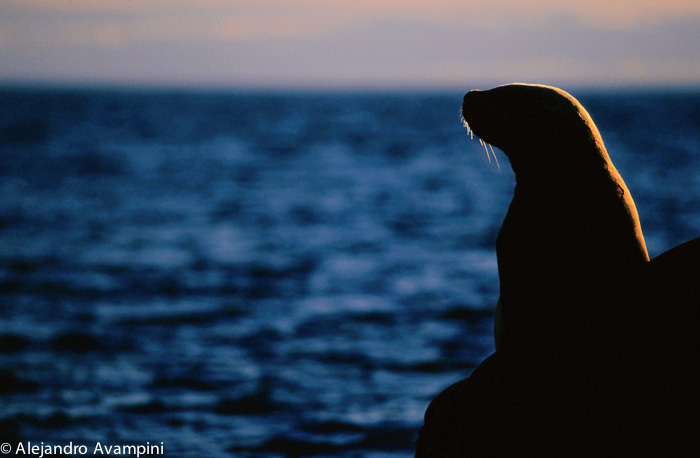 Even though diving can be practiced and enjoyed during the entire year, the local climactic conditions are not all that favorable in certain months. This is why Del Nomade Eco Hotel in Puerto Piramides opens its doors at the beginning of the best season, mid August. Inviting the visitor to come at the right time, when the conditions are at their most pristine in this World Heritage Site. I recommend you visit the Valdes Peninsula from peak Whale season up through the end of Orca season, mid August through April. During the months of May to the beginning of August adverse climactic conditions are in general less attractive. Shorter days, cold, rain and strong winds are par for the course making it the best time to avoid the Peninsula. The remaining 8 months of the year make this an excellent destination.
Even though diving can be practiced and enjoyed during the entire year, the local climactic conditions are not all that favorable in certain months. This is why Del Nomade Eco Hotel in Puerto Piramides opens its doors at the beginning of the best season, mid August. Inviting the visitor to come at the right time, when the conditions are at their most pristine in this World Heritage Site. I recommend you visit the Valdes Peninsula from peak Whale season up through the end of Orca season, mid August through April. During the months of May to the beginning of August adverse climactic conditions are in general less attractive. Shorter days, cold, rain and strong winds are par for the course making it the best time to avoid the Peninsula. The remaining 8 months of the year make this an excellent destination.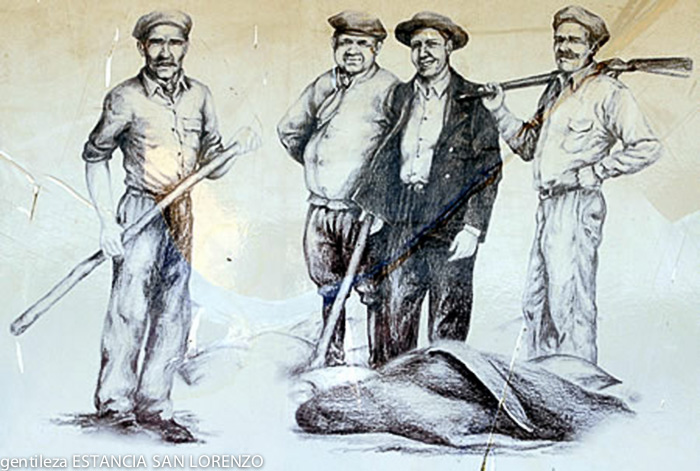 The coastal sea lion population was greatly affected as a direct result of killing of these animals for their skin and fat. In the Valdes Peninsula alone, more than 260,000 individuals were massacred from 1917 to 1953. During this same time frame, the number of individuals processed is Argentina was well over one half million. Over most of the last century this commercial activity was regulated, and in 1953, the killing of the One Haired Sea Lion was prohibited. Today, more than sixty years after having suspended hunting, the total population of Sea Lions in the Valdes Peninsula is estimated at 20,000 individuals, less than the number killed per year during the height of the commercial processing of these animals. Those that made a living in the killing of Sea Lions and Seals were known as ¨Sealers¨, and the way there job was carried out was bloody; with long, heavy wooden clubs they would beat the animals over the head and snout until dead. Today, in the Valdes Peninsula, the relationship between Man and Sea Lions is very different.
The coastal sea lion population was greatly affected as a direct result of killing of these animals for their skin and fat. In the Valdes Peninsula alone, more than 260,000 individuals were massacred from 1917 to 1953. During this same time frame, the number of individuals processed is Argentina was well over one half million. Over most of the last century this commercial activity was regulated, and in 1953, the killing of the One Haired Sea Lion was prohibited. Today, more than sixty years after having suspended hunting, the total population of Sea Lions in the Valdes Peninsula is estimated at 20,000 individuals, less than the number killed per year during the height of the commercial processing of these animals. Those that made a living in the killing of Sea Lions and Seals were known as ¨Sealers¨, and the way there job was carried out was bloody; with long, heavy wooden clubs they would beat the animals over the head and snout until dead. Today, in the Valdes Peninsula, the relationship between Man and Sea Lions is very different.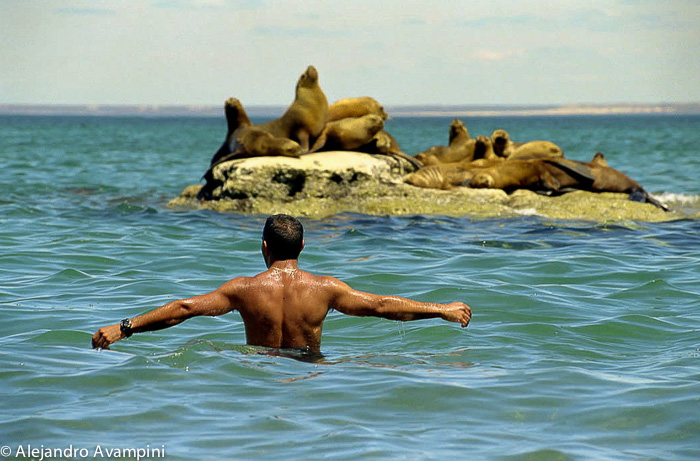 Through the growing concept of conservation and eco-tourism, these animals are now seen in a different light and considered a natural resource. Diving with Sea Lions has brought tourists from around the world to observe and interact with these marine mammals in their natural realm. An intense encounter at close quarters with wildlife in its natural environment is an unforgettable experience. Experienced guides accompany visitors with these curious and friendly marine mammals, creating jobs and offering a unique experience that heightens ones sensitivity, an investment well worth taking advantage of. On land, Sea Lions are territorial and can remain sitting or lying in the same spot for hours. In water their behavior changes dramatically, their movements become rapid and with complete control of the space they want to keep. Swimming with these curious and friendly marine mammals is one of the activities that I would most recommend while in the Valdes Peninsula.
Through the growing concept of conservation and eco-tourism, these animals are now seen in a different light and considered a natural resource. Diving with Sea Lions has brought tourists from around the world to observe and interact with these marine mammals in their natural realm. An intense encounter at close quarters with wildlife in its natural environment is an unforgettable experience. Experienced guides accompany visitors with these curious and friendly marine mammals, creating jobs and offering a unique experience that heightens ones sensitivity, an investment well worth taking advantage of. On land, Sea Lions are territorial and can remain sitting or lying in the same spot for hours. In water their behavior changes dramatically, their movements become rapid and with complete control of the space they want to keep. Swimming with these curious and friendly marine mammals is one of the activities that I would most recommend while in the Valdes Peninsula.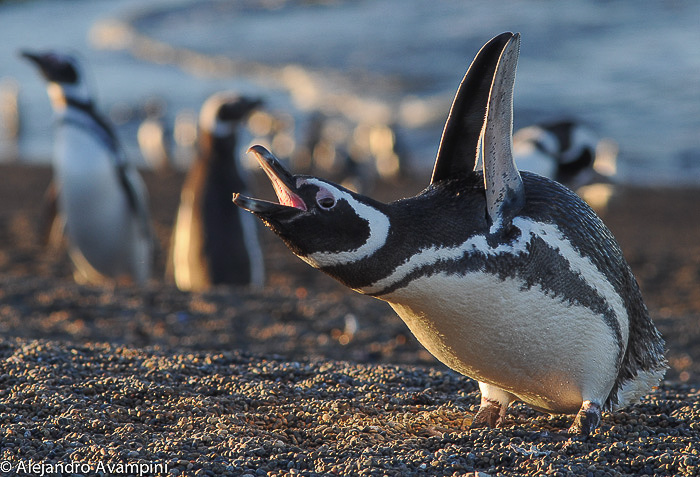

 Punta Tombo has been home to as many as one million penguins, though over the last several seasons a decrease in the population has been observed. In recent seasons, population census recorded around 400,000 penguins observed.
Punta Tombo has been home to as many as one million penguins, though over the last several seasons a decrease in the population has been observed. In recent seasons, population census recorded around 400,000 penguins observed.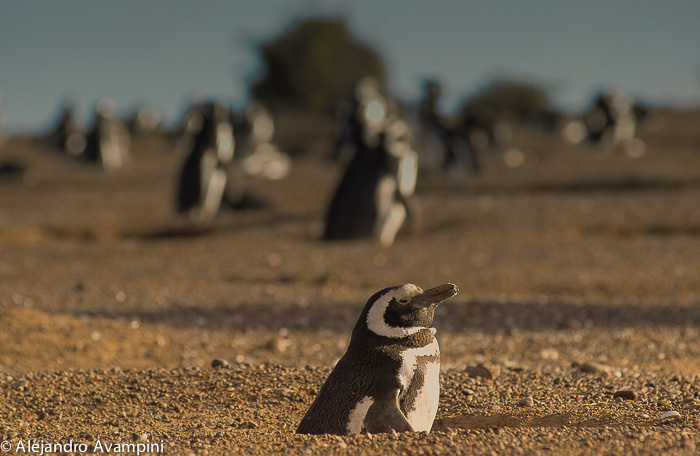 The scientific community has paid special attention to this change. The most widely accepted theory is that the penguin population has made a geographic change finding greater concentrations of fish and other marine life, on which they feed, close to the Valdes Peninsula. The information, we shared in this APP is corroborated by Pablo Borboroglu, President of
The scientific community has paid special attention to this change. The most widely accepted theory is that the penguin population has made a geographic change finding greater concentrations of fish and other marine life, on which they feed, close to the Valdes Peninsula. The information, we shared in this APP is corroborated by Pablo Borboroglu, President of  Penguins are perfectly adapted to marine aquatic life at low temperatures. A product of evolution, their spindle-shaped body allows better displacement of water, resulting in high hydrodynamic corporeal form.
Penguins are perfectly adapted to marine aquatic life at low temperatures. A product of evolution, their spindle-shaped body allows better displacement of water, resulting in high hydrodynamic corporeal form.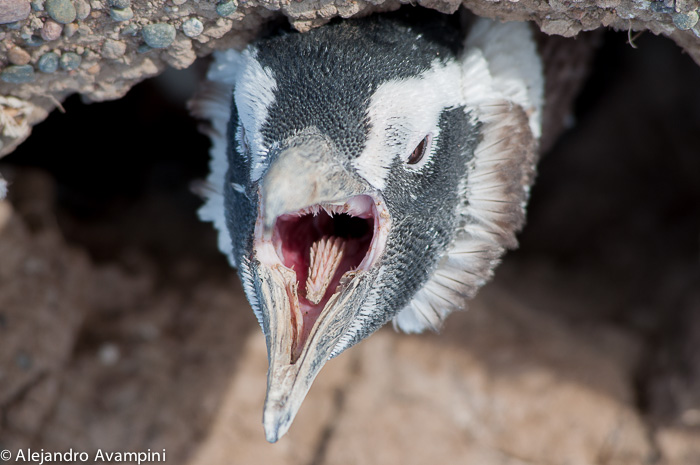 The Penguins’ beak is vertically flattened, very strong, long and curved at its end, together making it an excellent tool to capture their food. Like other birds its beak is adapted inside to regurgitate transported food for their young.
The Penguins’ beak is vertically flattened, very strong, long and curved at its end, together making it an excellent tool to capture their food. Like other birds its beak is adapted inside to regurgitate transported food for their young.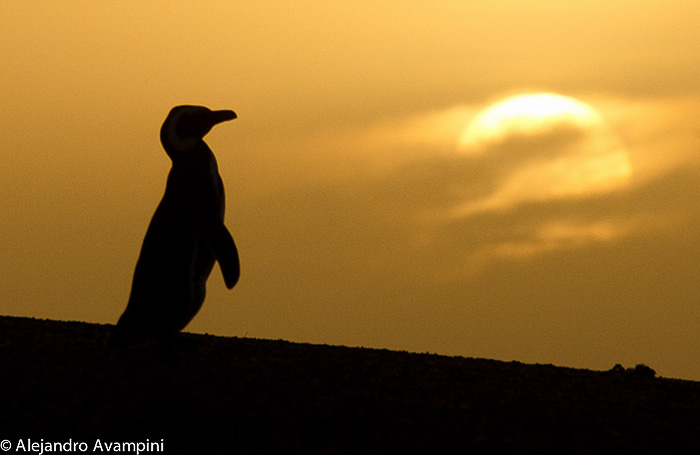 Penguins’ wings are short, very flat and strong. They are flightless, but their movement in the water is really a flight rather than swimming.The bird’s sternum is also very powerful, and is a shield to withstand the shock of diving into the water from considerable heights.
Penguins’ wings are short, very flat and strong. They are flightless, but their movement in the water is really a flight rather than swimming.The bird’s sternum is also very powerful, and is a shield to withstand the shock of diving into the water from considerable heights. 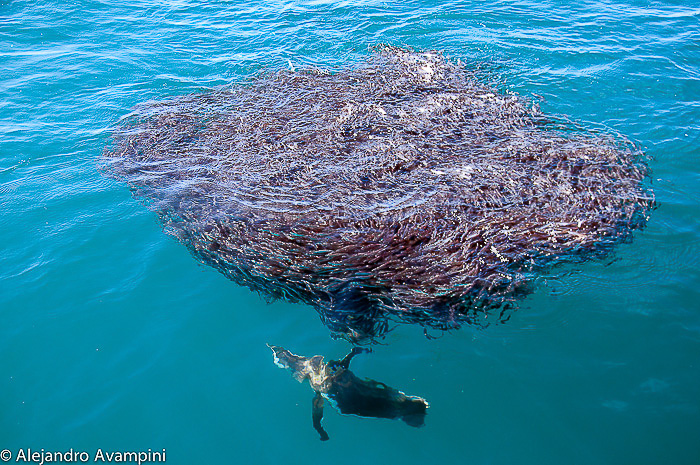 In water, the wings act as propellers, driving the Penguin at speeds up to 7 miles per hour, and they can swim 105 milles in a single day. They are extremely acrobatic underwater, which is necessary for them to catch their prey and also to allow them to escape predators. This agility comes about by using their feet as rudders.
In water, the wings act as propellers, driving the Penguin at speeds up to 7 miles per hour, and they can swim 105 milles in a single day. They are extremely acrobatic underwater, which is necessary for them to catch their prey and also to allow them to escape predators. This agility comes about by using their feet as rudders. Penguins spend much of their time preening and maintaining their plumage, which is very important to maintain the waterproof quality of the plumage. This seabird has, very close to the top of the tail, a gland, called Uropygial gland. Many specimens have there a patch of white feathers. He produce an oil that gets with his peak to applying it in their plumage with patience, achieving waterproof his new suit.
Penguins spend much of their time preening and maintaining their plumage, which is very important to maintain the waterproof quality of the plumage. This seabird has, very close to the top of the tail, a gland, called Uropygial gland. Many specimens have there a patch of white feathers. He produce an oil that gets with his peak to applying it in their plumage with patience, achieving waterproof his new suit.
 In late January and February, groups of young born the previous season, spend nearly two weeks on land where moult their pens for first time. These non-breeding birds tend to group together under bushes to escape the heat of the Sun.
In late January and February, groups of young born the previous season, spend nearly two weeks on land where moult their pens for first time. These non-breeding birds tend to group together under bushes to escape the heat of the Sun.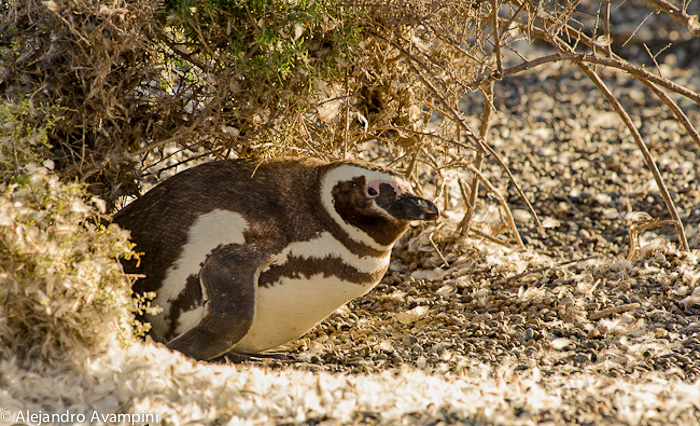 During that time remain on land without feeding and the area are flooded with small white feathers among the boulders and bushes.
During that time remain on land without feeding and the area are flooded with small white feathers among the boulders and bushes.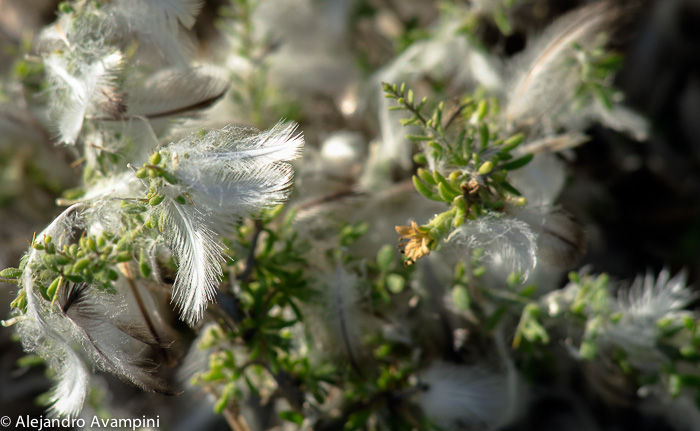
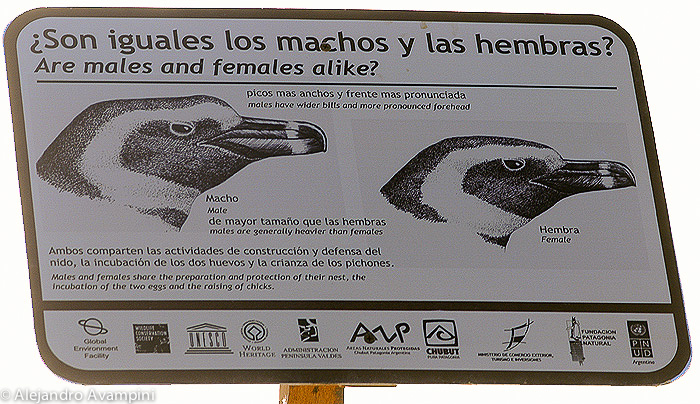 Males are slightly larger than females and have longer and wider beaks. The male weighs about 4 to 5 kg and is 45 cm tall. They reach sexual maturity at 4 or 5 years for both sexes.
Males are slightly larger than females and have longer and wider beaks. The male weighs about 4 to 5 kg and is 45 cm tall. They reach sexual maturity at 4 or 5 years for both sexes.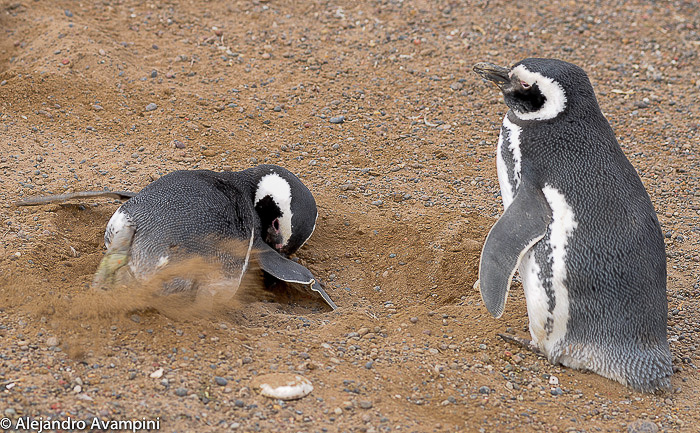 The males will arrive in September to recondition their nests, built in previous years, and await their mate’s arrival several days later. If the nest is not properly conditioned the female might choose to go with another male who is better prepared.
The males will arrive in September to recondition their nests, built in previous years, and await their mate’s arrival several days later. If the nest is not properly conditioned the female might choose to go with another male who is better prepared.  For this reason October has become a month of positioning and fighting in the colonies, often producing severe injuries and even death.
For this reason October has become a month of positioning and fighting in the colonies, often producing severe injuries and even death.
 They will nest as far as 800 meters from the coast and at times, due to natural geographic accidents, their trudge from the coast can be well over a kilometer.
They will nest as far as 800 meters from the coast and at times, due to natural geographic accidents, their trudge from the coast can be well over a kilometer.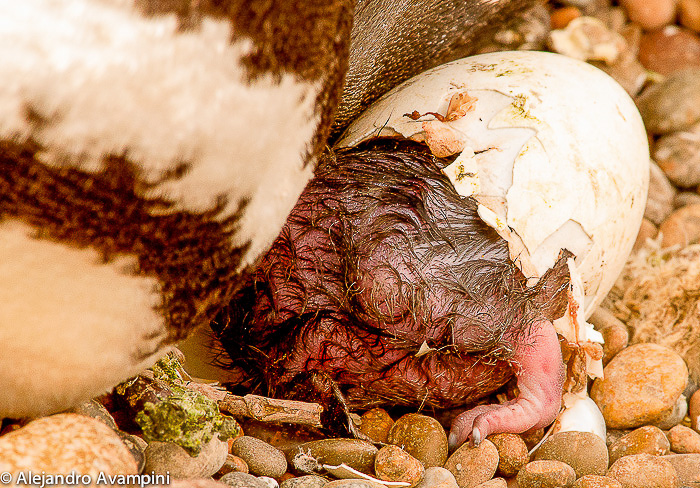 The chicks are born covered with dark gray down, which is lost in February when moving into juvenile plumage. At this time the chicks become independent making their first forays into the sea in search of food. The following year they’ll acquire adult plumage after another moult.
The chicks are born covered with dark gray down, which is lost in February when moving into juvenile plumage. At this time the chicks become independent making their first forays into the sea in search of food. The following year they’ll acquire adult plumage after another moult.
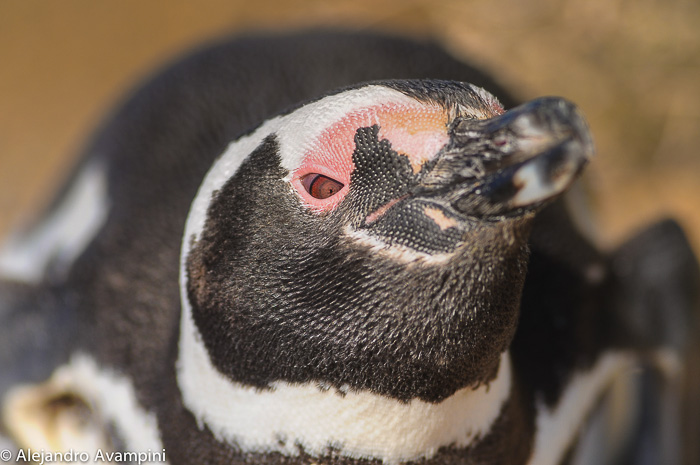 At the present these birds are surviving the collateral environmental damage created by we Humans. Many of the oil patches that litter our oceans are concentrated in the migratory routes these non-flight marine birds travel. They will often be covered by an unbearable film of petroleum while navigating the surface through these spills. Once covered in crude, their feathers are no longer able to insulate, causing the birds to loose heat, look for shelter on the coast and die due to intoxication, exhaustion or starvation. It is extremely important that we raise our consciousness while generating and enforcing strict legislation for the extraction and transportation of petroleum.
At the present these birds are surviving the collateral environmental damage created by we Humans. Many of the oil patches that litter our oceans are concentrated in the migratory routes these non-flight marine birds travel. They will often be covered by an unbearable film of petroleum while navigating the surface through these spills. Once covered in crude, their feathers are no longer able to insulate, causing the birds to loose heat, look for shelter on the coast and die due to intoxication, exhaustion or starvation. It is extremely important that we raise our consciousness while generating and enforcing strict legislation for the extraction and transportation of petroleum.
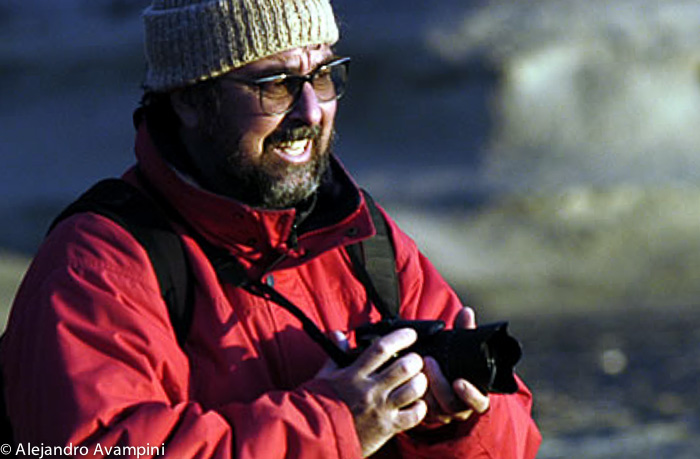 Carlos Passera, one of the first Park Rangers in the province of Chubut, while living with his wife and children in the remote penguin reserve of Punta Tombo in the 1970’s, was converted into a conservationist hero. This was during the illegal de-facto military government, during which one day a representative of the govt. arrived with news that a factory would shortly be built on the coast. Its purpose would be for the slaughter of some 48,000 penguins per year in order to make and sell, amongst other banalities, golfing gloves. It quickly became clear that this govt. representative had no idea with whom he was talking.
Carlos Passera, one of the first Park Rangers in the province of Chubut, while living with his wife and children in the remote penguin reserve of Punta Tombo in the 1970’s, was converted into a conservationist hero. This was during the illegal de-facto military government, during which one day a representative of the govt. arrived with news that a factory would shortly be built on the coast. Its purpose would be for the slaughter of some 48,000 penguins per year in order to make and sell, amongst other banalities, golfing gloves. It quickly became clear that this govt. representative had no idea with whom he was talking. “The battle of the Penguins”, became the name that took root during the defense campaign of these animals and this unique place. The legendary Argentine cartoonist, Fontanarrosa, became involved in the campaign through his famous cartoon character, Inodoro Perera. Carlos, through his communications with the press on the subject of this future atrocity, changed the course of and quite possibly saved one of the largest penguin colonies in the world. Today Punta Tombo represents one of the most important centers of ecotourism in all of Patagonia. All thanks to this hero in the history of Argentine conservationism, Carlos Passera.
“The battle of the Penguins”, became the name that took root during the defense campaign of these animals and this unique place. The legendary Argentine cartoonist, Fontanarrosa, became involved in the campaign through his famous cartoon character, Inodoro Perera. Carlos, through his communications with the press on the subject of this future atrocity, changed the course of and quite possibly saved one of the largest penguin colonies in the world. Today Punta Tombo represents one of the most important centers of ecotourism in all of Patagonia. All thanks to this hero in the history of Argentine conservationism, Carlos Passera.

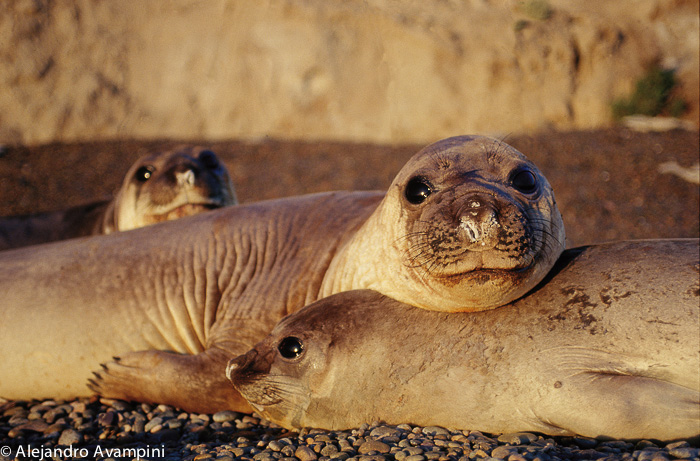 The Southern Elephant Seal is the largest marine mammal to occupy this coastline during its reproductive season. Towards the end of August the first males begin to arrive, marking their territory and gathering their harems with the arrival of the females. The pregnant females are the first to arrive, giving birth just days after. While nursing her pup the female will fast, relying entirely upon her fat reserves. After a short nursing period and mating, the Elephant Seals return to sea for two months of feeding. The adult males of this species reach an unbelievable size. In one of the largest colonies in the Valdes Peninsula, at Punta Delgada, the park administration has set up an informative sign with amazing facts about this animal. Below I have provided some of this information to give an idea of what to expect when arriving at this unique and wonderful corner of Argentine Patagonia.
The Southern Elephant Seal is the largest marine mammal to occupy this coastline during its reproductive season. Towards the end of August the first males begin to arrive, marking their territory and gathering their harems with the arrival of the females. The pregnant females are the first to arrive, giving birth just days after. While nursing her pup the female will fast, relying entirely upon her fat reserves. After a short nursing period and mating, the Elephant Seals return to sea for two months of feeding. The adult males of this species reach an unbelievable size. In one of the largest colonies in the Valdes Peninsula, at Punta Delgada, the park administration has set up an informative sign with amazing facts about this animal. Below I have provided some of this information to give an idea of what to expect when arriving at this unique and wonderful corner of Argentine Patagonia. There are approximately 500 Southern Elephant Seal harems that form along the Valdes Peninsula´s 200 km of coastline consisting of between 2 and 130 females in each harem. The dominant males make up only 14% of the population and can mate as many as 15 times in one day.
There are approximately 500 Southern Elephant Seal harems that form along the Valdes Peninsula´s 200 km of coastline consisting of between 2 and 130 females in each harem. The dominant males make up only 14% of the population and can mate as many as 15 times in one day. Another surprising figure is that 73% of births occur at night and the infant mortality rate is only 4.4%. Males can weigh in at more than 4 thousand kilos, 8 times more than sea lions, and the female weighing as much as 900 kg. Females can lose as much as 13kg per day while nursing and the pup will acquire approximately 4kg per day over the same period. These amazing facts do not end here.
Another surprising figure is that 73% of births occur at night and the infant mortality rate is only 4.4%. Males can weigh in at more than 4 thousand kilos, 8 times more than sea lions, and the female weighing as much as 900 kg. Females can lose as much as 13kg per day while nursing and the pup will acquire approximately 4kg per day over the same period. These amazing facts do not end here.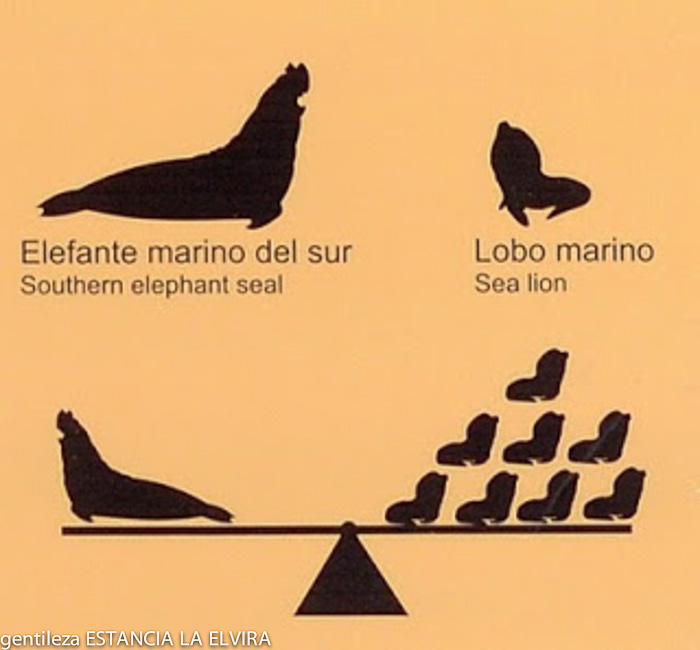 Elephant Seals can make deep, prolonged and continuous free dives, day or night, their ability improving with age, to depths greater than 1,500 meters and they have been tracked covering distances of more than 11,500 kilometers over the course of a year. They will usually spend close to two minutes on the surface between dives, and below the surface they can hold their breath for up to 90 minutes, spending as much as 80% of their time in the water below the surface.
Elephant Seals can make deep, prolonged and continuous free dives, day or night, their ability improving with age, to depths greater than 1,500 meters and they have been tracked covering distances of more than 11,500 kilometers over the course of a year. They will usually spend close to two minutes on the surface between dives, and below the surface they can hold their breath for up to 90 minutes, spending as much as 80% of their time in the water below the surface.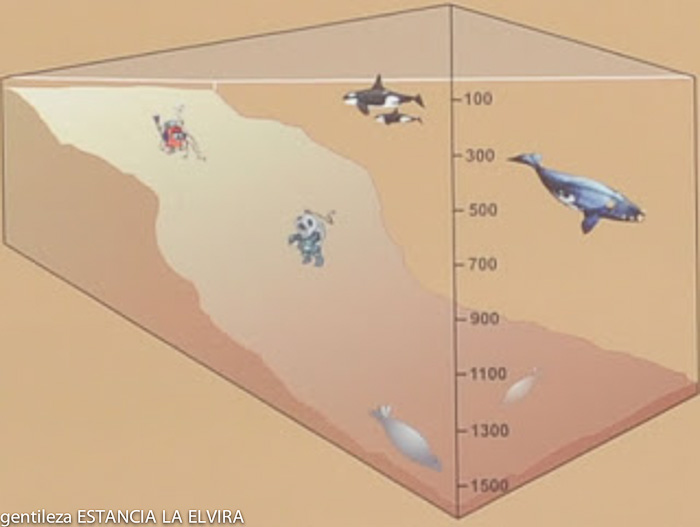 The uncommon dimensions of the Southern Elephant Seal are even more noticeable when compared to any other marine mammal that carries out its reproductive cycle on land. Along the interpretive paths at Caleta Valdes, in the Estancia Elvira, there is an informative sign that compares a male Elephant Seal to a male Sea Lion.The Elephant Seal can weigh in with as much as 8 times that of the Sea Lion at 4,000 kg., amongst other differences. Sea Lions have independent mobility with all four limbs, an external ear structure and an abundant mane around the neck of adult males. Elephant Seals advance by an undulating movement of the belly, without the use of their fins, they have no external ear structure and males do not have a mane.
The uncommon dimensions of the Southern Elephant Seal are even more noticeable when compared to any other marine mammal that carries out its reproductive cycle on land. Along the interpretive paths at Caleta Valdes, in the Estancia Elvira, there is an informative sign that compares a male Elephant Seal to a male Sea Lion.The Elephant Seal can weigh in with as much as 8 times that of the Sea Lion at 4,000 kg., amongst other differences. Sea Lions have independent mobility with all four limbs, an external ear structure and an abundant mane around the neck of adult males. Elephant Seals advance by an undulating movement of the belly, without the use of their fins, they have no external ear structure and males do not have a mane.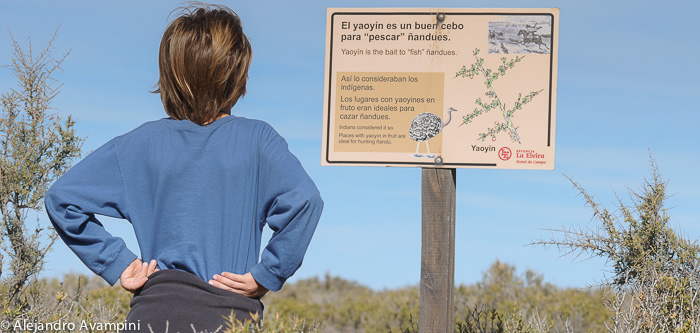 Thanks to the initiative of the Estancia ¨La Elvira¨, owners of the land at the mouth of Caleta Valdes, the interpretive paths created allow the visitor access to information while observing the beach full of wildlife.
Thanks to the initiative of the Estancia ¨La Elvira¨, owners of the land at the mouth of Caleta Valdes, the interpretive paths created allow the visitor access to information while observing the beach full of wildlife.
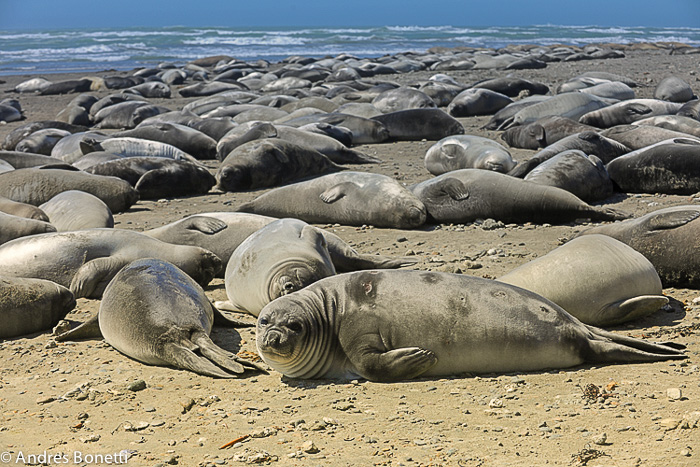 From the beginning of September through the first days of October, Southern Elephant Seals reach the coast of the Valdes Peninsula to give birth and mate, after having spent months in the open ocean. After an effective but not necessarily affectionate encounter with the dominant male of the harem, the female will go through a 12 month gestation period. This species has the characteristic of changing their skin. The molting season begins in November and lasts approximately five months, ending in March. During this period it is common to observe these animals with spots and variations in the color of their skin due to this natural process.
From the beginning of September through the first days of October, Southern Elephant Seals reach the coast of the Valdes Peninsula to give birth and mate, after having spent months in the open ocean. After an effective but not necessarily affectionate encounter with the dominant male of the harem, the female will go through a 12 month gestation period. This species has the characteristic of changing their skin. The molting season begins in November and lasts approximately five months, ending in March. During this period it is common to observe these animals with spots and variations in the color of their skin due to this natural process. Observing the birthing process of these animals on the pebble beaches is an impressive sight that occurs at several different locations along the coast of the Valdes Peninsula. It is not easy to be present at the exact moment, but it is possible. An interesting fact is that only 27% of births occur during the day.
Observing the birthing process of these animals on the pebble beaches is an impressive sight that occurs at several different locations along the coast of the Valdes Peninsula. It is not easy to be present at the exact moment, but it is possible. An interesting fact is that only 27% of births occur during the day.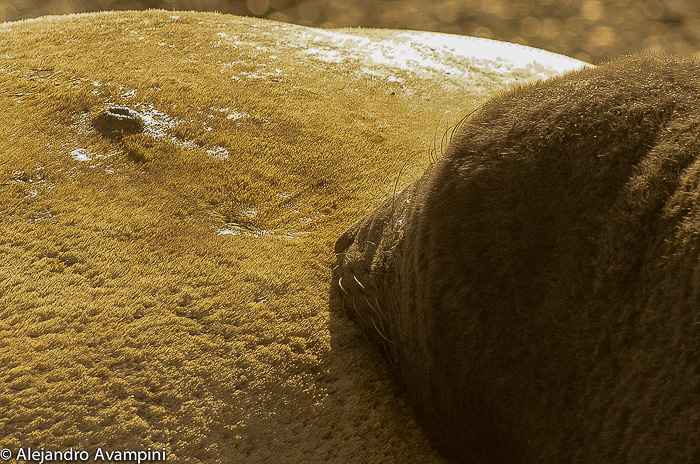 During lactation the mother will not feed and will consume her entire fat reserves. After nursing and mating the Elephant Seals will return to the ocean for two months of feeding. As the days pass and we come to the end of October, the number of individuals will increase, forming a dense colony along the high tide limit in Caleta Valdes, Punta Delgada y Punta Ninfas.
During lactation the mother will not feed and will consume her entire fat reserves. After nursing and mating the Elephant Seals will return to the ocean for two months of feeding. As the days pass and we come to the end of October, the number of individuals will increase, forming a dense colony along the high tide limit in Caleta Valdes, Punta Delgada y Punta Ninfas.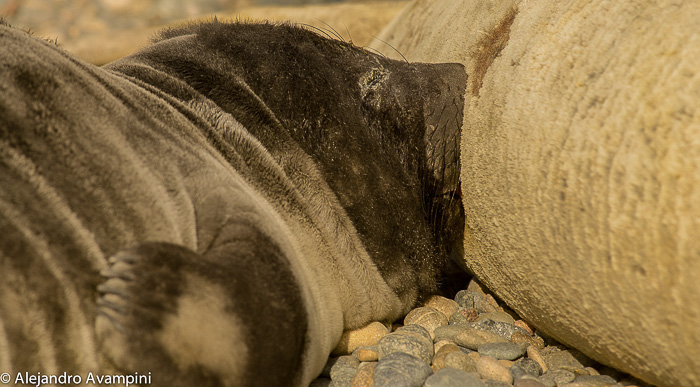 The Elephant Seal Pups, born in the end of September beginning of October in the Elephant Seal colonies of the Valdes Peninsula, have a short nursing period. The pups will suckle the mother´s mammary glands located on either side of her vagina.
The Elephant Seal Pups, born in the end of September beginning of October in the Elephant Seal colonies of the Valdes Peninsula, have a short nursing period. The pups will suckle the mother´s mammary glands located on either side of her vagina.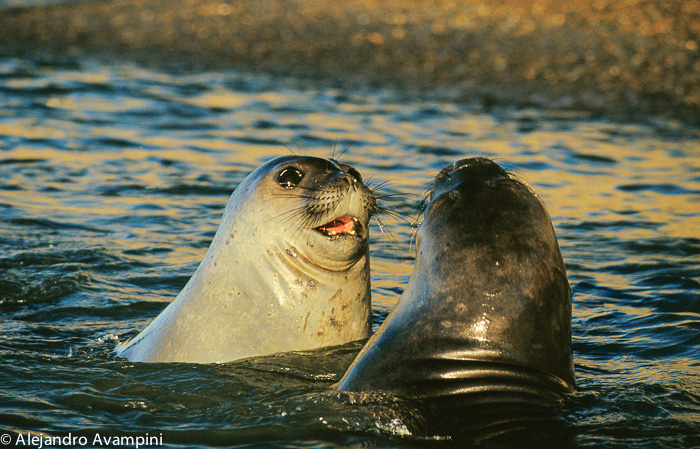 The pups will nurse for approximately three weeks, to then be abandoned by the mother and begin their life entirely independent of their mother´s care. The mother´s milk contains low water content and is extremely rich in fat, allowing the pup to increase its weight by as much as 4kg each day. After weaning, the pup will spend more than a month doing no feeding, surviving on the fat accumulated over the three week lactation period. At an age of just 2 ½ months the young Elephant Seal is prepared to enter the ocean and fend for itself on a diet of octopus, squid and fish.
The pups will nurse for approximately three weeks, to then be abandoned by the mother and begin their life entirely independent of their mother´s care. The mother´s milk contains low water content and is extremely rich in fat, allowing the pup to increase its weight by as much as 4kg each day. After weaning, the pup will spend more than a month doing no feeding, surviving on the fat accumulated over the three week lactation period. At an age of just 2 ½ months the young Elephant Seal is prepared to enter the ocean and fend for itself on a diet of octopus, squid and fish.
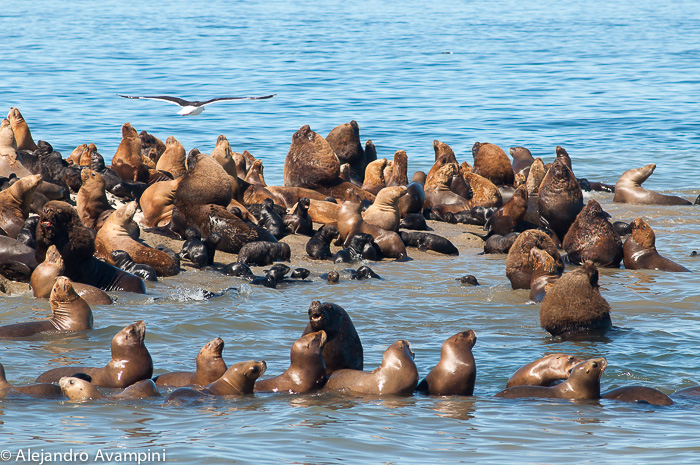 In the animal world, the survival of each species is based directly upon the need for reproduction. With many mammals, as is the case with Sea Lions, the physiological and unconscious need for numerous offspring causes the males to establish large harems, allowing them to mate several times a day over the entire reproductive season.
In the animal world, the survival of each species is based directly upon the need for reproduction. With many mammals, as is the case with Sea Lions, the physiological and unconscious need for numerous offspring causes the males to establish large harems, allowing them to mate several times a day over the entire reproductive season. 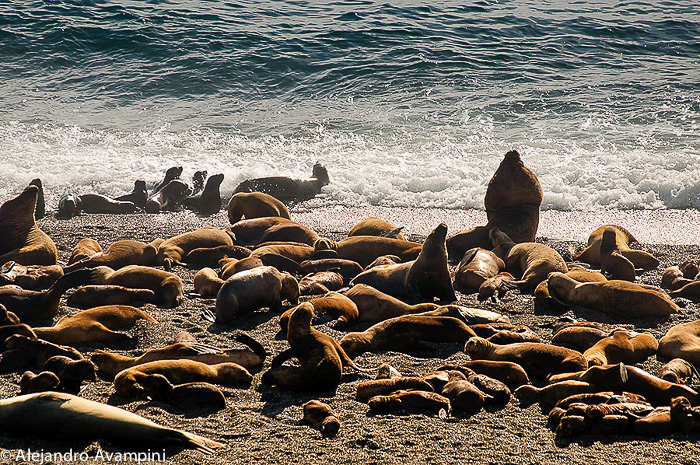 With female Sea Lions the situation is different due to a prolonged gestation period, allowing for the birth of just one pup per year. Due to this slow reproductive cycle their evolutionary process has permitted a relatively long life span, in order for each female to produce as many pups as possible over her extended fertile period.
With female Sea Lions the situation is different due to a prolonged gestation period, allowing for the birth of just one pup per year. Due to this slow reproductive cycle their evolutionary process has permitted a relatively long life span, in order for each female to produce as many pups as possible over her extended fertile period. 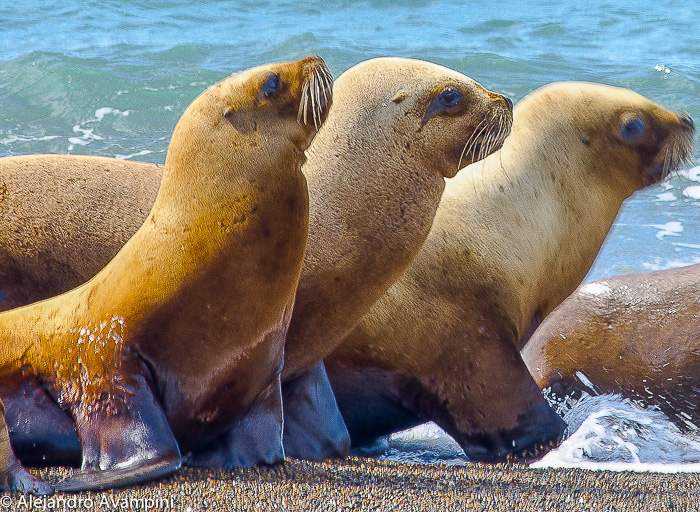 Female Sea Lions enter into their reproductive maturity at the age of 4. From the end of February through the end of March females will go into ¨heat¨. Over this month of reproductive activity the males will fight to establish their harem. After a 10 month gestation period the female gives birth to a single pup and incredibly, just a few days after the birthing process, she will once again become pregnant.
Female Sea Lions enter into their reproductive maturity at the age of 4. From the end of February through the end of March females will go into ¨heat¨. Over this month of reproductive activity the males will fight to establish their harem. After a 10 month gestation period the female gives birth to a single pup and incredibly, just a few days after the birthing process, she will once again become pregnant.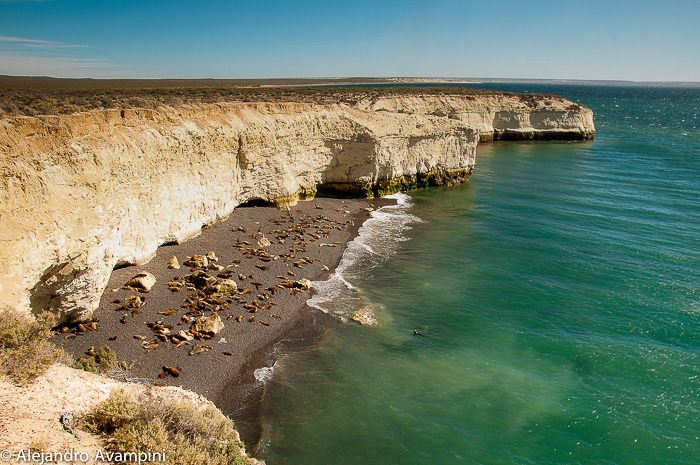 The gestation and birthing cycle is repeated year after year over the stretch of her entire life, affirming the fact that she will live in almost constant state of pregnancy. During the summer season at Punta Piramide it is not just an expansive maternity scene but more so one of the largest reproductive Sea Lion colonies in the Valdes Peninsula. The density of Sea Lions here is obvious, where as many as 3,000 individuals can be observed each season.
The gestation and birthing cycle is repeated year after year over the stretch of her entire life, affirming the fact that she will live in almost constant state of pregnancy. During the summer season at Punta Piramide it is not just an expansive maternity scene but more so one of the largest reproductive Sea Lion colonies in the Valdes Peninsula. The density of Sea Lions here is obvious, where as many as 3,000 individuals can be observed each season.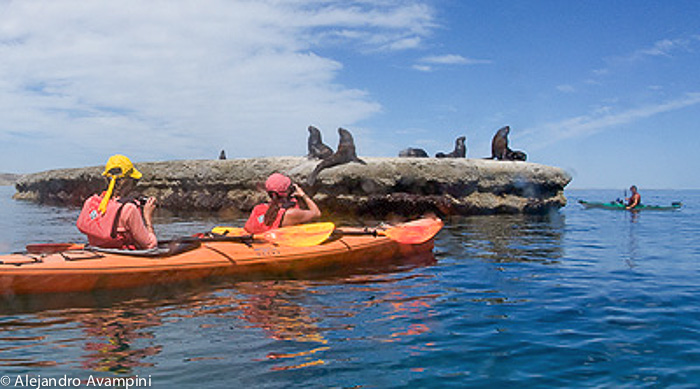
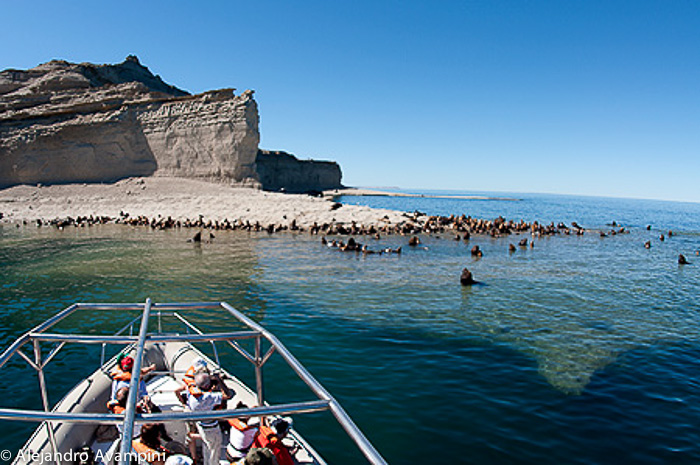
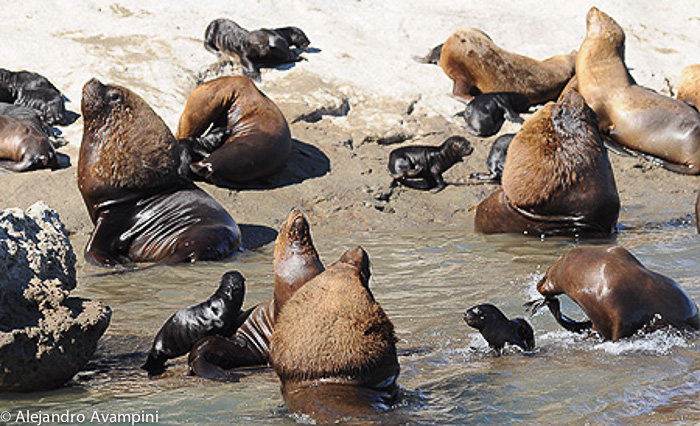 The One Haired Sea Lion´s life cycle varies with the changing seasons. In December the males will prepare their harems anywhere from 2 to 12 females in the reproductive colonies. From January through February the pups are born, just one pup per female, and in a matter of just a few days she will once again go into ¨heat¨. The pups will continue to nurse from birth through May and during this time, most will return to their habitual, non reproductive, colonies at Punta Alt, Punta Loma, Punta Ameghino, Las Charas, amongst the many colonies in Golfo Nuevo.
The One Haired Sea Lion´s life cycle varies with the changing seasons. In December the males will prepare their harems anywhere from 2 to 12 females in the reproductive colonies. From January through February the pups are born, just one pup per female, and in a matter of just a few days she will once again go into ¨heat¨. The pups will continue to nurse from birth through May and during this time, most will return to their habitual, non reproductive, colonies at Punta Alt, Punta Loma, Punta Ameghino, Las Charas, amongst the many colonies in Golfo Nuevo.
 An adult male can weigh as much as 300 kilograms, the female around 100kg and the pup, in the order of 12kg. The males measures as long as 2.3 meters, the female 1.8 meters and a pup reaching 80cm.
An adult male can weigh as much as 300 kilograms, the female around 100kg and the pup, in the order of 12kg. The males measures as long as 2.3 meters, the female 1.8 meters and a pup reaching 80cm. Their weight is relatively little when compared to the Elephant Seal, with a male weighing as much as 8 times more than an adult sea lion and being more than twice as long. The life span of a Sea Lion oscillates between approximately 15 and 18 years.
Their weight is relatively little when compared to the Elephant Seal, with a male weighing as much as 8 times more than an adult sea lion and being more than twice as long. The life span of a Sea Lion oscillates between approximately 15 and 18 years.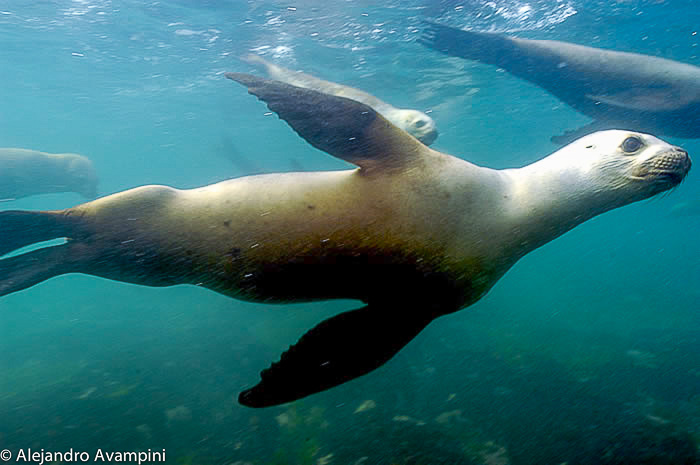 Sea Lions feed primarily on fish, octopus and squid. The adult male has a large neck and head covered with a mane and is darker in color.
Sea Lions feed primarily on fish, octopus and squid. The adult male has a large neck and head covered with a mane and is darker in color.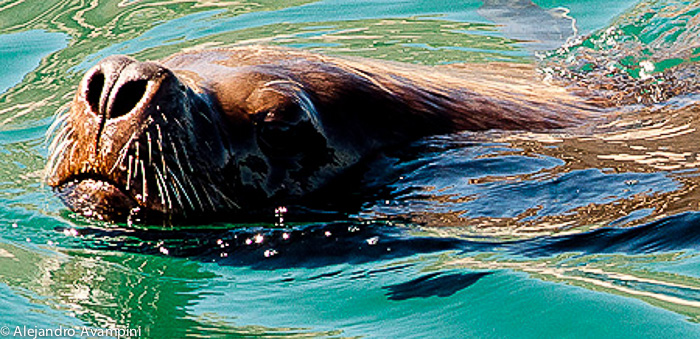
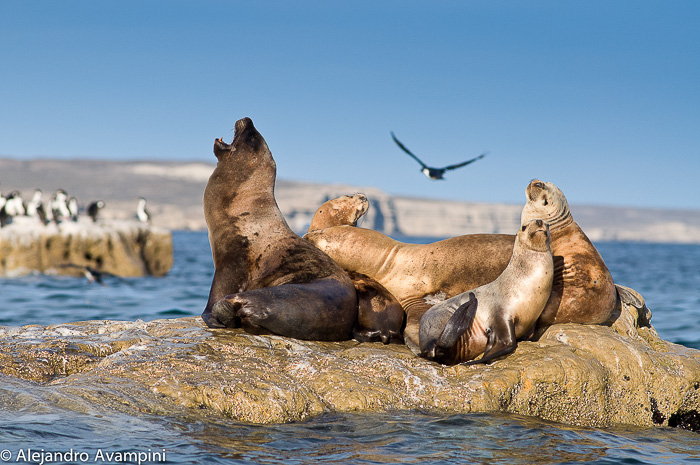
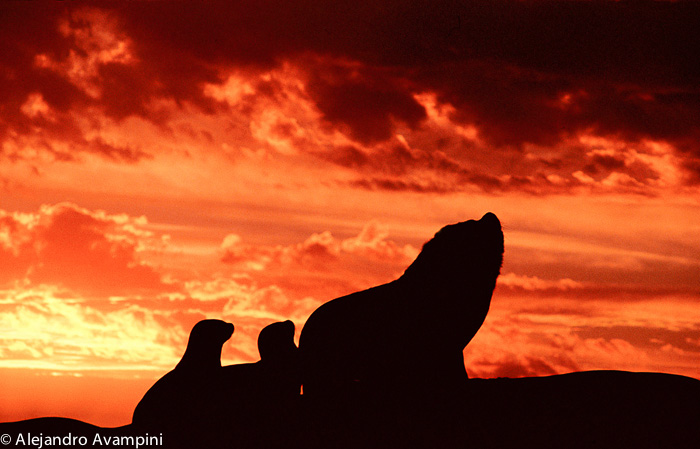
 Orca season is the most difficult proposal that the Valdes Peninsula can offer to the visitor. As opposed to the whale watching season, where an encounter with the right whale is guaranteed and it is common to observe more than 10 to 15 whales on a single tour, as they float close to the authorized whale watching boats. Whit orcas nothing happens like.The high density of whales that visit the Valdes Peninsula per square kilometer during the months of June through December is increasing at a rate of approximately 7% annually. To get an Idea of their numbers, the aerial census from last season counted more than 2.000 individuals. All joking aside, that is a ton of whales!
Orca season is the most difficult proposal that the Valdes Peninsula can offer to the visitor. As opposed to the whale watching season, where an encounter with the right whale is guaranteed and it is common to observe more than 10 to 15 whales on a single tour, as they float close to the authorized whale watching boats. Whit orcas nothing happens like.The high density of whales that visit the Valdes Peninsula per square kilometer during the months of June through December is increasing at a rate of approximately 7% annually. To get an Idea of their numbers, the aerial census from last season counted more than 2.000 individuals. All joking aside, that is a ton of whales!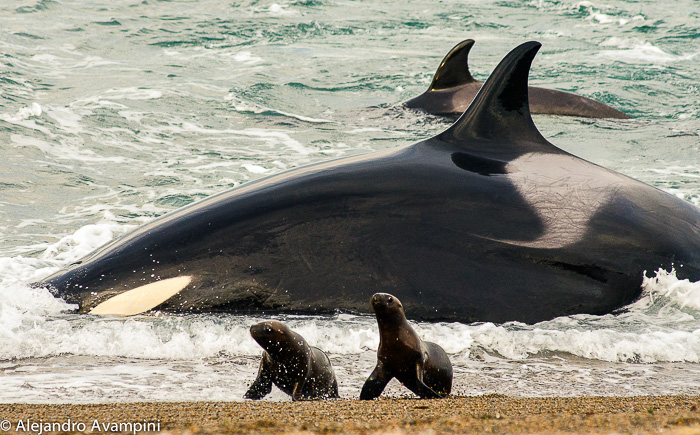 In contrast, the Orcas, also known as killer whale, are permanent residents in the Valdes Peninsula and do not migrate thousands of kilometers like the Right Whales. They constitute only about 30 individuals and they usually can be seen in Punta Norte from early March through April. It is a very short season, in terms of tourism, with the peak of this season only lasting some 10 to 15 days. There are orca excursions and trips to Punta Norte.
In contrast, the Orcas, also known as killer whale, are permanent residents in the Valdes Peninsula and do not migrate thousands of kilometers like the Right Whales. They constitute only about 30 individuals and they usually can be seen in Punta Norte from early March through April. It is a very short season, in terms of tourism, with the peak of this season only lasting some 10 to 15 days. There are orca excursions and trips to Punta Norte.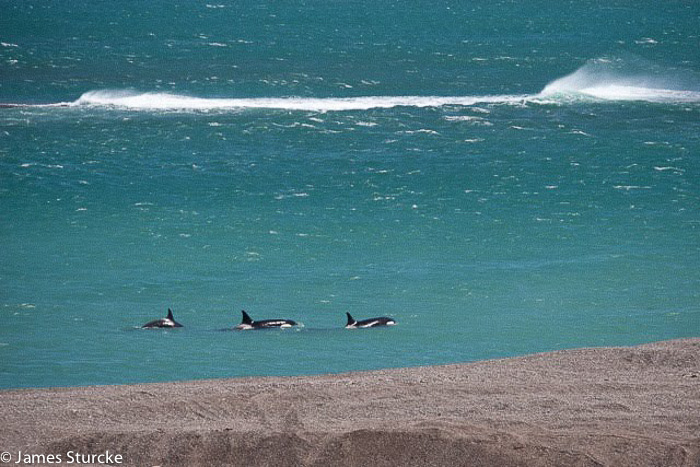 The northern most corner of the Valdes Peninsula offers very interesting characteristics during this time of year. The different family pods of local Orcas add to their normal daily diet of approximately 80 Kg. of Sand Perch, Octopus and other marine creatures, young Sea Lion calves that were born just a couple of months earlier along the coast of Punta Norte. A Sea Lion Calf, to the Orcas, represents about 20 Kg. of delicious, tender meat. It is nothing personal, but a taste for this variety causes some of the Orcas to intentionally beach themselves, risking their lives with the objective of capturing this tender resource, rich in calories and proteins, to feed its pod. This extremely particular event, unique in the world, brings more and more tourists and wildlife fanatics each year.
The northern most corner of the Valdes Peninsula offers very interesting characteristics during this time of year. The different family pods of local Orcas add to their normal daily diet of approximately 80 Kg. of Sand Perch, Octopus and other marine creatures, young Sea Lion calves that were born just a couple of months earlier along the coast of Punta Norte. A Sea Lion Calf, to the Orcas, represents about 20 Kg. of delicious, tender meat. It is nothing personal, but a taste for this variety causes some of the Orcas to intentionally beach themselves, risking their lives with the objective of capturing this tender resource, rich in calories and proteins, to feed its pod. This extremely particular event, unique in the world, brings more and more tourists and wildlife fanatics each year.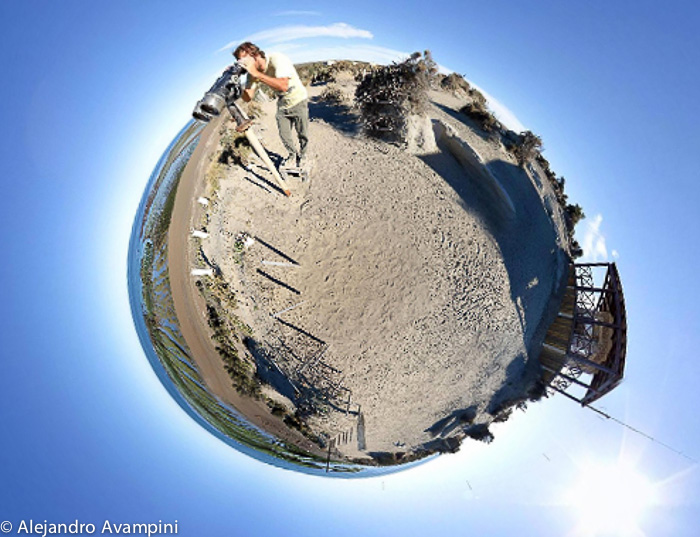 In this self-portrait 360 degrees, I´m looking through binoculars binoculars in Punta Norte the shape of the levees that owns the beach all the way, creating different channels between the open sea and sea lions, where orcas have their point of care.Hours later, when the rising tide begins to reach the young sea lions, the Orcas will find an appropriate “path” in order to make the capture and not remain stuck, beached on dry land in the process. To view a large image of this, press the button above that reads “full screen”, after having pressed “play”.
In this self-portrait 360 degrees, I´m looking through binoculars binoculars in Punta Norte the shape of the levees that owns the beach all the way, creating different channels between the open sea and sea lions, where orcas have their point of care.Hours later, when the rising tide begins to reach the young sea lions, the Orcas will find an appropriate “path” in order to make the capture and not remain stuck, beached on dry land in the process. To view a large image of this, press the button above that reads “full screen”, after having pressed “play”.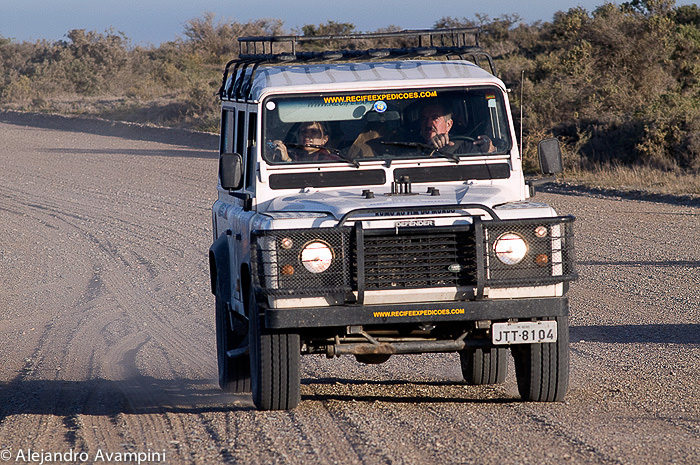
 Here I have provided a link of
Here I have provided a link of  The observation platform at Punta Norte is the central gathering point for tourists, visitors and photographers alike. Each year the numbers of those interested in observing Orcas in their natural habitat and the chance to see their interaction with sea lions increases, and the observation platform at Punta Norte is their point of convergence. Nature establishes the time frame for possible observation of these amazing animals, but it is good to keep in mind, be present from two hours before until two hours after high tide.
The observation platform at Punta Norte is the central gathering point for tourists, visitors and photographers alike. Each year the numbers of those interested in observing Orcas in their natural habitat and the chance to see their interaction with sea lions increases, and the observation platform at Punta Norte is their point of convergence. Nature establishes the time frame for possible observation of these amazing animals, but it is good to keep in mind, be present from two hours before until two hours after high tide.  Access to the beach itself is prohibited so as not to alter the animal’s natural behavior, but an established trail a bit higher up, works like a natural observation platform, offering a spectacular view of the different sea lion colonies. The reserve at Punta Norte has a small café and kiosk as well as comfortable public restrooms and parking area.
Access to the beach itself is prohibited so as not to alter the animal’s natural behavior, but an established trail a bit higher up, works like a natural observation platform, offering a spectacular view of the different sea lion colonies. The reserve at Punta Norte has a small café and kiosk as well as comfortable public restrooms and parking area. Since the disappearance of Mel, a unique male last seen a few years ago, Orca season has not been the same. Mel was the iconic figure of the maximum marine predator, an excellent hunter in Punta Norte, with his size, power, courage and affectivity he was believed to be approximately 51 years old and has ceased to appear. For decades Mel was the most famous protagonist in the documentaries produced by National Geographic, BBC and the other wildlife channels. His absence is hard to digest for many of us who consider this Orca to be a part of our lives. Every season we have expected his presence in the primary attack channel in Punta Norte, an animal that rose above all others in the technique of intentional beaching.
Since the disappearance of Mel, a unique male last seen a few years ago, Orca season has not been the same. Mel was the iconic figure of the maximum marine predator, an excellent hunter in Punta Norte, with his size, power, courage and affectivity he was believed to be approximately 51 years old and has ceased to appear. For decades Mel was the most famous protagonist in the documentaries produced by National Geographic, BBC and the other wildlife channels. His absence is hard to digest for many of us who consider this Orca to be a part of our lives. Every season we have expected his presence in the primary attack channel in Punta Norte, an animal that rose above all others in the technique of intentional beaching.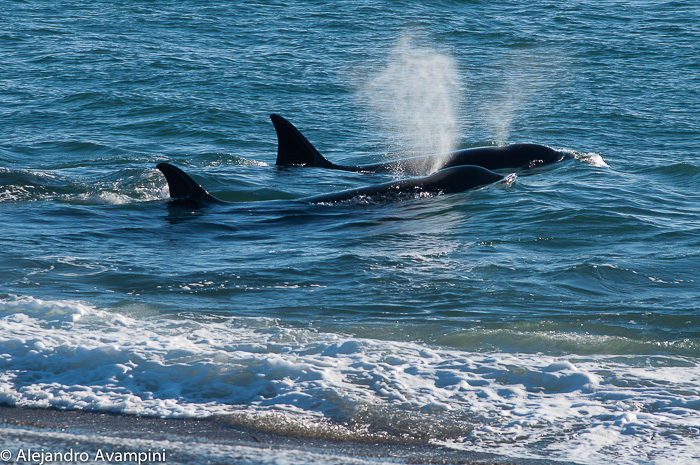 In exception to one juvenile that reappeared two seasons back and 2 other males, there are only 5 females that understand and apply the technique of intentional beaching. These females are much smaller than the adult males and in the moment of capturing the young sea lions, much more delicate. These five females are, as well, the ones in charge of teaching this unusual technique to each new generation.
In exception to one juvenile that reappeared two seasons back and 2 other males, there are only 5 females that understand and apply the technique of intentional beaching. These females are much smaller than the adult males and in the moment of capturing the young sea lions, much more delicate. These five females are, as well, the ones in charge of teaching this unusual technique to each new generation.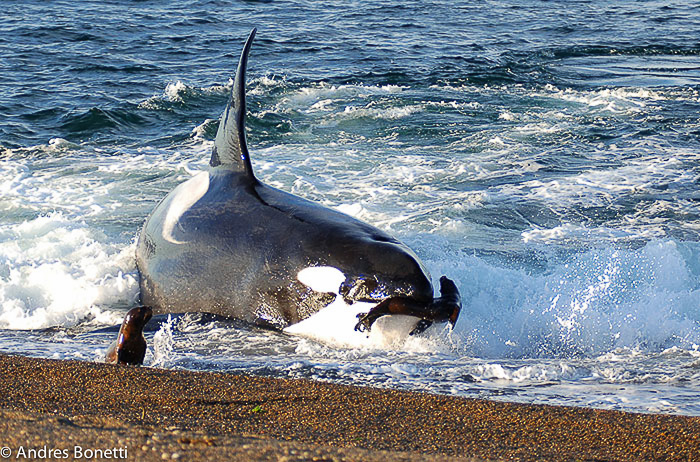 The shear mass of Mel was beyond impressive, his body rising above the height of the crashing waves. With a girth of more than two meters combined with a crooked dorsal fin of more than 1.8mt, in a matter of seconds he would break the surface, throwing his entire mass of several tons upon the beach, capturing his prey and then twisting his over 9mt body to return to the sea.
The shear mass of Mel was beyond impressive, his body rising above the height of the crashing waves. With a girth of more than two meters combined with a crooked dorsal fin of more than 1.8mt, in a matter of seconds he would break the surface, throwing his entire mass of several tons upon the beach, capturing his prey and then twisting his over 9mt body to return to the sea.
 Juan Carlos Lopez began his work as a Park Ranger in Punta Norte in 1975. Having spent so much time in this natural setting he took advantage of the Orca’s approaches and began the first known studies on the behavior of these amazing animals in the Valdes Peninsula. Very little was known about them, primarily due to the lack of permanent systematic observation. Characterized for is discipline, Juan Carlos was able to maintain these observations over a 13 year period while carrying out his obligations as Park Ranger in this nature reserve, resulting in an amazing file of information about the Orcas and their complex family interactions. For more understanding into this work he has written an insightful book called; Orcas, Between Myth and Reality. Below is a file from a documentary film made by the Adventure of man and dedicated to the Orcas, where an interview can be seen with Juan Carlos during his time as a Park Ranger in Punta Norte.
Juan Carlos Lopez began his work as a Park Ranger in Punta Norte in 1975. Having spent so much time in this natural setting he took advantage of the Orca’s approaches and began the first known studies on the behavior of these amazing animals in the Valdes Peninsula. Very little was known about them, primarily due to the lack of permanent systematic observation. Characterized for is discipline, Juan Carlos was able to maintain these observations over a 13 year period while carrying out his obligations as Park Ranger in this nature reserve, resulting in an amazing file of information about the Orcas and their complex family interactions. For more understanding into this work he has written an insightful book called; Orcas, Between Myth and Reality. Below is a file from a documentary film made by the Adventure of man and dedicated to the Orcas, where an interview can be seen with Juan Carlos during his time as a Park Ranger in Punta Norte.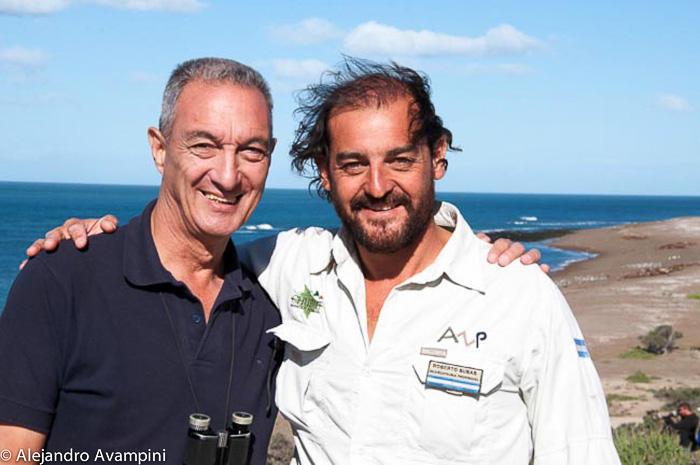 Roberto Bubas, a personal friend and obvious guest at Del Nomade Eco Hotel, is a great nature explorer. Gifted with a unique connection to the world around him, he has written several self-help books. He has also dedicated and continues to dedicate a large part of his time to analyzing his personal experiences with the Orcas and the world of the Orcas in general. An enthusiastic and colorful Character from Chubut, Roberto gives conferences around the world. His daily goal centers on showing how human nature and animal are united in the beautiful natural theatre that is our universe.
Roberto Bubas, a personal friend and obvious guest at Del Nomade Eco Hotel, is a great nature explorer. Gifted with a unique connection to the world around him, he has written several self-help books. He has also dedicated and continues to dedicate a large part of his time to analyzing his personal experiences with the Orcas and the world of the Orcas in general. An enthusiastic and colorful Character from Chubut, Roberto gives conferences around the world. His daily goal centers on showing how human nature and animal are united in the beautiful natural theatre that is our universe.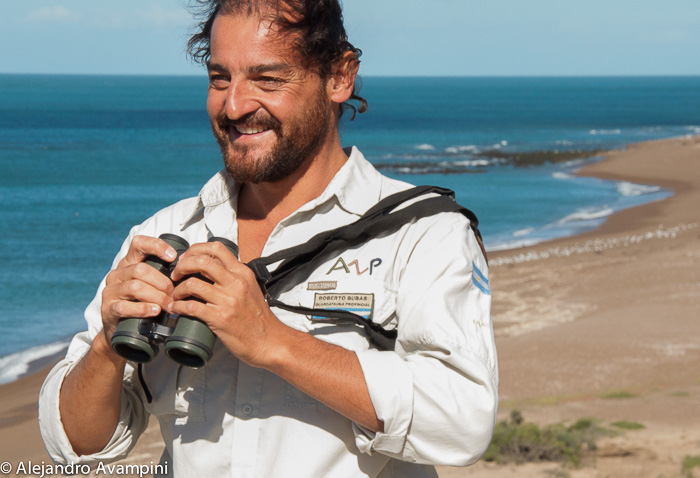 With his harmonica, time and a contemplative spirit, he spent more than a decade as Park Ranger in Caleta Valdes and Punta Norte and established a before unseen affinity with these awe inspiring marine mammals. His relationship with the Orcas of Valdes Peninsula caused conflicts of opinion in the scientific community and awakened a strong sense of admiration amongst those of us who revere nature.
With his harmonica, time and a contemplative spirit, he spent more than a decade as Park Ranger in Caleta Valdes and Punta Norte and established a before unseen affinity with these awe inspiring marine mammals. His relationship with the Orcas of Valdes Peninsula caused conflicts of opinion in the scientific community and awakened a strong sense of admiration amongst those of us who revere nature. Here is a Discovery Channel interview with Roberto Bubas:
Here is a Discovery Channel interview with Roberto Bubas: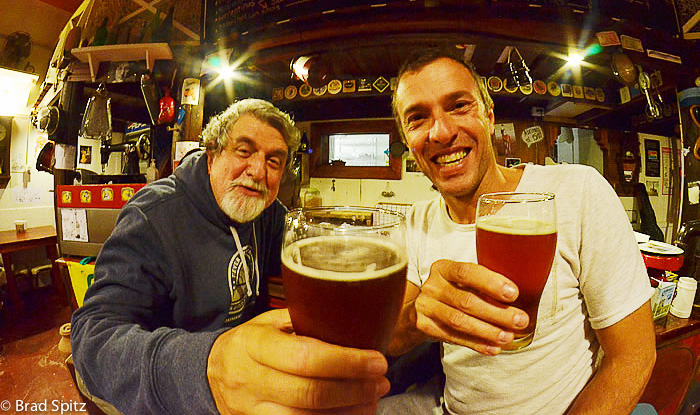 Towards the end of the 2012 Orca Season, after all the documentary film crews had left Valdes Peninsula with little to show for their time and effort and while we were closing the season at Del Nomade Eco Hotel, Murillo arrived with an incredible enthusiasm, characteristic of the Brazilian’s “all is well” attitude. Nobody could have imagined that in the days to follow, well past the peak of Orca Season and its best statistics, someone could document what this privileged nature photographer was able to capture. The first registered attack of a new male! A fantastic story of Murillos good fortune.
Towards the end of the 2012 Orca Season, after all the documentary film crews had left Valdes Peninsula with little to show for their time and effort and while we were closing the season at Del Nomade Eco Hotel, Murillo arrived with an incredible enthusiasm, characteristic of the Brazilian’s “all is well” attitude. Nobody could have imagined that in the days to follow, well past the peak of Orca Season and its best statistics, someone could document what this privileged nature photographer was able to capture. The first registered attack of a new male! A fantastic story of Murillos good fortune. An Orca that we began to can Jaluel, new in his appearance as an adult male but born into the family of Orcas of Valdes Peninsula, is now more than 15 years old and more than respectable in size. His rising dorsal fin differentiates him from females and juveniles, and combined with his youth and strength has generated great expectations in the world of Orcas. Jaluel is earning his role as protagonist in the breaking waves. Murillo Lins has updated his web page for the contemplation of his excellent esthetic and documentary work with the orcas and other South American wildlife. This video shows the first attack of Jaluel, made along the coast of the Estancia “La Ernestina”, Punta Norte,Valdes Peninsula, one year after Murillo’s photos along the South Bay of Punta Norte.
An Orca that we began to can Jaluel, new in his appearance as an adult male but born into the family of Orcas of Valdes Peninsula, is now more than 15 years old and more than respectable in size. His rising dorsal fin differentiates him from females and juveniles, and combined with his youth and strength has generated great expectations in the world of Orcas. Jaluel is earning his role as protagonist in the breaking waves. Murillo Lins has updated his web page for the contemplation of his excellent esthetic and documentary work with the orcas and other South American wildlife. This video shows the first attack of Jaluel, made along the coast of the Estancia “La Ernestina”, Punta Norte,Valdes Peninsula, one year after Murillo’s photos along the South Bay of Punta Norte.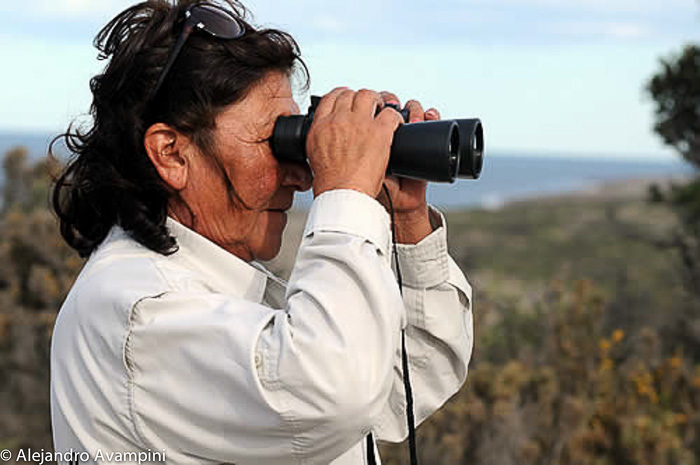 Try to imagine an isolated corner of the world where, even in our modern age, there is no telephone signal and the only possible human communication is made on a VHF radio. It is here, amongst these conditions that an adorable Patagonian character, Isabel Peinecura, carries out her duties as Park Ranger in Punta Norte. Her humble beginnings in no way held her back from the dream of many nature lovers. Isabel was born in a small establishment, visible on only a few regional maps and close to the tiny town of Ramos Mexia in the bordering province of Rio Negro. As we talk she begins to remember her infancy and after sharing stories of her tough upbringing she sums it all up with the statement, “Well…what can you do, I grew up rolling with the punches”.
Try to imagine an isolated corner of the world where, even in our modern age, there is no telephone signal and the only possible human communication is made on a VHF radio. It is here, amongst these conditions that an adorable Patagonian character, Isabel Peinecura, carries out her duties as Park Ranger in Punta Norte. Her humble beginnings in no way held her back from the dream of many nature lovers. Isabel was born in a small establishment, visible on only a few regional maps and close to the tiny town of Ramos Mexia in the bordering province of Rio Negro. As we talk she begins to remember her infancy and after sharing stories of her tough upbringing she sums it all up with the statement, “Well…what can you do, I grew up rolling with the punches”. One day back in 1982, Isabel and her husband received a job offer in the Estancia “La Adela”, owned by the Ferro family here in the Valdes Peninsula. This was an offer that Isabel and her husband quickly took advantage of as a way out of the isolated and inhospitable area where they were living. They moved to the Valdes Peninsula together with their children, and ten years later were offered educational jobs with the Park Rangers.
One day back in 1982, Isabel and her husband received a job offer in the Estancia “La Adela”, owned by the Ferro family here in the Valdes Peninsula. This was an offer that Isabel and her husband quickly took advantage of as a way out of the isolated and inhospitable area where they were living. They moved to the Valdes Peninsula together with their children, and ten years later were offered educational jobs with the Park Rangers.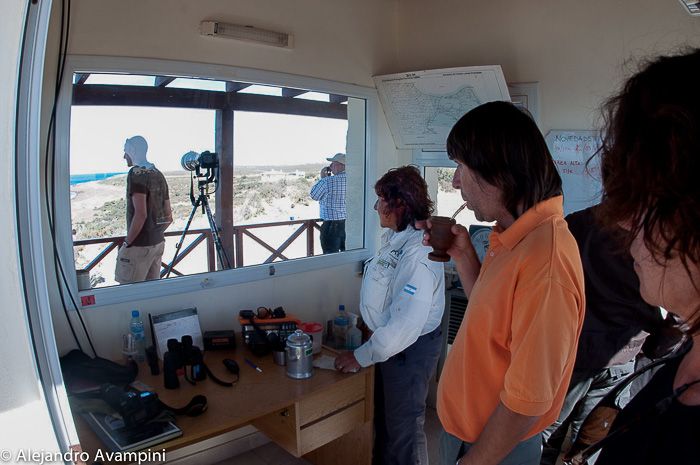 Over the course of many years they worked in the visitor’s center at the Ameghino isthmus until being offered the job of Park Ranger in 2001, a job that Isabel has taken on with great responsibility. Her job is to inform visitors and tourists about the flora and fauna of the area and at the same time, maintain order and protect this fragile piece of Patagonia, Argentina.And when there are no tourists or visitors, Isabel remains present, in direct contact with nature, living in a state of fusion amongst all this immensity, full of infinite sunsets, sea and stars, until once again February reminds us of the approaching Orca Season.
Over the course of many years they worked in the visitor’s center at the Ameghino isthmus until being offered the job of Park Ranger in 2001, a job that Isabel has taken on with great responsibility. Her job is to inform visitors and tourists about the flora and fauna of the area and at the same time, maintain order and protect this fragile piece of Patagonia, Argentina.And when there are no tourists or visitors, Isabel remains present, in direct contact with nature, living in a state of fusion amongst all this immensity, full of infinite sunsets, sea and stars, until once again February reminds us of the approaching Orca Season.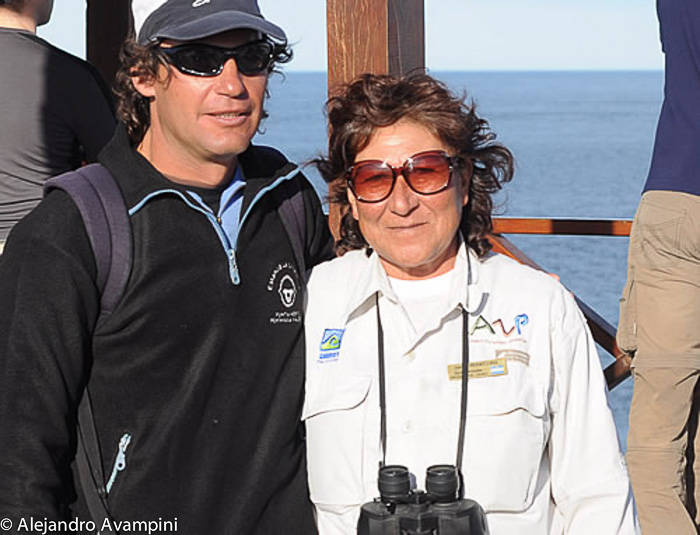 The neighbors of Punta Norte, although their presence is several kilometers away, allow some sense of security and a feeling of not being quite so alone. This is the case with Juan Copelo, owner of the Estancia La Ernestina and its surrounding territory bordering the Punta Norte nature reserve. Juan is very involved with the observation of Orcas along the coast of his land and actively participates with the Punta Norte Orcas Research Foundation.
The neighbors of Punta Norte, although their presence is several kilometers away, allow some sense of security and a feeling of not being quite so alone. This is the case with Juan Copelo, owner of the Estancia La Ernestina and its surrounding territory bordering the Punta Norte nature reserve. Juan is very involved with the observation of Orcas along the coast of his land and actively participates with the Punta Norte Orcas Research Foundation.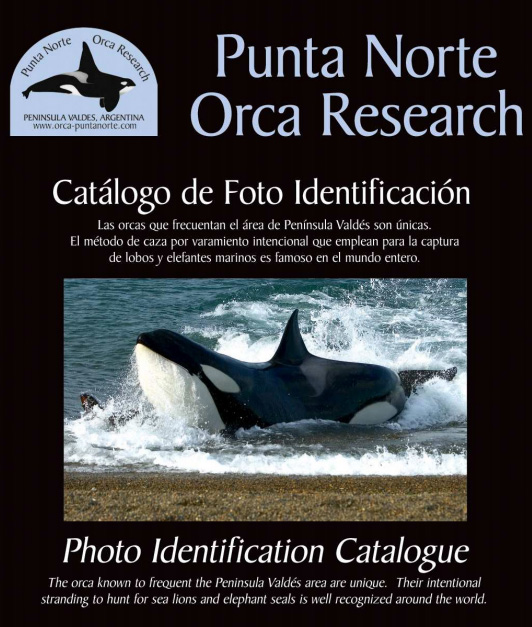 Hector ¨El Turco¨ Casin is, without exception, the most experienced of the Park Rangers of Chubut. For the last 23 years he has worked accompanying scientists, documentary film crews and nature photographers, all of whom will confirm his excellence.
Hector ¨El Turco¨ Casin is, without exception, the most experienced of the Park Rangers of Chubut. For the last 23 years he has worked accompanying scientists, documentary film crews and nature photographers, all of whom will confirm his excellence.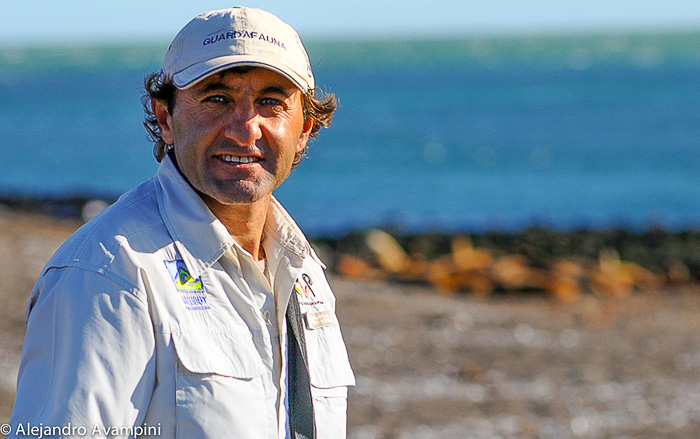 Hector has worked with all of the major Wildlife and Nature production teams that have been attracted to this natural paradise. National Geographic, Discovery Channel, BBC and Animal Planet, to name a few of the most recognized, as well as other production teams from France, Italy, Germany, Japan (TBS and NHK) and many others who have come to Chubut and the Valdes Peninsula to document its unique wildlife. Due to advances in technology and upgrades in equipment and quality, most of these production crews repeat their logistics in the Valdes Peninsula every couple of years, returning not just once, but several times!
Hector has worked with all of the major Wildlife and Nature production teams that have been attracted to this natural paradise. National Geographic, Discovery Channel, BBC and Animal Planet, to name a few of the most recognized, as well as other production teams from France, Italy, Germany, Japan (TBS and NHK) and many others who have come to Chubut and the Valdes Peninsula to document its unique wildlife. Due to advances in technology and upgrades in equipment and quality, most of these production crews repeat their logistics in the Valdes Peninsula every couple of years, returning not just once, but several times!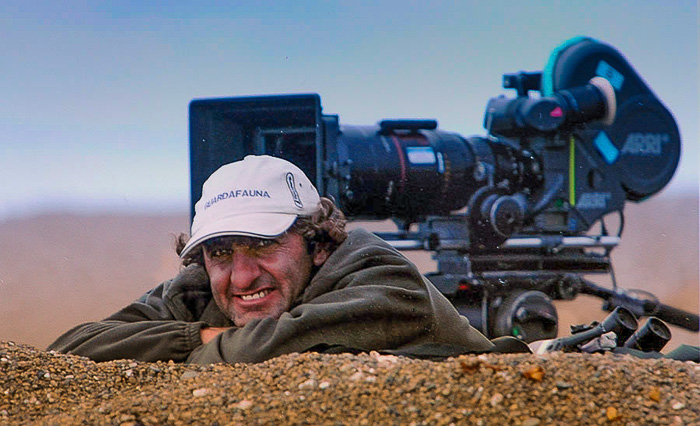

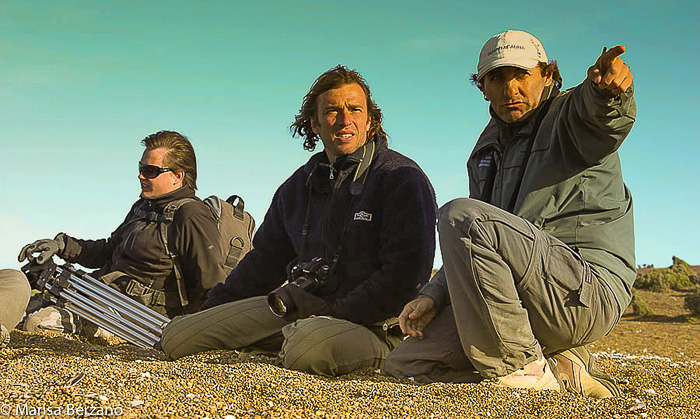
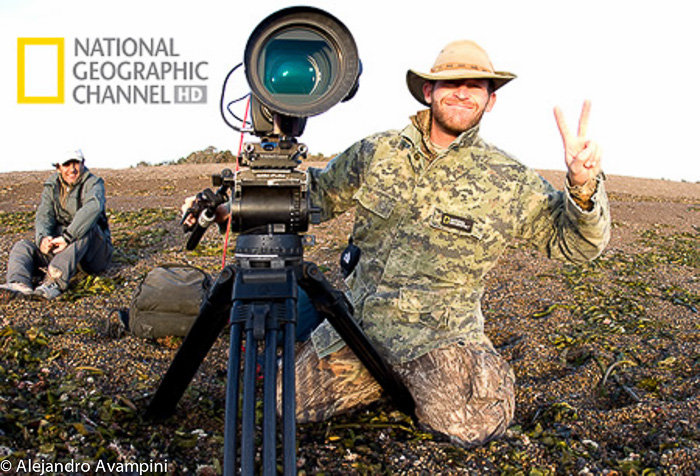 Andy Casagrande, the cameraman who appears here in the photos, was working with this team and using a Phantom camera, which allowed him to capture up to 1000 frames per second and producing a slow motion sequence with details that had never before been seen. The Orca attack that he captured lasted 6.2 seconds and became immortalized in slow motion as an amazing and uncommon natural phenomenon. Film crews arrive each new season, in a race to produce new documentaries with the latest upgrades in technology, and always with the challenge of capturing new images of this isolated corner of Argentine Patagonia.
Andy Casagrande, the cameraman who appears here in the photos, was working with this team and using a Phantom camera, which allowed him to capture up to 1000 frames per second and producing a slow motion sequence with details that had never before been seen. The Orca attack that he captured lasted 6.2 seconds and became immortalized in slow motion as an amazing and uncommon natural phenomenon. Film crews arrive each new season, in a race to produce new documentaries with the latest upgrades in technology, and always with the challenge of capturing new images of this isolated corner of Argentine Patagonia.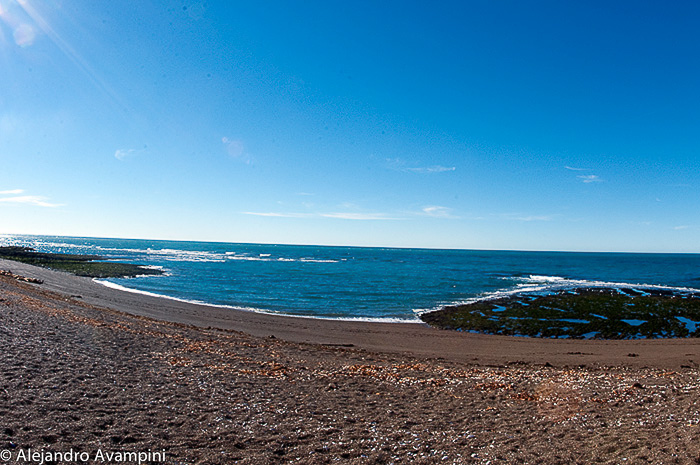 An 800 meter hike along a small trail through Patagonia shrub and under the constant vigil of Sea Lions, leaves you at the attack channel. This channel is protected on either side by two long rock reefs and a steep cobblestone beach creating perfect access. The attack channel at Punta Norte owes its name to the morphology of this particular beach. In this quite sector of the Valdes Peninsula, low tide exposes in detail the formations of the channel, one of the most captivating wildlife landscapes in the entire world.
An 800 meter hike along a small trail through Patagonia shrub and under the constant vigil of Sea Lions, leaves you at the attack channel. This channel is protected on either side by two long rock reefs and a steep cobblestone beach creating perfect access. The attack channel at Punta Norte owes its name to the morphology of this particular beach. In this quite sector of the Valdes Peninsula, low tide exposes in detail the formations of the channel, one of the most captivating wildlife landscapes in the entire world.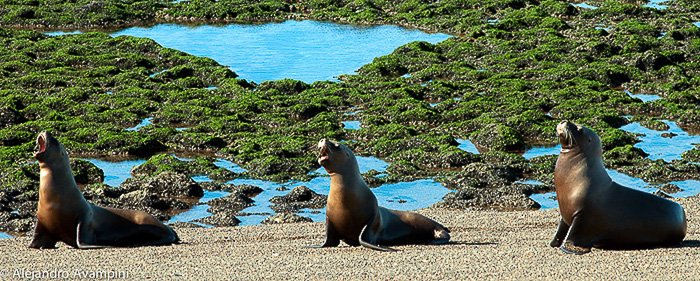 As the tide rises, the rock reefs are covered and the steep incline of the beach subsides below the surface. 2 hour before hide tide the sea lion colony is exposed to the possibility of Orca attacks. For the next five hours the channel is full of possibilities, with the sea lions crossing the channel from one reef to the other, the babies moving and playing in the breaking waves along the shore and many adults ¨surfing¨ the swells just meters from the Orcas. For the most part the adult sea lions do not fear the orcas, knowing that their primary objective is the capture of pups, clumsy, distracted and easy to hunt. After arriving at high tide the depth remains constant for a short time before once again beginning to drop. 2 hours later the water has retreated several meters from the sea lion colony and taking with it the danger of the oceans top predator
As the tide rises, the rock reefs are covered and the steep incline of the beach subsides below the surface. 2 hour before hide tide the sea lion colony is exposed to the possibility of Orca attacks. For the next five hours the channel is full of possibilities, with the sea lions crossing the channel from one reef to the other, the babies moving and playing in the breaking waves along the shore and many adults ¨surfing¨ the swells just meters from the Orcas. For the most part the adult sea lions do not fear the orcas, knowing that their primary objective is the capture of pups, clumsy, distracted and easy to hunt. After arriving at high tide the depth remains constant for a short time before once again beginning to drop. 2 hours later the water has retreated several meters from the sea lion colony and taking with it the danger of the oceans top predator Every day the tide will rise and fall twice with a stationary period between each shift, corresponding to approximately 12 hours for the completion of a full tidal cycle. The timing of the tides becomes later with the passing of each day, due to the variations in the stationary period of each high and low tide, oscillating between 20 minutes to just over an hour. This is the reason why, during Orca Season, the potential for attacks on sea lions gets progressively day by day. For example: When high tide in Punta Norte occurs early in the morning, there will also be another high tide late in the afternoon. These conditions appear only a couple of days each month and are referred to as ¨double tide days¨
Every day the tide will rise and fall twice with a stationary period between each shift, corresponding to approximately 12 hours for the completion of a full tidal cycle. The timing of the tides becomes later with the passing of each day, due to the variations in the stationary period of each high and low tide, oscillating between 20 minutes to just over an hour. This is the reason why, during Orca Season, the potential for attacks on sea lions gets progressively day by day. For example: When high tide in Punta Norte occurs early in the morning, there will also be another high tide late in the afternoon. These conditions appear only a couple of days each month and are referred to as ¨double tide days¨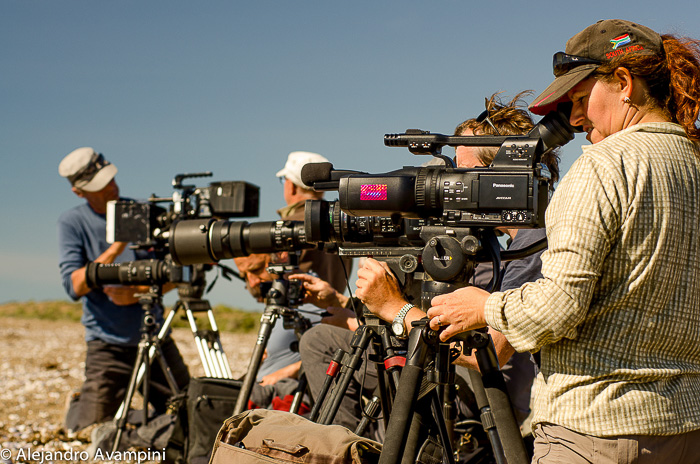 Early morning hours, in general, are more productive for Orcas due to the playful and unconcerned behavior of the sea lions. Sea lion pups wake with the rising sun and spend their time moving from one place on the beach to the next, playing in breaking waves along the tidal line, a dangerous area to be distracted. The beach is divided into sectors by rock reefs, creating channels in high tide through which Orcas can make a surprise appearance and reach the sea lion colony almost instantly.
Early morning hours, in general, are more productive for Orcas due to the playful and unconcerned behavior of the sea lions. Sea lion pups wake with the rising sun and spend their time moving from one place on the beach to the next, playing in breaking waves along the tidal line, a dangerous area to be distracted. The beach is divided into sectors by rock reefs, creating channels in high tide through which Orcas can make a surprise appearance and reach the sea lion colony almost instantly. Allow me to reiterate, the presence of Orcas is an inexact science in the field of wildlife and its ocean of possibilities. Orcas do not always appear in the attack zone, and when they do, they do not always attack. Often they will just patrol the beaches, choosing to attack at a different sea lion colony with no public access.
Allow me to reiterate, the presence of Orcas is an inexact science in the field of wildlife and its ocean of possibilities. Orcas do not always appear in the attack zone, and when they do, they do not always attack. Often they will just patrol the beaches, choosing to attack at a different sea lion colony with no public access. Very often the wait takes several days and even in the peak of Orca Season, their appearance is in no way guaranteed. When there is no action, time seems to slow down for the documentary crews during the long 5 or 6 hour wait under the sun and exposed to the conditions. Time is filled sharing ¨Mate¨ or collecting rocks while the supervising Park Rangers keep a vigil eye on the sea, prepared to alert the crew at first sight of the Orcas.
Very often the wait takes several days and even in the peak of Orca Season, their appearance is in no way guaranteed. When there is no action, time seems to slow down for the documentary crews during the long 5 or 6 hour wait under the sun and exposed to the conditions. Time is filled sharing ¨Mate¨ or collecting rocks while the supervising Park Rangers keep a vigil eye on the sea, prepared to alert the crew at first sight of the Orcas.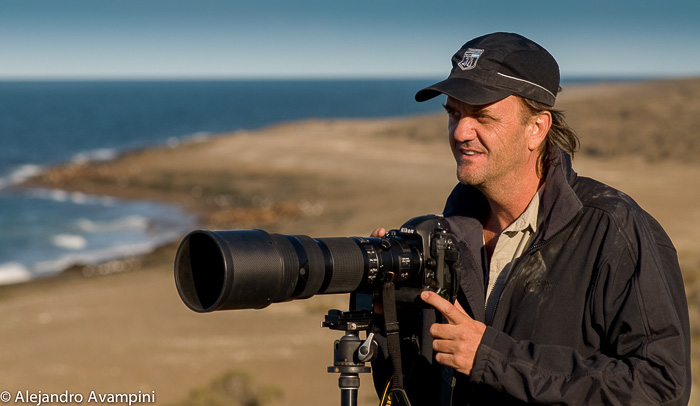 Andres Bonetti has been photographing Orcas in Punta Norte for 20 years, arriving each season with the same tenacity. His images are constantly circulating around the world in the shape of postcards, posters and books on Orcas, Whales and all the other attractions of Argentine Patagonia. His son, Dario Bonetti, has inherited the same passion for the out of doors and adventure with nature. With his filming equipment he has become known as a local expert and has one of the best collections of images with respect to marine fauna. Producers from around the world have requested his images to be seen later by millions of people in their documentaries.
Andres Bonetti has been photographing Orcas in Punta Norte for 20 years, arriving each season with the same tenacity. His images are constantly circulating around the world in the shape of postcards, posters and books on Orcas, Whales and all the other attractions of Argentine Patagonia. His son, Dario Bonetti, has inherited the same passion for the out of doors and adventure with nature. With his filming equipment he has become known as a local expert and has one of the best collections of images with respect to marine fauna. Producers from around the world have requested his images to be seen later by millions of people in their documentaries.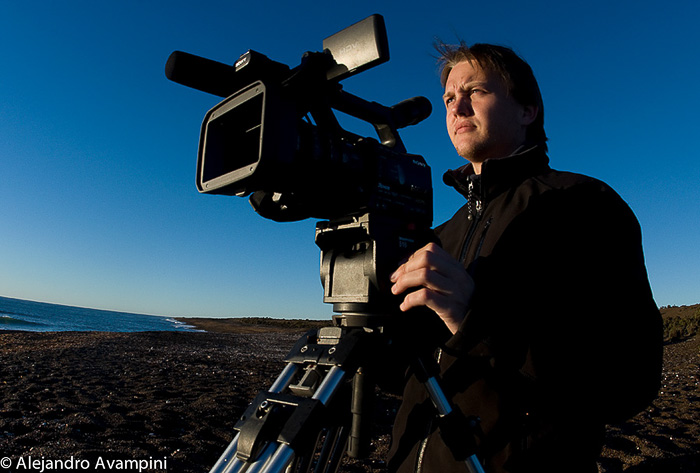 Amongst the Argentine Nature Photographers that reserve their place in the attack cannel each season,
Amongst the Argentine Nature Photographers that reserve their place in the attack cannel each season, 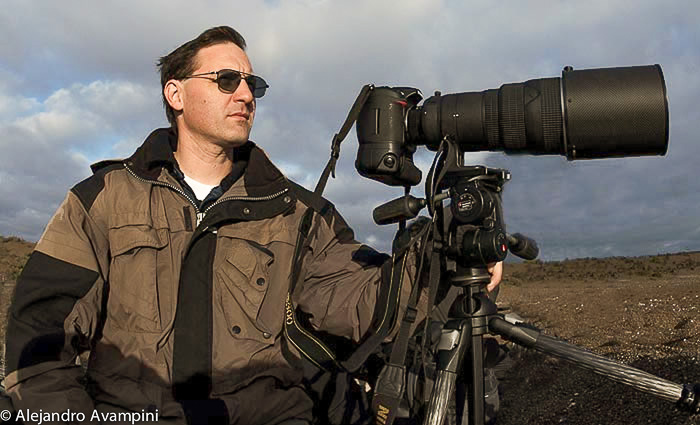 Gabriel Rojo is one that remains loyal, returning each year with the same patience and constancy, searching for the next new image of the Orcas intentional beaching. Gabriel holds an impressive file of images spanning over more than 15 years. I include myself here, in this select group of Orca photographers and give my thanks to Andres and Dario Bonetti who brought me into the world of Punta Norte ever since the inauguration of Del Nomade Eco Hotel Over the last several seasons these friends and colleges would leave the city of Puerto Madryn, some 5 or 6 hours before the high tide, deviate from their course several kilometers in order to pick me up in Puerto Piramides and travel together, between ¨mates¨ and sandwiches, to Punta Norte. What more could I ask for, an unforgettable Patagonian luxury that deserves nothing less than this mention. The three of us are together in the photo below, next to the Park Ranger ¨Flaco¨ Montero, who has worked several seasons at Punta Norte.
Gabriel Rojo is one that remains loyal, returning each year with the same patience and constancy, searching for the next new image of the Orcas intentional beaching. Gabriel holds an impressive file of images spanning over more than 15 years. I include myself here, in this select group of Orca photographers and give my thanks to Andres and Dario Bonetti who brought me into the world of Punta Norte ever since the inauguration of Del Nomade Eco Hotel Over the last several seasons these friends and colleges would leave the city of Puerto Madryn, some 5 or 6 hours before the high tide, deviate from their course several kilometers in order to pick me up in Puerto Piramides and travel together, between ¨mates¨ and sandwiches, to Punta Norte. What more could I ask for, an unforgettable Patagonian luxury that deserves nothing less than this mention. The three of us are together in the photo below, next to the Park Ranger ¨Flaco¨ Montero, who has worked several seasons at Punta Norte.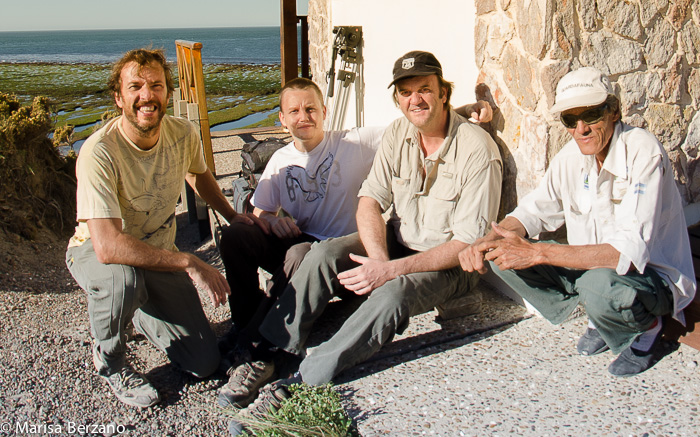
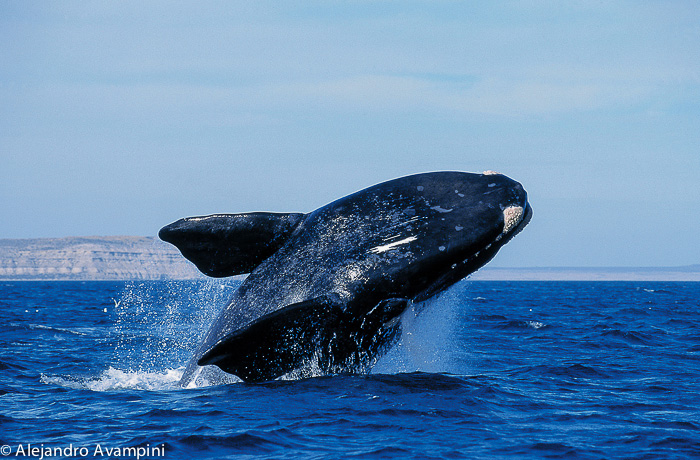 Argentine Patagonia, offers one of the best places in the world for whale watching. The morphology of this region of South America offers calm and protected waters, where this giant mammals has choosen to get birth to their calves and for mating (as other species also do), turning this World Heritage in a huge nursery. Most of the 300,000 visitors and tourists that reach the Valdes Peninsula each year arrive to Puerto Piramides to observe the Southern Right Whales.
Argentine Patagonia, offers one of the best places in the world for whale watching. The morphology of this region of South America offers calm and protected waters, where this giant mammals has choosen to get birth to their calves and for mating (as other species also do), turning this World Heritage in a huge nursery. Most of the 300,000 visitors and tourists that reach the Valdes Peninsula each year arrive to Puerto Piramides to observe the Southern Right Whales. 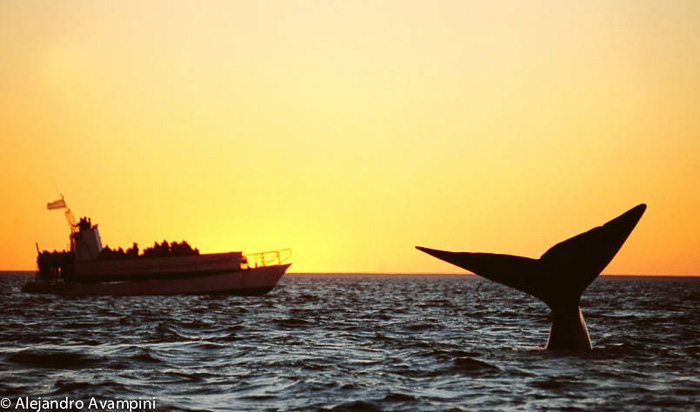 Like other whales, the southern right whale migrates twice each year: a trophic or feeding migration, to areas rich in zooplankton, near the Antarctic Convergence; and a reproductive migration towards coastal temperate waters, which provide a calm refuge from adverse weather conditions that they can suffer in the open sea and which would be risky for newborn calves. The Southern Right Whale, has ample space in the ocean where it spends its life. Those born in the Gulf Nuevo and Gulf San Jose not necessarily return every year to the Peninsula. They have welldefined areas for their fall and summer migrations and can travel thousands of miles on each trip.
Like other whales, the southern right whale migrates twice each year: a trophic or feeding migration, to areas rich in zooplankton, near the Antarctic Convergence; and a reproductive migration towards coastal temperate waters, which provide a calm refuge from adverse weather conditions that they can suffer in the open sea and which would be risky for newborn calves. The Southern Right Whale, has ample space in the ocean where it spends its life. Those born in the Gulf Nuevo and Gulf San Jose not necessarily return every year to the Peninsula. They have welldefined areas for their fall and summer migrations and can travel thousands of miles on each trip.  In fall, a time for breeding, they move northward as far as latitude 20 degrees. The furthest north where some very small groups of whales can be seen is on the coast of Brazil, in South America, and between Mozambique and the island of Madagascar in Africa. They are also found in Australia, New Zealand and South Africa.
In fall, a time for breeding, they move northward as far as latitude 20 degrees. The furthest north where some very small groups of whales can be seen is on the coast of Brazil, in South America, and between Mozambique and the island of Madagascar in Africa. They are also found in Australia, New Zealand and South Africa. 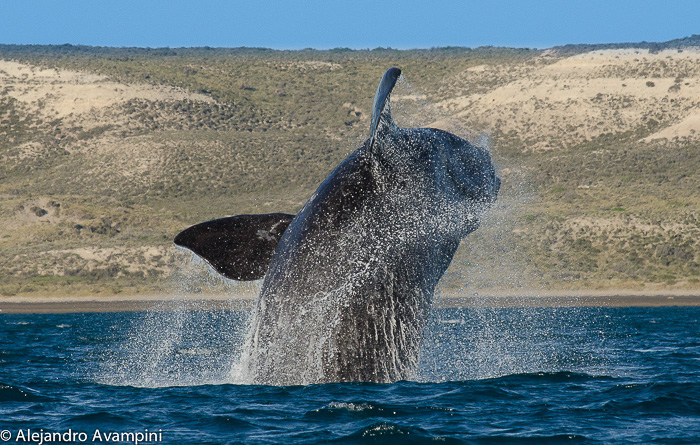 Arriving in December, they migrate back towards the feeding area around the 55th.the ICB (Whale Conservation Institute), it is estimated that in the winter-spring season, the whale population of Valdes Peninsula reachs over 2.000 individuals, the largest concentration of whales of this species in any breeding area, around the world. The calm waters of the gulf Nuevo and gulf San José , are very attractive to calves when learning to breathe, and are also favoured by whales at mating time.
Arriving in December, they migrate back towards the feeding area around the 55th.the ICB (Whale Conservation Institute), it is estimated that in the winter-spring season, the whale population of Valdes Peninsula reachs over 2.000 individuals, the largest concentration of whales of this species in any breeding area, around the world. The calm waters of the gulf Nuevo and gulf San José , are very attractive to calves when learning to breathe, and are also favoured by whales at mating time.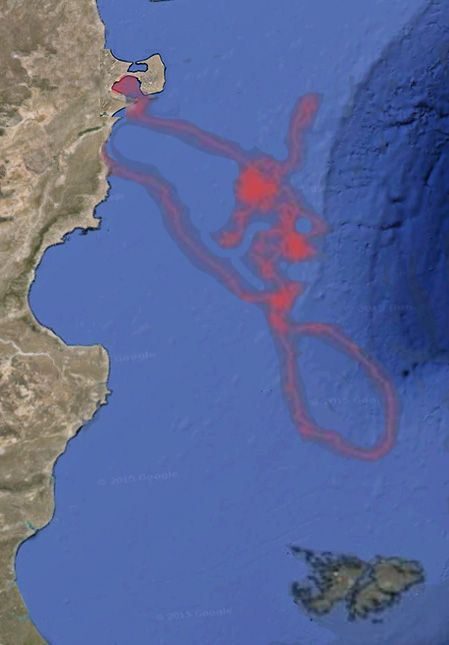
 “Southern Right Whales of Argentina” is an educational documentary film by Chris and Genevieve Johnson.
“Southern Right Whales of Argentina” is an educational documentary film by Chris and Genevieve Johnson.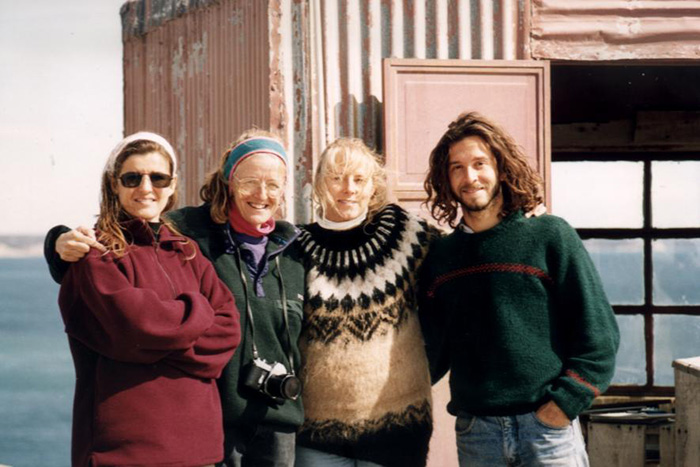 Centre interviews Dr . Mariano Sironi, scientific director of the Whale Conservation Institute, Vicky Rowntree, director of the Southern Right Whale program in Coservation Whale Institute. Both observe and record the behavior of whales, Dr. Jon Seger biology professor at the University of Utah in the United States. interview also Luciano Valenzuela, Researcher at ICB. Among explain general characteristics of this huge marine mammal show as performed whale photo-identification and harassment of gulls. Thanks to conservation efforts, the southern right whale is recovering steadily, after having reached the brink of extinction. You can also read the interesting synopsis that made Whale Trackers.
Centre interviews Dr . Mariano Sironi, scientific director of the Whale Conservation Institute, Vicky Rowntree, director of the Southern Right Whale program in Coservation Whale Institute. Both observe and record the behavior of whales, Dr. Jon Seger biology professor at the University of Utah in the United States. interview also Luciano Valenzuela, Researcher at ICB. Among explain general characteristics of this huge marine mammal show as performed whale photo-identification and harassment of gulls. Thanks to conservation efforts, the southern right whale is recovering steadily, after having reached the brink of extinction. You can also read the interesting synopsis that made Whale Trackers.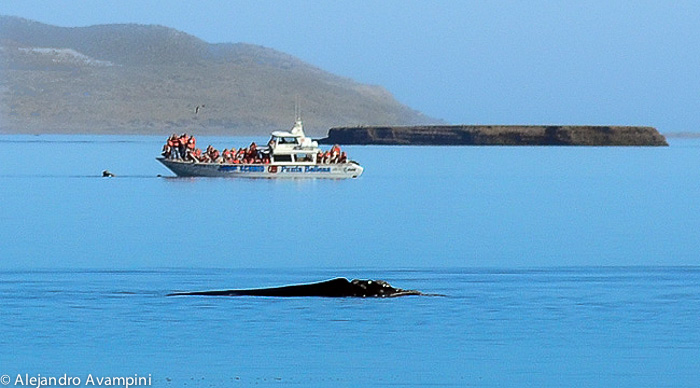 Thanks to humanities slow acquisition of environmental consciousness and after having nearly reached extinction, the Southern Right Whale is on the road to sustainable recovery. With this in mind, their future is still quite fragile and their long term survival is in our hands. The exponential increase and popularity of ecotourism in the region, such as whale watching, offers hope to this species in danger of extinction. Commercially on the rise since the 1970s, whale watching has created conflicts of interest amongst different countries, though little by little whales are ceasing to be pursued as an industrial resource and moving back into a place of respect, where they belong.
Thanks to humanities slow acquisition of environmental consciousness and after having nearly reached extinction, the Southern Right Whale is on the road to sustainable recovery. With this in mind, their future is still quite fragile and their long term survival is in our hands. The exponential increase and popularity of ecotourism in the region, such as whale watching, offers hope to this species in danger of extinction. Commercially on the rise since the 1970s, whale watching has created conflicts of interest amongst different countries, though little by little whales are ceasing to be pursued as an industrial resource and moving back into a place of respect, where they belong.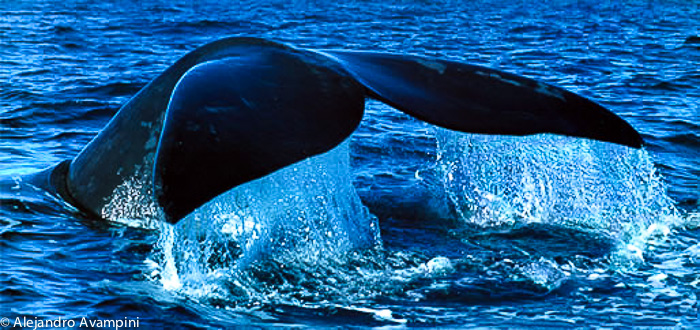 The shapes that the whales have, in general, are much different from most other living creatures. Even though their morphology is so different from our own, the anatomy of these monumental beings brings us close. A certain parentage with humans can be observed through the common characteristics that we share with the largest living being on our planet. Both are mammals, or better said, warm blooded vertebrates with hair and mammary glands. According to scientific discoveries we do share a common heritage, seen at the end of the Triassic, more than 200 million years ago. Understanding this significant family lasso allows us an important affinity with mammals, including marine mammals.
The shapes that the whales have, in general, are much different from most other living creatures. Even though their morphology is so different from our own, the anatomy of these monumental beings brings us close. A certain parentage with humans can be observed through the common characteristics that we share with the largest living being on our planet. Both are mammals, or better said, warm blooded vertebrates with hair and mammary glands. According to scientific discoveries we do share a common heritage, seen at the end of the Triassic, more than 200 million years ago. Understanding this significant family lasso allows us an important affinity with mammals, including marine mammals. 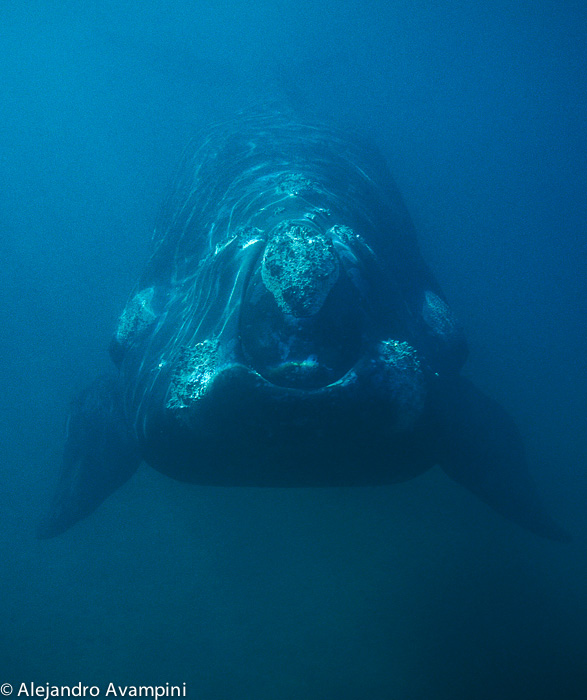
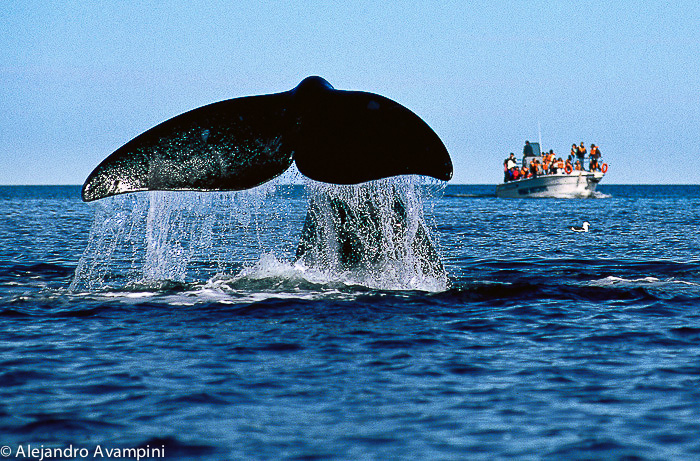
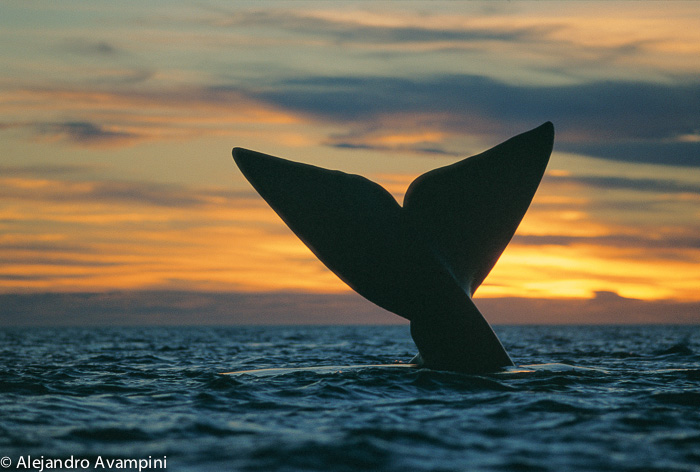 A smooth elastic skin, dark in color, wraps the entire body which, with calves, often appears lighter in shade than that of the adults. Most individuals have white underbelly markings and occasionally white markings on their backs or other areas of their body. Just below their constantly molting skin is stored a large layer of fat from 14 to 35cm thick, depending on which part of the body and the season.
A smooth elastic skin, dark in color, wraps the entire body which, with calves, often appears lighter in shade than that of the adults. Most individuals have white underbelly markings and occasionally white markings on their backs or other areas of their body. Just below their constantly molting skin is stored a large layer of fat from 14 to 35cm thick, depending on which part of the body and the season.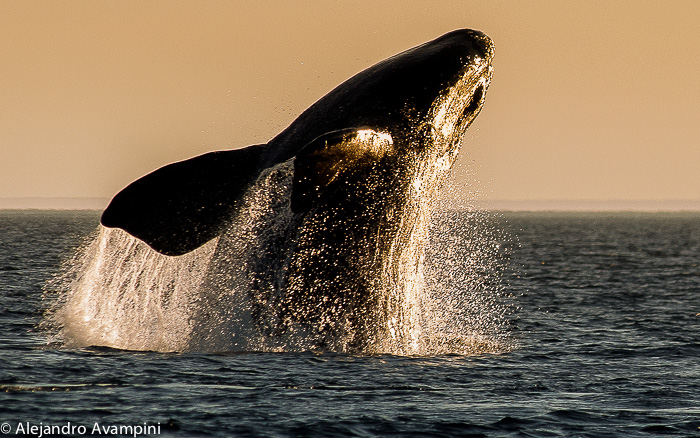 The southern right whale, like other whales, draws its body off the water in a unique and stunning show, which is commonly know as “breaching”. We are not entirely sure of the reasons behind the jump. Some scientists say the whale jumps because it is a way of communicating with other adult whales or calves. Others argue that another reason could be to try to see out of the water, perhaps just shapes and distances, but with eyes adapted to see salty underwater, it would be very unlikely to see the objects defined above, in the air and surface only at a glance. There are other possible reasons that cause the jump of the whale, one of them, which is tiny, is a small, crab-like creature,the cyamids, a crustacean parasite. There is evidence that there can be large concentrations of cyamids walking on the skin and callosities of the whale. Sometimes they can walk over very sensitive areas, such as the corner of the eye, and generate significant discomfort and it may be that, by breaching, the force generated by the animal falling back into the water, may dislodge some if not all of these parasites. Other annoyances that may generate breaching are the intense bites on their backs caused by seagulls, which lately developed the habit of feeding on their skin and fat. Whatever the reason for breaching, the sight of this amazing marine mammal propelling it’s body weight of more than 40 tons, 10 meters out of the water, using only the force of it’s tail or caudal fin, is a spectacle that is fantastic to behold.
The southern right whale, like other whales, draws its body off the water in a unique and stunning show, which is commonly know as “breaching”. We are not entirely sure of the reasons behind the jump. Some scientists say the whale jumps because it is a way of communicating with other adult whales or calves. Others argue that another reason could be to try to see out of the water, perhaps just shapes and distances, but with eyes adapted to see salty underwater, it would be very unlikely to see the objects defined above, in the air and surface only at a glance. There are other possible reasons that cause the jump of the whale, one of them, which is tiny, is a small, crab-like creature,the cyamids, a crustacean parasite. There is evidence that there can be large concentrations of cyamids walking on the skin and callosities of the whale. Sometimes they can walk over very sensitive areas, such as the corner of the eye, and generate significant discomfort and it may be that, by breaching, the force generated by the animal falling back into the water, may dislodge some if not all of these parasites. Other annoyances that may generate breaching are the intense bites on their backs caused by seagulls, which lately developed the habit of feeding on their skin and fat. Whatever the reason for breaching, the sight of this amazing marine mammal propelling it’s body weight of more than 40 tons, 10 meters out of the water, using only the force of it’s tail or caudal fin, is a spectacle that is fantastic to behold.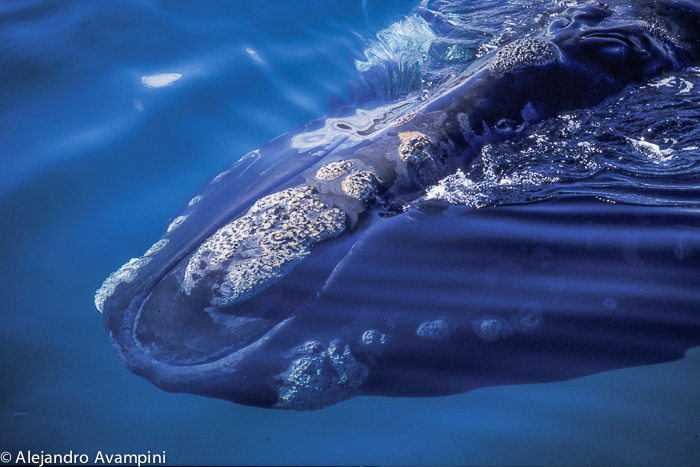 These calluses with hard and light forms have a rough base and sometimes take the form of small leaves. They are about 5 cm in height, are formed in the foetal stage and grow with the animal, throughout his life. They are found along the upper margin of the lower lip, jaw, dorsal surface of the face and eyes, forming a kind of eyebrow. In all specimens of right whales, the largest one is the bonnet which is on the end of the snout of the animal. These dark gray calluses have populations of cyamids, commonly known as whale-lice. The calluses sometimes host colonies of barnacles which can cause them to take on a yellow or orange colour.
These calluses with hard and light forms have a rough base and sometimes take the form of small leaves. They are about 5 cm in height, are formed in the foetal stage and grow with the animal, throughout his life. They are found along the upper margin of the lower lip, jaw, dorsal surface of the face and eyes, forming a kind of eyebrow. In all specimens of right whales, the largest one is the bonnet which is on the end of the snout of the animal. These dark gray calluses have populations of cyamids, commonly known as whale-lice. The calluses sometimes host colonies of barnacles which can cause them to take on a yellow or orange colour.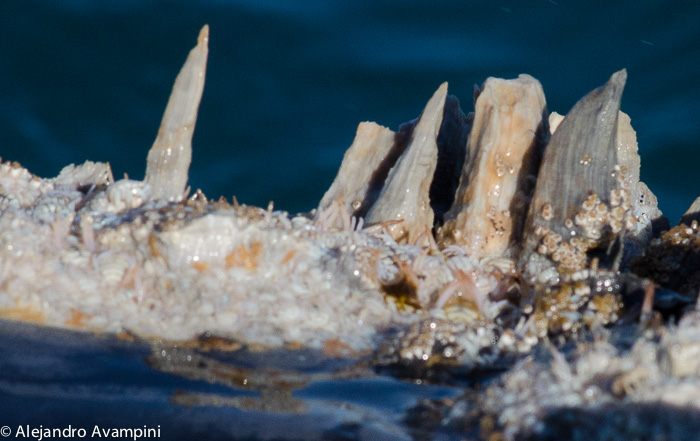 While all the whales have these skin blemishes, not all are in the same place or the same way. Each whale has its own unique distribution of calluses. 40 years ago, Roger Paine decided to use this unique distribution to enable photo- identification of whales.
While all the whales have these skin blemishes, not all are in the same place or the same way. Each whale has its own unique distribution of calluses. 40 years ago, Roger Paine decided to use this unique distribution to enable photo- identification of whales.  This was the first major discovery that Roger Paine offered in the study of this animal. These callosities harbor populations of small crustaceans called cyamids, commonly referred to as whale lice and very often interlaced with cirripedia (barnacles) causing an orange or yellow hue to the callosities.
This was the first major discovery that Roger Paine offered in the study of this animal. These callosities harbor populations of small crustaceans called cyamids, commonly referred to as whale lice and very often interlaced with cirripedia (barnacles) causing an orange or yellow hue to the callosities.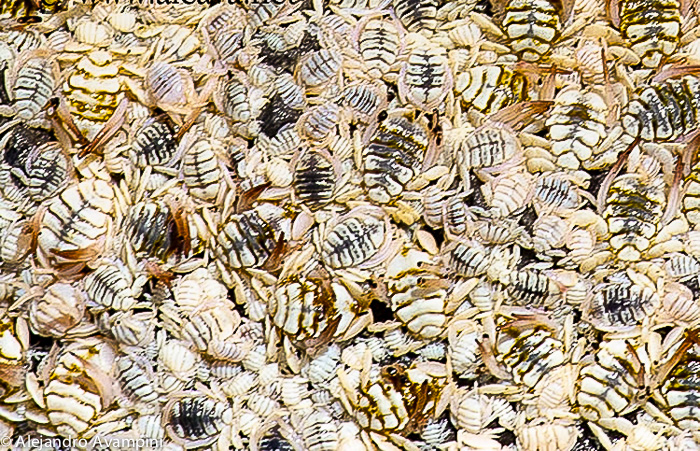
 In 1970 Roger Paine, here in Valdes Peninsula, discovered that he could be individually identified by photographs of the whales from the head´s calluses patterns. That was the beginning of the program of Southern Right Whale Research. Currently, this program is the study of longer duration in the world based on whale photo-identification. Until then, what was known about whales came mostly from the analysis of specimens hunted by the whaling industry.
In 1970 Roger Paine, here in Valdes Peninsula, discovered that he could be individually identified by photographs of the whales from the head´s calluses patterns. That was the beginning of the program of Southern Right Whale Research. Currently, this program is the study of longer duration in the world based on whale photo-identification. Until then, what was known about whales came mostly from the analysis of specimens hunted by the whaling industry.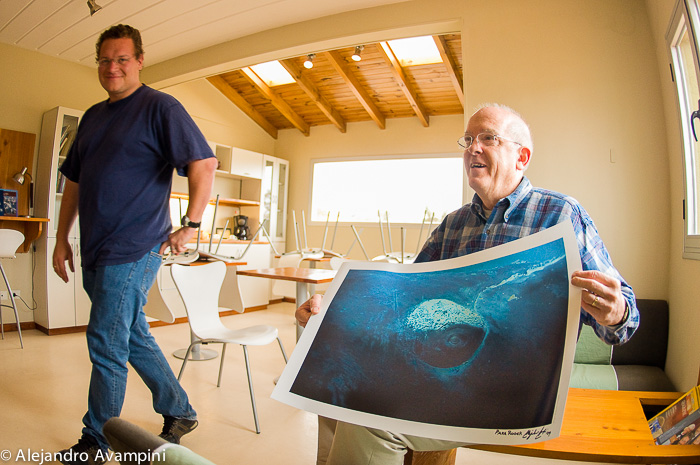
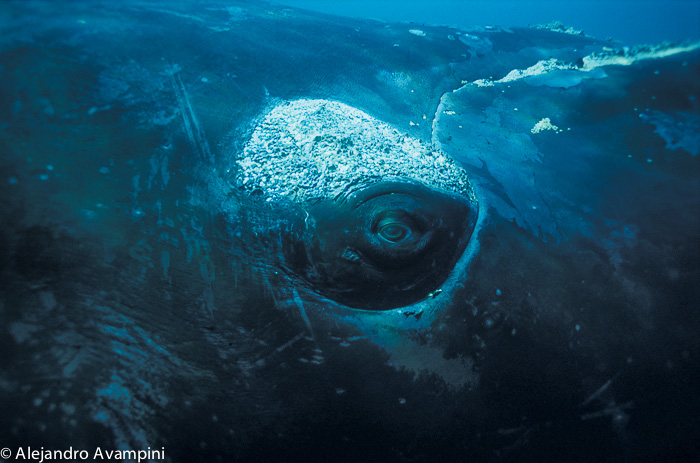 His work has been featured over thirty documentaries for television, including the documentary made in 1991, which was nominated for Emmy Awards “In the company of whales”. In 1995, Dr. Payne co-wrote and co-directed a production of IMAX, “Whales”, which was very popular among the critics and the general public.An estimated audience of 40,000 people across the world sees that footage weekly. Dr. Payne always wanted to films and publications how can help, educate and raise awareness about the uncertain future of the planet
His work has been featured over thirty documentaries for television, including the documentary made in 1991, which was nominated for Emmy Awards “In the company of whales”. In 1995, Dr. Payne co-wrote and co-directed a production of IMAX, “Whales”, which was very popular among the critics and the general public.An estimated audience of 40,000 people across the world sees that footage weekly. Dr. Payne always wanted to films and publications how can help, educate and raise awareness about the uncertain future of the planet 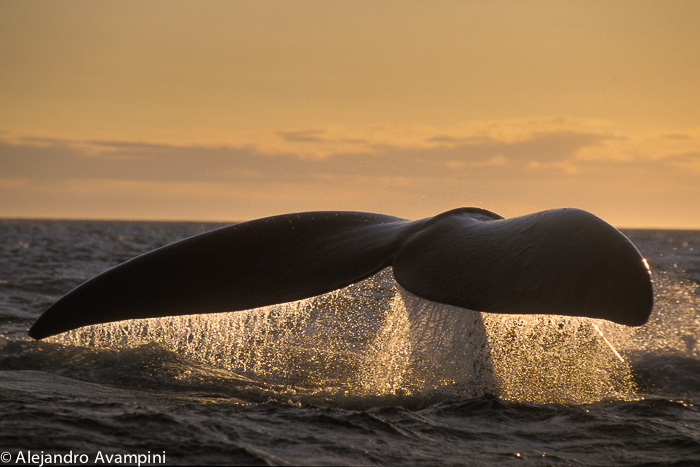
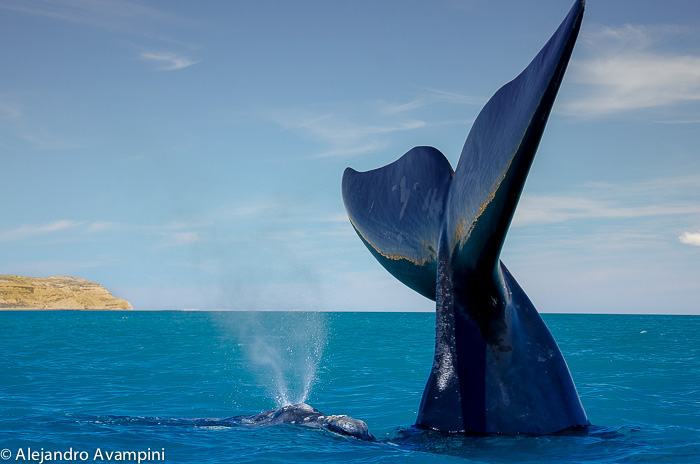

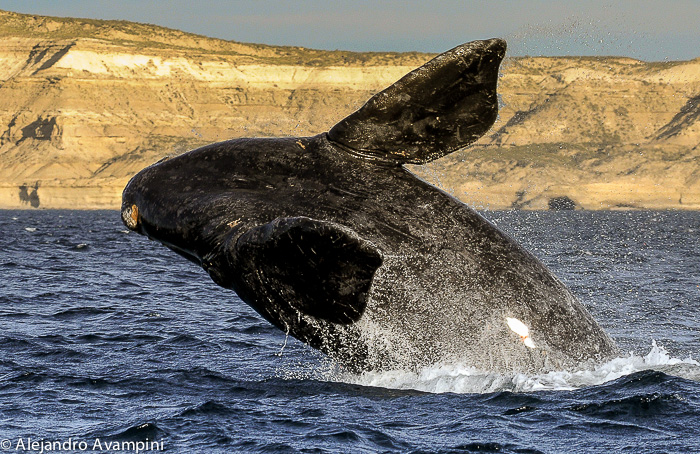 One mating technique used by the males is for a male to move on top of the female while other males hold their positions on either side. When the female turns, in an attempt to breath, the males advance on her until one is able to mate. Other times, observing from whale watching boats in Puerto Piramide, we will see how the males will literally probe with their penis, looking for the vagina while she lays belly up on the surface.
One mating technique used by the males is for a male to move on top of the female while other males hold their positions on either side. When the female turns, in an attempt to breath, the males advance on her until one is able to mate. Other times, observing from whale watching boats in Puerto Piramide, we will see how the males will literally probe with their penis, looking for the vagina while she lays belly up on the surface.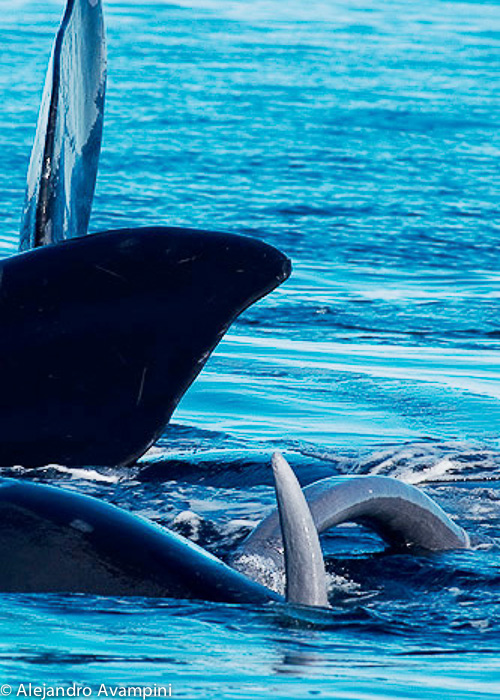
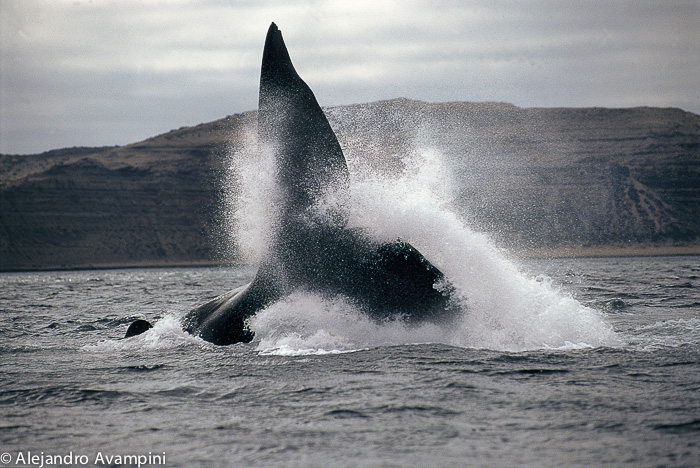 The fluke or tail fin of the Southern Right Whale is one the strongest forces in the animal kingdom, easily demonstrated with each breach the whales make, carrying ¾ of their more than 40 thousand kg bodies out of the water. The fluke is made up of fibrous tissues that connect to the body by the caudal peduncle, conformed of very powerful muscles. The fluke of an adult individual can stretch a breadth of as much as five meters.
The fluke or tail fin of the Southern Right Whale is one the strongest forces in the animal kingdom, easily demonstrated with each breach the whales make, carrying ¾ of their more than 40 thousand kg bodies out of the water. The fluke is made up of fibrous tissues that connect to the body by the caudal peduncle, conformed of very powerful muscles. The fluke of an adult individual can stretch a breadth of as much as five meters. They can be observed holding this position for hours, coming up to breath every few minutes and then returning to take the previous position once again. Scientists argue that this behavior could be related to thermoregulation or as a pre-birthing exercise. Mothers, before giving birth, are observed raising huge volumes of their fluke and peduncle out of the water.
They can be observed holding this position for hours, coming up to breath every few minutes and then returning to take the previous position once again. Scientists argue that this behavior could be related to thermoregulation or as a pre-birthing exercise. Mothers, before giving birth, are observed raising huge volumes of their fluke and peduncle out of the water.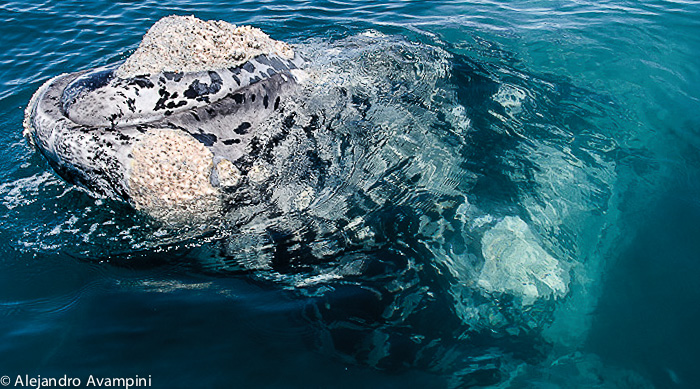 The white whale it’s a nature’s rareness. Just like in others species, there are some whales born with their skin white instead of black because of the lack of pigmentation. It’s not very common to see them during a whale watching in Puerto Pirámides, but it is probably that a couple of this peculiar white whales born every year. Their behavior it’s just the same as any other whale: they jump, feed of its mother and show us their tail! The difference between this albinism and another animal’s albinism, it’s that in whales tends to disappear in their first years of life. While the years go by, their skin begins to get darker, going from white to grey, and finally black. As you can see in the top image, this white whale is son of a young white female whale who hasn’t get her skin dark yet. If you see one of these whales underwater, they seem to be green, because of the water’s transparency.
The white whale it’s a nature’s rareness. Just like in others species, there are some whales born with their skin white instead of black because of the lack of pigmentation. It’s not very common to see them during a whale watching in Puerto Pirámides, but it is probably that a couple of this peculiar white whales born every year. Their behavior it’s just the same as any other whale: they jump, feed of its mother and show us their tail! The difference between this albinism and another animal’s albinism, it’s that in whales tends to disappear in their first years of life. While the years go by, their skin begins to get darker, going from white to grey, and finally black. As you can see in the top image, this white whale is son of a young white female whale who hasn’t get her skin dark yet. If you see one of these whales underwater, they seem to be green, because of the water’s transparency.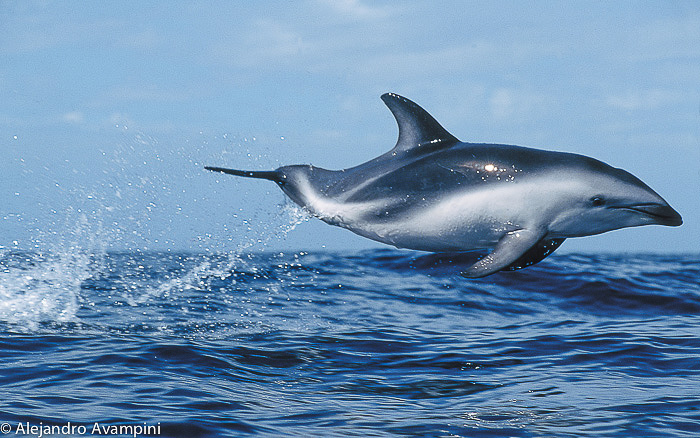 Also known as FitzRoy Dolphin (Lagenorhynchus obscurus), the dusky dolphin gives splashes of magic and mischief in the calm waters of the gulf. Feel the energy of man’s best friend in the sea. It’s a marine mammal from the cetacean group, Odontoceti subgroup (such as orcas). It has a short, dark beak, and the dorsal fin is black with a grey crescent clearly visible in the back half. The tail is dark and has pointed ends, with a deep notch marked in the centre. The pectoral fins are long and pointed, with the curved edge and a darker colour than the surroundings. Both eyes are surrounded by a small dark spot.
Also known as FitzRoy Dolphin (Lagenorhynchus obscurus), the dusky dolphin gives splashes of magic and mischief in the calm waters of the gulf. Feel the energy of man’s best friend in the sea. It’s a marine mammal from the cetacean group, Odontoceti subgroup (such as orcas). It has a short, dark beak, and the dorsal fin is black with a grey crescent clearly visible in the back half. The tail is dark and has pointed ends, with a deep notch marked in the centre. The pectoral fins are long and pointed, with the curved edge and a darker colour than the surroundings. Both eyes are surrounded by a small dark spot.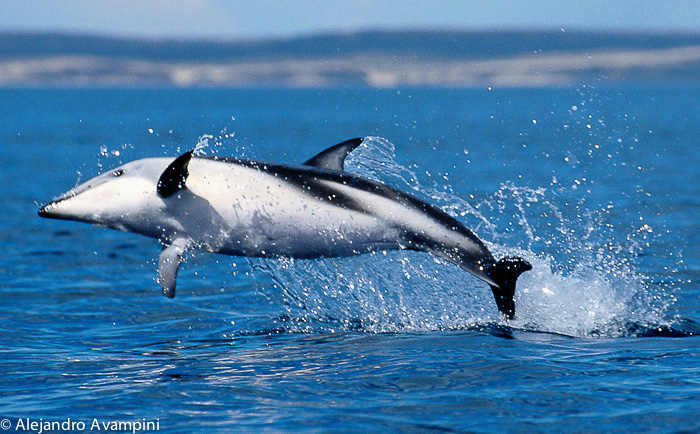 The back is dark grey or bluish black, with a light grey stripe on the flanks that runs from the caudal peduncle to the centre of the body and opens on both ends where it ends, generally below the dorsal fin. The ventral side is white and extends up above the pectoral fins to end in a narrow strip between the beak and forehead.
The back is dark grey or bluish black, with a light grey stripe on the flanks that runs from the caudal peduncle to the centre of the body and opens on both ends where it ends, generally below the dorsal fin. The ventral side is white and extends up above the pectoral fins to end in a narrow strip between the beak and forehead. 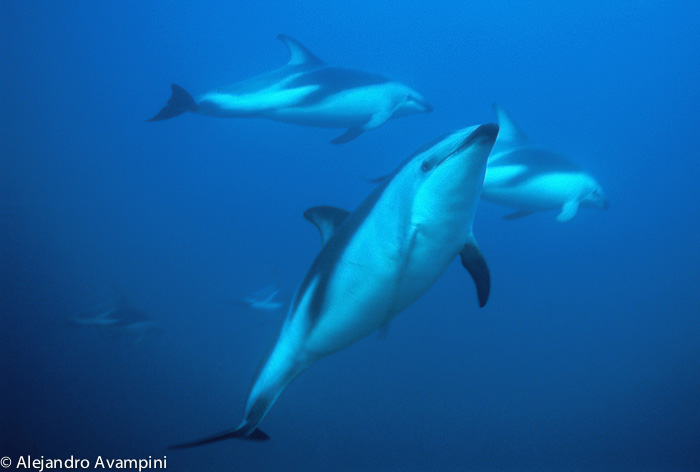
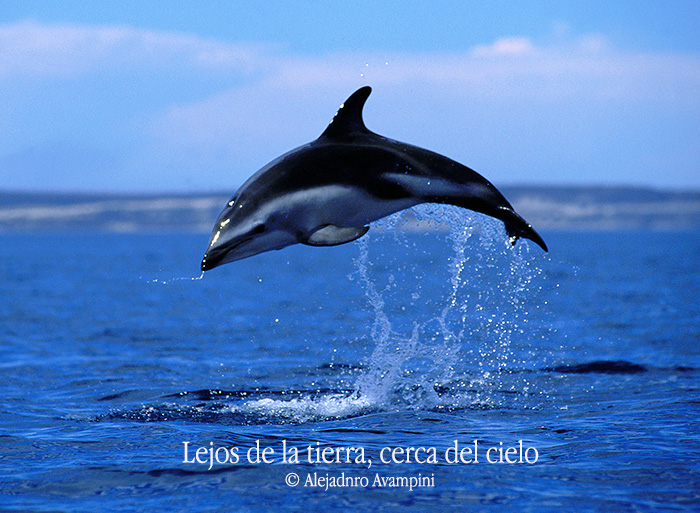 It can be observed in pods that vary from 20 to 100 individuals, although, pods of nearly a thousand dusky dolphins have been recorded. It seems to be very sociable and associates with other species both for feeding and for coexistence. Examples are three cases found in Golfo Nuevo, Chubut coast, in which a bottlenose dolphin, two common dolphins and a possible hybrid, a cross between a dusky dolphin with southern right whale dolphin (Lissodelphis peronii), lived within a dusky dolphins herd. It is distributed exclusively in the Southern Hemisphere and can be seen in South America, New Zealand, Kerguelen Islands and South Africa.
It can be observed in pods that vary from 20 to 100 individuals, although, pods of nearly a thousand dusky dolphins have been recorded. It seems to be very sociable and associates with other species both for feeding and for coexistence. Examples are three cases found in Golfo Nuevo, Chubut coast, in which a bottlenose dolphin, two common dolphins and a possible hybrid, a cross between a dusky dolphin with southern right whale dolphin (Lissodelphis peronii), lived within a dusky dolphins herd. It is distributed exclusively in the Southern Hemisphere and can be seen in South America, New Zealand, Kerguelen Islands and South Africa.
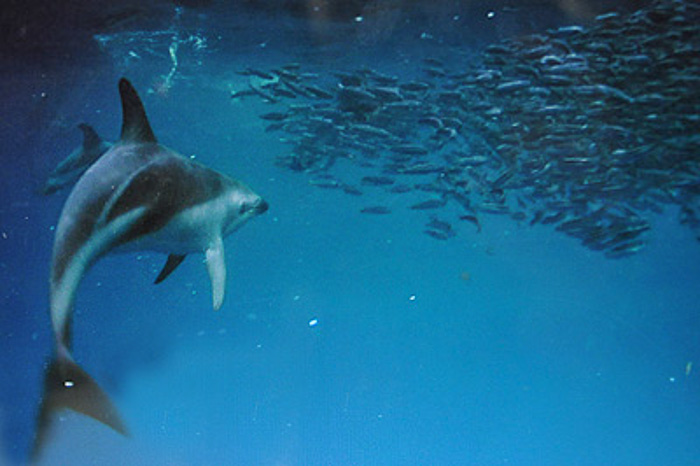
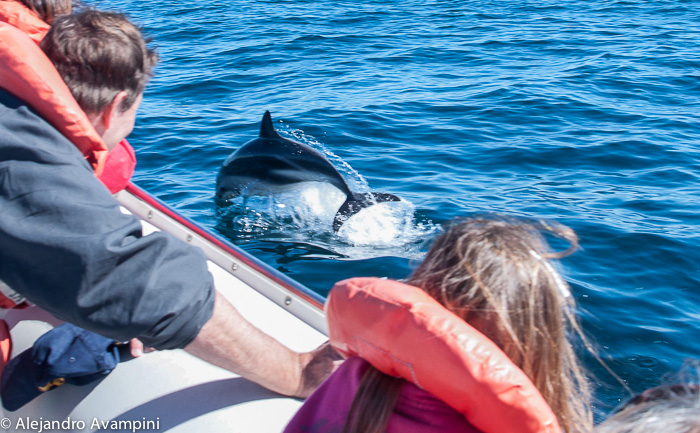

 The Southern Flamingo is a large bird, most often seen in flocks. They can measure five feet, are easily identified by their pink colour on the outer feathers, their long neck, long legs and large wings. The legs have short toes, which are also webbed, helping the bird when swimming. Male flamingos are larger than females and this feature is the only visible difference between the sexes. The colour of their feathers are acquired by the food they eat, that’s why their offspring are born whitish and take on the intense pink colour from the small crustaceans, which form the major part of their diet. Flamingos are not resident in Valdes Peninsula area, however they nest in lakes in the Province of La Pampa. They are very wary birds and are easily disturbed by human presence. They can be very difficult to approach and photograph. The best way we have found to photograph them is to wait, camouflaged, at low tide. As the tide comes in, the birds will come to feed closer inshore. You must take great care not to alarm them or your opportunity will be lost. Photographing Flamingos requires a great deal of patience, as many of the professional photographers who live and work in the area will attest. Flamingos are not at all used to humans, living completely wild, and are, therefore, very elusive. Remember that Valdés Peninsula is an important area for wildlife to raise their young, and, as such is deserving of respect and minimal human impact. There are already 300,000 tourists visiting the area each year and the Peninsula is to some degree, affected by human greed. Please help to raise awareness of the need for respect for our wildlife by your own example.
The Southern Flamingo is a large bird, most often seen in flocks. They can measure five feet, are easily identified by their pink colour on the outer feathers, their long neck, long legs and large wings. The legs have short toes, which are also webbed, helping the bird when swimming. Male flamingos are larger than females and this feature is the only visible difference between the sexes. The colour of their feathers are acquired by the food they eat, that’s why their offspring are born whitish and take on the intense pink colour from the small crustaceans, which form the major part of their diet. Flamingos are not resident in Valdes Peninsula area, however they nest in lakes in the Province of La Pampa. They are very wary birds and are easily disturbed by human presence. They can be very difficult to approach and photograph. The best way we have found to photograph them is to wait, camouflaged, at low tide. As the tide comes in, the birds will come to feed closer inshore. You must take great care not to alarm them or your opportunity will be lost. Photographing Flamingos requires a great deal of patience, as many of the professional photographers who live and work in the area will attest. Flamingos are not at all used to humans, living completely wild, and are, therefore, very elusive. Remember that Valdés Peninsula is an important area for wildlife to raise their young, and, as such is deserving of respect and minimal human impact. There are already 300,000 tourists visiting the area each year and the Peninsula is to some degree, affected by human greed. Please help to raise awareness of the need for respect for our wildlife by your own example.




 The Black Chested Buzzard Eagle (Geranoaetus Melanoleucus) is a fast hunter that occupies most of the South American Continent from Venezuela to The land of Fire and the Beagle Channel. This is a diurnal bird that occupies, in relatively small numbers, the Valdes Peninsula.
The Black Chested Buzzard Eagle (Geranoaetus Melanoleucus) is a fast hunter that occupies most of the South American Continent from Venezuela to The land of Fire and the Beagle Channel. This is a diurnal bird that occupies, in relatively small numbers, the Valdes Peninsula. Their nests are found on outcroppings of cliffs with extremely difficult access and their nests are large platforms of sticks and branches. A female will lay 2 eggs in October and the chicks will hatch around the end of November beginning of December.
Their nests are found on outcroppings of cliffs with extremely difficult access and their nests are large platforms of sticks and branches. A female will lay 2 eggs in October and the chicks will hatch around the end of November beginning of December. A large part of their diet is made up of rodents and small mammals, though they do also hunt and eat other small birds, as seen in the above image. On this occasion I observed it carrying its prey to the nest to feed the anxiously awaiting chicks. This banquet ensures continued growth, maintaining a species that enriches our planets biodiversity.
A large part of their diet is made up of rodents and small mammals, though they do also hunt and eat other small birds, as seen in the above image. On this occasion I observed it carrying its prey to the nest to feed the anxiously awaiting chicks. This banquet ensures continued growth, maintaining a species that enriches our planets biodiversity.
 These feathers were used in hairstyles and hats and were acquired at a high price, creating an uncontrolled extermination with no respect for the bird’s reproduction. The creation and application of legislation together with changing styles helped reverse the situation. During reproductive season they will nest together in colonies as large as 20 individuals.
These feathers were used in hairstyles and hats and were acquired at a high price, creating an uncontrolled extermination with no respect for the bird’s reproduction. The creation and application of legislation together with changing styles helped reverse the situation. During reproductive season they will nest together in colonies as large as 20 individuals. This species is easily recognized in flight due to its long legs stretched out in back and its long neck pulled inward in an “S” shape and the perfect form it takes while majestically gliding through the air.
This species is easily recognized in flight due to its long legs stretched out in back and its long neck pulled inward in an “S” shape and the perfect form it takes while majestically gliding through the air. For the building of their nest a pair of Great Egrets will look for an area with trees and easy access to large quantities of dead branches, willows, grasses or dry leaves. Together with these materials they will construct a large platform in which six to eight light-blue eggs will be laid.
For the building of their nest a pair of Great Egrets will look for an area with trees and easy access to large quantities of dead branches, willows, grasses or dry leaves. Together with these materials they will construct a large platform in which six to eight light-blue eggs will be laid. The turkey vulture is a bird of the vulture family , which can be found all across the Americas. In the different countries of the continent, it has different names, such as buzzard, aura, or just vulture. In Valdes Peninsula, it is one of the largest of the vultures, with a red head, blackish plumage, more brown on the upper surface of the wings. The underside of the flight feathers are grey, creating a sharp contrast. The head is small in proportion to the body and has no feathers – in adults it is reddish and in juveniles, it is black.
The turkey vulture is a bird of the vulture family , which can be found all across the Americas. In the different countries of the continent, it has different names, such as buzzard, aura, or just vulture. In Valdes Peninsula, it is one of the largest of the vultures, with a red head, blackish plumage, more brown on the upper surface of the wings. The underside of the flight feathers are grey, creating a sharp contrast. The head is small in proportion to the body and has no feathers – in adults it is reddish and in juveniles, it is black.  It weighs between 1.4 and 2.7 kg, measures 60-76 cm in length and has a wingspan of up to 2 meters. It glides with wings in a “V” shape and often sways in a way that gives the impression that it is drunk. It’s typically seen in Puerto Piramides, flying around the valley, and taking advantage of thermal wind generated by the hills that protect the town from east to west, on the north side. The turkey vulture is a scavenger, ranging over large distances and finding carrion with a keen sense of smell. Typically, it will feed on the carcasses of sea lions, guanaco, hares and rabbits. If it finds a large piece of carrion, such as a calf, it will circle over it, to let other vultures know where the carcass is.
It weighs between 1.4 and 2.7 kg, measures 60-76 cm in length and has a wingspan of up to 2 meters. It glides with wings in a “V” shape and often sways in a way that gives the impression that it is drunk. It’s typically seen in Puerto Piramides, flying around the valley, and taking advantage of thermal wind generated by the hills that protect the town from east to west, on the north side. The turkey vulture is a scavenger, ranging over large distances and finding carrion with a keen sense of smell. Typically, it will feed on the carcasses of sea lions, guanaco, hares and rabbits. If it finds a large piece of carrion, such as a calf, it will circle over it, to let other vultures know where the carcass is. They are usually seen on Valdes Peninsula during spring and summer months. It mates for life and nests in cliffs. They dig a deep burrow in which 2 to 5 eggs are laid. The eggs hatch in late December. The Burrowing Parrot is very colourful and has seven colours in its plumage. On Valdes Peninsula, they are usually seen in flocks of 10- 20 individuals and are very noisy, constantly chattering. Their diet is based on shoots and fruits of shrubs, and they also travel great distances to feed in other regions, attracted by planted fields. This frequently leads to conflict with farmers, because they eat the seed and damage crops. We would to recommend a unique place for travellers, birdwatchers and those who are attracted by birds and nature. 550 km north of Valdes Peninsula, there is a town called El Condor, the Viedma’s beach, capital of Rio Negro province.There is one of the largest parrot colonies in the world, comprising over 100,000 Burrowing Parrots in 9 km of cliff, something which cannot be seen anywhere else on the Planet. We were surprised when we saw this incredible cliff, another natural wonder of Patagonia Argentina, which we had never heard of before. If you decide to go spend a few nights at this resort we recommend the Apart Hotel Costa del Faro, located on the coast, just meters from the cliff.
They are usually seen on Valdes Peninsula during spring and summer months. It mates for life and nests in cliffs. They dig a deep burrow in which 2 to 5 eggs are laid. The eggs hatch in late December. The Burrowing Parrot is very colourful and has seven colours in its plumage. On Valdes Peninsula, they are usually seen in flocks of 10- 20 individuals and are very noisy, constantly chattering. Their diet is based on shoots and fruits of shrubs, and they also travel great distances to feed in other regions, attracted by planted fields. This frequently leads to conflict with farmers, because they eat the seed and damage crops. We would to recommend a unique place for travellers, birdwatchers and those who are attracted by birds and nature. 550 km north of Valdes Peninsula, there is a town called El Condor, the Viedma’s beach, capital of Rio Negro province.There is one of the largest parrot colonies in the world, comprising over 100,000 Burrowing Parrots in 9 km of cliff, something which cannot be seen anywhere else on the Planet. We were surprised when we saw this incredible cliff, another natural wonder of Patagonia Argentina, which we had never heard of before. If you decide to go spend a few nights at this resort we recommend the Apart Hotel Costa del Faro, located on the coast, just meters from the cliff.

 Along their amazing migratory route of unimaginable proportions which begins in the Northern Autumn in the Canadian Arctic and takes them to the Southern extremes, only to then be repeated 4 months later as they return north with their offspring, the Red Knot (Calidris Canutus) and other migratory birds deviate from a straight line to “re-fuel” at 2 specific beaches of the Valdes Peninsula, fundamental for their survival. In their return journey north, a feeding stop is made at the Fracasso and Colombo beaches. The attached video, produced by the Wild-Life Foundation (Fundacion Vida Silvestre), describes the special characteristics found at these two places and explains why they do not stop on the way South. Also illustrated in this documentary is the important roll these humid, marine-coastal zones of the Valdes Peninsula play is sustaining the population of certain species of migratory birds.
Along their amazing migratory route of unimaginable proportions which begins in the Northern Autumn in the Canadian Arctic and takes them to the Southern extremes, only to then be repeated 4 months later as they return north with their offspring, the Red Knot (Calidris Canutus) and other migratory birds deviate from a straight line to “re-fuel” at 2 specific beaches of the Valdes Peninsula, fundamental for their survival. In their return journey north, a feeding stop is made at the Fracasso and Colombo beaches. The attached video, produced by the Wild-Life Foundation (Fundacion Vida Silvestre), describes the special characteristics found at these two places and explains why they do not stop on the way South. Also illustrated in this documentary is the important roll these humid, marine-coastal zones of the Valdes Peninsula play is sustaining the population of certain species of migratory birds. The Great Grebe (Podicephorus major) is coastal bird that is frequently seen in the Valdes Peninsula. Rarely seen in groups or on dry land, they are generally found swimming in shallow water close to the shore, alone or as a pair. The plumage is primarily rust colored around the neck with a black head and white chest. Resident to Patagonia this is not a migratory bird and can be observed fishing or hunting crabs along the shallow waters of both the Golfo Nuevo and Golfo San Jose.
The Great Grebe (Podicephorus major) is coastal bird that is frequently seen in the Valdes Peninsula. Rarely seen in groups or on dry land, they are generally found swimming in shallow water close to the shore, alone or as a pair. The plumage is primarily rust colored around the neck with a black head and white chest. Resident to Patagonia this is not a migratory bird and can be observed fishing or hunting crabs along the shallow waters of both the Golfo Nuevo and Golfo San Jose. This special bird has an incredibly aerodynamic shape. The distance between the tips of the extended wings reaches 2m. An adult male can weigh up to 5 kg. The family feature is the nostril, located in the upper beak in the form of a single nasal tube, but internally divided in two by a central partition. Monitoring these birds has shown that they have incredible flying skills and stamina.
This special bird has an incredibly aerodynamic shape. The distance between the tips of the extended wings reaches 2m. An adult male can weigh up to 5 kg. The family feature is the nostril, located in the upper beak in the form of a single nasal tube, but internally divided in two by a central partition. Monitoring these birds has shown that they have incredible flying skills and stamina.







 The Common Oyster Catcher (Haemantopus palliatus) is a bird that basks in the solitude of the Patagonian Coast living in a life-long mating pair, these birds are bothered by human presence. With a dark brown back, yellow eye and bright red ocular ring and a long red beak, they can reach a size of more than 40cm. and 700gr. They will build a camouflaged nest just meters from the high tide line.
The Common Oyster Catcher (Haemantopus palliatus) is a bird that basks in the solitude of the Patagonian Coast living in a life-long mating pair, these birds are bothered by human presence. With a dark brown back, yellow eye and bright red ocular ring and a long red beak, they can reach a size of more than 40cm. and 700gr. They will build a camouflaged nest just meters from the high tide line. The wings of the Oyster Catcher are dark brown on top but while in flight the plumage below their wings is White. A guaranteed sighting of this species will be found walking towards the caves, a 2,5km coastal walk from Puerto Piramides. When approaching, these birds will begin with their unique sounds, alerting other birds in the area.
The wings of the Oyster Catcher are dark brown on top but while in flight the plumage below their wings is White. A guaranteed sighting of this species will be found walking towards the caves, a 2,5km coastal walk from Puerto Piramides. When approaching, these birds will begin with their unique sounds, alerting other birds in the area. The South American Tern is one of the 3 species of terns that nest on the coast of Argentina and is found inValdes Peninsula. It is rather more difficult to observe that the kelp gull, because it has a small population size. The breeding season begins in December and you will be able to see them flying over the ledges and cliffs. After nesting, from March onwards they are no longer predictable. Terns nest every year, but not in the same places, often choosing quiet coastal places in very exposed sites but are very sensitive to disturbance. Their diet is based on fish; their fishing technique is to plunge into the sea s to capture their prey.
The South American Tern is one of the 3 species of terns that nest on the coast of Argentina and is found inValdes Peninsula. It is rather more difficult to observe that the kelp gull, because it has a small population size. The breeding season begins in December and you will be able to see them flying over the ledges and cliffs. After nesting, from March onwards they are no longer predictable. Terns nest every year, but not in the same places, often choosing quiet coastal places in very exposed sites but are very sensitive to disturbance. Their diet is based on fish; their fishing technique is to plunge into the sea s to capture their prey.
 Recent studies showed that the Imperial Cormorant feeds both in shallow coastal waters as well as deep waters (about 70m) and offshore (more than 8 km). The imperial cormorant is the leading producer of guano in Patagonia. Currently, the guano is mined in only a few colonies of Chubut and Santa Cruz. The guano exploitation is still carried out in a similar way to that of a few decades ago, and its extraction is carried out manually and sporadically.
Recent studies showed that the Imperial Cormorant feeds both in shallow coastal waters as well as deep waters (about 70m) and offshore (more than 8 km). The imperial cormorant is the leading producer of guano in Patagonia. Currently, the guano is mined in only a few colonies of Chubut and Santa Cruz. The guano exploitation is still carried out in a similar way to that of a few decades ago, and its extraction is carried out manually and sporadically.
 Rock Cormorants (Phalacrocorax magellanicus) are maritime birds that rook on rocky cliffs, and thus their name. They are extremely well adapted birds both in flight and below the water. Underwater they advanced using their webbed feet. This species exists only in the Patagonian region of Argentina and Chile. The Rock Cormorant colony at Punta Loma in one of the largest, with approximately 280 mating pairs and other, smaller rookeries exist along the coast of Golfo Nuevo. They will remain in the same colony throughout the year while adapting their behavior in accordance to the changing seasons. From March through September they are primarily found feeding and spend very little time on the nest. From October through February their behavior changes dramatically as they dedicate most of their time to mating, incubating and raising their chicks. The chicks will hatch 30 days after the female lays her eggs, usually just 2 eggs that will be mutually incubated by the pair. For two months the pair will take turns protecting the nest and chicks while the other heads out to sea in search of food.
Rock Cormorants (Phalacrocorax magellanicus) are maritime birds that rook on rocky cliffs, and thus their name. They are extremely well adapted birds both in flight and below the water. Underwater they advanced using their webbed feet. This species exists only in the Patagonian region of Argentina and Chile. The Rock Cormorant colony at Punta Loma in one of the largest, with approximately 280 mating pairs and other, smaller rookeries exist along the coast of Golfo Nuevo. They will remain in the same colony throughout the year while adapting their behavior in accordance to the changing seasons. From March through September they are primarily found feeding and spend very little time on the nest. From October through February their behavior changes dramatically as they dedicate most of their time to mating, incubating and raising their chicks. The chicks will hatch 30 days after the female lays her eggs, usually just 2 eggs that will be mutually incubated by the pair. For two months the pair will take turns protecting the nest and chicks while the other heads out to sea in search of food.  These Cormorants are frequently observed flying a precise straight line just above the surface of the ocean and, from time to time, lightly touching the surface with the tip of their wings. This species almost exclusively feeds on fish and in contrast to other cormorants, observations suggest that it mostly feeds on species of schooling fish. In a maritime environment the Neo-Tropic Cormorant (Phalacrocorax olivaceus) has be observed feeding alone as well as in groups and almost exclusively in shallow coastal waters less than 1.3km from the shore and in no more than 10mt depth. After diving, they are commonly observed standing with their wings spread out in order to dry. Their nests are built with twigs cemented together with their own guano.
These Cormorants are frequently observed flying a precise straight line just above the surface of the ocean and, from time to time, lightly touching the surface with the tip of their wings. This species almost exclusively feeds on fish and in contrast to other cormorants, observations suggest that it mostly feeds on species of schooling fish. In a maritime environment the Neo-Tropic Cormorant (Phalacrocorax olivaceus) has be observed feeding alone as well as in groups and almost exclusively in shallow coastal waters less than 1.3km from the shore and in no more than 10mt depth. After diving, they are commonly observed standing with their wings spread out in order to dry. Their nests are built with twigs cemented together with their own guano.

 It can measure up to 60 centimeters in length, the body is white and the wings black. Gulls are present all over Patagonia, extending to Tierra del Fuego and beyond, as far south as the Falkland Islands, South Atlantic Islands and Antarctica. They lay up to three eggs, nest and return to the same area every year. They feed naturally on intertidal resources, although their behaviour is very opportunistic and has been modified by the food supply generated by humans. Because of this, the growth of populations of gulls has grown-up considerably. They feed in open dumps, eat carrion, insects, grains, small fishes and …whales! The behaviour of gulls feeding off whales is, we believe, unique to our region.
It can measure up to 60 centimeters in length, the body is white and the wings black. Gulls are present all over Patagonia, extending to Tierra del Fuego and beyond, as far south as the Falkland Islands, South Atlantic Islands and Antarctica. They lay up to three eggs, nest and return to the same area every year. They feed naturally on intertidal resources, although their behaviour is very opportunistic and has been modified by the food supply generated by humans. Because of this, the growth of populations of gulls has grown-up considerably. They feed in open dumps, eat carrion, insects, grains, small fishes and …whales! The behaviour of gulls feeding off whales is, we believe, unique to our region. In the last decade whales have been affected by attacks by gulls, who have developed a liking for the proteins in the skin and blubber of whales. Over the years, the technique that had developed by only a few gulls, has been passed on to other birds and new generations, making the attacks happen more frequently and altering the behaviour of these giant cetaceans. Moreover, fish discards and waste dumps, and mainly the landfill at Puerto Madryn, have led to a huge increase in the numbers of seagulls, which have food guaranteed all year, thus increasing their birth rate. As a result, the number of individuals is grows-ing exponentially in Valdes Peninsula.
In the last decade whales have been affected by attacks by gulls, who have developed a liking for the proteins in the skin and blubber of whales. Over the years, the technique that had developed by only a few gulls, has been passed on to other birds and new generations, making the attacks happen more frequently and altering the behaviour of these giant cetaceans. Moreover, fish discards and waste dumps, and mainly the landfill at Puerto Madryn, have led to a huge increase in the numbers of seagulls, which have food guaranteed all year, thus increasing their birth rate. As a result, the number of individuals is grows-ing exponentially in Valdes Peninsula. In 2005, a study group led by Ms. Anne Fazio, Biological Sciences graduate, and Dr. Marcelo Bertellotti, planned a study with three years’ duration, in which the first thing they wanted to know was, if the whales skin and fat feeding behaviour was or was not widespread throughout the population of gulls. They wanted to ring them, so as to identify them when they were attacking. This task took place at Punta Piramides platform, where there is a nesting colony of gulls. They captured the gulls by means of a cannon- net. The gulls were then ringed with individually coded rings and samples of blood and feathers etc were taken, to ascertain the overall health of the gull population. Despite the great effort and hours of work of the whole group, it became increasingly difficult to capture gulls, because they learned very fast and avoid the traps. In the event, ringing was achieved only in 20% of the population. In addition there are seagulls from different areas feeding on whales. Ana says that “(…) for these two reasons, the brand was very dilute, we had only 2% of cases where we saw a branded seagull attacking. Also, with so many hours and days of observation in the water, you could see that even not all the seagulls attacked, it was not a small group, and the worst of all: they were more and more!.
In 2005, a study group led by Ms. Anne Fazio, Biological Sciences graduate, and Dr. Marcelo Bertellotti, planned a study with three years’ duration, in which the first thing they wanted to know was, if the whales skin and fat feeding behaviour was or was not widespread throughout the population of gulls. They wanted to ring them, so as to identify them when they were attacking. This task took place at Punta Piramides platform, where there is a nesting colony of gulls. They captured the gulls by means of a cannon- net. The gulls were then ringed with individually coded rings and samples of blood and feathers etc were taken, to ascertain the overall health of the gull population. Despite the great effort and hours of work of the whole group, it became increasingly difficult to capture gulls, because they learned very fast and avoid the traps. In the event, ringing was achieved only in 20% of the population. In addition there are seagulls from different areas feeding on whales. Ana says that “(…) for these two reasons, the brand was very dilute, we had only 2% of cases where we saw a branded seagull attacking. Also, with so many hours and days of observation in the water, you could see that even not all the seagulls attacked, it was not a small group, and the worst of all: they were more and more!. We also have an overall record of the attack rate during the three seasons of whales watching, knowing the peaks of the curves (times of increased number of attacks per unit time). This information is very useful, since at the time of taking up the study comparisons can be made with other years to see if the attack rate has increased or decreased. In addition, samples were analyzed to search for pathogens with which the gulls can infect whales; we’ve found some and it is something that really concerns us. It is likely that, by moving from whale to whale, the gulls will not only infect the whales with pathogens which they carry, but could also transmit as carriers, pathogens and infections which are carried by the whales. AsValdes Peninsula is an area with a high transient population of whales, including calves, this is a matter of real concern and could have a greater effect on the whales than a mere change in behaviour. “ One of the most important conclusions, agreed by a majority, was to close the open dump in Puerto Madryn. We know that populations of gulls increased for many years, until ‘97 and then remained constant. The main causes were fishing discards and waste dumps. That’s why the plan launched by the Province to eradicate open dumps around Chubut is an incrediblebreakthrough on minimizing environmental impact, and may the get the rate of reproduction of the gulls back into balance.
We also have an overall record of the attack rate during the three seasons of whales watching, knowing the peaks of the curves (times of increased number of attacks per unit time). This information is very useful, since at the time of taking up the study comparisons can be made with other years to see if the attack rate has increased or decreased. In addition, samples were analyzed to search for pathogens with which the gulls can infect whales; we’ve found some and it is something that really concerns us. It is likely that, by moving from whale to whale, the gulls will not only infect the whales with pathogens which they carry, but could also transmit as carriers, pathogens and infections which are carried by the whales. AsValdes Peninsula is an area with a high transient population of whales, including calves, this is a matter of real concern and could have a greater effect on the whales than a mere change in behaviour. “ One of the most important conclusions, agreed by a majority, was to close the open dump in Puerto Madryn. We know that populations of gulls increased for many years, until ‘97 and then remained constant. The main causes were fishing discards and waste dumps. That’s why the plan launched by the Province to eradicate open dumps around Chubut is an incrediblebreakthrough on minimizing environmental impact, and may the get the rate of reproduction of the gulls back into balance. 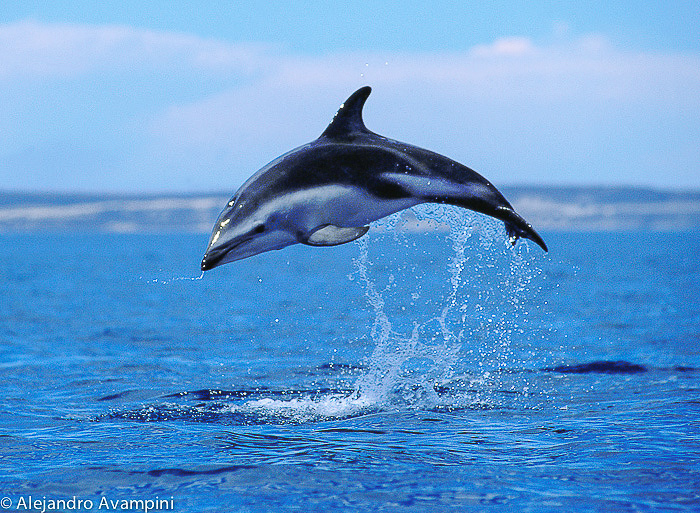 The wildlife that can be observed from Puerto Piramides is varied and numerous, each species with its own attractive attributes and season. This genetic reservoir, that has survived incalculable massacres resulting in the near extinction of many species, is on the rebound. Since the protection of this unique wildlife sanctuary began, each season that passes becomes even wilder. With each passing year the numbers do nothing but grow with respect to Whales, Sea Lions, Elephant Seals and other species.
The wildlife that can be observed from Puerto Piramides is varied and numerous, each species with its own attractive attributes and season. This genetic reservoir, that has survived incalculable massacres resulting in the near extinction of many species, is on the rebound. Since the protection of this unique wildlife sanctuary began, each season that passes becomes even wilder. With each passing year the numbers do nothing but grow with respect to Whales, Sea Lions, Elephant Seals and other species.  For this reason alone, the Valdes Peninsula invites you to visit over and over again. Its geography is a living natural laboratory. A painting in constant motion and a world built for Man to do nothing more than contemplate. A place that allows for the power of understanding and invigorating observation of the life cycle of the oceans giants, as well as dozens of other species, at any time of the year.
For this reason alone, the Valdes Peninsula invites you to visit over and over again. Its geography is a living natural laboratory. A painting in constant motion and a world built for Man to do nothing more than contemplate. A place that allows for the power of understanding and invigorating observation of the life cycle of the oceans giants, as well as dozens of other species, at any time of the year.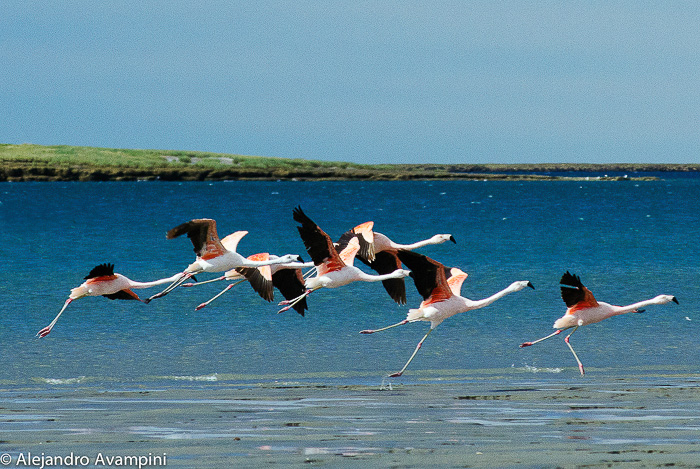 The annual migrations that many of these animals follow are truly admirable. Pushed on by instinct, at some calculated time each year, they will pass through the Valdes Peninsula. A perfect example, outside from the classic migrations of the Southern Right Whale or other marine giants, are two species of swallows that will travel between March and April, when cold weather begins to arrive, to Perú and Ecuador, returning once again to Patagonia in spring with longer days and warmer weather. These incredible peregrines of the natural kingdom, the Black Swallow and the Blue and White Swallow, are far from calling the attention of most tourists who arrive for whale watching tours. These small birds will migrate annually over tens of thousands of kilometers and, if for nothing else, deserve to be mentioned here.
The annual migrations that many of these animals follow are truly admirable. Pushed on by instinct, at some calculated time each year, they will pass through the Valdes Peninsula. A perfect example, outside from the classic migrations of the Southern Right Whale or other marine giants, are two species of swallows that will travel between March and April, when cold weather begins to arrive, to Perú and Ecuador, returning once again to Patagonia in spring with longer days and warmer weather. These incredible peregrines of the natural kingdom, the Black Swallow and the Blue and White Swallow, are far from calling the attention of most tourists who arrive for whale watching tours. These small birds will migrate annually over tens of thousands of kilometers and, if for nothing else, deserve to be mentioned here.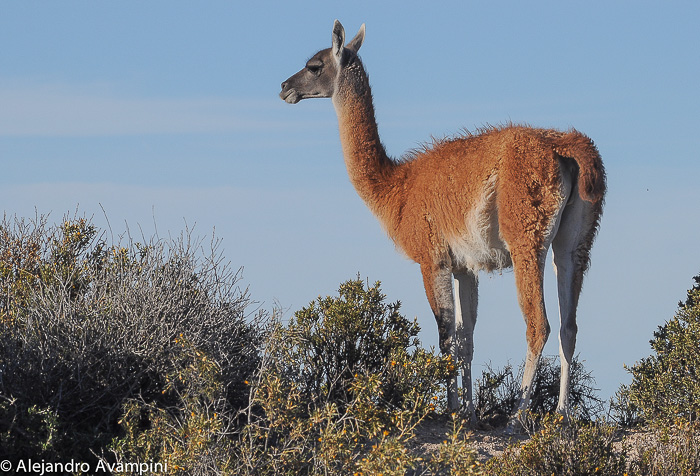 Guanacos (Lama guanicoe) , mammals related to Llamas and pertaining to the order of Camelidos, carry with humble dignity the title of being Patagonia’s largest land dwelling vertebrate. Before the arrival of Europeans, this beautiful species was a fundamental ally in the survival of Patagonia´s indigenous inhabitants, providing meat for food and hides for warmth. The Valdes Peninsula is a Provincial Nature Reserve but it is not entirely intangible. For this reason commercial activities are still carried out by the 56 Estancias (Ranches) that are primarily dedicated to sheep herding and wool production. This industry has its beginnings in the Valdes Peninsula at the beginning of 1900.
Guanacos (Lama guanicoe) , mammals related to Llamas and pertaining to the order of Camelidos, carry with humble dignity the title of being Patagonia’s largest land dwelling vertebrate. Before the arrival of Europeans, this beautiful species was a fundamental ally in the survival of Patagonia´s indigenous inhabitants, providing meat for food and hides for warmth. The Valdes Peninsula is a Provincial Nature Reserve but it is not entirely intangible. For this reason commercial activities are still carried out by the 56 Estancias (Ranches) that are primarily dedicated to sheep herding and wool production. This industry has its beginnings in the Valdes Peninsula at the beginning of 1900.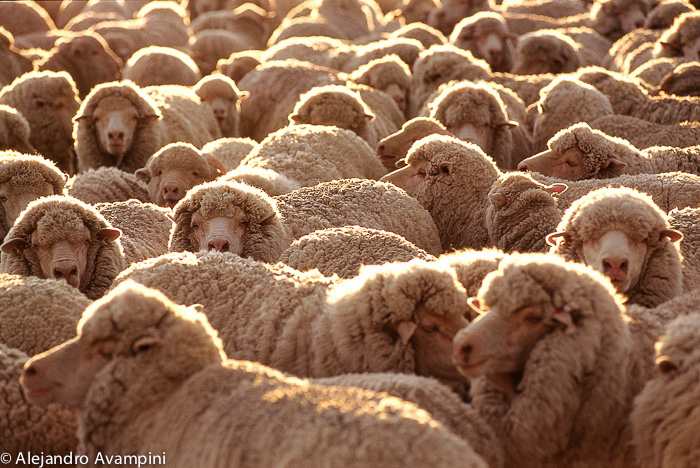 With colonization and non-indigenous development in the area, domestic animals arrived and one in particular dramatically changed the Patagonian Steppe. To raise and commercialize sheep and its subsequent byproducts certain inventions where applied in the region, like barbed wire fencing, private property and the division of land. Guanacos, displaced by the wool industry, were considerably reduced in numbers. Two fundamental characteristics of Guanacos are that they live together in large herds and are grazing herbivores.
With colonization and non-indigenous development in the area, domestic animals arrived and one in particular dramatically changed the Patagonian Steppe. To raise and commercialize sheep and its subsequent byproducts certain inventions where applied in the region, like barbed wire fencing, private property and the division of land. Guanacos, displaced by the wool industry, were considerably reduced in numbers. Two fundamental characteristics of Guanacos are that they live together in large herds and are grazing herbivores.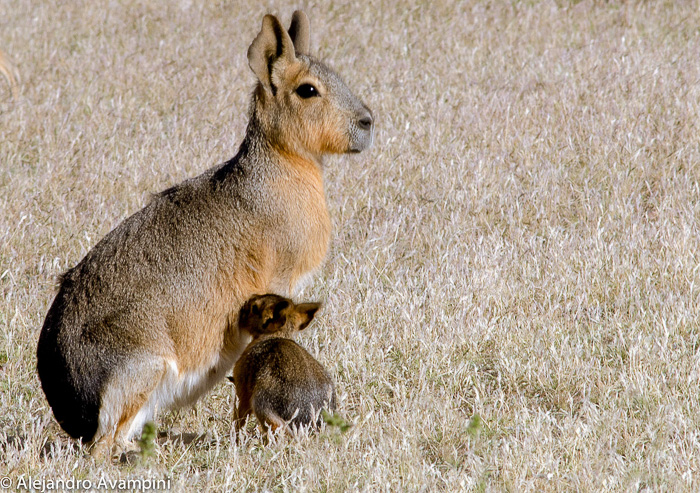
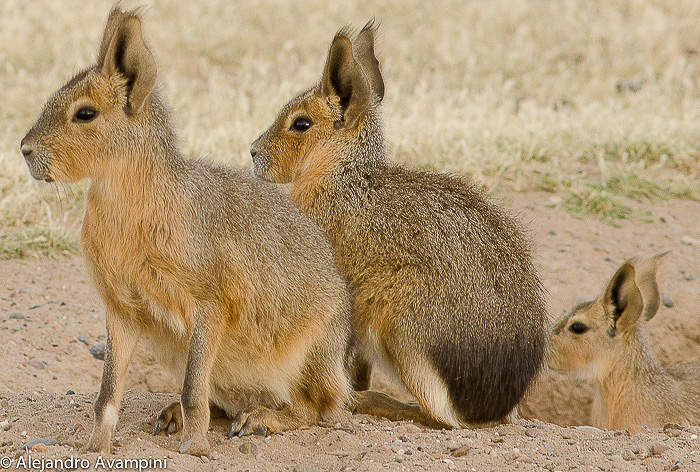
 There is an abundant population of Patagonian Skunks (
There is an abundant population of Patagonian Skunks (
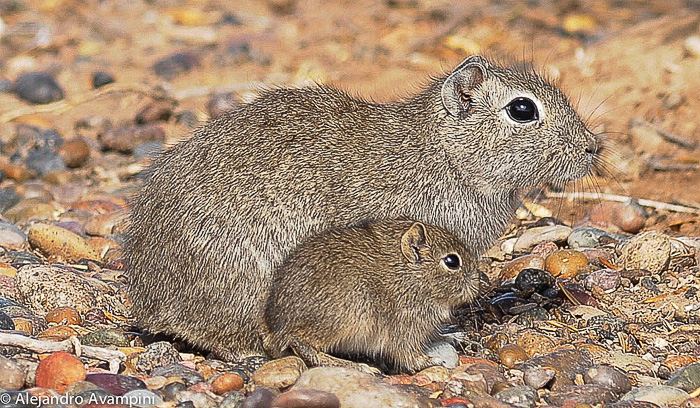 The Southern Dwarf Cavy or Brazilian Guinea Pig (Microcavia australis), is a mammal that feeds on sprouts of many plants and often climbs bushes and small trees to eat soft leaves. An enjoyable species to observe while the whales and Orcas remain below the surface. The female will go into heat for a period of approximately 5 hours, during which time she will be pursued and eventually mated by various males. The gestation period of these small animals is just under 2 months. Their behavior is often humorous to observe and, although not very sociable with humans, they can easily be seen while visiting the different tourist attractions in the area. A perfect example would be while sitting on the coast of el Doradillo waiting for a whale to breach, the Guinea Pig will most likely be close by in the bushes next to where you are sitting. If not for the subtle connections made by the observant visitor to this natural paradise, they would carry out their attractive lifestyle in complete anonymity.
The Southern Dwarf Cavy or Brazilian Guinea Pig (Microcavia australis), is a mammal that feeds on sprouts of many plants and often climbs bushes and small trees to eat soft leaves. An enjoyable species to observe while the whales and Orcas remain below the surface. The female will go into heat for a period of approximately 5 hours, during which time she will be pursued and eventually mated by various males. The gestation period of these small animals is just under 2 months. Their behavior is often humorous to observe and, although not very sociable with humans, they can easily be seen while visiting the different tourist attractions in the area. A perfect example would be while sitting on the coast of el Doradillo waiting for a whale to breach, the Guinea Pig will most likely be close by in the bushes next to where you are sitting. If not for the subtle connections made by the observant visitor to this natural paradise, they would carry out their attractive lifestyle in complete anonymity.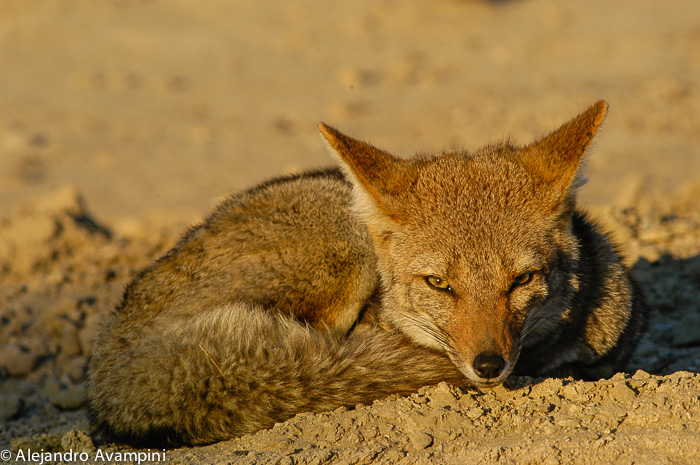 The Grey Fox
The Grey Fox 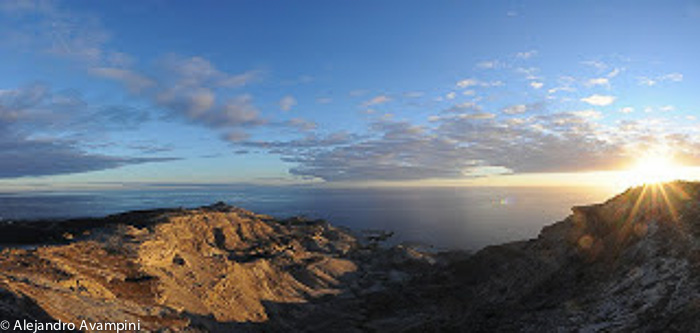 During whale season this is an ideal location for spotting whales, where, from high on the cliffs, the characteristic spouting of these animals can be seen in numbers. In summer a privileged perspective of the largest reproductive sea lion colony in Valdes Peninsula allows you to hear and observe thousands of individuals from close range.
During whale season this is an ideal location for spotting whales, where, from high on the cliffs, the characteristic spouting of these animals can be seen in numbers. In summer a privileged perspective of the largest reproductive sea lion colony in Valdes Peninsula allows you to hear and observe thousands of individuals from close range.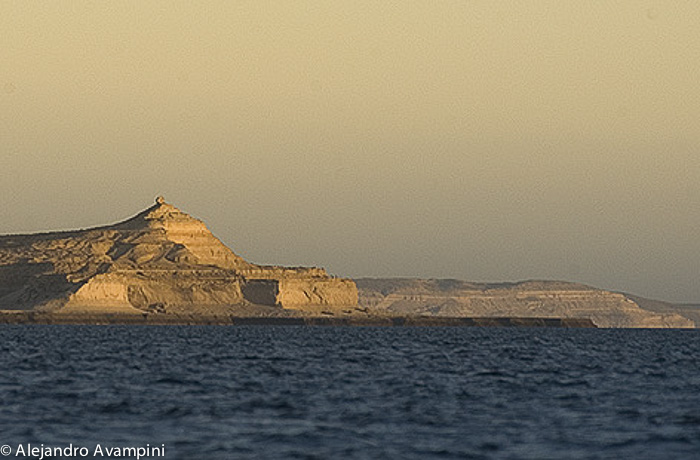 All of these conditions and many more have converted Punta Piramide into a truly unique natural space. The point thrusts itself out into the sea in the shape of a pyramid creating an iconic image of the area and symbol of a coast eroded by the passing of time and distinct geological eras. The entire area is made up of old ocean floor, clay and marine fossils with millions of years of history exposed. Not long ago the tip of this mythical natural pyramid was crowned with two rocks that decorated photographs taken by tourists for decades. These two giant boulders rested precariously on the edge of the cliff and it was only a matter of time before wind and waves won the battle and sent them tumbling into the sea.
All of these conditions and many more have converted Punta Piramide into a truly unique natural space. The point thrusts itself out into the sea in the shape of a pyramid creating an iconic image of the area and symbol of a coast eroded by the passing of time and distinct geological eras. The entire area is made up of old ocean floor, clay and marine fossils with millions of years of history exposed. Not long ago the tip of this mythical natural pyramid was crowned with two rocks that decorated photographs taken by tourists for decades. These two giant boulders rested precariously on the edge of the cliff and it was only a matter of time before wind and waves won the battle and sent them tumbling into the sea.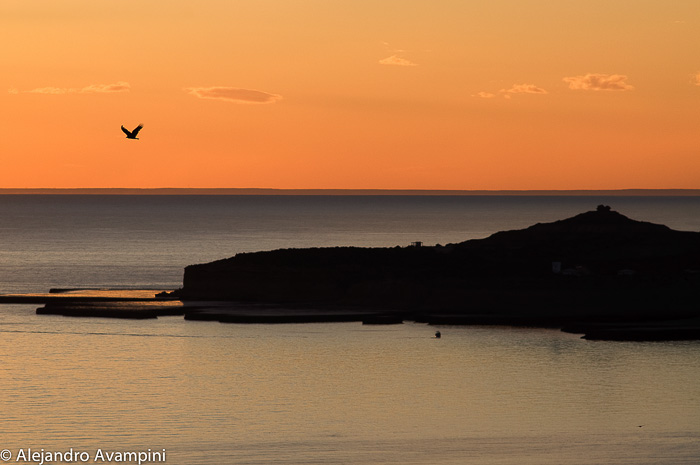 In 2008 a series of stamps were released from the Argentine National Postal Service representing and celebrating different national tourist attractions. Included in this homage is the nature reserve at Punta Piramde.
In 2008 a series of stamps were released from the Argentine National Postal Service representing and celebrating different national tourist attractions. Included in this homage is the nature reserve at Punta Piramde.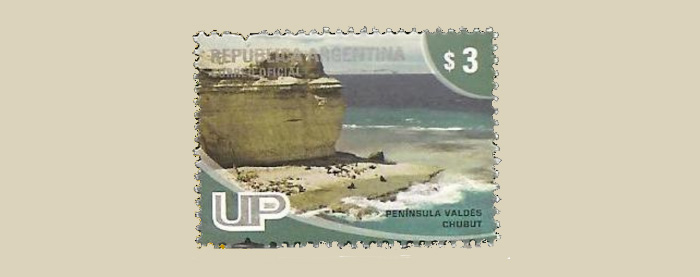
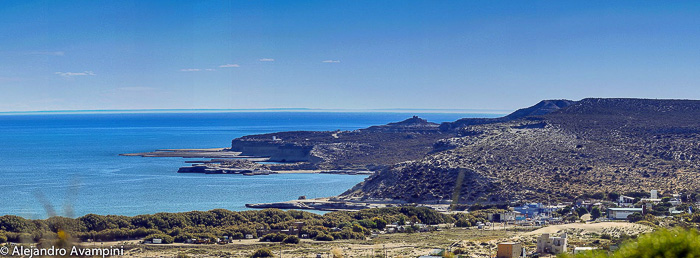 One of the park rangers who lives in Puerto Piramides and has worked at this reserve for years is Marcelo Franco, Marcelo is comfortable in his attention to visitors and explanations about the local geography and its wildlife while dedicated to the protection and maintenance of this intangible nature reserve.
One of the park rangers who lives in Puerto Piramides and has worked at this reserve for years is Marcelo Franco, Marcelo is comfortable in his attention to visitors and explanations about the local geography and its wildlife while dedicated to the protection and maintenance of this intangible nature reserve.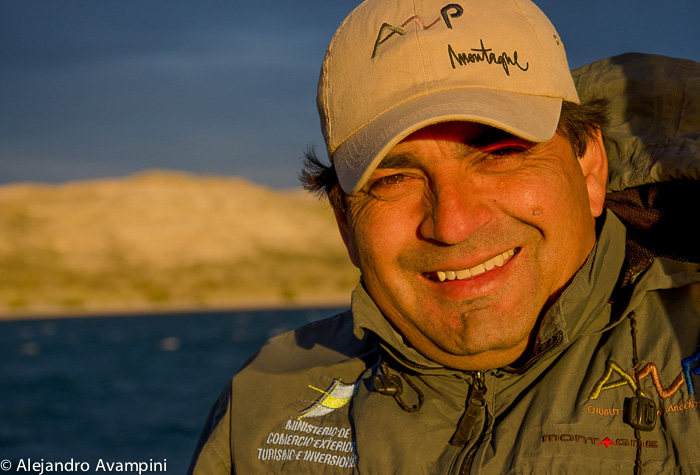 The density of the reproductive population at this reserve is truly impressive. Combined with the deep guttural noises emitted by the males and the continuous cries of the pups bouncing off the high cliffs, a natural amphitheater is created where the concentrated eco is accompanied by a chorus of Kelp-Gulls.
The density of the reproductive population at this reserve is truly impressive. Combined with the deep guttural noises emitted by the males and the continuous cries of the pups bouncing off the high cliffs, a natural amphitheater is created where the concentrated eco is accompanied by a chorus of Kelp-Gulls.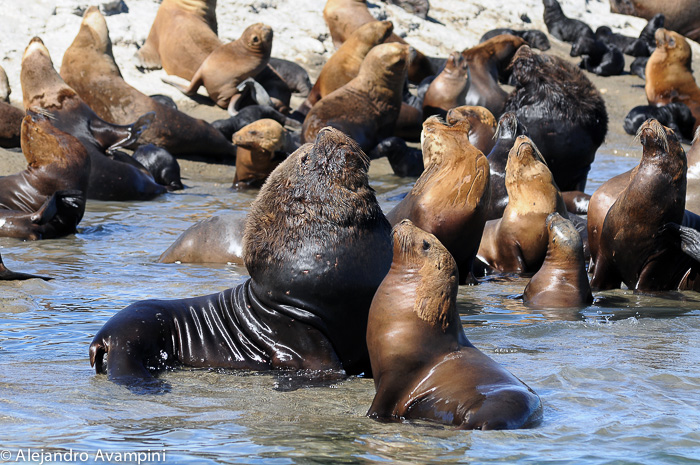 There are 4 different ways to reach this nature reserve. The easiest and most comfortable way, and obviously the least adventurous, is in your own vehicle.
There are 4 different ways to reach this nature reserve. The easiest and most comfortable way, and obviously the least adventurous, is in your own vehicle.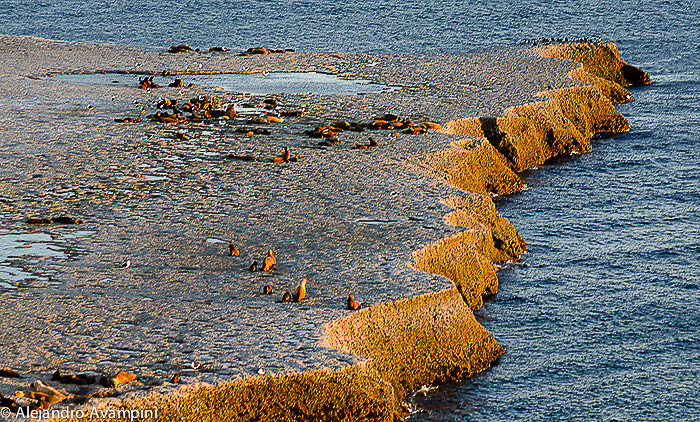 The second option is by foot. Following a path from Puerto Piramides represents an enjoyable and healthy option that takes approximately one hour in each direction while allowing time to appreciate and photograph the flora, fauna and unique, beautiful and infinite landscapes seen along the way.
The second option is by foot. Following a path from Puerto Piramides represents an enjoyable and healthy option that takes approximately one hour in each direction while allowing time to appreciate and photograph the flora, fauna and unique, beautiful and infinite landscapes seen along the way.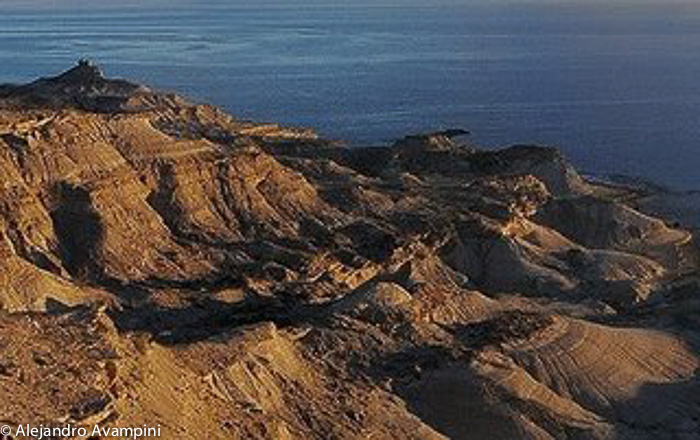 The last two options for accessing Punta Piramide nature reserve are by sea. One is aboard a local nautical cruise offered by all of the six whale watching companies during summer. Several of these nautical tours include snorkeling, adding an additional dose of entertainment and adventure.
The last two options for accessing Punta Piramide nature reserve are by sea. One is aboard a local nautical cruise offered by all of the six whale watching companies during summer. Several of these nautical tours include snorkeling, adding an additional dose of entertainment and adventure.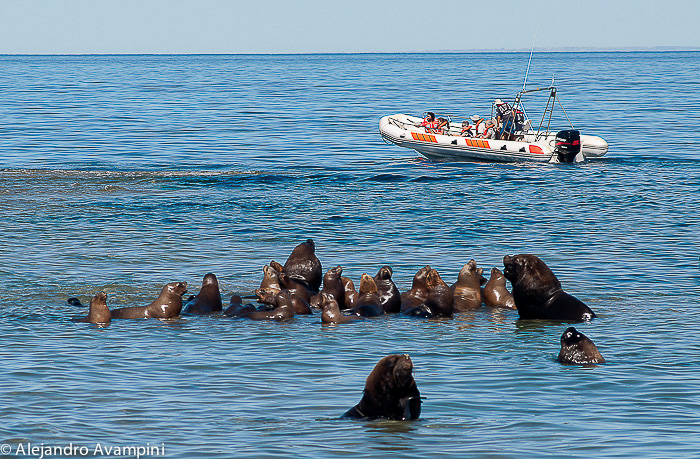 The last, and by far most ecological and adventurous of the 4 options is a guided kayak tour. Gliding across the sea in silence, without the assistance of a motor, accompanied by professional guides and without altering the behavior of wildlife in total liberty makes for an incredible experience.
The last, and by far most ecological and adventurous of the 4 options is a guided kayak tour. Gliding across the sea in silence, without the assistance of a motor, accompanied by professional guides and without altering the behavior of wildlife in total liberty makes for an incredible experience. 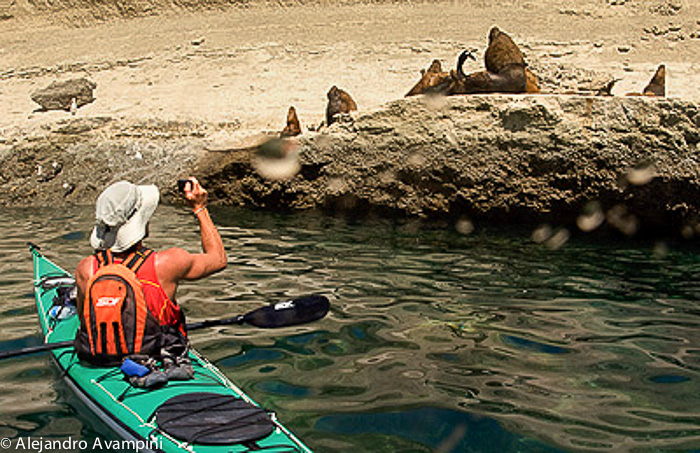 The following video is a compilation filmed and edited by a tourist in just one day of excursions in Valdes Peninsula. Within the universe of fauna that was documented, the minutes spent at the sea lion colony at Punta Piramide stand out. Thanks to this edition it is easy to understand what I have been attempting to articulate in this article.
The following video is a compilation filmed and edited by a tourist in just one day of excursions in Valdes Peninsula. Within the universe of fauna that was documented, the minutes spent at the sea lion colony at Punta Piramide stand out. Thanks to this edition it is easy to understand what I have been attempting to articulate in this article.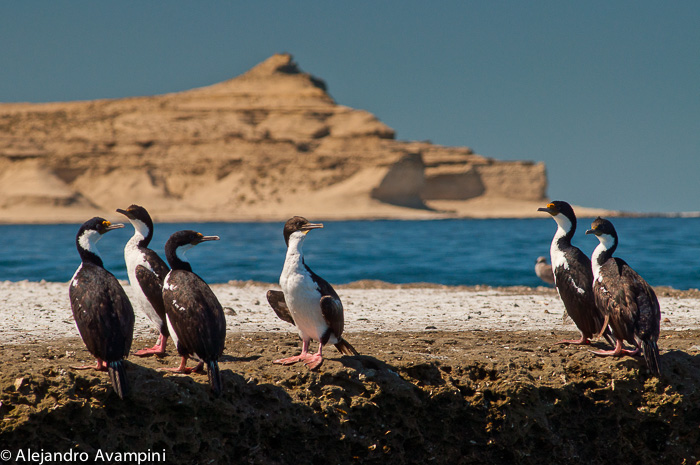 The kayaks used in these excursions have dry storage compartments and a dry storage bag is offered as well to safely carry your camera, a towel, sunscreen and any other object that needs to be kept dry.
The kayaks used in these excursions have dry storage compartments and a dry storage bag is offered as well to safely carry your camera, a towel, sunscreen and any other object that needs to be kept dry.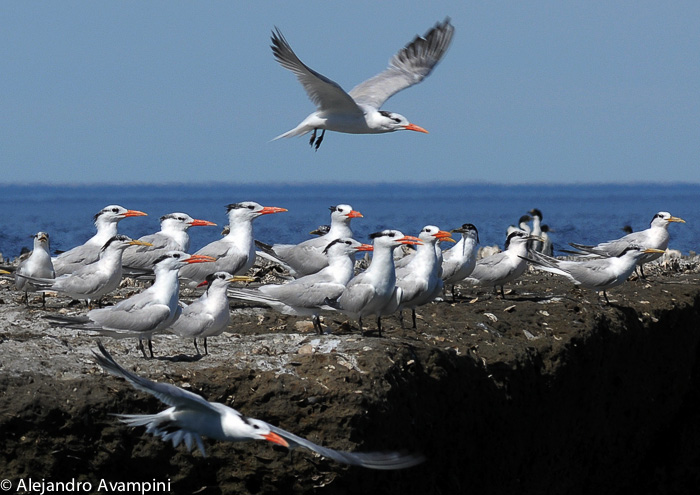 An almost mystic sensation fills the air as the virgin landscape surrounding Puerto Piramides merges with the local marine bird and sea lion colonies. Our town functions in direct relation to the wildlife that surrounds us.
An almost mystic sensation fills the air as the virgin landscape surrounding Puerto Piramides merges with the local marine bird and sea lion colonies. Our town functions in direct relation to the wildlife that surrounds us.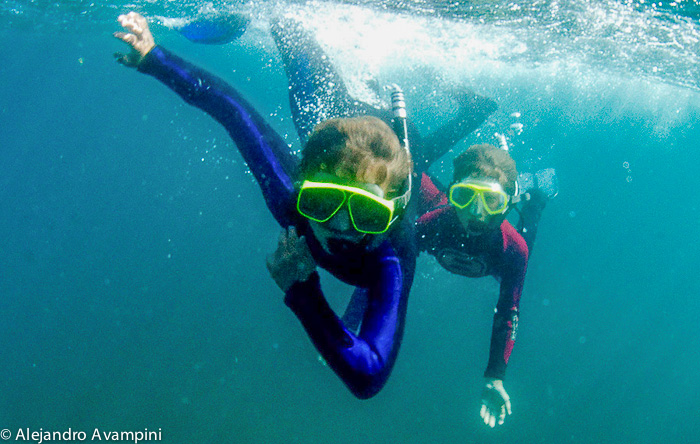 Throughout the world, activities like this are hard to find. Probably the most exciting of excursions are those offered by Patagoina Explorers, a dedicated couple who run professional, guided kayak tours all year long. During the summer season they offer daily two hour tours. These excursions are usually accompanied by close encounters with the local fauna, amazing landscapes and a stop at an isolated, secluded beach for a refreshing swim to quench the intense heat of summer. The crystal clear waters of our bay allow for all sorts of adventure and direct contact with nature, a swim suit or shorts are a must bring.
Throughout the world, activities like this are hard to find. Probably the most exciting of excursions are those offered by Patagoina Explorers, a dedicated couple who run professional, guided kayak tours all year long. During the summer season they offer daily two hour tours. These excursions are usually accompanied by close encounters with the local fauna, amazing landscapes and a stop at an isolated, secluded beach for a refreshing swim to quench the intense heat of summer. The crystal clear waters of our bay allow for all sorts of adventure and direct contact with nature, a swim suit or shorts are a must bring. The kayaks used in these excursions have dry storage compartments and a dry storage bag is offered as well to safely carry your camera, a towel, sunscreen and any other object that needs to be kept dry.
The kayaks used in these excursions have dry storage compartments and a dry storage bag is offered as well to safely carry your camera, a towel, sunscreen and any other object that needs to be kept dry.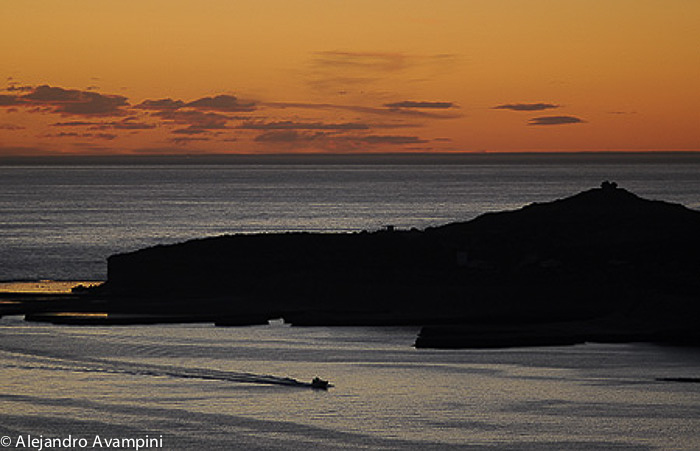 If the effort is made to reach Puerto Piramides, nature’s invitation for adventure will be waiting. Direct contact with the environment provides connections far removed from the craziness that we characterize as daily life.
If the effort is made to reach Puerto Piramides, nature’s invitation for adventure will be waiting. Direct contact with the environment provides connections far removed from the craziness that we characterize as daily life.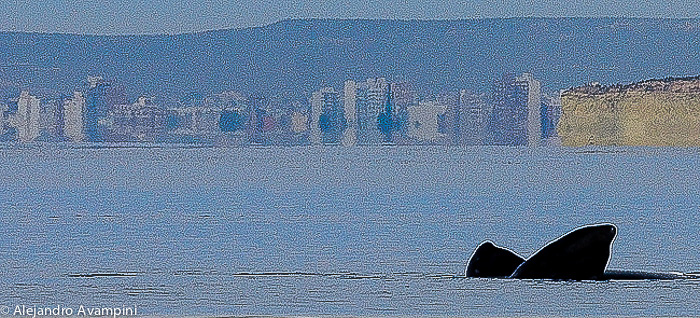 The weeks before the beginning of the whale watching Season at Valdes Peninsula, the two gulfs that shape the peninsula become more populous with right whales. Each day, all along the shore from Puerto Madryn to Puerto Piramides, those species individuals grow in number.
The weeks before the beginning of the whale watching Season at Valdes Peninsula, the two gulfs that shape the peninsula become more populous with right whales. Each day, all along the shore from Puerto Madryn to Puerto Piramides, those species individuals grow in number.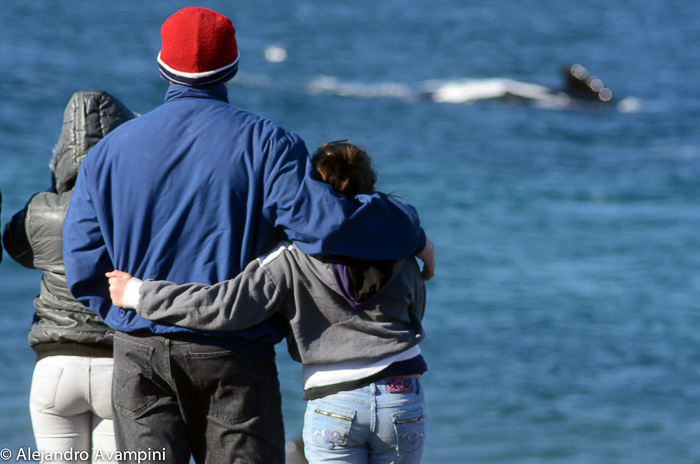 Fall roots itself more deeply, and whales comfortably find peace in this heavenly place on earth. While concentration of animals is overall intense, the highest density of whales per km2 is observed, no chance of doubt, at Protected Natural Area El Doradillo, which takes the major award worldwide in whale population between May and July.
Fall roots itself more deeply, and whales comfortably find peace in this heavenly place on earth. While concentration of animals is overall intense, the highest density of whales per km2 is observed, no chance of doubt, at Protected Natural Area El Doradillo, which takes the major award worldwide in whale population between May and July. During one of the most significant and magical cycles of their existence, these marine giants approach solid ground. Accessible to those who come to El Doradillo and witness the moment, a flask, a mate, and rolls in hand, sitting on the beach, every day, these are masterly classes of living in harmony.
During one of the most significant and magical cycles of their existence, these marine giants approach solid ground. Accessible to those who come to El Doradillo and witness the moment, a flask, a mate, and rolls in hand, sitting on the beach, every day, these are masterly classes of living in harmony.
 Naturally, ‘the whale’ is the greatest tourist attraction of this natural reservoir, but it is not the only one. The steppe is home to vital flora and fauna – plants nestled in an immense biodiversity barely noticed by who quickly passes through this desolate semi deserted area.
Naturally, ‘the whale’ is the greatest tourist attraction of this natural reservoir, but it is not the only one. The steppe is home to vital flora and fauna – plants nestled in an immense biodiversity barely noticed by who quickly passes through this desolate semi deserted area. 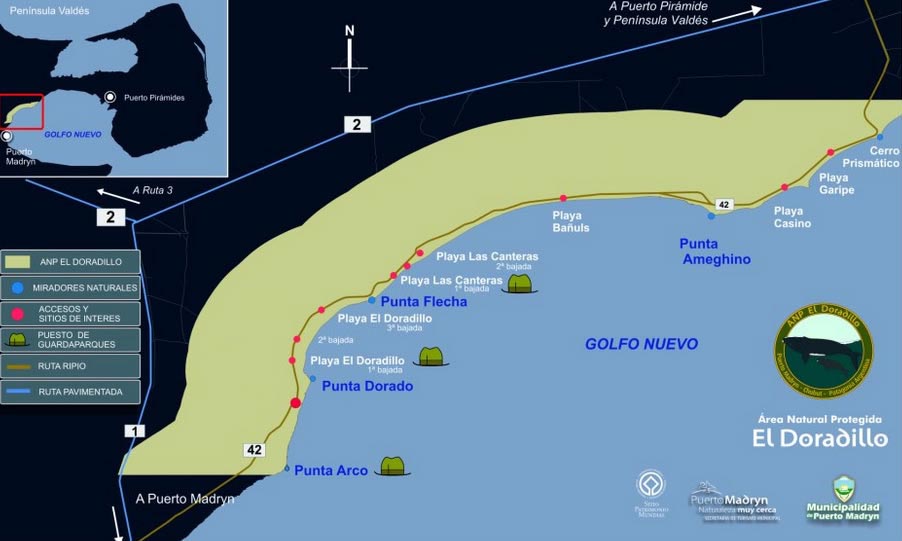 However, vegetation consisting mainly of low shrub-like plants, featuring more than 15 different species, predominates and embraces this saline ground to take root. Tens of bird species inhabit the region, as well as small mammals such as the skunk, the piche, and the southern mountain cavy. For further information, visit the Natural Heritage siteabout the history of the Protected Natural Area El Doradillo, and how it was originated.
However, vegetation consisting mainly of low shrub-like plants, featuring more than 15 different species, predominates and embraces this saline ground to take root. Tens of bird species inhabit the region, as well as small mammals such as the skunk, the piche, and the southern mountain cavy. For further information, visit the Natural Heritage siteabout the history of the Protected Natural Area El Doradillo, and how it was originated.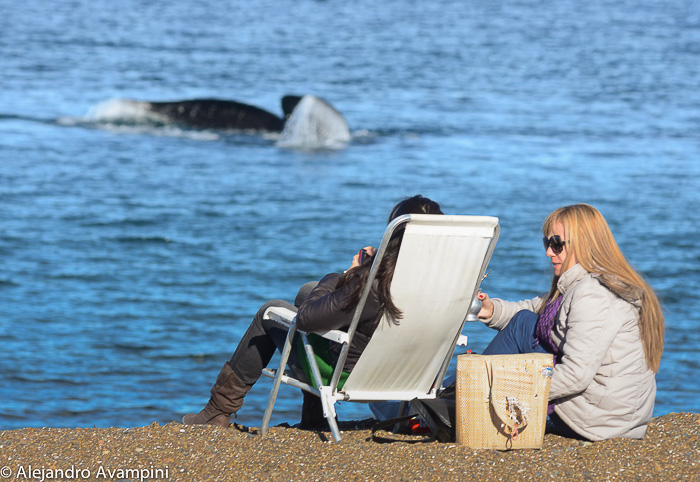 This video successfully reflects the reigning atmosphere of these beaches – some with sand, others with boulder geography, as well as all the energy of the boundless immensity offered by this corner of the Patagonia Argentina.
This video successfully reflects the reigning atmosphere of these beaches – some with sand, others with boulder geography, as well as all the energy of the boundless immensity offered by this corner of the Patagonia Argentina. What is theProtected Area El Doradillo all about?The aim of creating a protected natural area at El Doradillo is to achieve the preservation of a truly magical place in time, not only for us here and now, but for future generations. It is necessary to create these vast stretches of preserved areas to restrict the fierce depredation we human beings are inflicting on unprotected areas.
What is theProtected Area El Doradillo all about?The aim of creating a protected natural area at El Doradillo is to achieve the preservation of a truly magical place in time, not only for us here and now, but for future generations. It is necessary to create these vast stretches of preserved areas to restrict the fierce depredation we human beings are inflicting on unprotected areas.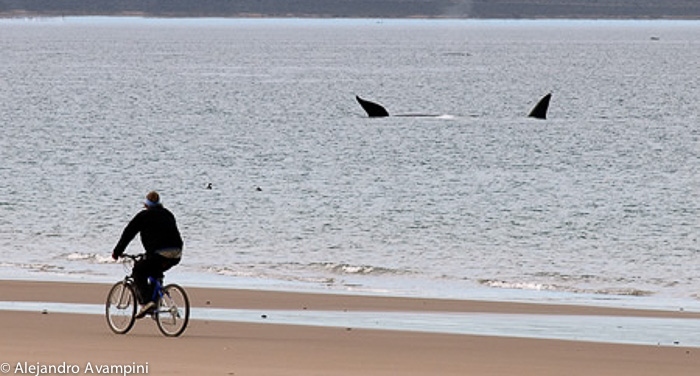 his protected area was created by the Municipality of Puerto Madryn in 2001, and 2 years later, a management plan was drafted stating goals to carry out actions for preserving its biodiversity and natural resources, providing education, and offering services and equipment for visitors’ public use.
his protected area was created by the Municipality of Puerto Madryn in 2001, and 2 years later, a management plan was drafted stating goals to carry out actions for preserving its biodiversity and natural resources, providing education, and offering services and equipment for visitors’ public use.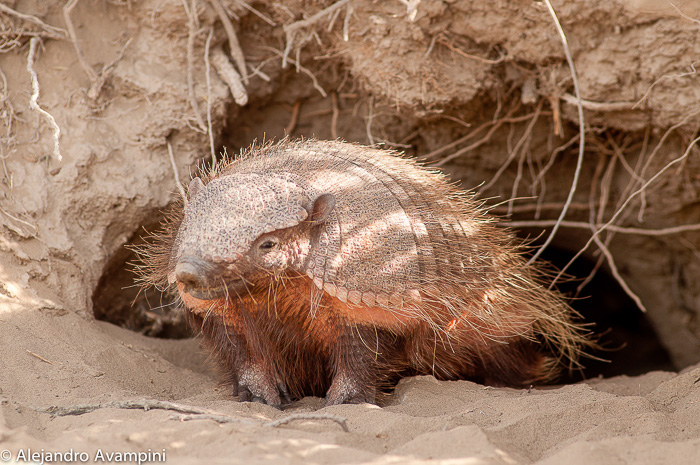 She coordinates a team of local park rangers, who are in charge of carrying out field tasks, mainly controlling and supervising, educating on environmental basics, and informing visitors during the whole year.
She coordinates a team of local park rangers, who are in charge of carrying out field tasks, mainly controlling and supervising, educating on environmental basics, and informing visitors during the whole year.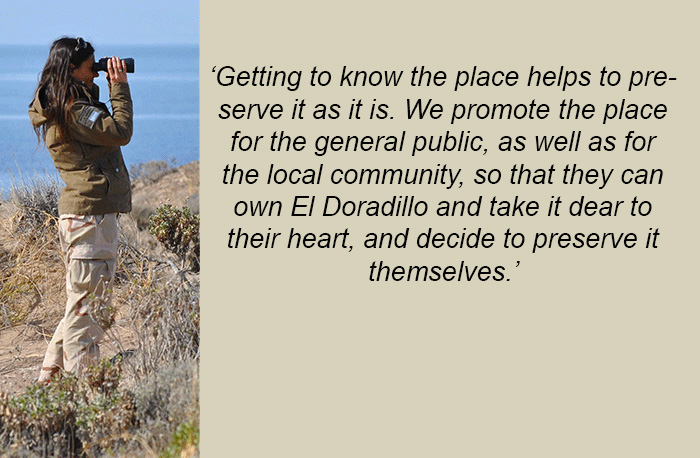 Recently, we are delighted to celebrate the 10 years of this program of environmental education with a photo contest. This sustained program is carried out by the Municipality of Puerto Madryn, and it is participative, as it includes voluntary students from high-school 728, who take part in recreational activities for children on the beach and are the tourist guides in charge of providing information during bus trips towards El Doradillo, and afterwards, of creating experiences with children for them to enjoy the wonderful behavior of whales in full reproductive period, and the environment in general. Each and every opportunity is taken.
Recently, we are delighted to celebrate the 10 years of this program of environmental education with a photo contest. This sustained program is carried out by the Municipality of Puerto Madryn, and it is participative, as it includes voluntary students from high-school 728, who take part in recreational activities for children on the beach and are the tourist guides in charge of providing information during bus trips towards El Doradillo, and afterwards, of creating experiences with children for them to enjoy the wonderful behavior of whales in full reproductive period, and the environment in general. Each and every opportunity is taken.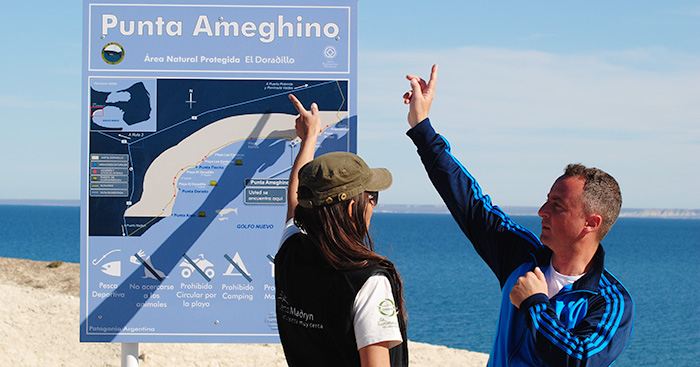 While the center of attention is the presence of whales, we take interpretative walks where we lecture about the flora, the birds, the southern mountain cavy, and we also share good environmental practices. We promote the importance of not leaving waste materials in the protected area, of not using local vegetation to make fire, and of taking care of dunes and beaches. We also underline the significance of respecting paths and of caring about a place as vulnerable as the Patagonic desert, where the human imprint immediately makes a mark. The World Tourism Organization (UNWTO) selected El Doradillo as the venue for a specific workshop addressed to Latin American and Caribbean referents in protected areas. It was an intensive one-week workshop featuring very prominent lecturers where we all learned a lot and shared experiences. At the end, we worked in groups and drafted proposals for public use, which now have been adopted in El Doradillo with a view to improving services for visitors without negatively impacting on the conservation of the place.
While the center of attention is the presence of whales, we take interpretative walks where we lecture about the flora, the birds, the southern mountain cavy, and we also share good environmental practices. We promote the importance of not leaving waste materials in the protected area, of not using local vegetation to make fire, and of taking care of dunes and beaches. We also underline the significance of respecting paths and of caring about a place as vulnerable as the Patagonic desert, where the human imprint immediately makes a mark. The World Tourism Organization (UNWTO) selected El Doradillo as the venue for a specific workshop addressed to Latin American and Caribbean referents in protected areas. It was an intensive one-week workshop featuring very prominent lecturers where we all learned a lot and shared experiences. At the end, we worked in groups and drafted proposals for public use, which now have been adopted in El Doradillo with a view to improving services for visitors without negatively impacting on the conservation of the place. These days, we are working with the national system for tourist quality of theNational Ministry of Tourism to enhance quality in each and every process we implement in managing the protected area. We have already attained distinction in management guidelines, and we now head towards revalidating such guidelines and gaining the national award for quality. Receiving and assisting scientists who do research in El Doradillo is also part of our job. When I began to work, my office was the field itself. I spent my whole day collecting and sorting data, taking photos and talking to people, both in winter and in summer – either warmly equipped, or shrinking into the shadows. Always with the management plan in hand, looking for ways to fit the area out for visitors, while trying to minimize all impacts to the least. We also keep statistical records that serve us as input for planning.
These days, we are working with the national system for tourist quality of theNational Ministry of Tourism to enhance quality in each and every process we implement in managing the protected area. We have already attained distinction in management guidelines, and we now head towards revalidating such guidelines and gaining the national award for quality. Receiving and assisting scientists who do research in El Doradillo is also part of our job. When I began to work, my office was the field itself. I spent my whole day collecting and sorting data, taking photos and talking to people, both in winter and in summer – either warmly equipped, or shrinking into the shadows. Always with the management plan in hand, looking for ways to fit the area out for visitors, while trying to minimize all impacts to the least. We also keep statistical records that serve us as input for planning.
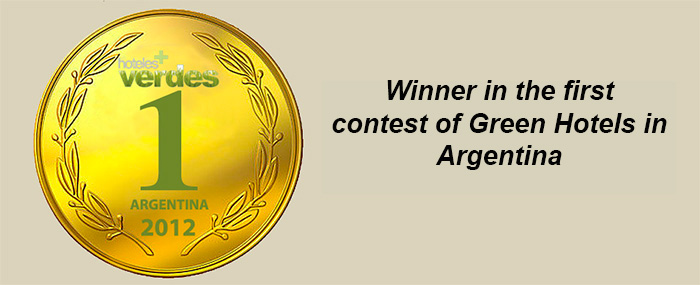
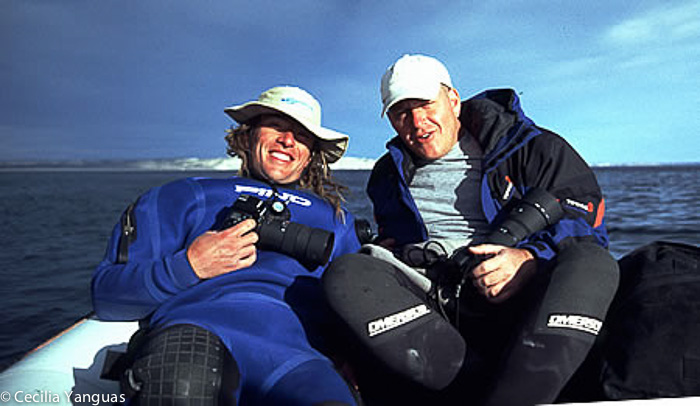

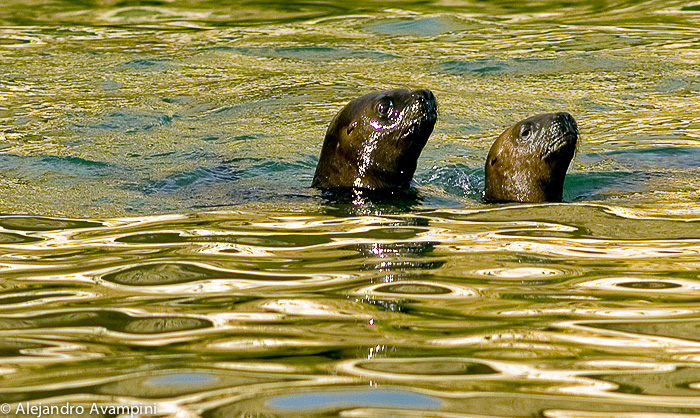

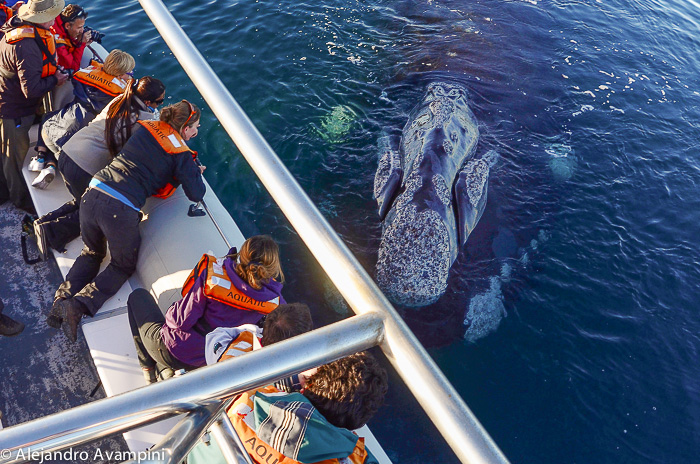
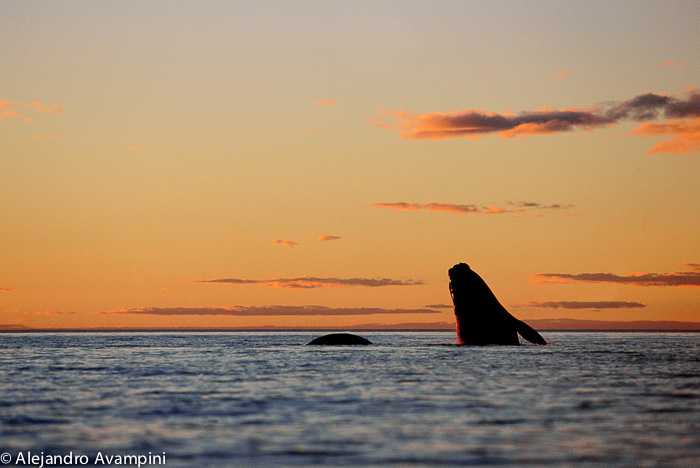
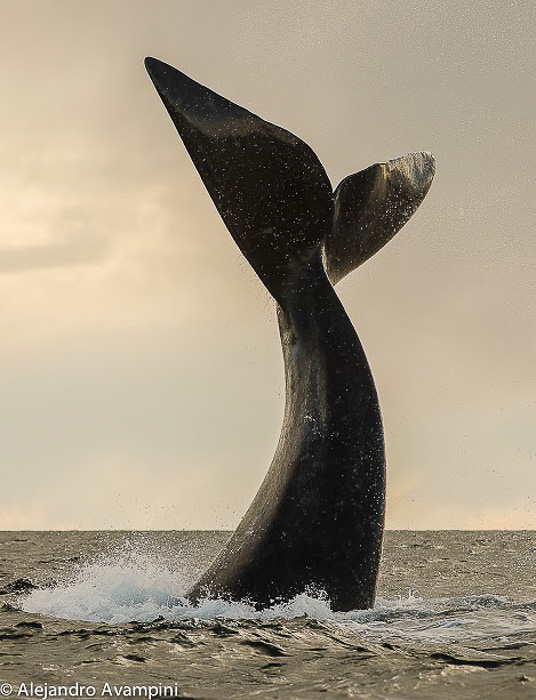
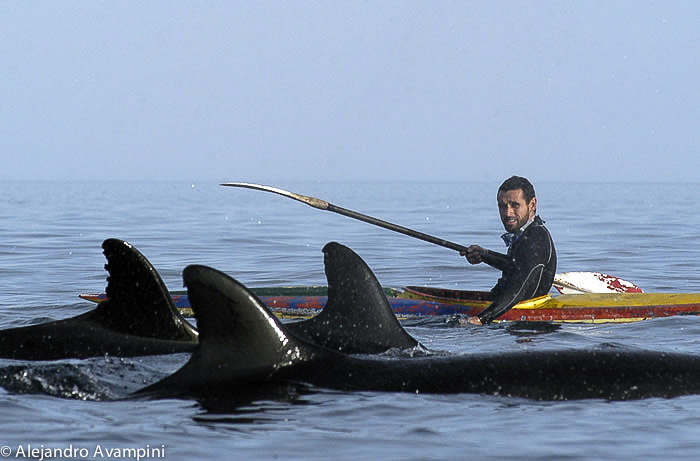 Getting to know individuals that live here in Puerto Piramides can be beneficial in several aspects, one of which is understanding the behavior of local wildlife. As well, listening to the silence offered by the immensity of night can tell you a thing or two. Listening to the whale’s breathing while observing the Milky Way helps one understand that nature photography is just an excuse for living the experience. All the factors have come together in a great conspiracy that will cause any passionate marine wildlife photographer to discover Puerto Piramides, an amazing, attractive and unforgettable natural paradise.
Getting to know individuals that live here in Puerto Piramides can be beneficial in several aspects, one of which is understanding the behavior of local wildlife. As well, listening to the silence offered by the immensity of night can tell you a thing or two. Listening to the whale’s breathing while observing the Milky Way helps one understand that nature photography is just an excuse for living the experience. All the factors have come together in a great conspiracy that will cause any passionate marine wildlife photographer to discover Puerto Piramides, an amazing, attractive and unforgettable natural paradise.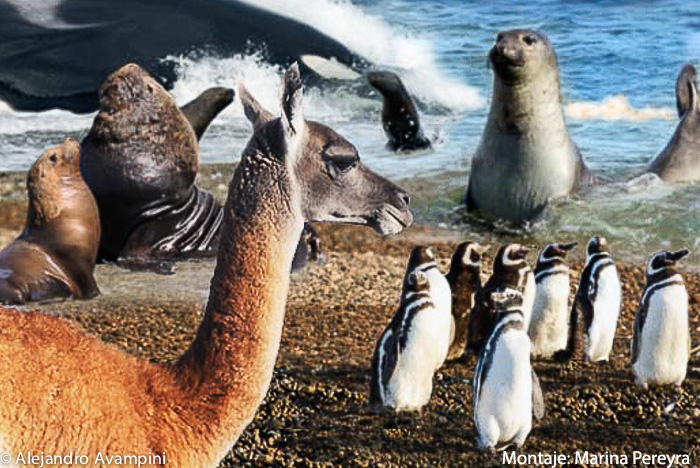 The perfect time to visit, when the natural beauty of Valdes Peninsula is in full form, is from whale watching season up through the end of Orca season. The rest of the year, May to August, is usually a period of adverse climactic conditions with short days, cold, cloudy, more frequent rain and strong winds. These four months are best avoided if your goal is wildlife. During the other eight months of the year this unique region is transformed into an amazing natural paradise.
The perfect time to visit, when the natural beauty of Valdes Peninsula is in full form, is from whale watching season up through the end of Orca season. The rest of the year, May to August, is usually a period of adverse climactic conditions with short days, cold, cloudy, more frequent rain and strong winds. These four months are best avoided if your goal is wildlife. During the other eight months of the year this unique region is transformed into an amazing natural paradise.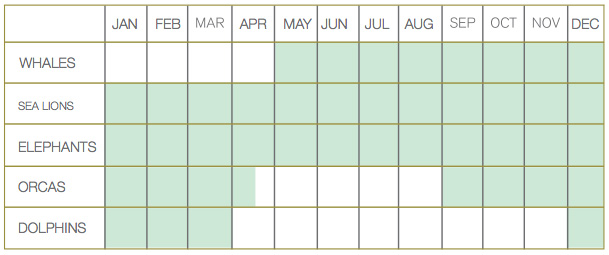

 Nearly 500,000 Magallanic Penguins arrive each year in September to reproduce, raise their young and molt along the coast of Valdes Peninsula, returning once again to the ocean in April.
Nearly 500,000 Magallanic Penguins arrive each year in September to reproduce, raise their young and molt along the coast of Valdes Peninsula, returning once again to the ocean in April.



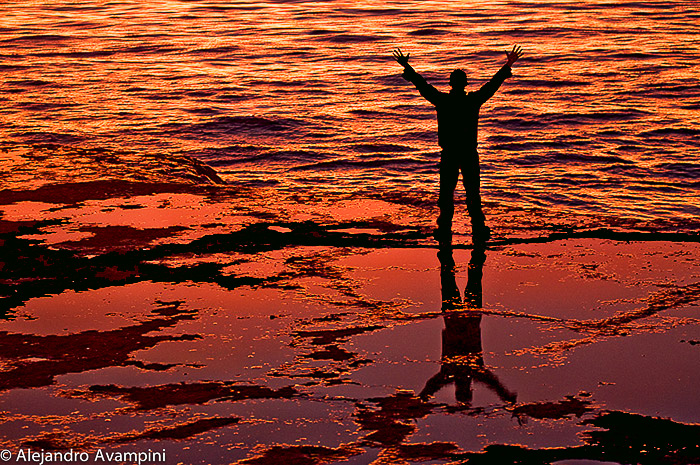



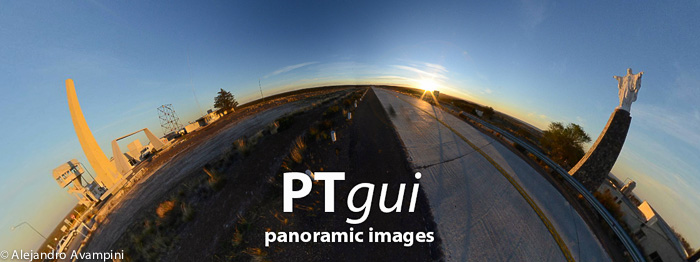

 The final result of this stereographic image, that can be interactively navigated, is the sensation of being at the center of the image, observing all the surrounding details of Punta Norte.
The final result of this stereographic image, that can be interactively navigated, is the sensation of being at the center of the image, observing all the surrounding details of Punta Norte.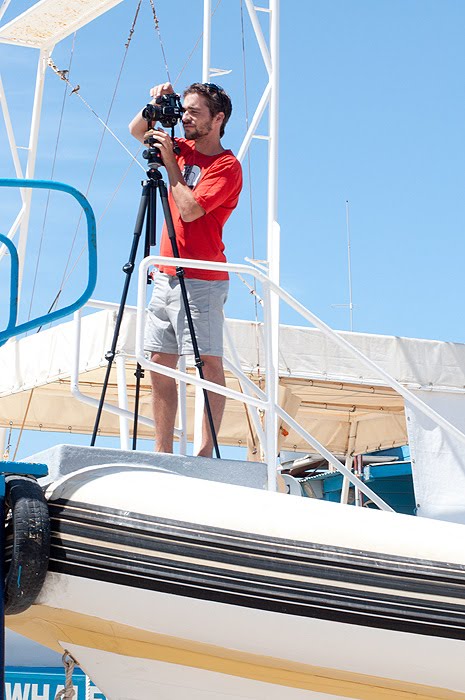

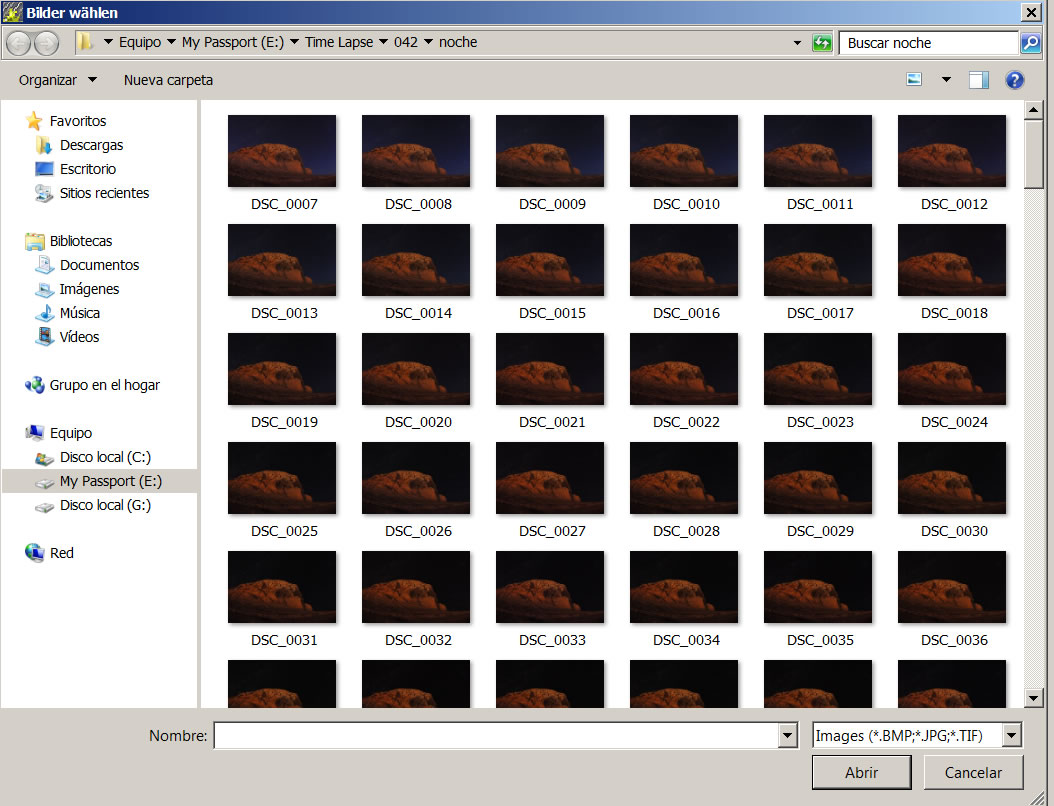
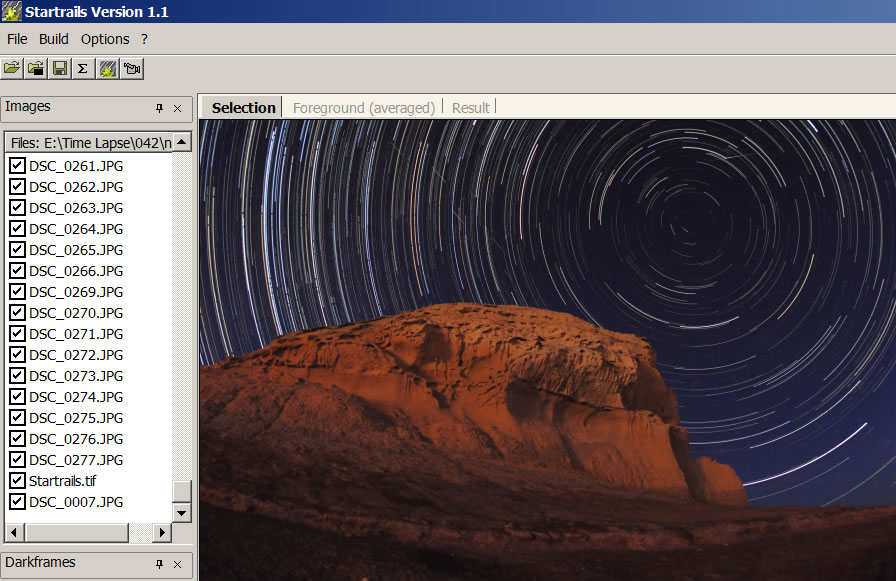


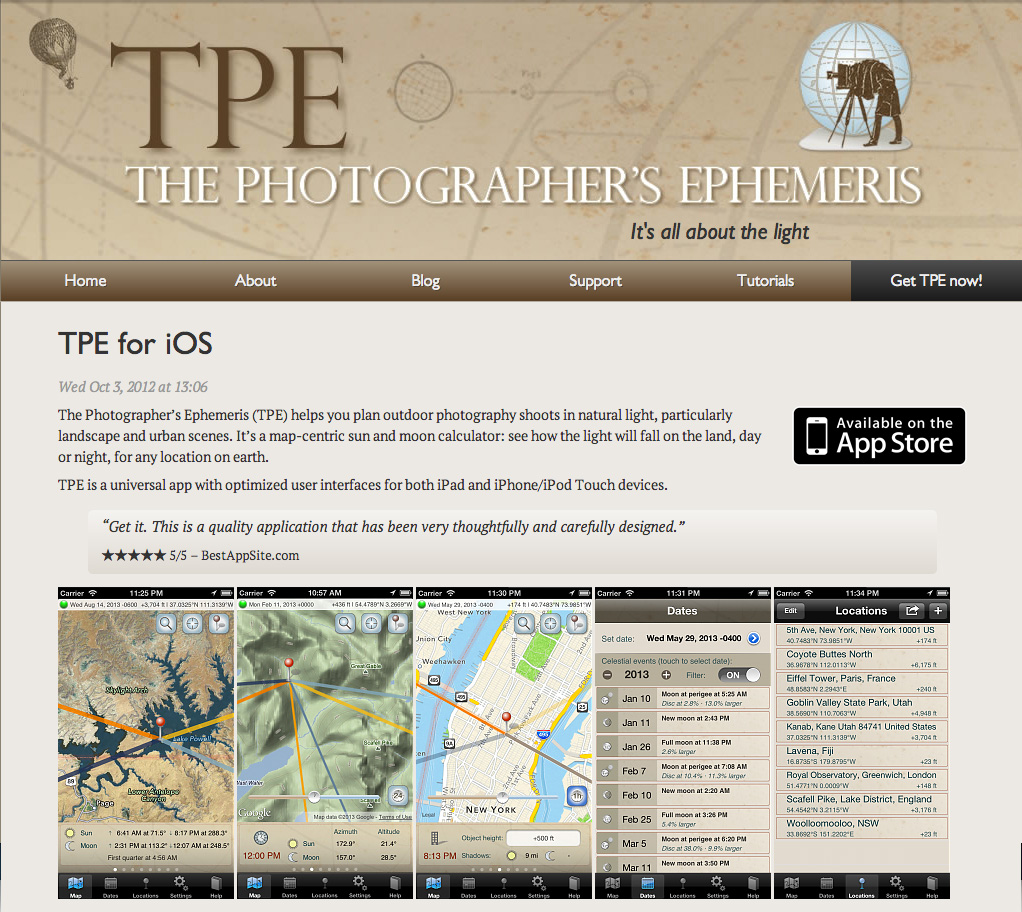 TPE utilizes as its platform, Google Maps to adjust and encounter a chosen spot. By moving a small red dot to any determined place, trajectory lines will appear for both the sun and moon. This is an extremely useful and user friendly program. Understanding the light and how it will affect any particular landscape at any time of the day or night is a fundamental base for anticipating and capturing quality landscape images.
TPE utilizes as its platform, Google Maps to adjust and encounter a chosen spot. By moving a small red dot to any determined place, trajectory lines will appear for both the sun and moon. This is an extremely useful and user friendly program. Understanding the light and how it will affect any particular landscape at any time of the day or night is a fundamental base for anticipating and capturing quality landscape images.
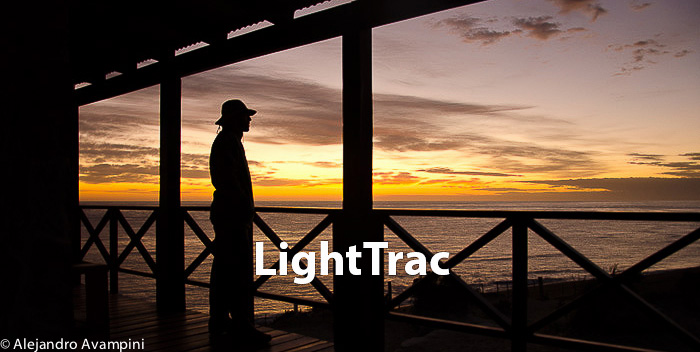
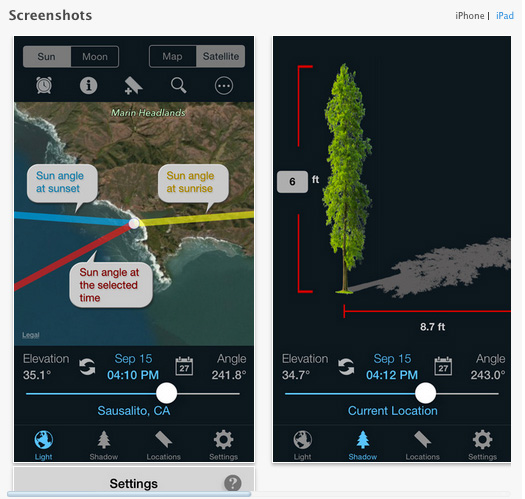


 Fortunately, during the waiting months when there are no whales in sight other seasonal encounters offer alternatives for the adventure photographer. Yes, in Valdes Peninsula there are other animals and wild savage nature, outside of whale season, to be observed, photographed and to stimulate your senses.
Fortunately, during the waiting months when there are no whales in sight other seasonal encounters offer alternatives for the adventure photographer. Yes, in Valdes Peninsula there are other animals and wild savage nature, outside of whale season, to be observed, photographed and to stimulate your senses.
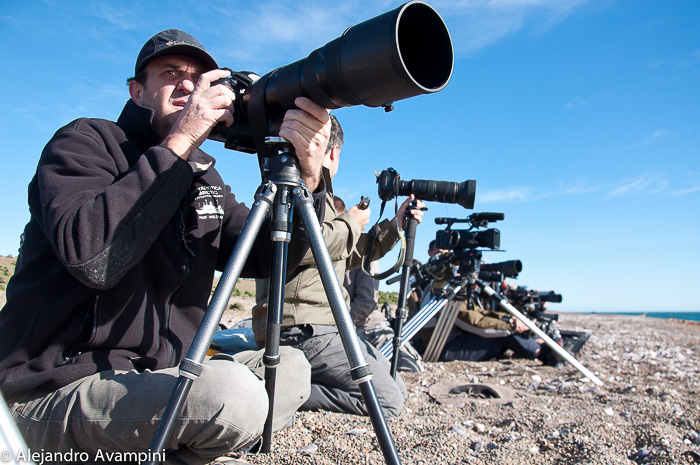
 The constant advances in technology make their presence felt all the time in Valdes Peninsula. Television production crews like Discovery Channel, Animal Planet, National Geographic and others from around the world arrive each year with the latest in imaging technology to document wild nature with the best definition and techniques possible.
The constant advances in technology make their presence felt all the time in Valdes Peninsula. Television production crews like Discovery Channel, Animal Planet, National Geographic and others from around the world arrive each year with the latest in imaging technology to document wild nature with the best definition and techniques possible. A fascinating world for those with a passion for nature, wildlife and the sea. This unique place of adventure is the ideal ground for nurturing the seeds of liberty and filling ones senses with freedom.
A fascinating world for those with a passion for nature, wildlife and the sea. This unique place of adventure is the ideal ground for nurturing the seeds of liberty and filling ones senses with freedom. Before heading off to your room to sleep, I suggest a walk along the beach, with small waves breaking and the occasional breathing of a whale as a background soundtrack and the milky-way blanketing the night sky, bringing to a close a day far from the norm.
Before heading off to your room to sleep, I suggest a walk along the beach, with small waves breaking and the occasional breathing of a whale as a background soundtrack and the milky-way blanketing the night sky, bringing to a close a day far from the norm.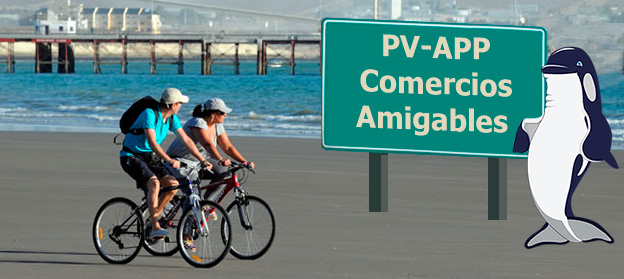


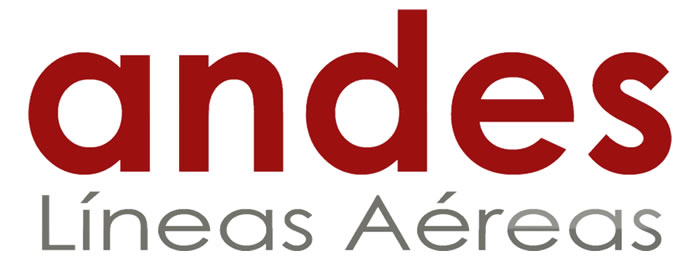
 Andes Líneas Aéreas
Andes Líneas Aéreas



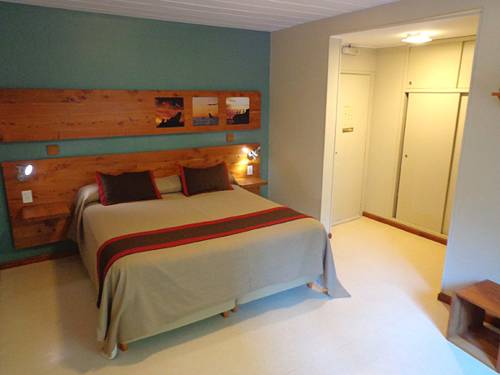
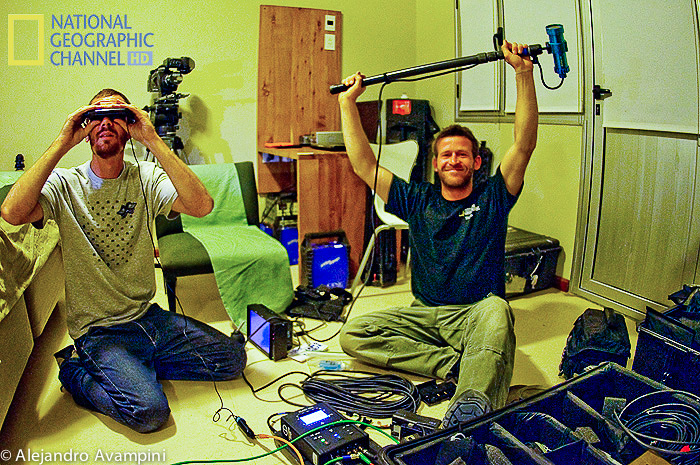
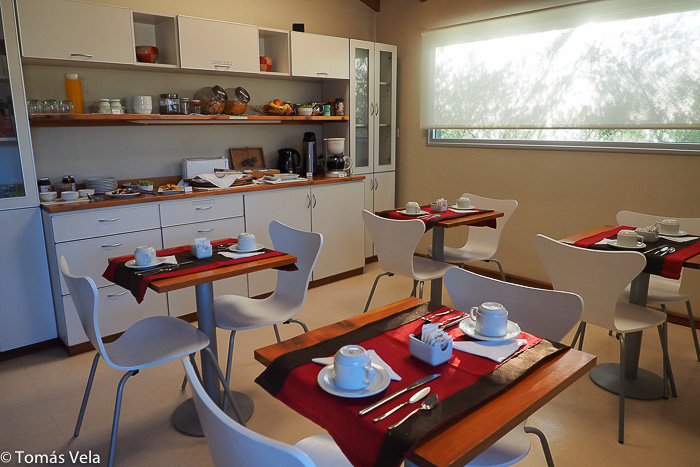
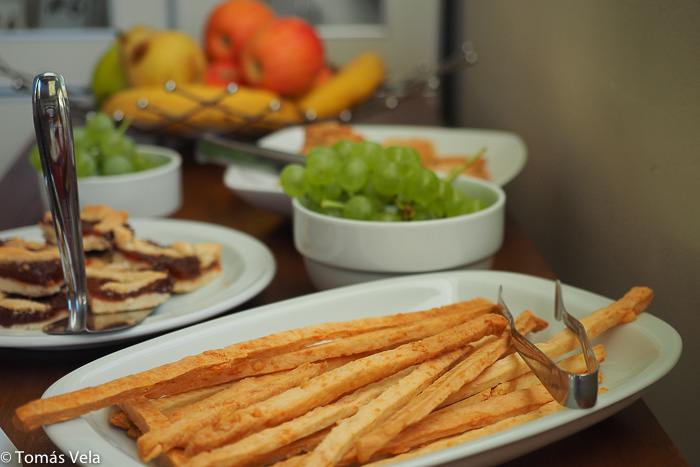
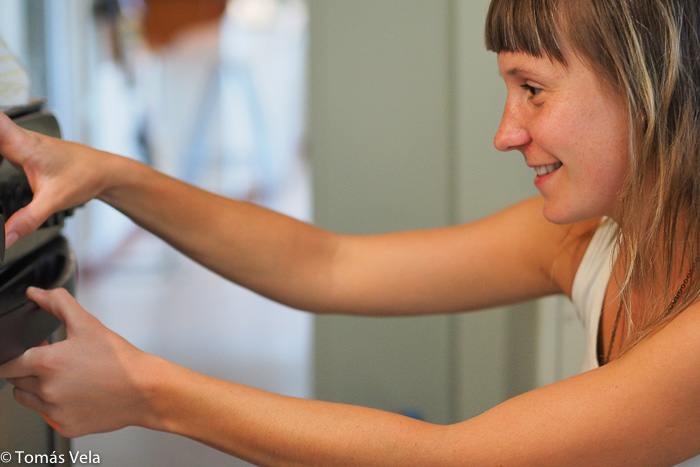 Acorde con la naturaleza, el confort nada tiene que ver con la exuberancia y la abundancia nada tiene que ver con la ostentación ni los lujos desmedidos. Por el contrario, en la naturaleza el ser humano tiene que pasar inadvertido, atento al entorno y a la magia que nos brinda el poder de contemplación y la sabiduría de saberse vivo.
Acorde con la naturaleza, el confort nada tiene que ver con la exuberancia y la abundancia nada tiene que ver con la ostentación ni los lujos desmedidos. Por el contrario, en la naturaleza el ser humano tiene que pasar inadvertido, atento al entorno y a la magia que nos brinda el poder de contemplación y la sabiduría de saberse vivo.
 E
E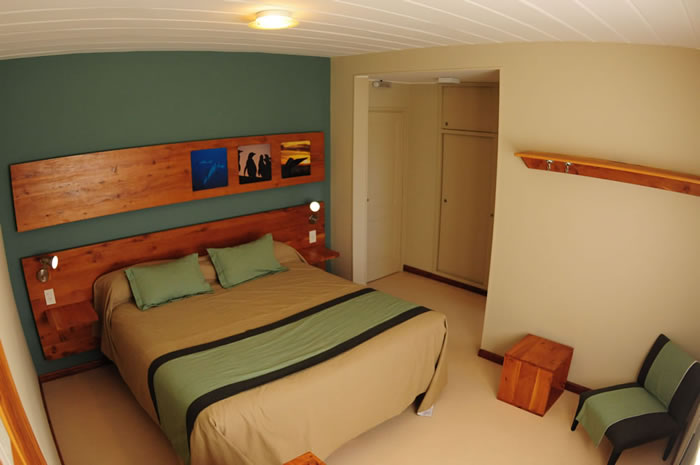
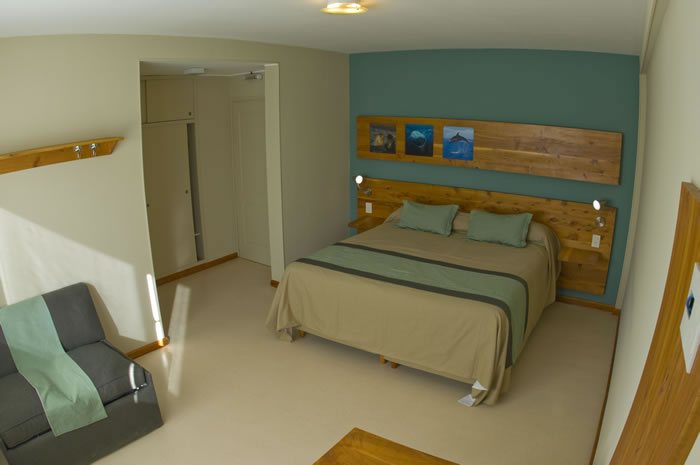

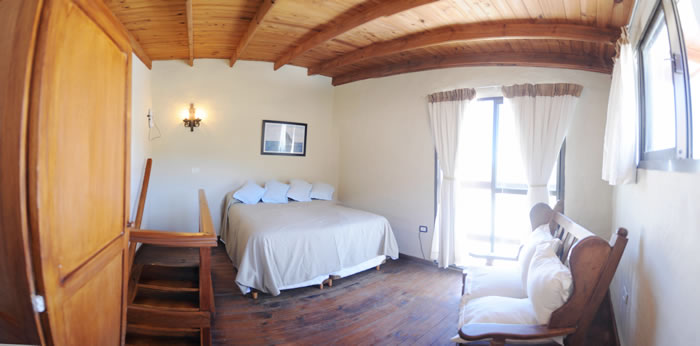
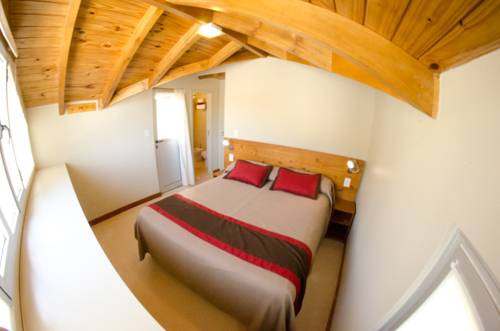
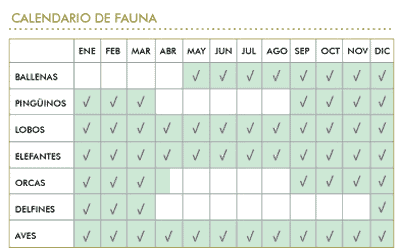 El calendario de fauna de Península Valdés sirve de guía general para saber los periodos de permanencia de cada especie. Después, el detalle del comportamiento de los animales varía a medida que avanzan las semanas. Acá abajo podés leer en las notas que le dedico a cada especie, el progreso de su etapa vital a lo largo de esos meses, en estas costas.
El calendario de fauna de Península Valdés sirve de guía general para saber los periodos de permanencia de cada especie. Después, el detalle del comportamiento de los animales varía a medida que avanzan las semanas. Acá abajo podés leer en las notas que le dedico a cada especie, el progreso de su etapa vital a lo largo de esos meses, en estas costas. Estas garitas están a unos 50km de Puerto Madryn, la misma distancia hay desde allí hasta a nuestro pueblo, Puerto Pirámides. Acá te acerco también el
Estas garitas están a unos 50km de Puerto Madryn, la misma distancia hay desde allí hasta a nuestro pueblo, Puerto Pirámides. Acá te acerco también el  Puerto Pirámides
Puerto Pirámides





